- Best Things to do in Budapest

Buda Castle
The majestic Buda Castle rises above the city of Várhegy, the hill of Budapest. The Castle has always had a turbulent history which reflects the different ups and downs of the history of Hungary.
Today the Castle, which is often called the Royal Palace , is home to a number of cultural institutes, including two museums: the Hungarian National Gallery and the Budapest Historical Museum .
Visiting the Castle
The main structure of the Buda Castle is more austere compared to its previous versions. The interiors kept that abundance of ornamentations and decorations, which was typical of the past. Despite its history made of continuous destructions and reconstructions, the Castle is still an imposing complex facing the Danube for about 300 meters.
The castle is made of a number of wings, going from wing A to F , arranged around the Lion Courtyard , which is surrounded by the National Library, the National Gallery, and the Budapest History Museum.
Most of visitors access to the Buda Castle from St. George Square to the north side, where the funicular connects the hill with the Chain Bridge and Pest. A decorative gate from the beginning of the 20th century separates the square from the Palace. Near the door there is a bronze statue featuring a large bird representing the Kingdom of Hungary perched atop a pedestal.
The Hungarian National Gallery
The Hungarian National Gallery occupies four wings of the palace, where there are the artworks made by Hungarian artists, from Middle Age to today. Do not miss a visit to the collections of 1300 and 1400, exhibited in the former throne room. There is also a very accurate collection of Hungarian Romanticist paintings.
The National Library
To the west of the courtyard, opposite the Gallery, there is the National Library which occupies the F wing of the palace. The Library was founded at the beginning of 1800 by Ferenc Széchényi who donated his private collection which was made of more than 1500 books and manuscripts. Today the library holds a copy of every single book published in Hungary.
Budapest History Museum
The most southern wing of the palace is home to the Budapest History Museum , which covers the history of the city from prehistory to modern days. The museum offers the opportunity to see some ruins and reconstructions of the Medieval palace, including the Gothic chapel and the Knights’ Hall.
Tours of Buda Castle
To discover Buda Castle Hill at its best, we recommend that you take part in a guided tour of the city.
Opening hours
The gardens and the courtyards of the Buda Castle are ope every day, 24 hours a day. Very often festivals take place in these spaces, therefore it is required to have a ticket in order to enter.
The Palace can be visited according to the Gallery and Museum opening times. The National Gallery opens from Tuesday to Sunday from 10.00 to 18.00. The History Museum is open everyday except on Mondays. During autumn and winter months the palace closes at 16.00 rather than at 18.00.
Surroundings
After visiting the Buda Castle it is possible to visit also some of the city’s most famous monuments located nearby, including:
- The Fisherman’s Bastion : the ideal place to admire the entire city of Budapest. The building was built to replace an ancient fort, while its seven towers symbolize the seven tribes that settled in the region. At the center of the Bastion there is the St. Stephen’s Statue.
- Matthias Church : the jewel of Budapest. It was built in the 13th century in Gothic style, and it was restored several times. Do not miss the tree naves and the tower, the chapel decorations and the fine carving works in the gates. In the past, Matthias Church was used as a coronation church by Hungarian kings, while today it hosts several concerts and events.
- The Vienna Gate Square (Bécsi Kapu) is located on the top of the Castle district, and back in the past the market was held in this square. The gate, decorated with atlas, cupids, and emblems is the symbol of the Christian revival of Buda of 1686. The statue of the woman located in the center of the square represents Ferenc Kazinczy, who was a famous Hungarian linguist.
The tunnel under the Castle
Just in front of the Chain Bridge there is the tunnel passing through the hill on which the Buda Castle stands. It was designed by the same engineer who built the first permanent bridge over Budapest, that is to say Adam Clark . The tunnel was open for foot traffic in 1856 – today it is no longer accessible – and for motor traffic during the following year.
The bridge is long 350 meters, almost as much as the Chain Bridge, and it is large 9 meters and tall 11 meters. The gallery entrance facing Pest is characterized by a majestic decoration in Neo-Classical style. The tunnel is considered the gateway to the city and it is used to calculate all distances between the capital to other cities. The square located just across from the tunnel is dedicated to Clark.
History of the Castle
A first rudimental fortification dates back to the 14th century. After the Mongol tribes had invaded Hungary, King Béla IV decided to build a shelter surrounded by walls. Today there is no evidence left of this first construction.
During the Renaissance, King Matthias undertook some changes to the castle, which reflected the style of that time. When Budapest was occupied by the Ottomans between 1541 and 1686 the castle was destroyed. Eventually the Habsburg gave a new castle to the city. The structure was built between 1714 and 1723 in Baroque style.
During the revolt of the Hungarian against the Hapsburg regime, in 1849, much of the Castle was destroyed. It was reconstructed only after establishing a compromise with the Habsburg. After the German invasion during World War II , the castle was severely damaged once again. Reconstruction works started in 1950 following a classic style design by architect István Janáki.
During the reconstruction works, the ruins of the Renaissance period were found and integrated to the new complex.
Useful information
Entrance ticket, where is located buda castle, fishermen’s bastion, matthias church, budapest funicular, hungarian national gallery, how to save on transport and entrance fees.
City Card allow you to save on public transport and / or on the entrances to the main tourist attractions.
Attractions around
- Airport transfers
- Airport parking

Buda Castle
Explore the grandeur of hungarian history at buda castle..
Perched on the hillside of Buda, the Castle District with the grand Buda Castle is a timeless spectacle, a historical gem that you absolutely cannot afford to miss while in Budapest.
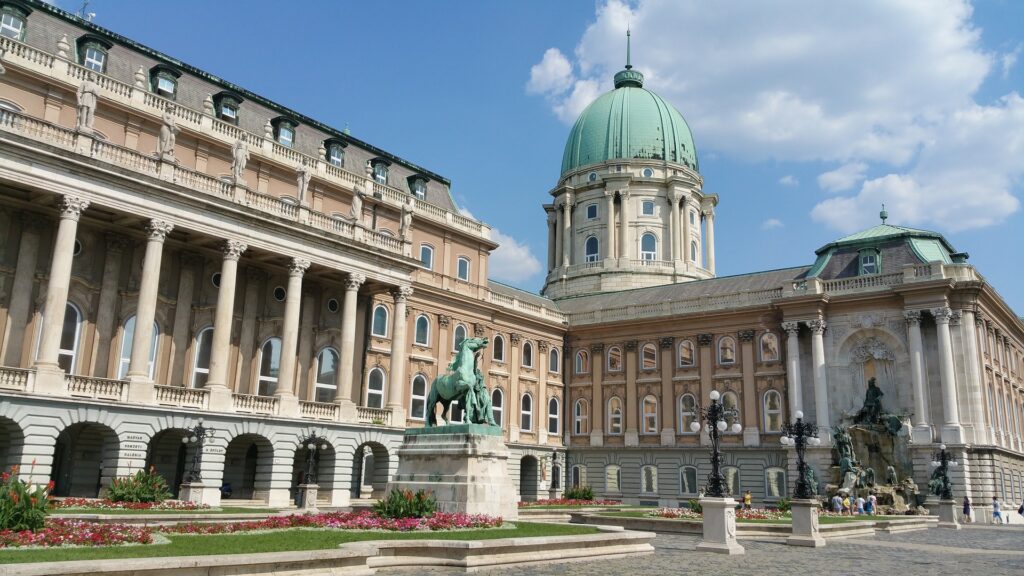
- Explore the stunning chambers and opulent rooms of the Royal Palace, home to the Hungarian National Gallery.
- Venture up to the panoramic Fisherman’s Bastion for a breathtaking view of the Pest side of the city.
- Walk through the historic Matthias Church, marveling at its exquisite interior and the centuries-old stories etched into its walls.
Tickets & Prices
Ticket info.
- Buda Castle Guided Tour – Experience a journey through time at Buda Castle, highlighting St. Stephen’s Hall and 800 years of history in a succinct guided tour.
- Buda Castle Cave Walking Tour – Delve into Buda Castle’s underground mysteries and learn about its historic caves’ unique geology.
- Budapest Card – Unlock Budapest with its official city pass, offering discounts, free attraction access, and unlimited public transport.
Before we delve into ticket options, it’s important to note that you can freely explore the exterior of the Buda Castle complex without purchasing tickets. Walking around the courtyards, enjoying the breathtaking architecture, and soaking in the panoramic views of the city and the Danube River from Castle Hill come at no cost.
For those eager to delve deeper into the history and culture encapsulated within the castle’s walls, there are ticketed attractions that offer unique experiences. Let’s take a look at your options.
Guided Tours
- 2-Hour Walking Tour : Led by a professional English-speaking guide, this tour showcases Matthias Church and Fisherman’s Bastion from the outside. The tour, available daily from 2 pm, costs €11 for adults and €5.5 for children aged 0-12 years.
- 3-Hour Private Tour : Includes a walking tour, funicular ride, guided Danube Cruise, and a refreshing drink. The tour operates daily with varying prices depending on group size.
- Night Walking Tour : Available on Wednesdays, Thursdays, and Sundays from 8.30 – 10.30 pm, this tour offers a unique perspective of the Castle at night. Prices are €18 for adults and €16 for students.
Other Tour Options
- Segway Tour : A fun and different way to explore, available daily from 1 pm – 3 pm, at €54 per person.
- 45-90 Minute Buda Labyrinth Tour : Explore the mysterious underground labyrinths, with prices starting from €11.
- Bus Tour : Offering a comfortable way to see the sights, available daily at specific times, with adult tickets at €18 and child tickets at €9.
Private Tours
- 2.5-Hour Private Tour : Includes entry to Matthias Church, available every day except Saturday, with prices varying based on group size.
- Customizable Private Tours : Offering personalized experiences with professional guides in various languages. Prices and hours are flexible, depending on the chosen inclusions.
What to see and do
Here’s what I suggest doing once you’ve found your way onto the castle grounds.
Exploring the Regal Majesty of the Royal Palace
Start your journey at the emblem of Budapest’s skyline, the Royal Palace. Prepare to be awestruck by the grandeur of its courtyards, which seem to reverberate with the echoes of Hungary’s rich history. As you approach, the imposing Lion’s Gate stands as a sentinel, commanding respect and admiration.
Don’t forget to take a moment to marvel at the Matthias Fountain, a captivating piece of art that narrates a historic tale through its intricate stone carvings.
Within the Palace, you’ll discover several museums, each serving as a repository of Hungarian culture. The Hungarian National Gallery is a must-visit, boasting a carefully curated collection of masterpieces from acclaimed Hungarian artists.
The Budapest History Museum and the National Széchenyi Library are like time capsules that transport you to a bygone era with their medieval sculptures, ancient documents, and more.
Insider tip: The Széchenyi Library’s antique maps collection offers a unique glimpse into Hungary’s past. Don’t miss this opportunity to delve into history!
Unveiling the Charm of Castle Hill
A leisurely stroll from the Palace leads you to Castle Hill, a UNESCO World Heritage Site. This picturesque area boasts cobblestone streets, Baroque houses, and verdant gardens, offering countless photo opportunities.
The Fisherman’s Bastion and Matthias Church are enchanting sights that showcase the architectural beauty of the area. And make sure not to miss the changing of the guard – a truly memorable spectacle.
Insider tip: To fully enjoy the charm of Castle Hill without the crowds, consider visiting early in the morning or late in the afternoon. And don’t forget to wear comfortable shoes, as the cobblestone streets are a delight to explore.
The Danube River: A Symphony of Lights and Shadows
The Danube River, contrasting beautifully against the cityscape, comes to life at night when the city lights shimmer on its surface.
Experience this iconic river and its historic bridges by taking a leisurely cruise, renting a bike for a scenic ride, or simply strolling along its banks. Each bridge tells a poignant tale of wars, unity, and the cultural diversity that defines Budapest.
Delving into the Mysteries of Buda Castle Cave
Beneath the castle lies the Buda Castle Cave, a network of tunnels sculpted by thermal waters over centuries. These tunnels have served as a shelter, a hospital, and even a secret military base. Today, they host captivating exhibitions that seamlessly blend the forces of nature and history.
Insider tip: Keep in mind that the cave tours don’t operate year-round. Be sure to check the schedule before planning your visit to ensure you don’t miss out on this intriguing experience.
Navigating the Enigmatic Buda Castle Labyrinth
Step into the Buda Castle Labyrinth, a haunting underground marvel. This labyrinth has fulfilled various roles over time – from a prison to a wine cellar and even a torture chamber. Today, it is famed for chilling legends, including the tale of Vlad Tepes (Dracula).
Insider tip: The labyrinth’s temperature is cooler than the city above, so bringing an extra layer to stay comfortable is a wise choice.
Immerse Yourself in the Vibrant Buda Castle Festival
The Buda Castle Festival is a vibrant celebration of art, music, and culture. It features a diverse array of concerts, exhibitions, and workshops, culminating in a grand fireworks display. The festival’s setting within the castle grounds harmoniously blends historical charm with contemporary festivities.
Insider tip: Festival tickets tend to sell out quickly. Be sure to secure yours early to ensure you don’t miss out on this lively cultural extravaganza.
The festival usually takes between the 18th and 20th August so if you’re visiting during this time be sure to check it out for an authentic Hungarian experience.
Experience the Enchantment of the Buda Castle Night Tour
As dusk falls, the castle transforms into a realm of enchantment. The Buda Castle Night Tour offers an exclusive perspective, with city lights twinkling below and moonbeams casting ethereal shadows all around.
Insider tip: Keep in mind that the night tour attracts fewer crowds, providing a more intimate experience. However, note that the last entry is earlier than expected. Plan your evening accordingly to make the most of this magical opportunity.
Planning Your Visit
If you’re wondering how to reach Buda Castle, there are several options to consider.
Public Transportation
From the bustling city center, hop on bus line 16, fondly known as the “Castle Bus.” Starting from Deák Ferenc tér, a hub in the city, it takes you right to Dísz tér, just steps from the castle entrance. This 15-minute ride is not only convenient and cost-effective but also offers a slice of daily life in Budapest. It’s a popular choice, so expect some company during rush hours.
The Funicular
For a dash of history, the funicular from Adam Clark Square is your go-to. This venerable cable car, operational since 1870, is more than a mere transport—it’s a journey through time. As you ascend Castle Hill, soak in the panoramic views of the Danube, Margaret Island, and the striking Art Nouveau Gresham Palace on the Pest side.
Operating daily from 8 am to 10 pm (with occasional Monday closures for maintenance), this brief but memorable ride is worth the possible wait. Tickets are priced at 4000 HUF for adults (return) and 2000 HUF for children aged 3-14, offering a unique perspective of the city’s grandeur.
Walking to the Castle
If you’re up for a bit of exercise, walking up Castle Hill is a rewarding option. The popular route from the Chain Bridge, winding through leafy paths and stairways, unveils the city’s charm in a tranquil manner. The walk takes around 15 to 20 minutes, offering numerous opportunities for picturesque stops. Remember to stay hydrated and wear comfortable footwear, especially during the warmer months.
Opening Hours
Exploring Anytime: The Buda Castle District, a mosaic of historical architecture and cobbled streets, welcomes visitors at any hour. Wander through its open-air courts and courtyards under the starry sky or the morning sun – they’re accessible 24/7.
Weekly Schedule: While the Royal Palace’s museums take a pause on Mondays, the rest of the Castle District remains lively. From Tuesday to Sunday, most attractions, including the National Gallery and Budapest History Museum, open their doors from 10 am to 6 pm. A stroll around the area reveals gems like the Buda Castle Cave and the Fisherman’s Bastion, open daily, inviting visitors to delve into history or enjoy panoramic views.
Seasonal Variations: The Castle’s rhythm adapts to the calendar. National holidays bring a festive atmosphere, with major museums typically open. However, during Easter and Christmas, it’s wise to check individual opening hours as they vary.
Special Mention: For a touch of ceremonial grandeur, the Alexander Presidential Palace’s Changing of the Guards is a weekend spectacle, with hours shifting seasonally.
Insider Tip: The Buda Castle District isn’t just a daytime delight. Its enchanting ambiance at night or early dawn makes for memorable, romantic strolls, offering a different perspective of Budapest’s heart.
Navigating Buda Castle
Let’s make sure you find the correct entrance. Given Buda Castle’s expansive grounds and numerous attractions, there are several entrances to choose from. But don’t fret! I’m here to guide you.
The Lion’s Gate: Your Gateway to Royal Splendor
If your itinerary includes a visit to the Hungarian National Gallery or the National Széchenyi Library, both nestled within the Royal Palace, the Lion’s Gate is your ideal entrance.
Easily accessible from Adam Clark Square via the funicular, or for those seeking a little cardio, the stairs from the Chain Bridge, this main entrance is a breeze to find.
Have an e-ticket? Conveniently scan it at the turnstile or show it to the helpful staff at the entrance.
The Savoy Terrace: For a Taste of History
If you’re an ardent history buff planning a visit to the Budapest History Museum, the Savoy Terrace is your entry point.
To get there, hop on bus number 16 or 16A from Deák Ferenc Square, or opt for a leisurely stroll along Castle Hill from the Fisherman’s Bastion. And feel free to use your e-ticket at the turnstile.
Into the Heart of the Castle: The Buda Castle Cave and Labyrinth
Feeling adventurous? The entrances to the Buda Castle Cave and the Buda Castle Labyrinth are located under the Royal Palace and Castle Hill, respectively.
You can reach these entrances by taking bus number 16 or 16A from Deák Ferenc Square, or exploring Uri Street from Szentháromság Square. And yes, your e-ticket works here too.
Insider Tip: The Castle Labyrinth, a captivating underground network of tunnels and cellars, dates back over 500 years. Do bring along a sweater as it can get chilly in these subterranean corridors!
Timing Your Visit: Tips to Avoid the Crowds
Wondering when to visit?
It really depends on what you prefer. If you’re not a fan of crowded spaces, consider visiting early mornings or late afternoons on weekdays.
For an enchanting experience, consider an evening visit to catch the awe-inspiring panoramic views of Budapest glowing under the night sky. Culture enthusiasts might enjoy weekends or public holidays when the castle grounds often come alive with special events and performances.
And remember, comfort is key. So, lace up your most comfortable shoes. Your feet will thank you later.
Exploring Buda Castle: How Much Time Do You Need?
So you might be wondering how much time you need to spend at the castle. Well, it really depends on how much you want to do. I’ve put together some options for you.
Half a Day at Buda Castle
Short on time or craving a quick dip into Budapest’s royal legacy? Opting for a half-day tour of Buda Castle is a smart move.
While its grand architecture and sprawling grounds might seem overwhelming, rest assured, half a day is sufficient to soak in its charm and delve into its history.
Start your journey by immersing yourself in a couple of museums nestled within the Royal Palace. My strong recommendation goes to the Hungarian National Gallery and the Budapest History Museum. These cultural gems offer a captivating glimpse into Hungary’s artistic and historical evolution.
Next, venture towards the Matthias Church, an architectural masterpiece, and the Fisherman’s Bastion, known for its panoramic views of Budapest that feel like walking into a living canvas.
What makes this itinerary shine is its equilibrium. You’ll explore Buda Castle’s key highlights without feeling rushed or swamped.
Furthermore, you’ll save a few Forints (that’s Hungarian currency, in case you’re wondering) and valuable time. Keep in mind, though, that you might not be able to savor all the intricate exhibits. But fear not, I’ll share pointers on must-see features in the latter part of this guide.
A Full Day at Buda Castle
If you’re a history aficionado or a culture enthusiast, dedicating an entire day to Buda Castle is a rewarding venture.
Embark early and dive into all the museums housed within the Royal Palace. This grants you ample time to relish each exhibit without the constraints of time.
Seize the opportunity to partake in a guided tour of the castle district and ascend the tower of Matthias Church. The view from the zenith is nothing short of awe-inspiring and undoubtedly worth the ascent.
For a culinary intermission, indulge in a local eatery or café. Personally, I hold a soft spot for Pierrot; their goulash soup is a sheer delight.
The advantage of committing a full day is the chance to delve into every nuance in intricate detail.
On top of that, you can cap the day with an evening concert or show. The flipside? It can be a bit physically demanding, and the cost is slightly higher. But trust me, the experience is worth every dime!
Two Days at Buda Castle
Let me give you a sneak peek into what these two days could look like. Your first day is all about soaking up the grandeur of the castle and its district, while the second day is reserved for the offbeat treasures that most tourists miss.
Day 1 – Museums, Monuments, and Munching
Kick-start your day by exploring the Royal Palace, which houses three must-visit museums – the Hungarian National Gallery, the Budapest History Museum, and the National Széchényi Library. Each of these offers a unique perspective on Hungary’s past – from art to history to literature.
Next, join a guided tour to explore the castle district. This includes the Fisherman’s Bastion, a favorite among photographers for its panoramic views of the city, and Matthias Church, known for its stunning stained glass windows.
Don’t forget to visit the Holy Trinity Square and take a peek at the Old Town Hall.
Now, let’s talk about food. Café Pierrot and Ruszwurm Confectionery are my personal favorites. The first serves delicious Hungarian dishes, while the latter is an iconic spot for traditional pastries. Yum!
Day 2 Hidden Gems and Secret Corners
While the first day was all about the grandeur, day two takes you off the beaten path. Start with Várkert Bazár, a renovated neo-Renaissance building complex offering beautiful gardens and art exhibitions.
Next, step into the Labyrinth of Buda Castle, a mysterious underground maze that once served as a bomb shelter. Last but not least, the Hospital in the Rock is a must-visit. This former secret emergency hospital and nuclear bunker is now a unique museum.
For food, Alabárdos is a great spot for traditional Hungarian cuisine with a modern twist. If you’re a fan of celebrity chef Jamie Oliver, his restaurant, Jamie’s Italian, is right here in the Castle district.
What to Expect from Visiting Buda Castle
Here’s what you can expect from a visit to Buda Castle.
Experiencing the Magic of Buda Castle Across the Seasons
Whether you’re visiting Budapest in the balmy summer or the frosty winter, Buda Castle has something special to offer in each season.
The Castle’s grandeur and the surrounding Castle District present a different charm as the seasons change.
Summer at Buda Castle: Sun-soaked Splendor
Budapest summers bring warm, sunny weather, with temperatures ranging from the mid-70s to the low 90s (Fahrenheit). This is the perfect time to explore the expansive grounds of Buda Castle, including the stunning Royal Gardens.
However, don’t forget to shield yourself from the intense Hungarian sun with a sun hat and sunscreen. I also suggest carrying a bottle of refreshing rose water to stay cool.
Winter at Buda Castle: A Fairy-tale Wonderland
Winter transforms Buda Castle into a snow-draped fairy tale spectacle, even though temperatures often drop below freezing.
Bundle up in warm layers and don’t forget to bring your camera to capture the enchanting winter wonderland. Exercise caution while walking, as the cobblestone paths can get slippery.
Spring and Fall at Buda Castle: A Riot of Colors
Spring and fall in Budapest bring mild, unpredictable weather. You might bask in the sun one day and dodge raindrops the next, so it’s wise to keep an umbrella at hand.
Despite the changeable weather, these seasons paint the Castle in vibrant hues – either with pink blossoms or golden leaves – creating a picturesque setting.
Managing the Crowds at Buda Castle
As one of Budapest’s most popular attractions, Buda Castle can draw large crowds, especially on weekends, holidays, and during festivals.
From my experience, early mornings and late evenings offer a more tranquil visit. If you’re like me and prefer fewer crowds, consider exploring on a weekday.
While special events like the annual Wine Festival in September may bring larger crowds, they also offer unique experiences you won’t find on a regular day. Booking tickets or tours online in advance can help you bypass long lines during peak season.
Despite the crowds, Buda Castle’s size ensures there are always quieter corners to explore. I’ve often discovered serenity in the labyrinthine Castle Museum or while absorbing the cityscape from a secluded spot on the Castle walls.
Remember, Buda Castle isn’t confined to the Castle itself. The surrounding Castle District, adorned with charming streets and hidden courtyards, is a treasure waiting to be explored and tends to be less crowded.
Tips and Recommendations for Visiting Buda Castle
Here are my top tips for and recommendations for exploring Buda Castle.
A Culinary Adventure at the Castle
Hungarian cuisine is an integral part of Budapest’s charm, and the Castle District offers unrivaled gastronomic delights. The renowned 21 Restaurant awaits you with its menu of traditional Hungarian dishes.
The goulash soup, a national culinary treasure, should not be missed. Seeking a sweet treat? Visit Ruszwurm Café, a historic confectionery in Budapest, for their delectable pastries.
For special occasions, the elegant Halászbástya Restaurant offers an exquisite dining experience complemented by panoramic views of Budapest.
As in any tourist hotspot, it’s prudent to review the menu prices before ordering to avoid unexpected charges. And remember, locals are your best resource for hidden culinary gems – Budapestians are hospitable and delighted to share insider tips!
Treasure Hunting for Souvenirs
After a gastronomic feast, it’s time to embark on a quest for unique mementos. Fortuna Street, with its array of antiques and art, offers a shopping experience that’s far from ordinary.
For exquisite handmade ceramics and crafts, visit the Várnegyed Gallery. And for fine porcelain enthusiasts, the Herend Porcelain Shop is a must-visit.
While shopping for souvenirs, look for labels or certificates of origin to ensure authenticity. And don’t hesitate to negotiate prices – it’s part of the fun!
A Unique Perspective of Buda Castle
Have you considered a boat tour on the Danube River? It provides a unique vantage point of Buda Castle and some tours offer dinner, drinks, and live music, adding to the city’s enchanting ambiance.
For history enthusiasts, a guided tour of Buda Castle can enhance your comprehension of its historical significance. Opt for tours that offer fast-track access to museums and exhibitions.
Discover Hidden Gems and Secrets
While wandering the castle, keep an eye out for hidden gems. The Royal Well, a medieval water source adorned with a bronze sculpture of King Matthias Corvinus, is a must-see.
Also, don’t miss the Turul Bird statue, a mythical creature revered as the ancestor and protector of the Hungarians.
And delve into the Labyrinth of Buda Castle, an intriguing network of underground tunnels and chambers reportedly haunted by Vlad Tepes, the real-life inspiration for Dracula.
Celebrations at the Castle
Experiencing Buda Castle during one of its many festivals, like the Budapest Wine Festival in September, the Budapest Christmas Fair in December, and the Festival of Folk Arts in August, offers a unique cultural immersion.
However, these events also attract larger crowds. If you prefer a quieter setting, plan your visit accordingly.
Another must-visit includes the Shoes on the Danube Bank memorial, a poignant tribute to Holocaust victims.
Lastly, take advantage of the free daily walking tours from Buda Castle. Led by friendly, knowledgeable guides, they provide a wealth of fascinating stories.
What about the facilities at and around the castle? Here is what you need to know.
Savoring the Flavors at Buda Castle
Let’s embark on our virtual culinary journey at Buda Castle. Here, a myriad of eateries beckon with their diverse offerings.
- Buda Castle Café : Imagine savoring a cup of coffee while absorbing the stunning views of the Danube. Don’t forget to try their hearty goulash soup – it’s a local culinary gem!
- Ruszwurm Confectionery : Offers the sweet allure of tradition, with its history dating back to 1827. Their cream cakes are not just desserts, they’re edible legends.
- Pest-Buda Bistro : Tantalizes taste buds with traditional Hungarian dishes, reimagined for the modern palate. Don’t miss out on their crowd-pleasing Chicken paprikash and lángos (fried dough). And, for those seeking a true local experience, a shot of pálinka (fruit brandy) offers a spirited finish.
- 21 Restaurant : Every dish is a delicious narrative of Hungarian cuisine. A pro-tip: reserve in advance for a table with a captivating view!
Gift Shopping at Buda Castle
Moving on to souvenir hunting, Buda Castle presents a treasure trove of unique mementos.
- National Gallery Shop : Catering to a variety of interests and tastes, whether you fancy handicrafts, ceramics, paintings, books, or spices.
- Budapest History Museum Shop : Offers a fascinating array of books for history aficionados.
- Castle Hill Souvenir Shop : A must-visit for authentic Hungarian spices – perfect if you’re looking to bring a taste of Budapest back home!
- Buda Castle Fashion Shop : For those seeking a touch of fashion flair.
Surroundings
Think you’ve covered everything at Buda Castle? Budapest has more in store for you.
Squares Worth a Stop
Beyond the castle’s grandeur, the city squares provide a refreshing pause.
Dísz tér , framed by charming historical buildings, is a picture-perfect spot. Meanwhile, the lively Szentháromság tér , home to Matthias Church, buzzes with bustling terraces and eateries.
Green Spaces Galore
After the squares, why not recharge in the nearby green spaces? The Castle Garden (Várkert Bazár) offers a harmonious mix of nature and culture, while Gellért Hill Park boasts the city’s best sunset views.
Districts to Discover
Allow me to take you on a virtual journey around the districts near Buda Castle. Each district offers a unique vibe, stunning scenery, and a taste of local life that will make you fall in love with this city.
Watertown: Tranquility by the Danube
Let’s meander towards Watertown. Nestled between Margaret Bridge and Chain Bridge, this district is a serene riverside haven. The area gets its name from the fishermen’s cottages and docks that once dotted its landscape.
Walk down narrow lanes, past colorful houses, and discover hidden gardens that make Watertown a picture-perfect postcard.
Make sure to stop by the Tomb of Gül Baba, the northernmost Islamic holy place in Europe. It’s a slice of tranquility in the bustling city.
Víziváros: Where Old Meets New
Lastly, let’s venture into Víziváros. Also known as Water-town because of its proximity to the river, this district is where tradition and modernity collide.
With a blend of old and new buildings, Víziváros is a feast for the eyes. Admire the Baroque-style St. Anne’s Church, the neo-Gothic-style Parliament Building, and the modern-style National Theatre, all within walking distance.
When the sun goes down, Víziváros transforms into a lively hotspot. With a plethora of pubs, bars, and clubs, it’s the perfect place to experience Budapest’s vibrant nightlife.
Did you know that: (4 Interesting Facts!)
- Buda Castle is not just one castle but a complex of many structures. It’s home to the Hungarian National Gallery, the Budapest History Museum, and the National Széchényi Library. The castle complex is like a mini city within a city!
- The castle, known in Hungarian as ‘Budavári Palota’, isn’t the original one. The first castle was built in the 13th century, but it got destroyed over the years due to various invasions. The present structure is the result of several reconstructions, the latest of which was completed in the 20th century.
- Buda Castle has a labyrinth underneath! Known as the Buda Castle Labyrinth, it’s a mysterious network of tunnels and caves stretching over six miles. Part of it was used as a bomb shelter during World War II.
- Did you know that Buda Castle is built on a plateau called Castle Hill? It’s not just a name, it’s a UNESCO World Heritage Site! The Castle and the entire district offer breathtaking views of the Danube, the Parliament, and the city of Pest on the other side.
From its initial construction to the modern-day, the Buda Castle has been a symbol of Hungarian culture and resilience. Let’s take a walk through the key moments of Buda Castle’s history:
- 13th Century: After the Mongol invasion, King Béla IV orders the construction of the Buda Castle as a fortified palace to protect against future invasions.
- 15th Century: Under the reign of King Matthias Corvinus, Buda Castle flourishes into a Renaissance palace, serving as a hub of arts and culture.
- 1541: The Ottoman Empire captures Buda Castle, transforming it into a well-guarded fortress. This marks the start of a 145-year occupation.
- 1686: The Hungarian and allied forces reclaim the castle during the Battle of Buda, but the castle is left severely damaged.
- 18th Century: Maria Theresa, the Austrian Empress, orders the reconstruction of the castle into a grand Baroque palace.
- 19th Century: Significant renovations take place, turning Buda Castle into a symbol of national identity during the Hungarian Independence movement.
- World War II: The castle suffers major damage during the Siege of Budapest. Restoration work begins shortly after the war.
- 1987: Buda Castle and the Castle District are declared a UNESCO World Heritage site.
- Present Day: Now, Buda Castle is one of the most visited landmarks in Budapest, boasting museums, exhibitions, and stunning panoramic views of the city.
What is Buda Castle and why should I visit?
Buda Castle, known in Hungarian as Budavári Palota, is a historical castle and palace complex that once housed the Hungarian kings in Budapest. This UNESCO World Heritage site, perched high on Castle Hill, offers a fascinating glimpse into Hungary’s rich history, breathtaking panoramic views of the city, and is home to some of Budapest’s most important museums. It’s a must-visit for history buffs and lovers of beautiful architecture alike!
What are some of the top attractions at Buda Castle?
There’s a wealth of attractions waiting for you at Buda Castle. The Hungarian National Gallery, Budapest History Museum, and the National Széchényi Library are all located within the castle walls. Don’t miss the Lion Courtyard, Matthias Fountain, and the stunning views from the Fisherman’s Bastion. And of course, the changing of the guards at the main entrance is a spectacle you wouldn’t want to miss.
Any tips for navigating Buda Castle?
Sure thing! Buda Castle is quite large, so it’s a good idea to plan your visit in advance. It’s best to start your tour from the Castle Hill Funicular that takes you up to the Castle district. Wear comfortable shoes as the cobbled streets can be hard on your feet. And remember, while the Castle District is open 24/7, the museums and attractions inside have their own opening hours.
Is Buda Castle accessible to visitors with disabilities?
Absolutely! While the castle’s historic cobbled streets can be a bit challenging, most attractions within the Buda Castle are wheelchair accessible. There are also special parking areas and restrooms for guests with disabilities. However, it would be best to check with each attraction for specific accessibility information.
Where can I eat near Buda Castle?
Hungry after your castle exploration? Fear not! The Castle District is teeming with delightful restaurants and charming cafes. For a traditional Hungarian meal, try Pest-Buda Bistro. If you’re looking for a quick bite with a view, the café at the Fisherman’s Bastion is a fantastic option.
Contact Information, Map & Address
Reaching Out for Guidance and Tours:
Should you need assistance or seek insights on guided tours at Buda Castle, feel free to contact the team at [email protected] .
Parking Queries:
For parking information within the castle area, contact the Buda Castle Municipality at [email protected] .
Navigating to the Castle:
Buda Castle, a crown atop Budapest’s landscape, is situated in the heart of Buda. The address is Buda Castle, Budapest, Hungary.
© Your CITY BUDAPEST 2023
DISCOVER WITH US THE BUDA CASTLE AREA
BUDAPEST’S HISTORIC CITY CENTER
THE BEST ACCOMODATIONS
AWARD WINNER BOUTIQUE HOTELS
HUNGARIAN AND ITALIAN RESTAURANTS
BUDA CASTLE GASTRONOMIC QUARTER
Where to stay
Where to eat, restaurants, what to see, sightseeing, pest-buda design hotel, the oldest hotel in budapest since 1696, baltazár boutique hotel, top 50 hotels in europe by national geographic.

CELEBRATE YOUR BIRTHDAY IN THE BUDA CASTLE
Book a table at one of the restaurants for a birthday celebration and be the guest for a bottle of prosecco.

Discover the Buda Castle Gastronomic Quarter
Hungarian restaurant located in a 13th century old bakery house., 21 hungarian kitchen, hungarian cuisine from the “good old days” gets a modern update at 21., pest-buda bistro, an important gastronomic institution honoring grandma’s homestyle kitchen., baltazár grill, baltazár is a family owned and managed “institution”, a gastronomic hub: hungarian grill & winebar., jamie oliver’s italian, jamie oliver’s italian buda castle in jamie oliver’s first restaurant in central europe, located in the historic buda castle., fekete holló kisvendéglő, traditional hungarian restaurant is a real gem with an authentic atmosphere..
Pizza, Coffee, Gelato, Dolci
Zuki encapsulates a unique blend of Italian-inspired bakery and café in a casual yet chic atmosphere. A place for eat-in or takeaway moments.
Spíler Biergarten
Homemade dishes, fried meats and main courses, beer garden classics like sausages and malaccsülök, burgers and pizzas, as well as craft beer and a wide selection of schnapps are waiting for you at buda castle, 8 dísz tér.
Things to do » Tourist attractions
The Best 90 attractions of the Buda Castle Quarter, maps, legends, myths.
Discover the history of buda castle quarter and the many historic landmarks and tourist attractions in the castle district of budapest.
Buda Castle is a true gem located in the 1 st district of Budapest, and one of the most famous and iconic tourist attractions of Hungary. Both Buda Castle and the surrounding Castle District is jam-packed with historic buildings, architectural masterpieces and amazing museums. If you’ve decided to spend a day on what this area has to offer, you’re definitely in for a treat.
Getting to the Buda Caste Quarter
First, we need to decide how we’d like to get to the castle. We can go by escalator, bus, elevator, electric mini bus, Buda Castle Funicular, or even choose the secret staircase. I’ll describe all 11 options !
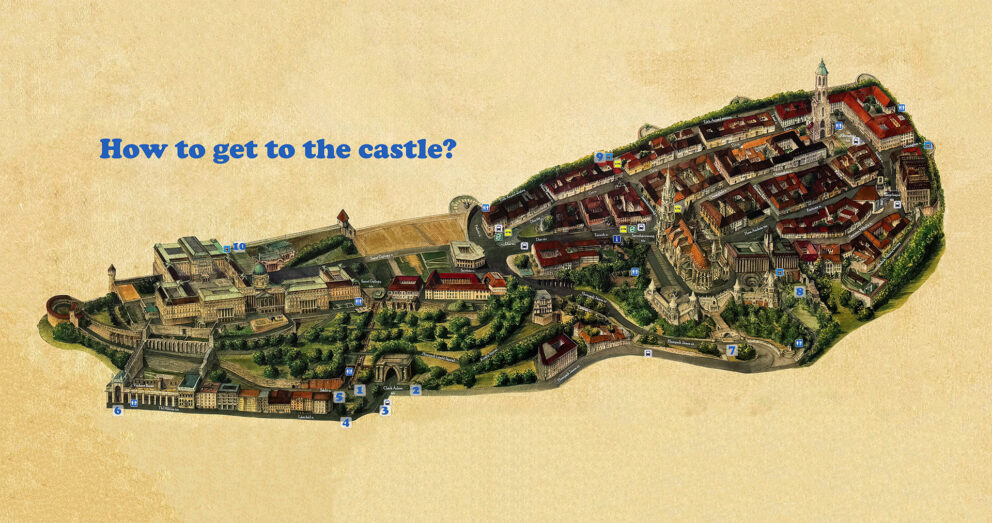
- Buda Castle Funicular The 153-year-old Buda Funicular is the most spectacular means of transportation, mainly a spectacular solution for tourists. Budapest residents rarely use it due to its steep price. An adult return ticket costs 4000 HUF (around $13), while a child ticket is 2000 HUF (about $6.5). One-way tickets are not available. Tickets can only be purchased at the bottom of the hill! The funicular covers a distance of 95 meters over a 50-meter elevation.
- Royal Staircase (the secret staircase) You need to be in good shape if you choose this route. There are many steps to climb to reach the castle. However, the good news is that halfway up, there’s a small rest area with a large terrace that offers a beautiful panorama of the Pest side. The 70-meter elevation difference can be covered in 10-20 minutes. You’ll end up at the funicular’s final station. I highly recommend this route for those who are up for it.
- By Bus You can take either bus number 16 or 216 to the castle. They follow the same route until Disz Square, where they split. I recommend bus 16, which starts from Deák Square and, due to its smaller size, can navigate the narrow streets of the castle better, enhancing our experience. Remember, you need to buy a ticket for each boarding, or it’s worth using a day ticket for unlimited travel. If you prefer not to climb stairs, this is another option I gladly recommend!
- By Electric Mini Bus The daily ticket price is 6000 HUF (about $20) for adults and 4000 HUF (about $13) for children (6-16 years). It’s free with the Budapest Card! Available every day from 9 am to 5 pm (until 4 pm in winter). With the day ticket, you can use the bus all day to move quickly within the castle. The mini bus does not go to the western part, which can only be reached on foot.
- Sikló Road (0 km stone) This route starts from the zero kilometer stone, from which the distance of roads starting from Budapest is measured. The road is quite long with many cobblestone sections, so high heels are not recommended. This road is currently under renovation and is not usable. We arrive at the Buda Castle Funicular’s final station. The path is quite steep, taking 10-20 minutes to ascend.
- Elevator, Escalator, or Many Stairs The Castle Garden Bazaar (the westernmost part of the castle) can also be approached. The simplest way to get here is by tram number 19. You have three options: A. If the escalator, which is Europe’s longest covered escalator, is working, we can reach the first level with it (currently free). B. If the escalator to the first level is not working, we can either take the elevator or the stairs. From this level, a few steps and then an elevator take us further, with another elevator reaching the top of the castle. This route is not recommended if you prefer to avoid stairs (20-30 steps). C. The Water Carrier’s Staircase is also an option.
- On Foot from Fisherman’s Bastion You can arrive on foot or by car. You can also take bus number 16 or tram number 19 (from which there is quite a walk). All things considered, this is a journey of more than half an hour. Recommended for hikers only!
- On Foot from Hilton Hotel This route is also challenging as it requires reaching the hotel somehow (bus 16, tram). You can also park in the surrounding streets if you arrive by car. The good news is that instead of the wooden staircase, you can choose the “school” elevator, saving 80-100 steps.
- Elevator at the Rock Hospital This approach could be a good choice if you plan to visit the Rock Hospital and then go up to the castle. It’s easy to find parking in the surrounding streets by car.
- Elevator (with bicycle storage) Located at the back northern part of the castle, precisely opposite each other are two larger elevators. They take us up to the Stockl stairs. For those who dislike stairs, don’t worry. Passing in front of the main guard’s red brick wall, we find another elevator that takes us all the way to the castle. This elevator is mainly used by those arriving by car, bicycle, or tourist bus. Parking conditions in the streets around the elevator’s lower station are much more favorable than in the castle. If arriving by bicycle, there’s a bicycle storage at the elevator where we can securely leave our bike. This route is also a perfect choice for wheelchair users or those with mobility impairments, as stairs and ramps facilitate movement.
- By car If we opt to approach the castle by car, it’s crucial to be aware that the castle area is a protected zone. The maximum duration for entry and exit by car is limited to 15 minutes. After this period, a fee must be paid. It’s also important to note that while parking might be free in other zones, it’s chargeable here! If you’re determined to go by car, considering a taxi or a private driver might be worth your while.
Buda Castle quarter
The Buda Castle District stretches over one and a half kilometers. To visit every place, we’d need to walk about 14 kilometers. The castle district is over 800 years old (construction began in 1243), situated on the banks of the Danube (70 meters high, with an altitude of 165 meters above sea level) and offers a stunning view of the Pest side.
For us Hungarians, the Buda Castle District holds significant importance. It has withstood sieges, fires, earthquakes, and even world wars without being destroyed. We take particular pride in its inclusion on UNESCO’s World Heritage list.
The royal seat was not always in Buda Castle. However, the endless devastation of the Mongol invasion made King Béla IV realize the need for a safer, more siege-resistant royal residence, leading to the choice of Buda Castle in 1255. The following three hundred years passed in relative peace.
Around this time, the cave system underneath the castle hill was discovered. The buildings under construction were connected to these underground corridors over several floors, which, if necessary, provided (and still provide) access to the Danube.
The true golden age of Buda Castle came during the reign of Matthias Corvinus. Artists and architects from Italy helped the city’s population reach 8,000 people.
Known as “Golden Apple” by the Turks (Kizil Elma), Buda fell into Turkish hands 50 years after Matthias’ death, beginning 150 years of Turkish rule. During this time, beautiful churches were converted into mosques and minarets. Gorgeous statues, ornate gardens, and crosses were replaced with crescents atop towers. The Turks neglected the castle entirely. It took 150 years and a massive 75-day bombardment by a united Christian force to recapture Buda from the Turks. The population of the castle was then only 300. The new inhabitants rebuilt the castle from the remnants of the old buildings, many of which are still visible today. The castle saw action again during the 1848-49 revolution and was heavily damaged in World War II. Completely encircled, German troops entrenched themselves here. This was the 31st siege of the castle! After the war, the castle was rebuilt again. Since then, the Buda Castle District has been continuously restored and beautified.
I will describe the Buda Castle District in the following parts:
- Castle Garden Bazaar and its surroundings
- Royal Palace and its surroundings
- Holy Trinity Square and its surroundings
- Vienna Gate Square and its surroundings
Buda Castle tickets
Visiting the Buda Castle District is free of charge. The Buda Castle offers a wealth of fascinating sights and tourist attractions.
However, there are fees for museums and guided tours.
Here’s what you need to pay for in the Buda Castle District:
- Castle Museum admission: 12 EUR
- National Gallery in the Buda Castle District: 12 EUR
- Rock Hospital under Buda Castle: 15 EUR
- Labyrinth under Buda Castle: 12 EUR
- Fisherman’s Bastion viewpoint: 3 EUR (free until 9 AM)
- House of Houdini: 13 EUR
1. Buda Castle Funicular
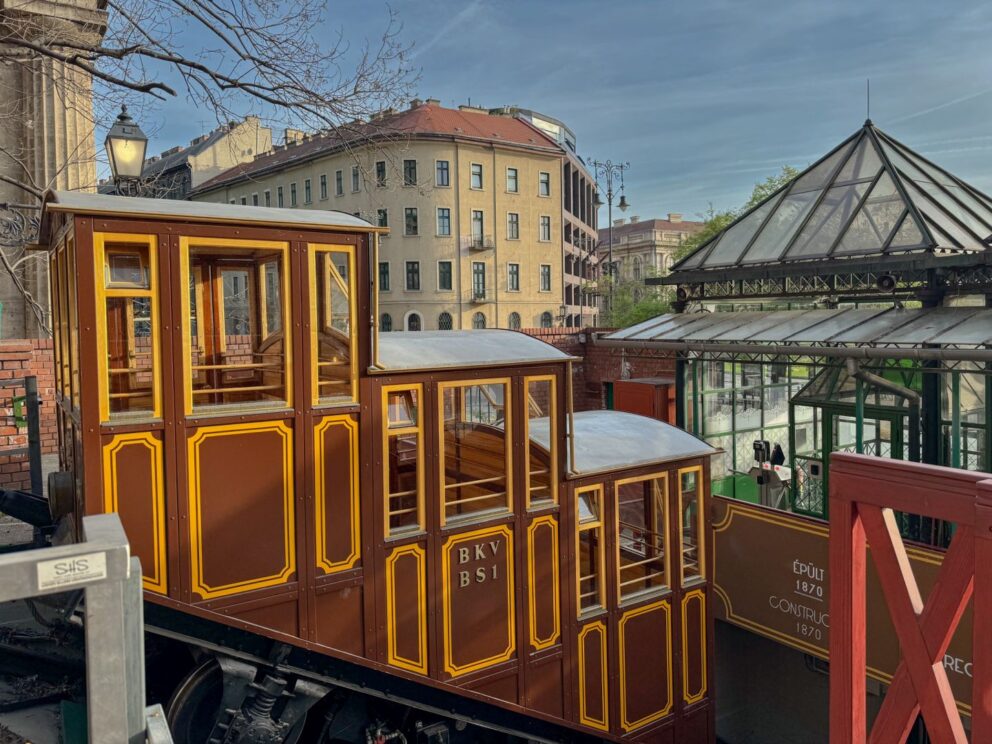
The Buda Castle Funicular commenced its operation on March 2, 1870, connecting the Danube bank with the Buda Castle District. It starts from Clark Ádám Square and goes up to the Turul statue. The journey is 101 meters long, with an elevation of 50.5 meters, which translates to a 30-degree incline. Each car can accommodate 24 passengers.
At the time of the Funicular’s construction, there was a so-called “Pleasure House” operating on top of the Tunnel, likely demolished in the 1970s.
Tickets can only be purchased at the bottom station, and only return tickets are available. The return ticket system is due to the Funicular’s two cars, named Margit and Gellért, being connected in a pendulum-like manner, meaning they counterbalance each other. As one car descends, the other ascends.
Upon its launch in 1870, a 35-horsepower steam engine located at the lower station powered the vehicle. This engine essentially assisted the haulage, as the two cars pulled each other.
The Buda Castle Funicular was the second of its kind to be commissioned in the world, presenting a significant challenge to engineers. After its completion, it was tested continuously for several days, and the ropes were even cut to test the emergency brake.
The Funicular has had only one accident in its operation, in 1896, attributed to unfortunate circumstances. Overloading occurred, the engineer’s shift ended, and he left the operation to the stoker, who braked too late, causing the cars to crash into the wall. The passengers only suffered minor injuries.
At that time, it was possible to purchase first and second-class tickets for the Buda Castle Funicular. Nowadays, only one type of ticket is available.
During the World War II bombings in 1945, the Funicular was hit. The restored Buda Castle Funicular resumed operation on June 3, 1986, now powered by electric motors. The 54-kilowatt electric motor is placed in the machine room below the upper station.
Open every day from 08:00 – 22:00. It’s advisable to inquire in advance about the opening hours, as it often undergoes maintenance.
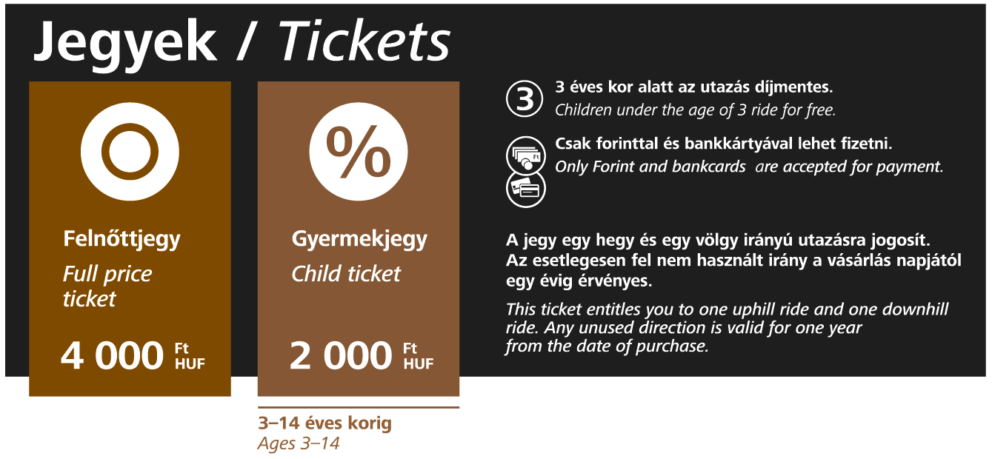
Maintenance occurs every odd week on Monday, except if it falls on a public holiday or celebration. In such cases, maintenance is performed on the first working day following the holiday, causing the Funicular to be out of service for several days.
Online tickets are also available, saving time as there’s no need to queue at the location.
2. Labyrinth of buda castle

The Buda Labyrinth currently has one main entrance. Of course, there are several secret and less-secret entrances as well, which are closed.
You can enter the Buda Labyrinth without a guide, with yellow arrows helping with navigation. It takes about half an hour to walk through the labyrinth. It’s important to note that only cash is accepted for ticket purchases! The labyrinth can be visited in casual street clothes. However, be prepared for the temperature inside the labyrinth to be around 16-18 degrees Celsius!
The cave system under Buda Castle was not excavated by humans but formed naturally as spring water carved its way through the rock layers in the mountain. However, it was indeed humans who later connected them into a system. The cave system has been hidden within the mountain for centuries, witnessing many secrets over time!
The caves were used by the population as storage spaces as early as the 13th century. They brought down their grain reserves and wine stocks for storage.
The Turks used the tunnel as a refuge and connected it to their houses’ cellars. These connections were later walled up due to numerous robberies occurring through the caves.
At the end of the 1800s, the caves were reopened and made accessible to the public.
3. Matthias Fountain in Buda Castle
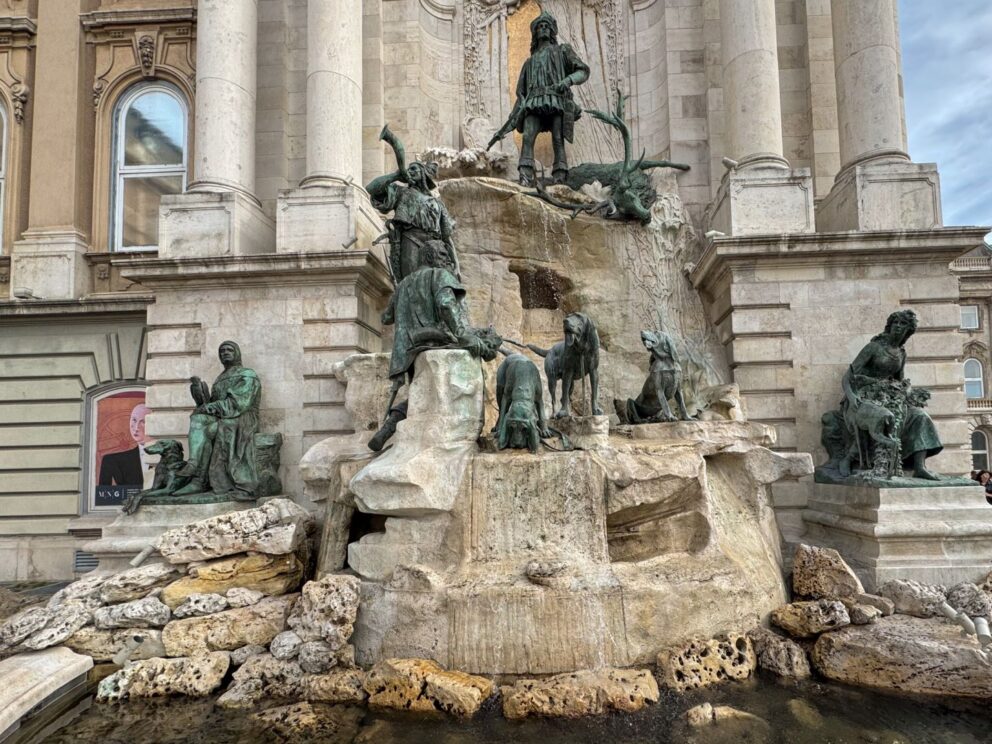
Budapest has its own version of Rome’s Trevi Fountain, located in the Hunyadi Courtyard of the Buda Castle! The Matthias Fountain is one of the most beautiful and impressive fountains in Hungary, gracing the north side wall of the former chapel of Buda Castle since 1904.
Legend has it that King Matthias often roamed the country in disguise to get a true picture of the people’s conditions. One story tells of Matthias, dressed as a hunter, roaming the forest with his entourage when he met a young woman with whom he fell in love, yet he did not reveal his identity. Later, Ilonka came to Buda to meet her beloved, who was returning from a victorious campaign, dressed in full royal splendor. Ilonka recognized the king in the hunter and realized that their beautiful meeting could not continue. The young woman’s heart was consumed by hopeless love and sorrow, and she eventually died from it. This legendary tale is brought to life at Matthias Fountain. At the top of the rock spring, the scene centers on the king dressed as a hunter, surrounded by his entourage and hunting dogs. To the left is Galeotto Marzio, the king’s famous Italian poet, holding his notes and a hunting falcon on his arm. On the right side of the fountain is the delicately sculpted figure of beautiful Ilonka, as her gentle deer nuzzles up to her.
Interestingly, the artwork features a total of ten animal depictions, yet most people only spot eight. The missing two are actually on the chief hunter’s spear, represented by two opposing boar heads. Another point of interest is that during World War II, one of the hunting dogs (a vizsla) disappeared and had to be replaced later.
Interesting fact:
If you observe the statues around Budapest closely, you’ll notice an interesting thing. Most of these artworks are covered with a green layer. These pieces are generally made from a yellowish metal or its alloy. This outer coating, called patina or noble rust, develops due to the weathering effects of the open air and precipitation. This layer, unlike ordinary rust, actually protects the creations and perhaps even enhances their beauty. It is not recommended to remove this layer as doing so would also strip off the sculpture’s top layer, thinning the material and dulling the details.
4. Turul Bird on the Walls of Buda Castle District
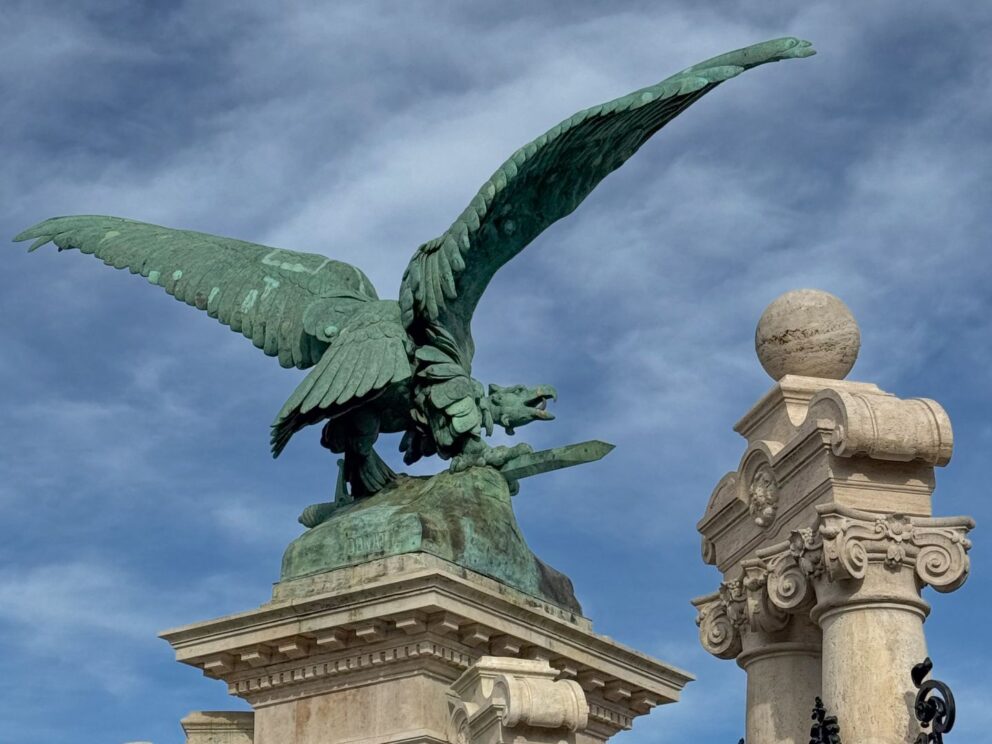
The Turul statue is one of the most popular attractions in the Buda Castle District. Created by Gyula Donáth in 1905, it was restored in 2021. The statue stands 5 meters tall, spans 7 meters wide, and weighs 9 tons (9000 kg). A massive 60-ton crane was used to lift the statue into place from the Hunyadi Courtyard side.
The sculptor depicts the bird with its wings outstretched (the wings were reinforced with iron during the renovation to better withstand the wind) as it gazes down from the top of Castle Hill, clutching a sword in its talons. According to legend, during the conquest of the homeland, our ancestors were led by a Turul, and they were to settle where the Turul dropped the sword.
5. Sándor Palace and the Changing of the Guard at the Castle
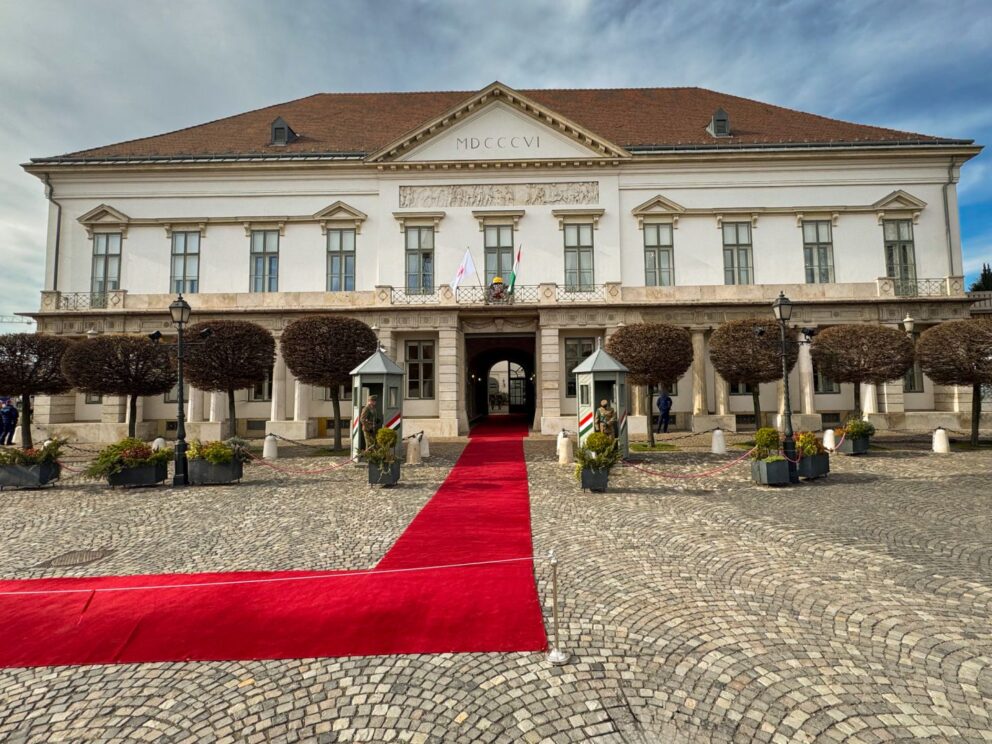
Sándor Palace, designed by Johann Aman and Mihály Pollack in the neoclassical style, was built around 1806 and restored in 2002. The façade of the palace displays the year of its construction in Roman numerals (MDCCCVI) 1806, below which the Hungarian coat of arms is placed. Flanking the coat of arms are two flags: the red, white, and green Hungarian national flag, where red symbolizes strength, white fidelity, and green hope; and the European Union flag, blue with yellow stars representing the member states.
The palace is named after Count Vince Sándor, whose family once owned the land where this magnificent white palace now stands. Following the extinction of the Sándor family, the palace underwent several renovations and for many years served as the home of Hungary’s prime ministers. Prime Minister Gyula Andrássy lived here and later secured ownership for the state from the Pallavicini family.
One of the most famous members of the Sándor family was Móric Sándor, known as “the devil’s horseman” and the son of Count Vince Sándor. Móric offered half a year’s income from his estates for the construction of the Chain Bridge.
Who was the devil’s horseman? Móric Sándor, the count’s son, was frail and weak from birth, so his father protected him from even the slightest risks. Móric only rode a horse for the first time at the age of 17 (after his father’s death), and he rode as though born in the saddle, performing daring stunts on horseback. He cared for nothing but riding, even riding his horse up the castle stairs. A hereditary mental illness later manifested in him. He often deliberately rode into stone walls, and his dangerous stunts frequently resulted in broken bones, dislocated knees, or concussions. In his old age, his mind completely deteriorated, and he is remembered by posterity as “the devil’s horseman.”
Today, the palace serves as the office of the President of the Republic. When foreign political dignitaries visit Hungary, the President receives them in the grand halls of Sándor Palace.
Tourists cannot visit the Gobelin or Boucher Room, also known as the Neo-Baroque furnished Blue Reception Salon, the Red Salon, or the Rococo Mirror Room, where the most imposing protocol events and banquets for diplomatic corps representatives are held.
Thus, tourists can only witness the ceremonial changing of the guard. The Presidential Guard performs this duty, with a formal changing of the guard taking place every noon. The palace guards change hourly from 10 AM to 5 PM.
6. Rock Hospital under Buda Castle
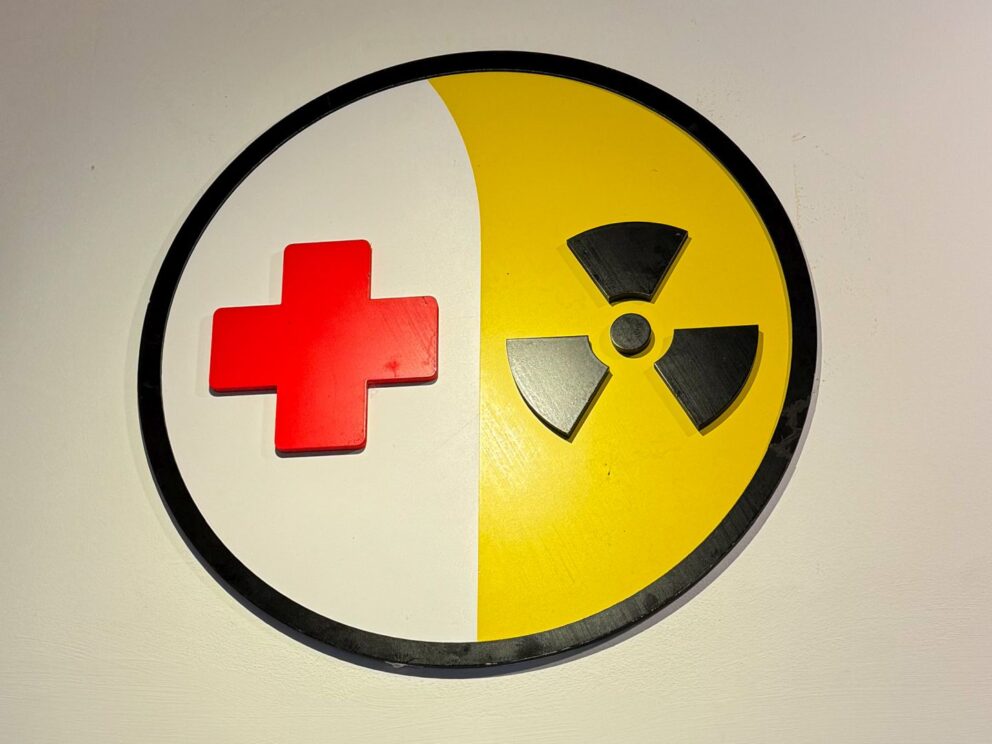
The Rock Hospital is located beneath the Buda Castle District, with its entrance under the castle walls. Officially known as the Rock Hospital Nuclear Bunker Museum, it is a site I wholeheartedly recommend to everyone, whether you’re visiting the museum or just exploring the Buda Castle District. It’s not by chance that it is one of the most visited museums in not just Budapest, but all of Hungary.
The Rock Hospital uses original objects and equipment to bring its past to life. The massive cave system underneath the Buda Castle District is divided into three separate parts:
- Rock Hospital
- Castle Labyrinth
- Natural corridors and cave systems preserved in their original state
The Rock Hospital is located deep within Castle Hill, spanning over 2,300 square meters in a 10-kilometer-long cellar system. The Rock Hospital has three major sections:
One part of the exhibition talks about the medical work that took place here during World War II and the events of 1956. Visitors can walk on the original flooring, between the original walls, and see the rooms in their original function, furnished with wax figures and authentic objects from the 1940s to the 1980s.
Interesting fact: During the 1956 revolution, seven babies were born in the Rock Hospital—six boys and one girl!
Another part is the engine room where you can learn more about nuclear warfare. The shelter was also prepared for a nuclear attack, but, unfortunately, it would not have provided refuge for everyone.
In the 1930s, a telephone exchange operated here, and in 1941-42, the place was expanded into a shelter for the castle’s residents. The hospital construction began in 1943. Initially designed to accommodate sixty patients, the hospital was equipped to European standards with water and fuel storage available.
The Rock Hospital officially opened on February 23, 1944. During World War II, it could simultaneously treat up to 300 wounded soldiers. Everyone in need, including German soldiers, was cared for.
The Rock Hospital and nuclear bunker were opened to the public in 2007. Visits to the Rock Hospital are only possible through organized tours because its vast area could easily cause individual visitors to get lost. Tours start every one to two hours. For Hungarian tourists, I recommend the 2 PM program, which is an extended 90-minute tour instead of the usual 60 minutes.
Tickets should always be purchased online.
Summary of Rock Hospital
6. Statue of the Virgin Mary and Lookout in Buda Castle
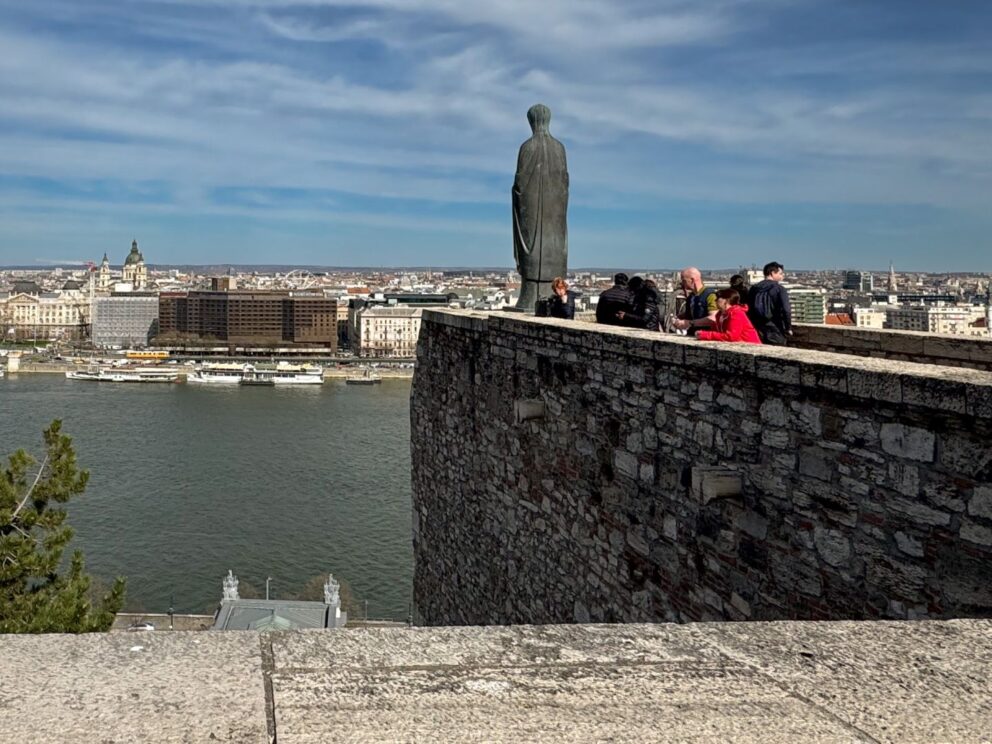
Since the end of 2013, a 4-meter-tall (403 cm) bronze statue of the Virgin Mary has stood on the southern side of Buda Castle, on the top of the Corinthian protective wall, facing the Danube. This newly renovated part of the castle functions not only as a scenic viewpoint but also as a resting spot and a popular place for taking selfies. If you’ve taken the stairs instead of the lift from the Danube up to this point, it’s a perfect place to rest and enjoy the fantastic panorama.
There is also a life-sized replica of this statue, which is occasionally displayed within the castle district. Interestingly, the Virgin Mary’s arms do not touch the little Jesus in the sculpture. Virgin Mary is also referred to as the Divine Mother bringing victory. The figure of the Victorious Mary has become historically intertwined with Buda Castle.
Legend has it that during the siege of Buda Castle, which was then in Turkish hands, a wall crumbled suddenly revealing an image of Mary, which inspired the Christians for their final assault and utterly confused the Turks.
8. Fisherman’s Bastion: The Watchful Eye of Buda Castle

Fisherman’s Bastion is one of the most visited tourist attractions in Buda Castle. It offers a stunning panorama of Pest and is an ideal spot to watch the sunrise.
During the day, you need to purchase a ticket to enjoy the panoramic views. However, outside of specified times, the gates are open and can be visited for free:
From January 2 to May 31: 9 AM to 7 PM
From June 1 to September 30: 9 AM to 9 PM
From October 1 to December 23: 9 AM to 7 PM
It’s worth checking the sunrise times and securing the perfect spot at the edge of the bastion half an hour earlier!
Fisherman’s Bastion was constructed to commemorate the 1000th anniversary of the Magyar conquest of Hungary, not for defensive purposes. It was designed partly to frame the centuries-old Matthias Church beautifully, and partly to create a viewing terrace from which everyone could admire how beautifully Pest, across the Danube, had developed by the time of the millennium celebration.
Fisherman’s Bastion was built on the site of the old Buda castle walls, and it got its name because this part of the wall was historically protected by the fishermen’s guild during sieges, with a fish market operating at the foot of the hill. The seven towers of the bastion symbolize the seven chieftains of the Magyars.
Indeed, the view from Fisherman’s Bastion towards Pest is breathtaking.
The tallest buildings on the Pest side are the Parliament and St. Stephen’s Basilica, each standing 96 meters tall. This number references the year of the conquest (896). Legislation mandates that no buildings within the city limits can be taller than this height.
9. Statue of Saint Stephen: The Most Beautiful Statue in Buda Castle
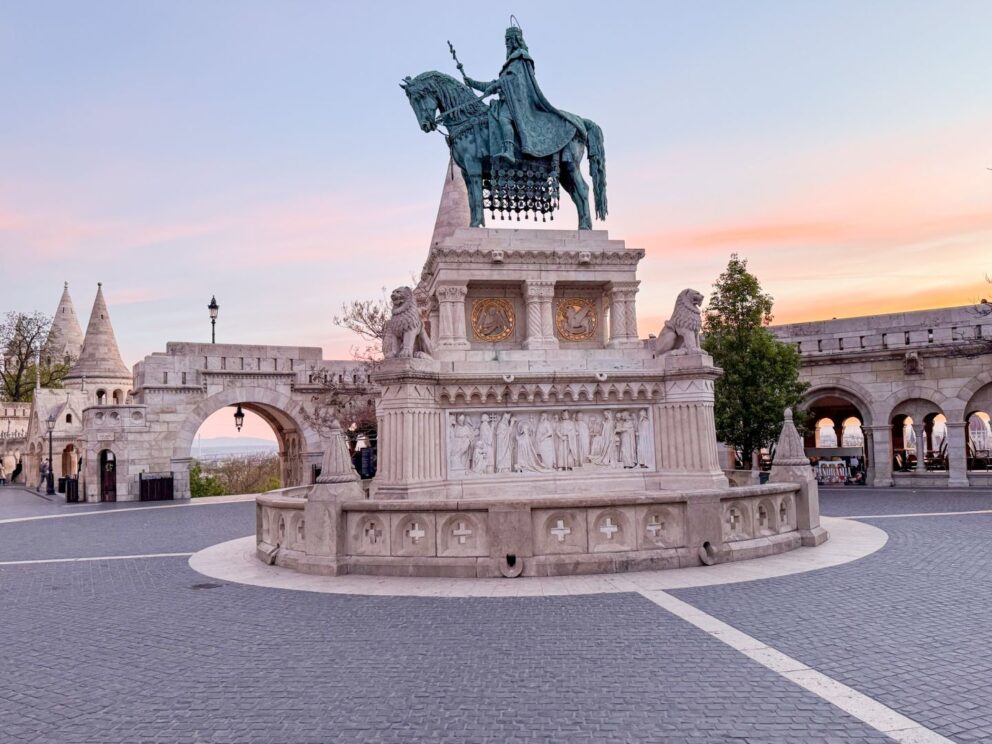
The statue of Hungary’s first king, Saint Stephen, is located near Matthias Church, at the base of Fisherman’s Bastion. The sculptor, Alajos Strobl, created this equestrian statue of Saint Stephen in 1906.
The statue portrays King Stephen on a richly adorned steed. He wears the Holy Crown on his head and holds the Apostolic Cross in his hand. The halo above the king’s head reminds us that Stephen was canonized as a saint 45 years after his death.
The base of the monument features four rounded bastions, each representing a significant moment in Saint Stephen’s reign:
- Front side: Legislation
- Left side: The submission of Vienna
- Right side: The coronation of Stephen as king
- Back side: The founding of the cathedral in Székesfehérvár
Above these, a stepped pedestal rises, guarded at each corner by four limestone lions.
Between the columns, symbols of the four evangelists from the Bible are visible: the Angel for Matthew, the Bull for Luke, the Eagle for John, and the Lion for Mark.
At the front, the Lamb of God is depicted, and at the back, the double cross is displayed.
10. Trinity Column

Following the liberation of Buda Castle in 1686, the settlers were struck by a plague epidemic in 1691. During the epidemic, the citizens vowed that if the “Black Death” passed, they would erect a statue of the Holy Trinity in gratitude. Funds were hard to come by, and it was only the recurrence of the epidemic in 1699 that accelerated the fulfillment of the vow to build the column.
At the very top of the statue is the Holy Trinity: the Father, the Son, and the Holy Spirit, represented by a dove. The column, adorned with clusters of clouds, features angels (putti). The base is decorated with statues of the Virgin Mary and saints who are protectors against the plague. The memorial column has three reliefs:
One depicts King David praying to God to end the plague.
The second recalls the memory of the epidemic.
The third commemorates the work of the column’s builders.
The sculpture was created by the sculptor Fülöp Ungleich, and the carvings of the reliefs and crests were done by Antal Hörger.
The Trinity Column was recarved based on the original, as well as contemporary photographs and descriptions, which is why it appears so new. The original column is preserved in the Kiscelli Museum.
The column gained its current form in 1856! This year is represented by a “chronosticon,” which is a type of puzzle where letters within the Latin texts above the shrine praying to the Holy Trinity and below it appealing to the Immaculate Virgin are read as Roman numerals that sum up to 1856.
11. Matthias Church
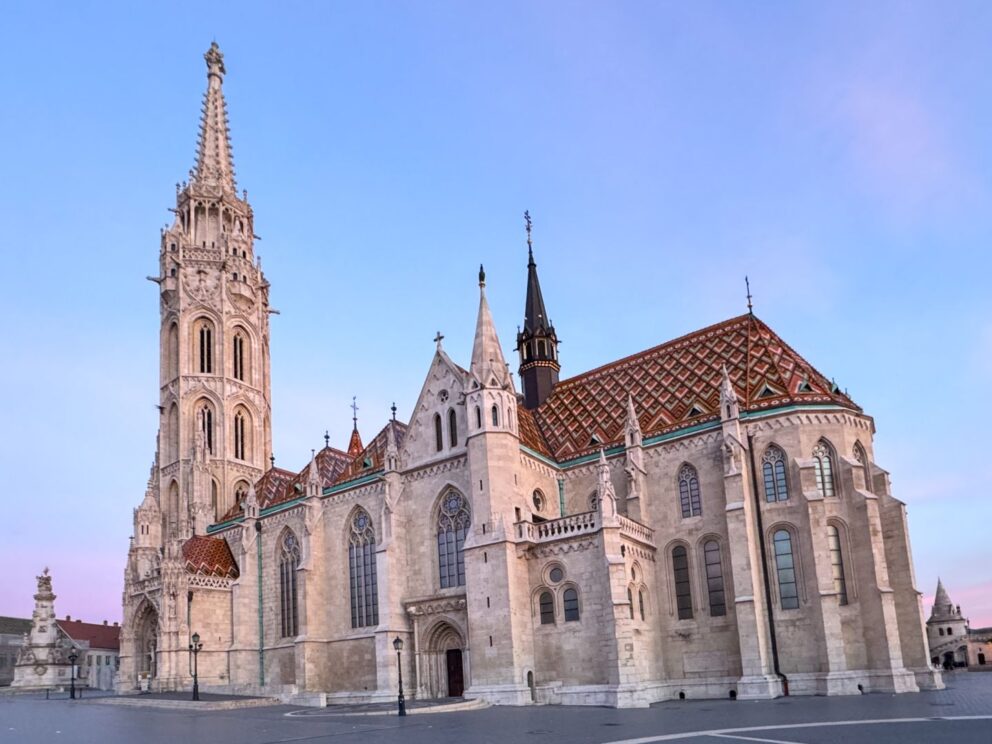
The Church of Our Lady, commonly known as Matthias Church, is the only functioning Catholic church in the Castle District and boasts a rich history. It is one of Hungary’s most famous buildings, with its spire forming an integral part of the Budapest skyline. It’s a perfect tourist attraction, offering not just a masterpiece of Gothic architecture but also stunning views for those visiting. However, stepping inside is equally rewarding as the walls tell nearly eight hundred years of history, during which the church’s collection has been enriched with numerous art treasures.
The church was originally built under the reign of King Béla IV. It is dedicated to the Virgin Mary, revered in medieval religious culture as “Our Lady of Great Blessing.”
Matthias Church has served as the venue for various significant events, including coronations, royal weddings, national councils, and the blessing of flags before battles.
King Matthias himself was married twice in this church—first to Catherine and then to Beatrice.
After Buda fell into Turkish hands, the church was immediately converted into a mosque. As the Islamic faith prohibits the depiction of human figures, the altars and sacred images were destroyed, and everything was removed from the building, leaving only the bare walls. Paintings and flags were burned, and the two beautiful candlesticks that adorned the church’s altar were sent by the sultan to Istanbul, where they still decorate a mosque today.
After 150 years of Turkish rule, the Habsburgs converted the mosque back into a church, during which it was referred to as the “German Church.”
The church’s roof is adorned with beautiful hexagonal-patterned, colorful tiles made from pyrogranite by the famous Zsolnay porcelain factory.
Numerous gargoyles decorate the church. On the octagonal Matthias Tower, two rows of eight dragons each channel and spit out rainwater. Other parts of the church feature gargoyles in the forms of bats, witches, dogs, and pig-like creatures.
From the top of the church, visitors can enjoy a breathtaking view of the entire city.
12. Tactile and Invisible Relief
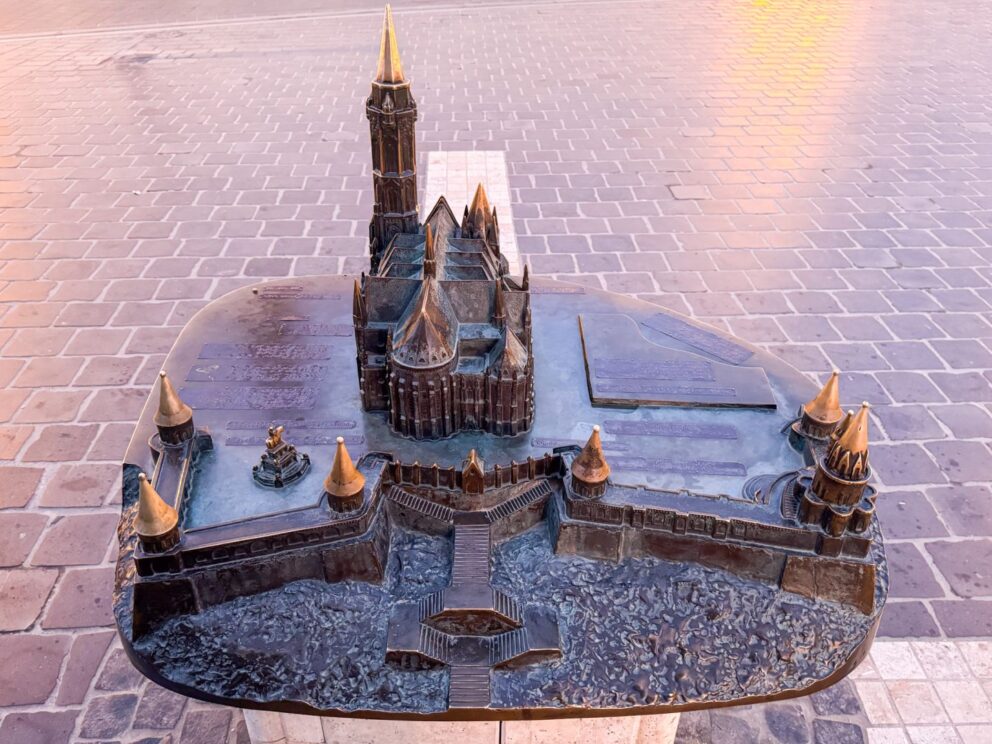
This relief sculpture was created specifically for the blind and visually impaired. It depicts Matthias Church and its surroundings. Between the buildings, important information about the relief and the depicted area is provided in Braille. This enables those who are visually impaired to touch and feel the layout and architecture, offering a sensory experience of the historical site.
13. Árpád Tóth Promenade with Cherry Trees
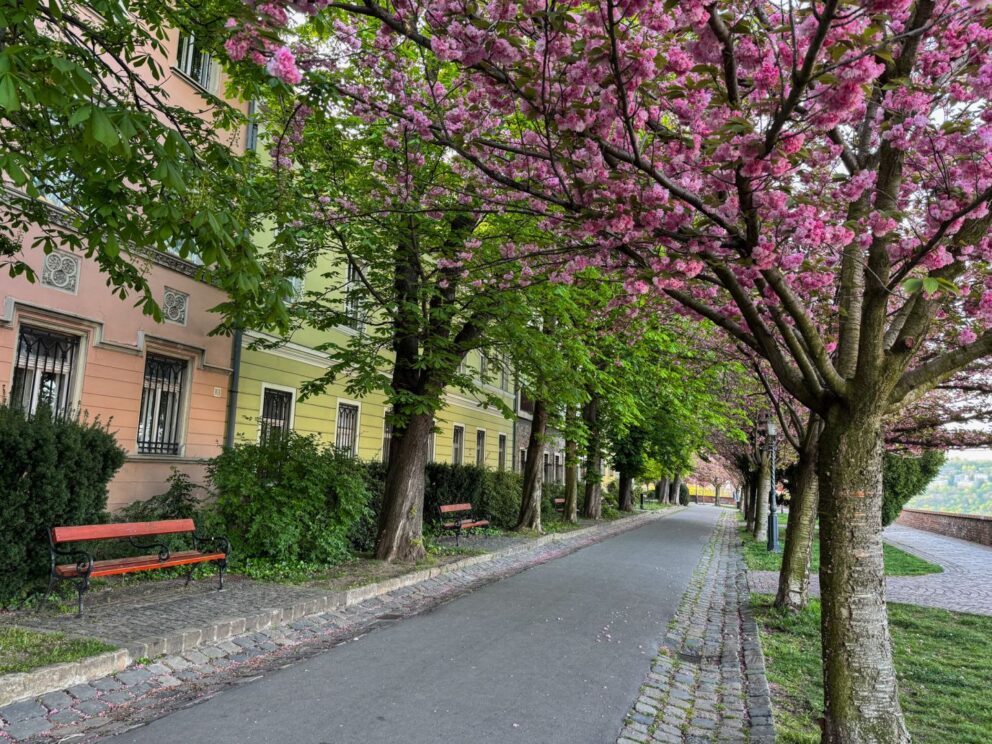
Budapest’s first and arguably most beautiful avenue of trees is a jewel of the Buda Castle District. Originally, the area behind the castle walls served military purposes. The promenade was established only after the castle’s fortification features were decommissioned. It was planted with trees in the 19th century and then opened to the public. It’s one of the most beloved parts of the Castle District, offering stunning views of the Buda hills and parts of the palace. In April and May, during the cherry blossom season, the sight is particularly breathtaking.
The promenade is named after the famous poet and translator, Árpád Tóth, who was a resident of the Castle District.
14. Pavilion on Árpád Tóth Promenade
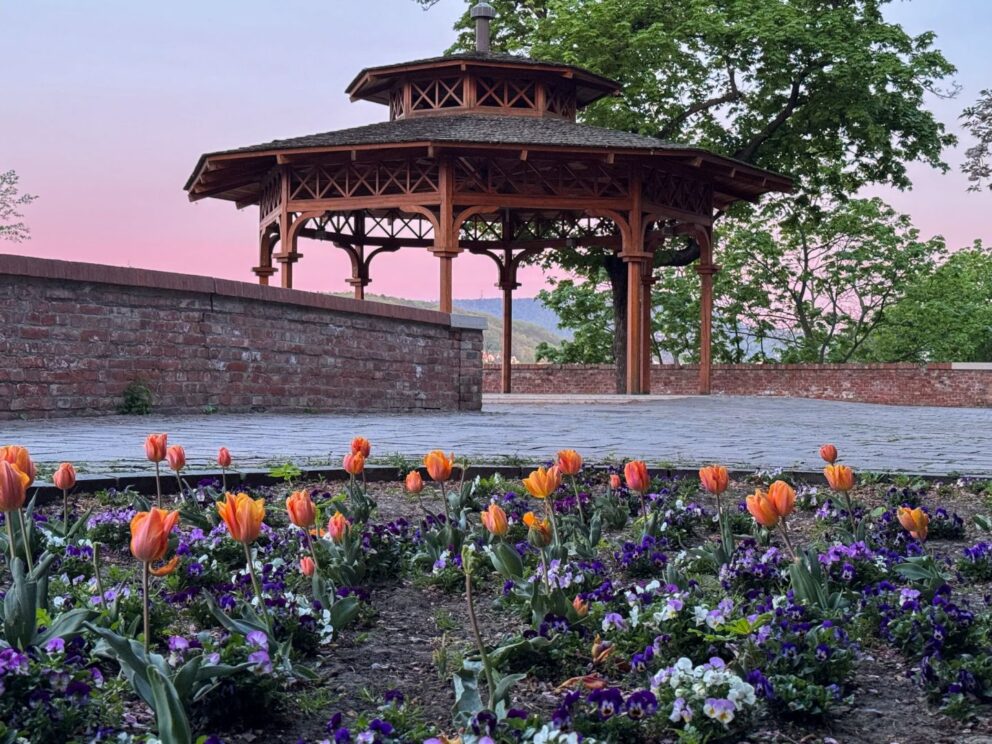
Along the Árpád Tóth Promenade, you can find a wooden pavilion located on one of the rondels. Its original Turkish name, Eksi as Kuleszi, means “sour juice.” This is why it is also sometimes referred to as the “Sour Soup Bastion.” The interior of the tower conceals vaulted casemates, underground spaces that were once filled with cannons.
In the early 20th century, the pavilion hosted a band that played every Sunday, providing entertainment for those strolling along the promenade. The pavilion was rebuilt in the 2010s, restoring its historical charm and continuing its legacy as a delightful spot for visitors to enjoy music and relaxation in the heart of the Buda Castle District.
15. Transylvanian Second Hussar Regiment Memorial
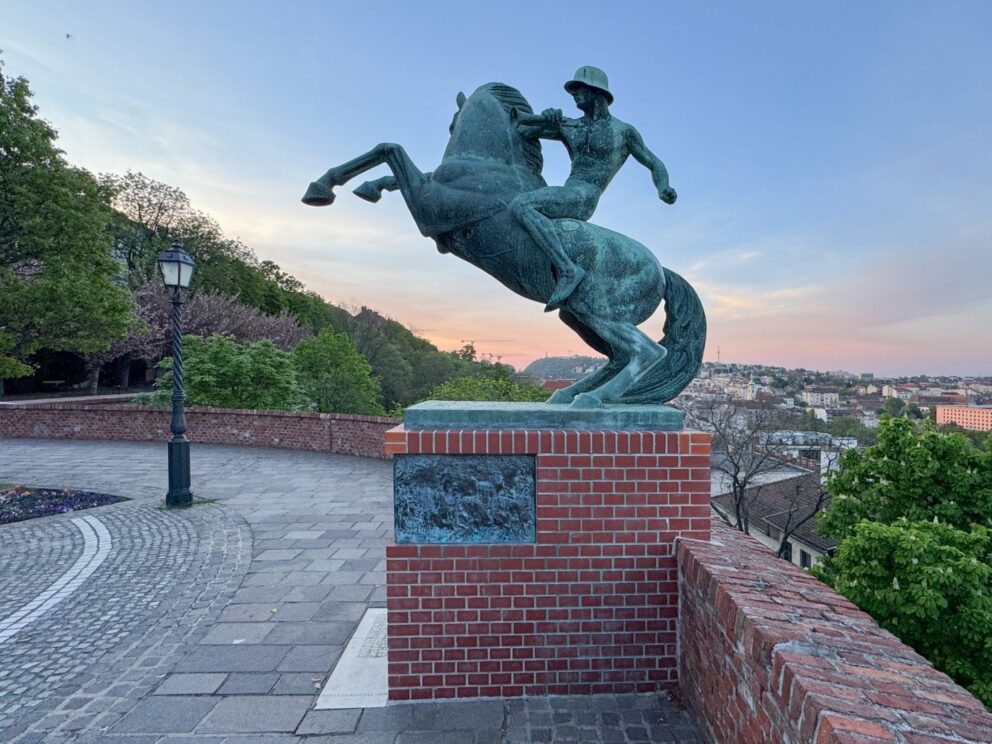
Located at Veli Bej Bastion, the memorial dedicated to the Transylvanian Second Hussar Regiment honors their service in World War I. The bastion itself is named after the Turkish Veli Bej, who is also associated with the famous Veli Bej Bath nearby. This site serves as a poignant reminder of the sacrifices made by the regiment during the war, encapsulating both historical and cultural significance within the Buda Castle District.
Interesting Fact:
An interesting note about equestrian statues: it is often said that if the horse has both front legs in the air, the rider died in battle; if the horse is standing with all four legs on the base, it signifies that the rider died of natural causes. While the truth of this lore may vary, it’s undeniable that the more a horse’s pose deviates from all four legs on the ground, the more challenging it is to balance and secure the statue.
16. Old Buda Town Hall
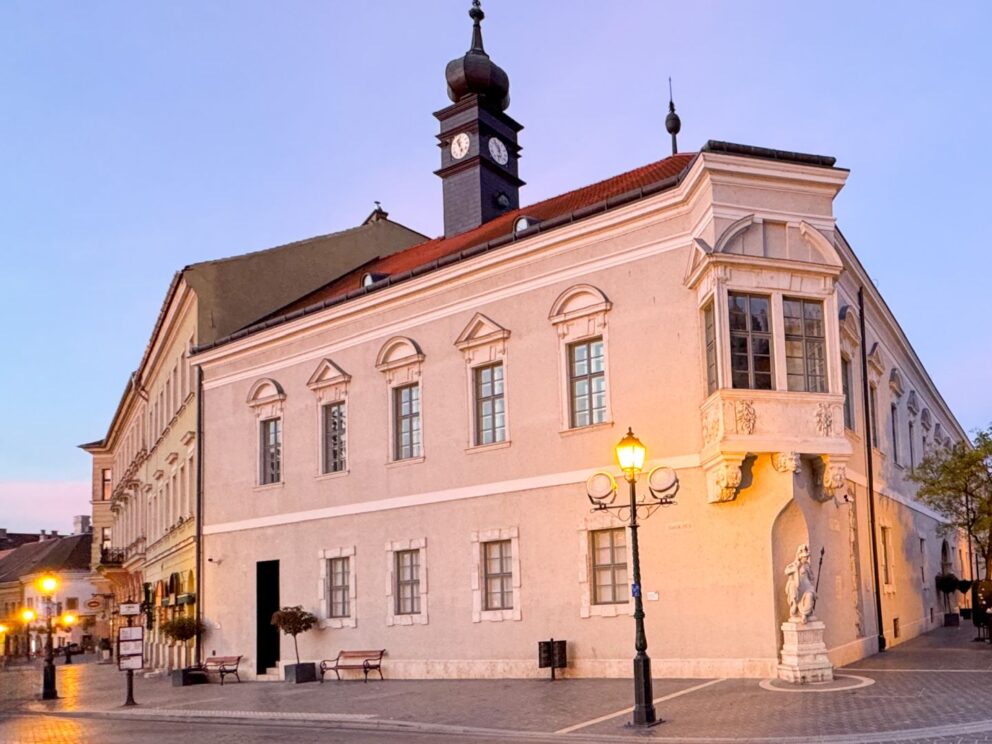
The Old Buda Town Hall is one of the oldest buildings in Buda, boasting a history of 800 years. After the recapture of Buda in 1686, it was constructed on the remnants of 13th-century houses. One of its distinctive features is the ornately carved corner balcony, beneath which sits a limestone statue. This sculpture depicts Pallas Athena, the Greek goddess who was a protector of cities. In her right hand, Athena holds a shield adorned with the coat of arms of the city of Buda, and in her left, a spear.
The statue is a replica made in 1965; the original is kept in the Budapest City Hall. Beneath the building, a trapdoor provides access to the labyrinth, and the area underneath the house once served as a prison.
17. Ruszwurm Confectionery
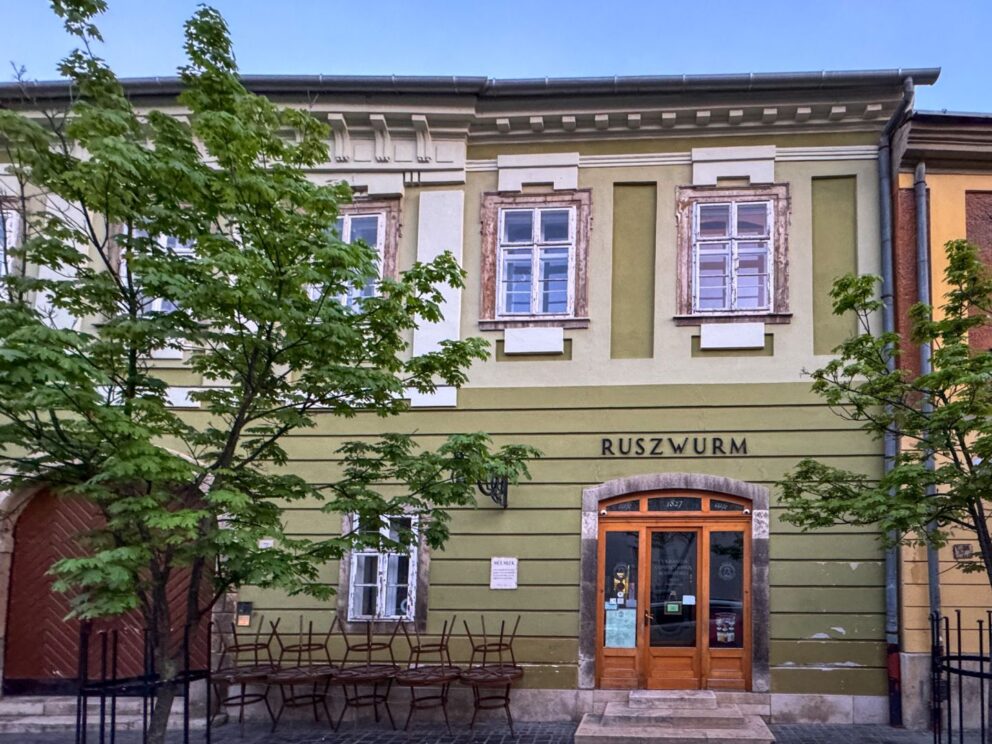
Operating continuously since 1827, Ruszwurm Confectionery is the city’s oldest and most distinguished pastry shop, located in this very building. Over the years, it has served dukes, princes, and even members of the royal family, who enjoyed sweets delivered from here. The confections were transported in boxes adorned with miniature images of Matthias Church or Buda Castle.
Ruszwurm’s mint sticks were so famous that they were even shipped to Vienna. Remarkably, the original furnishings of the confectionery have survived the tumult of the 1849 revolution and the sieges of World War II, making it not only a culinary landmark but also a piece of living history.
18. King Matthias Relief on the Wall of Nicholas Tower
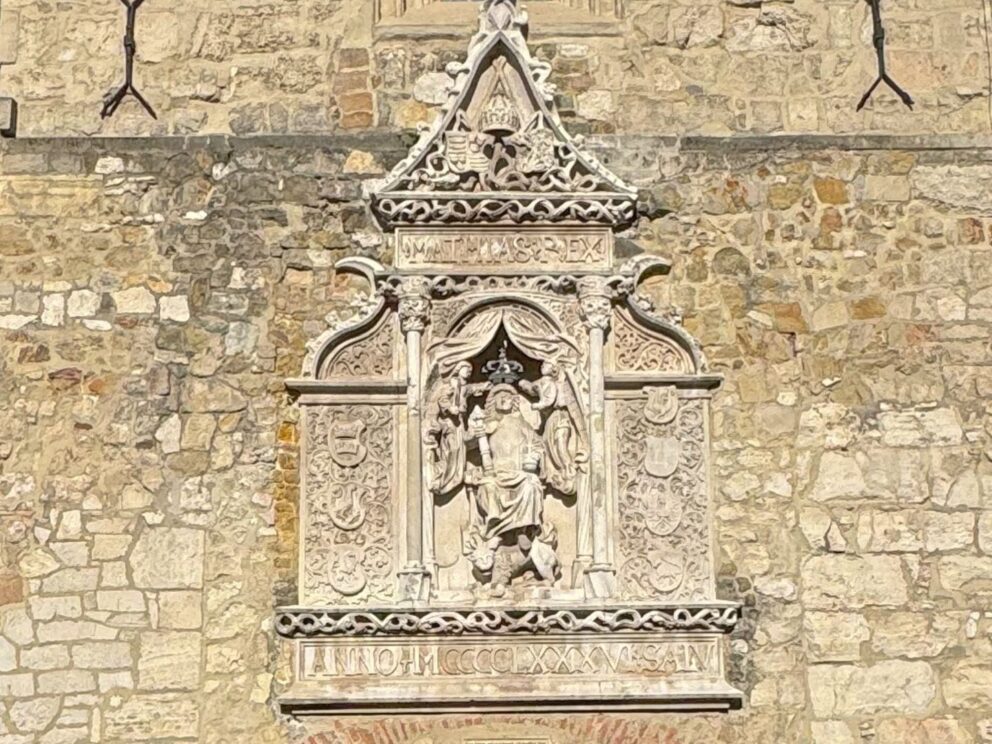
This artwork is considered the most beautiful and authentic depiction of King Matthias. It is a replica of a relief originally created in 1486, which was placed on the gate tower of Ortenburg, a German town.
The monument stands 9 meters high and 4 meters wide. At the top field are the Hungarian and Bohemian coats of arms. The upper band reads “MATHIAS REX,” and the lower band “ANNO MCCCCLXXXVI SALV[TIS],” which translates to “In the year of salvation 1486.”
The style and heraldic symbolism are partly based on the king’s majestic seal from 1464. The king is seated under a canopy, resting his feet on a reclining lion. Two floating angels hold a crown above his head, which is notably close to the portrait. The figure is flanked by two columns and framed by foliage.
The replica was crafted by Kálmán Lux in 1930.
19. Vienna Gate
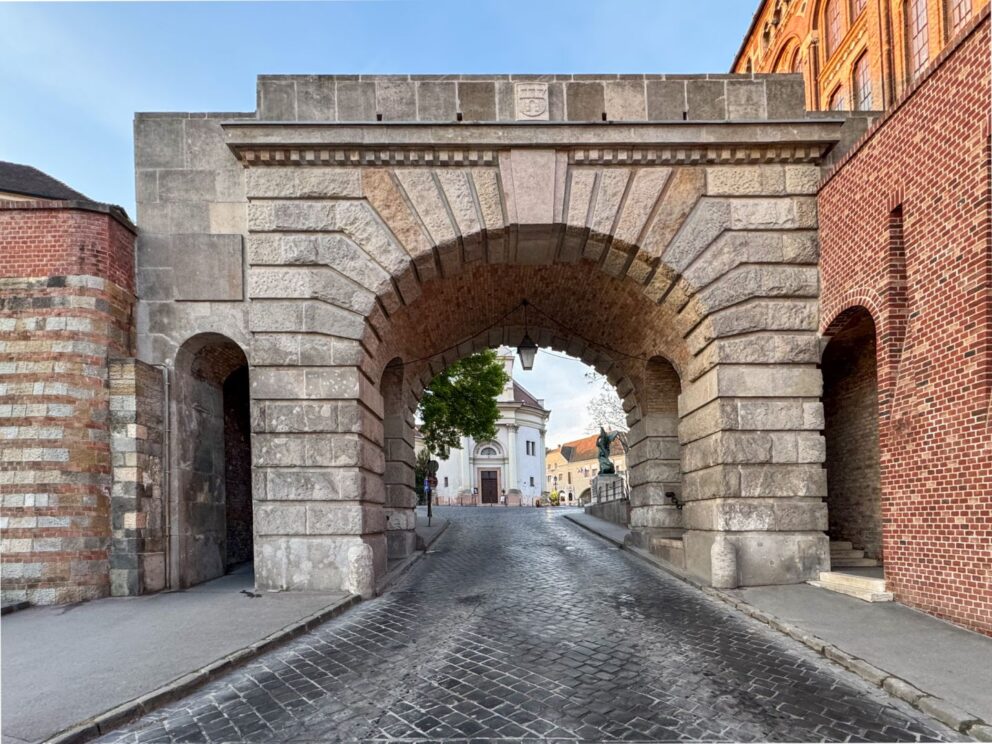
In the past, entry into the city was secured through gates located in the city walls. None of these gates have survived in their original form to this day. However, entrance to the Buda Castle District is still through gates, with the northern gate known as Vienna Gate. It received its name because it led to the road to Vienna.
In the Middle Ages, this location was where the weekly markets were held on Saturdays, hence the area was known as “Saturday Market Square,” and Vienna Gate was also referred to as “Saturday Gate.”
On the castle-side of Vienna Gate, there is a statue depicting a rushing angel, created by Béla Ohmann in 1936.
20. Europe Park at the Base of Buda Castle
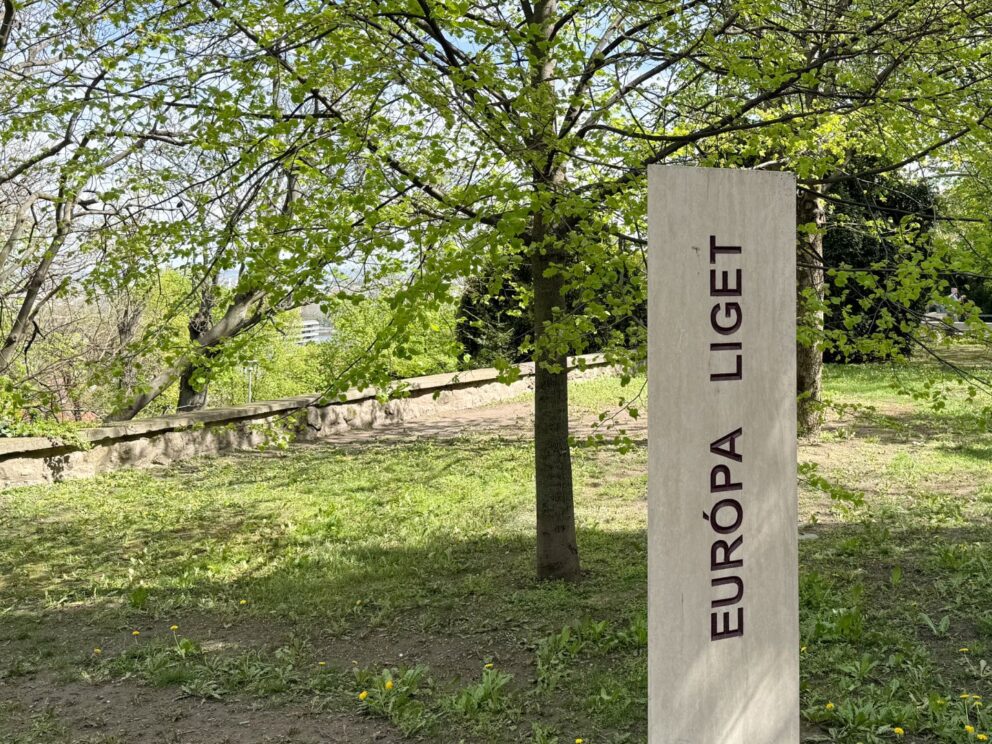
To the right of Vienna Gate lies Europe Park, a unique green space whose special trees were brought and planted by the mayors of various European cities in 1973, commemorating the centennial anniversary of Budapest’s status as a capital city. A notable feature of the park is a sculpture designed for children, which depicts beloved fairy tale characters: Mr. Bear and Miska the Fox.
21. Statue of Hedvig and Jagiello
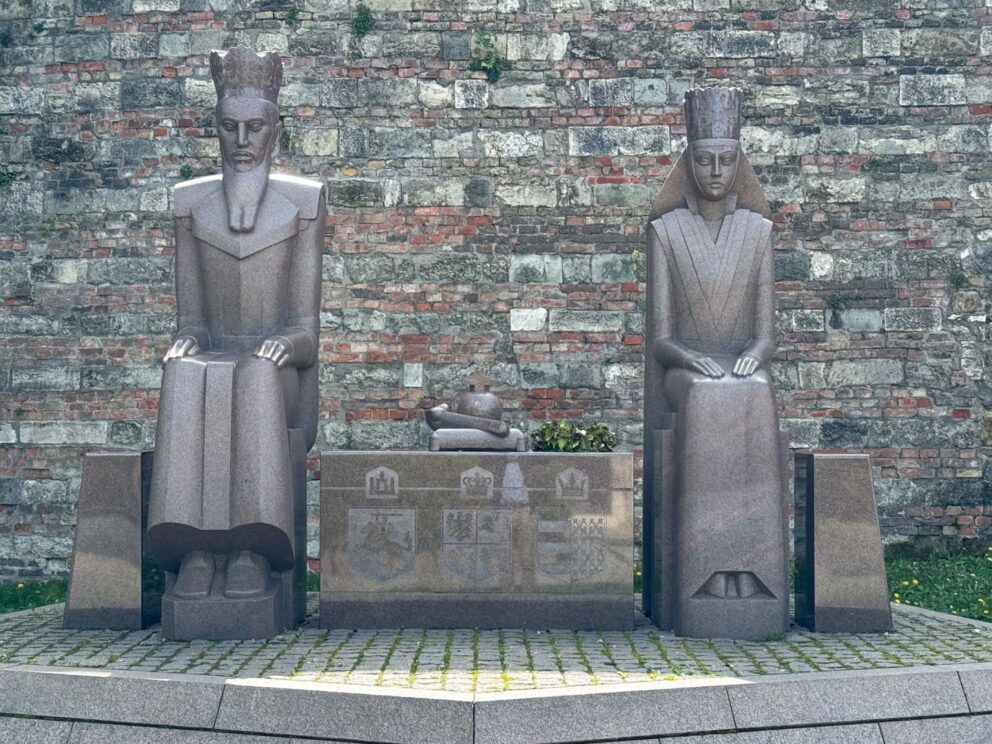
The monument located near the Vienna Gate honors the historical connections between Hungary, Lithuania, and Poland. In 1386, a significant marriage took place in Krakow: Hedvig, the Christian daughter of Louis the Great, who was both the Hungarian and Polish king, was wed to Jagiello, the ruler of Lithuania. This marriage enabled the young groom to be crowned King of Poland. Additionally, as a result of this union, Lithuania, the last pagan state in Europe, converted to Catholicism.
22. Siege of Buda Castle Relief
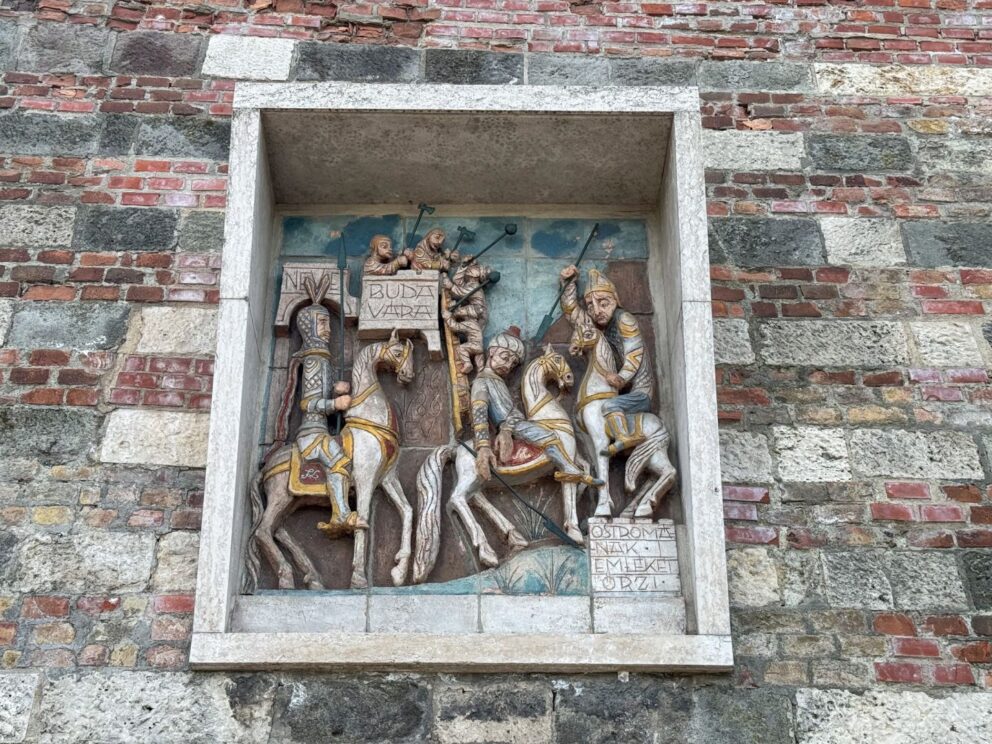
Restored in 2006, this relief commemorates the siege of Buda Castle. It is located on the wall of the Buda Castle District, near the Vienna Gate. Made from colorful, sculptural ceramics, the relief measures 138×115 cm. This artwork serves as a vivid reminder of the historical events that shaped the area, capturing a pivotal moment in the castle’s storied past.
23. Statue of Zoltán Kodály
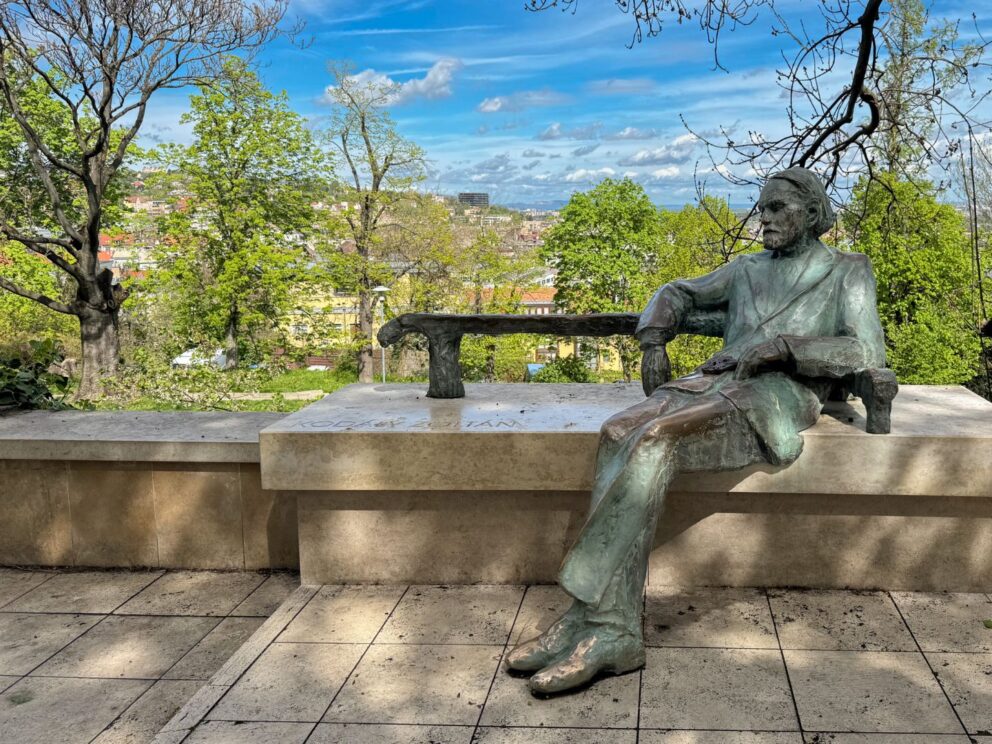
The statue of Zoltán Kodály, created by sculptor Imre Varga, was originally erected in 1982 in the Europe Park located next to Vienna Gate in the Castle District. In 2003, it was moved to the Bishop’s Garden due to renovations. It was initially planned to return the statue to the Bishop’s Garden after the renovations, but it has now been permanently relocated back to Europe Park.
Zoltán Kodály, fully named Zoltán Vilmos Kodály, was born in 1882 and is one of Hungary’s most famous composers. His contributions to music education and his profound impact on the Hungarian music scene make his statue a significant cultural landmark in the area.
24. Bear and Fox Statue
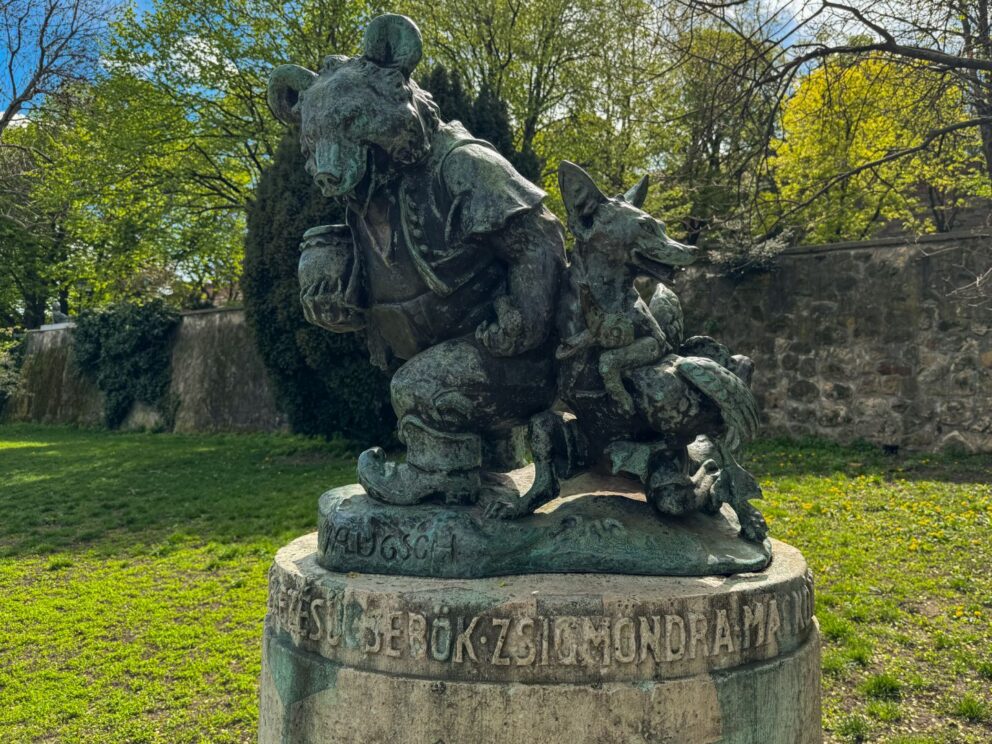
Yes, there’s a bear in Buda Castle, and he’s with Mr. Fox! This statue, designed specifically for children, features these beloved characters from a popular tale. The sculpture was erected in memory of Zsigmond Sebők, for whom Mr. Bear was a cherished storybook figure. This playful and engaging statue adds a whimsical touch to the historic surroundings of Buda Castle, delighting young visitors and offering a unique cultural nod to Hungarian children’s literature.
25. Statue of András Hadik on Horseback
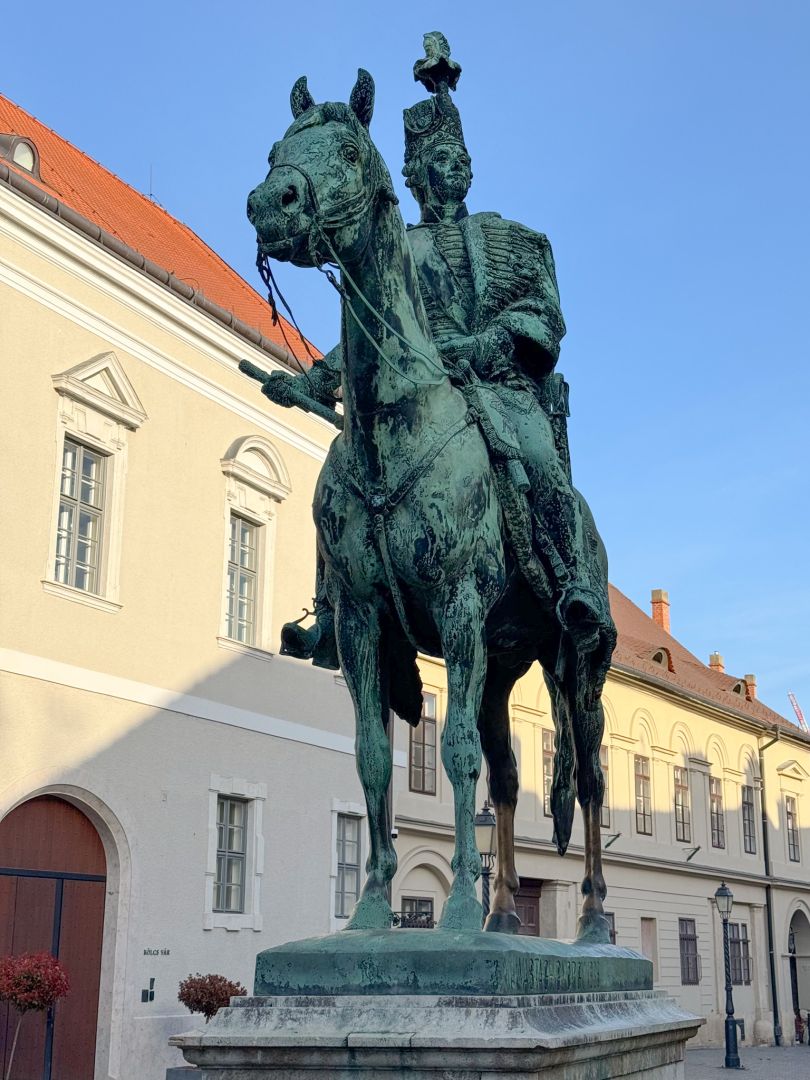
András Hadik, the dashing hussar, is depicted with his head adorned with a richly decorated hussar’s shako featuring a plume. In his right hand, he holds a marshal’s baton symbolizing power, while his shoulders are draped in a decorative mantle over an ornately braided dolman, and he wears spurs on his boots.
Encased in glass within the pedestal, there is a list of soldiers from the 3rd Hussar Regiment who have fallen since 1702, placed there by those who commissioned the statue.
The statue was unveiled on April 29, 1937, and was crafted by György Vass. A notable observation about the statue is its patina, a greenish noble rust covering the entire sculpture except for one area—the horse’s testicles. It is a tradition among engineering students at the nearby university to polish the horse’s testicles before their exams. This ritual is believed to bring them luck and good results.
Who Were the Hussars?
The term “hussar” originally referred to Hungarian light cavalry. Light cavalry units were composed of soldiers mounted on horses, equipped with minimal weaponry and protective gear. The designation of hussars dates back to the 1400s. The king required his subjects to send one mounted soldier for every 20 plots of land to serve in his army. Since other European countries did not have light cavalry within their armies, the structure of the hussar units was often established based on the Hungarian model in many countries, and they are still referred to as “hussars” in various languages to this day.
26. Statue of John of Capistrano
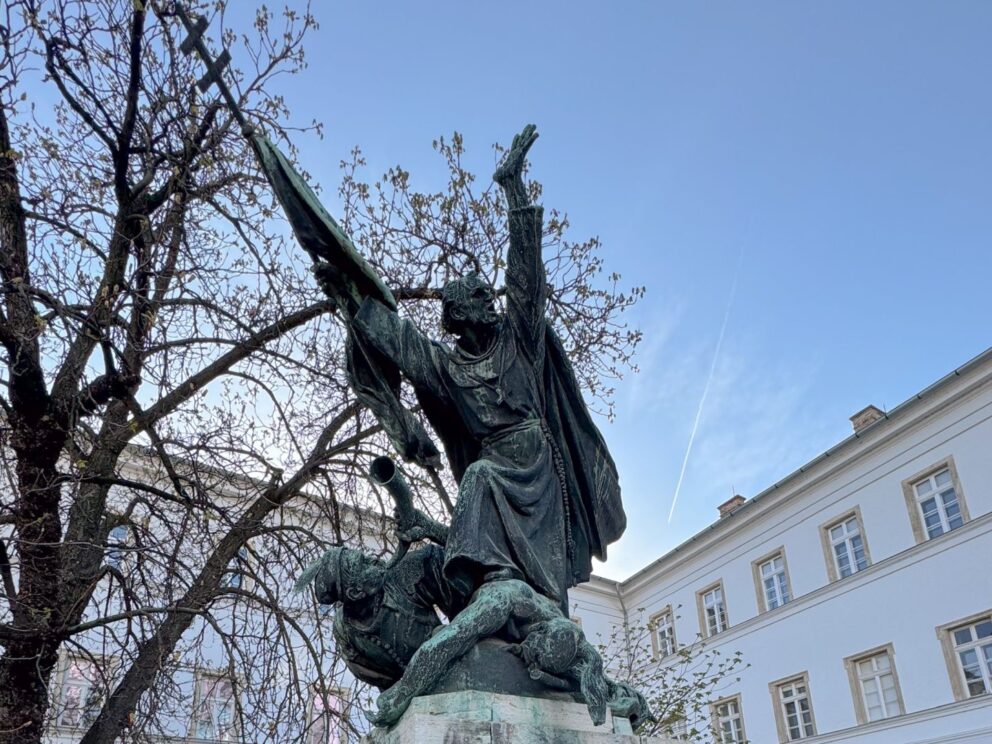
The statue of John of Capistrano, created by József Damkó in 1922, stands three meters tall with a base of 250 cm. It was erected in honor of the 465th anniversary of Capistrano’s death and the 700th anniversary of the Franciscan Order’s presence in Hungary.
The statue depicts a scene from the Battle of Székesfehérvár. It shows the hero in monastic clothing, inspiring the fighters to charge by holding the Apostolic Cross flag in his right hand. At his feet, a Hungarian bugler climbs onto a bastion, and a fallen Turk is visible, illustrating the fervor and drama of the battle.
27. National Archives of Hungary
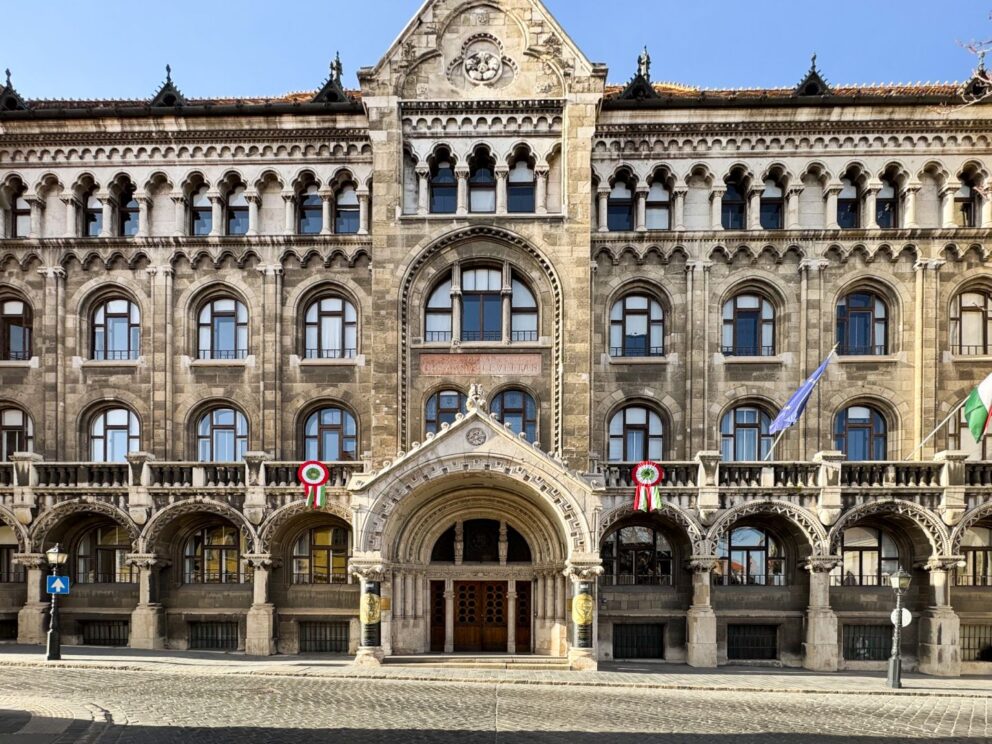
The National Archives of Hungary was designed by Samu Pecz and constructed specifically for archival purposes between 1913 and 1923. The National Archives serve as a repository for national treasures, holding the most extensive collection of fundamental charters, documents, and coats of arms created over the past thousand years of the country’s history. The oldest document preserved here dates back to 1109.
The building suffered significant damage during the siege of Budapest in the winter of 1945, receiving numerous artillery and bomb hits. As a result, a warehouse on the eastern side facing Vienna Gate was completely destroyed, parts of the western wing and the research room collapsed, and the tower was so severely damaged that it was beyond repair. The reconstruction efforts had not yet been completed when, on November 6, 1956, a tank shell struck the western wing, leading to a fire that completely destroyed one warehouse and spread to two others. Full restoration was completed by 1961. In the 1980s, the roof was re-covered with pyrogranite tiles similar to the original, produced by the Zsolnay factory in Pécs.
28. Military History Museum
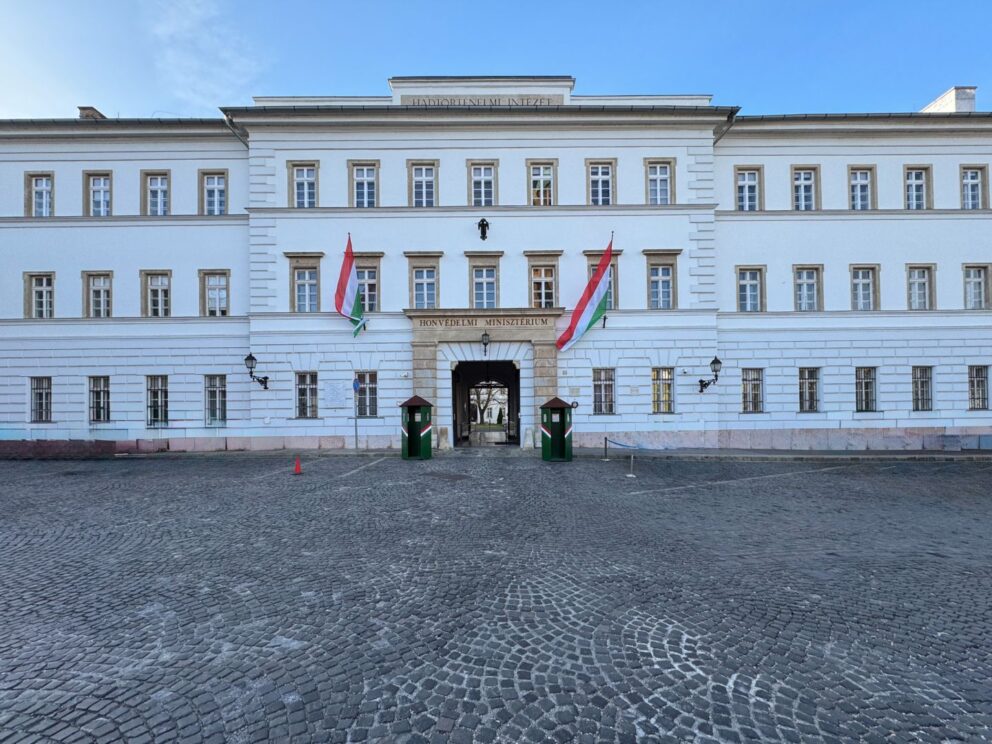
The Military History Museum has relocated to Székesfehérvár. However, the Military Historical Archives and the Military History Library remain accessible to researchers.
The museum’s collection includes over fifty thousand items. Among these are military uniforms and a collection of 28,000 coins and medals. As a result, tourists visiting the original location can only admire the magnificent building from the outside. To the left of the entrance, visitors can see cannonballs that were fired by the Hungarian army during the siege of the fortress in the spring of 1849.
29. Mary Magdalene Church
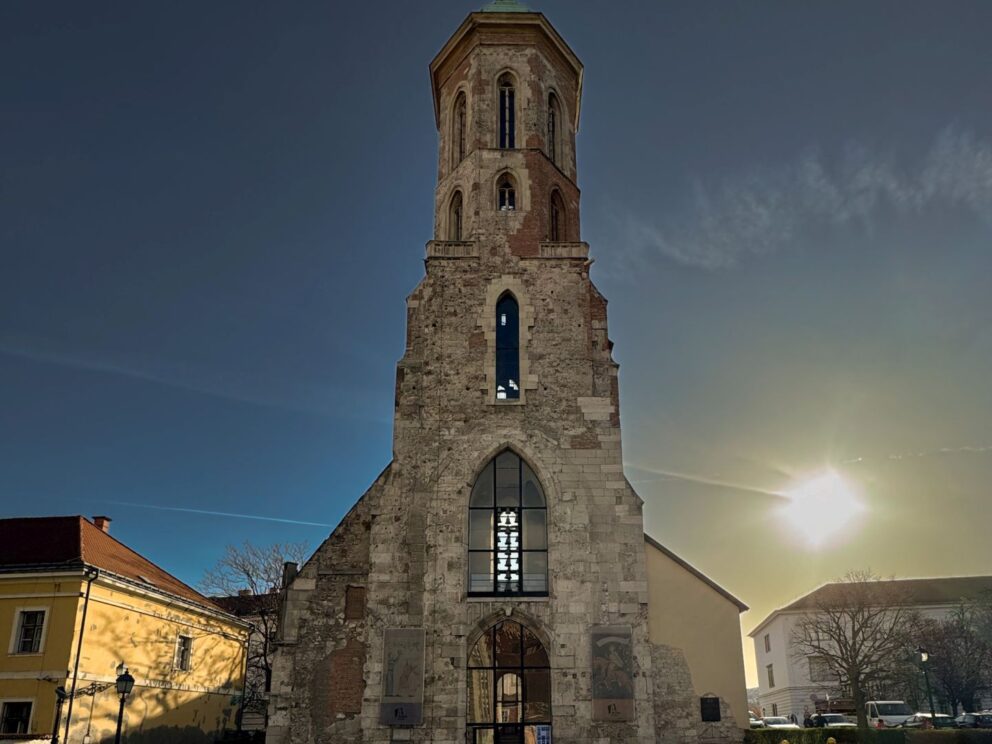
In the Buda Castle District, apart from Matthias Church, another church tower rises above the houses and the city itself. Today, this tower stands alone, as only the barely protruding remains of the former church walls remind us of the original building (except for the several stories high Gothic window that was reconstructed in the 1980s).
Mary Magdalene Church was built shortly after the Mongol invasion in the 13th century. At that time, the layout was already defined: the Royal Palace to the south, the Church of Our Lady (for German-speaking believers) in the center, and Mary Magdalene Church (for Hungarian believers) to the north.
The church was severely damaged during World War II and was subsequently demolished. Only one symbolic stone window was rebuilt. The remaining tower offers a stunning panoramic view and allows visitors to listen to the play of the country’s largest carillon, which operates with 24 bells. The smallest bell weighs 8 kg and the largest nearly 35 kg. The bronze bells are sounded by an electromagnetic striking mechanism controlled by a computer-driven custom electronics system. The carillon’s control equipment, located on the first floor of the tower, is accessible to visitors.
Currently, the carillon is not operational due to damage from a lightning strike in 2020 that affected its most sensitive and unique parts.
The noon bell ringing. In 1456, John Hunyadi’s defenders and John of Capistrano’s crusading forces achieved victory over the Sultan’s armies at the Siege of Belgrade. This decisive victory on the battlefield helped Hungary and Europe avert the threat of Turkish expansion for many decades. Since then, the noon bell reminds the Christian world of Hunyadi’s triumph.
30. Coronation Robe
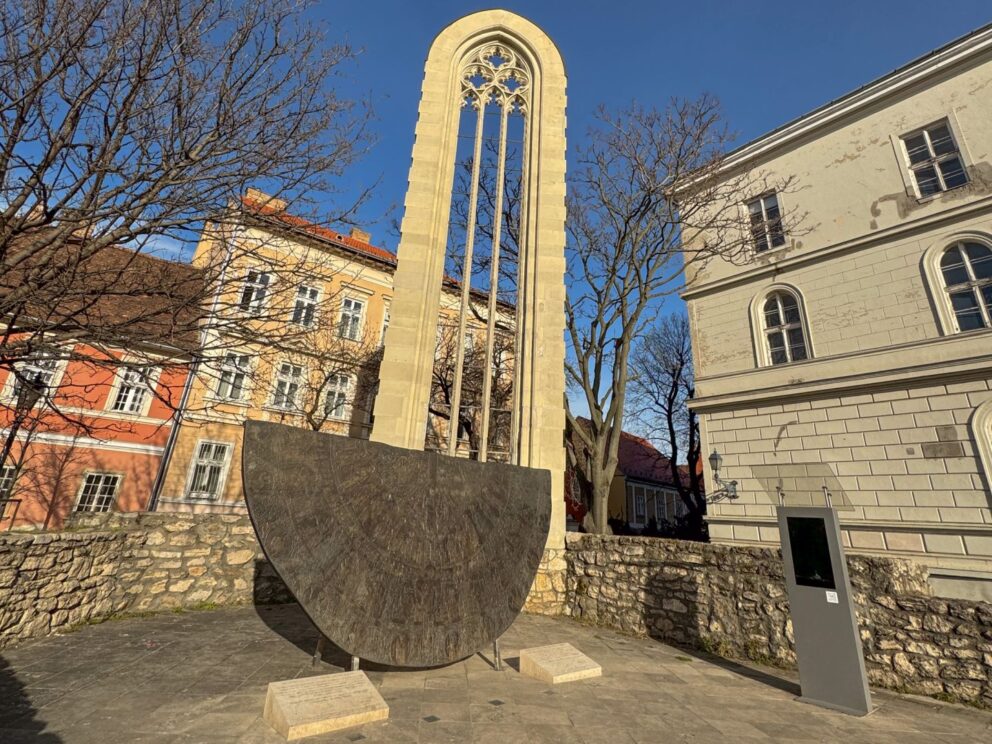
Originally a bell-shaped, closed chasuble, the coronation robe was commissioned by the first Christian King of Hungary, Saint Stephen (997–1038), and Queen Gisela. They donated it to the Church of the Virgin Mary in Székesfehérvár. Around 1200, it was modified and then used for several centuries during the coronation of Hungarian monarchs. The original can be seen at the Hungarian National Museum.
The bronze relief was created by sculptor Tibor Rieger in 2012. What makes this artwork unique is that it does not merely replicate but reinterprets and brings to life in three dimensions the originally flat representations, giving personality and face to each figure depicted on the richly adorned national relic.
31. Red Hedgehog House
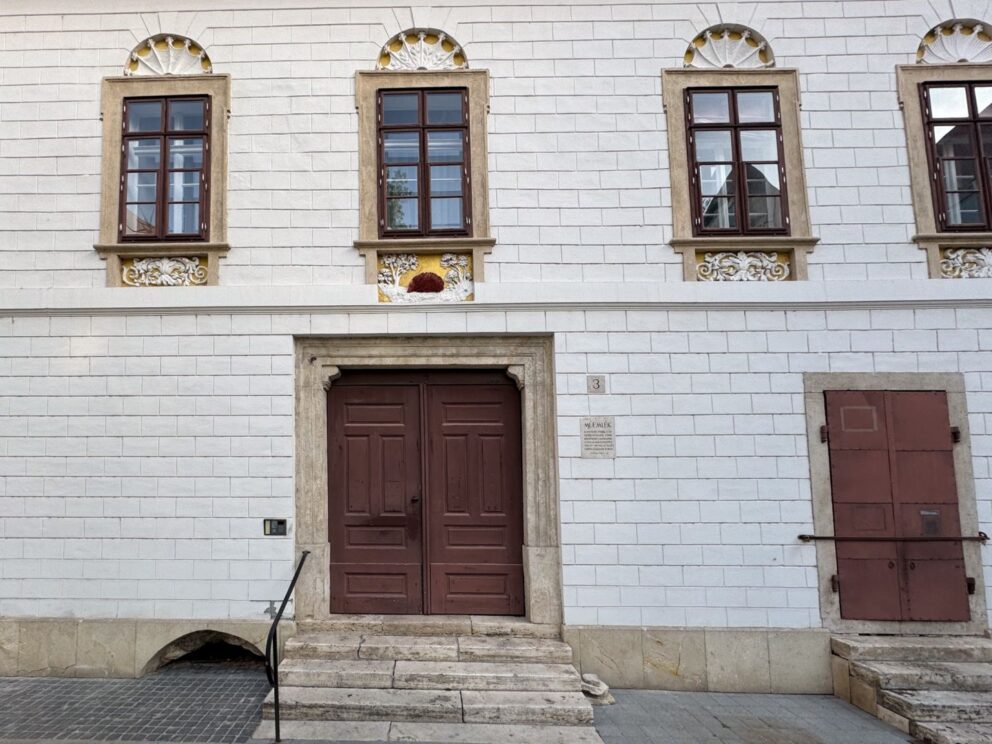
The Red Hedgehog House is Budapest’s oldest house still inhabited today. Constructed in the second half of the 1200s, it was referred to in the second half of the 1300s as the house guarding the body of Saint Paul the Hermit because it held one of his relics.
During the Ottoman period, the building suffered significant damage, and it was near this house that Buda’s last Turkish governor, Abdurrahman Abdi Arnaut Pasha, fell. After the recapture of Buda, the building was restored, and in 1696 the Red Hedgehog Inn opened on the street-facing side, becoming for a long time the only inn in the Buda Castle District.
By the end of the 1700s, the Red Hedgehog Inn was considered too small and outdated. The local authorities urged the owner to expand the building, but he was unable or unwilling to comply. Subsequently, the house served as a dental clinic.
Between the two world wars, it operated as a brothel. In 1959, it was renovated, largely maintaining its neoclassical style.
32. Statue of Pope Innocent XI
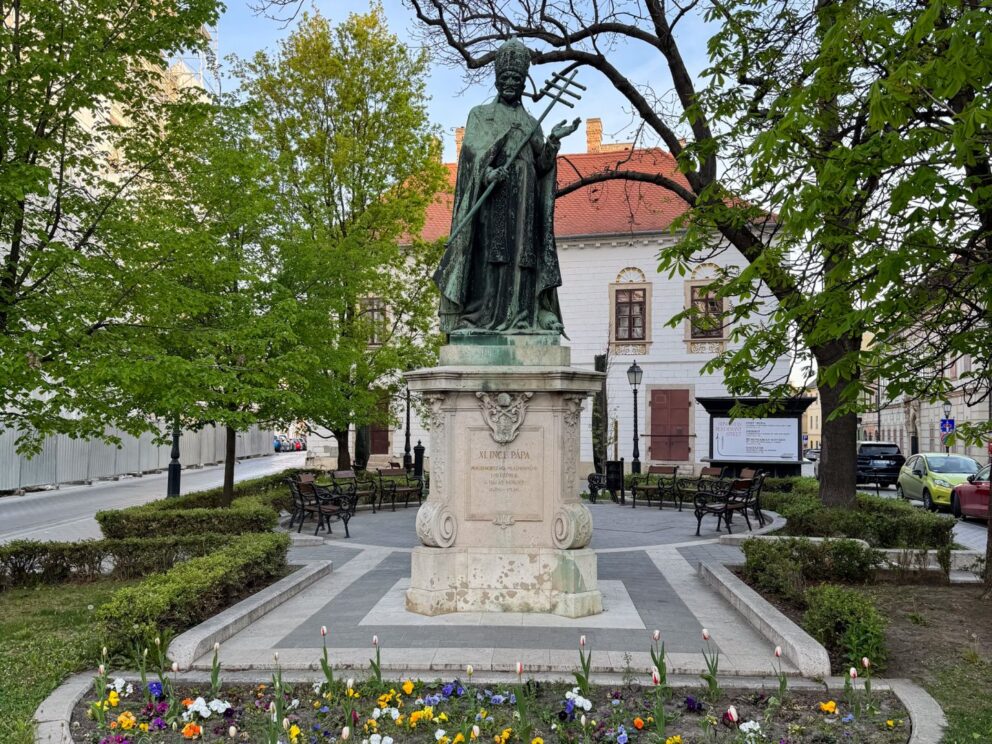
The statue depicts Pope Innocent XI, head of the Catholic Church, holding a large cross symbolizing papal authority. Pope Innocent XI played a crucial role in organizing the Holy League in 1684, which was instrumental in driving the Turks out of Europe. On the back of the statue’s pedestal are images of the leaders of the states that formed the Holy League. One side of the pedestal depicts the pope delivering the papal bull proclaiming the Crusade, while on the other side, a Hungarian hajduk is shown being the first to plant the Hungarian flag on the ramparts of Buda Castle.
The location of the statue is significant: it marks the spot where Abdurrahman Abdi Arnaut, the last Ottoman governor of Buda, was killed during the recapture of the castle.
The statue was erected on the 250th anniversary of the recapture of Buda Castle and was crafted by János Damkó in 1936.
The cross held by the pope is known as a “pallium,” which traditionally symbolizes papal authority and is often used to represent the Holy Trinity: Father, Son, and Holy Spirit.
33. Houdini House
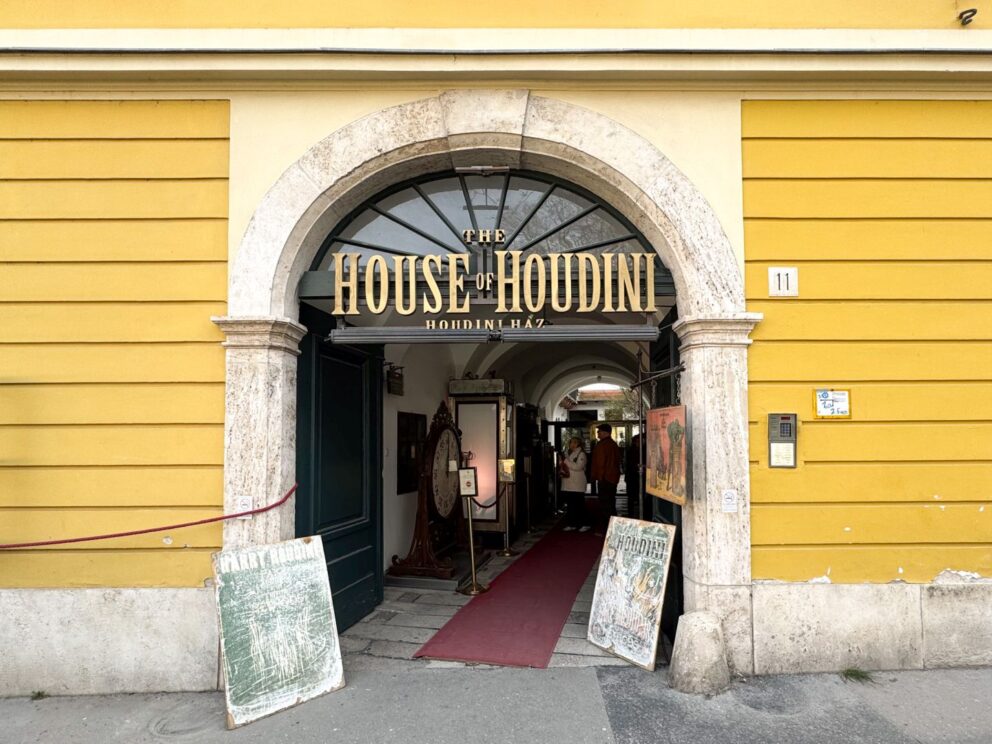
The enigmatic, mysterious, and inscrutable secrets of the escape artist Harry Houdini may never be fully uncovered. However, a visit to Houdini House can bring you a bit closer to the magician. Arrayed in front of the entrance are some of Houdini’s famous tools. This foyer is a favorite spot for tourists to take photos, with many capturing themselves attempting to escape from one of Houdini’s special contraptions. Those interested in seeing more of the magician’s array of tools will need to purchase a ticket.
Harry Houdini had Hungarian roots. He was born in Hungary and emigrated to the United States with his family at the age of four. (Although he always claimed he was born in America.)
Summary of Location name
34. Angelic Hungarian Coat of Arms
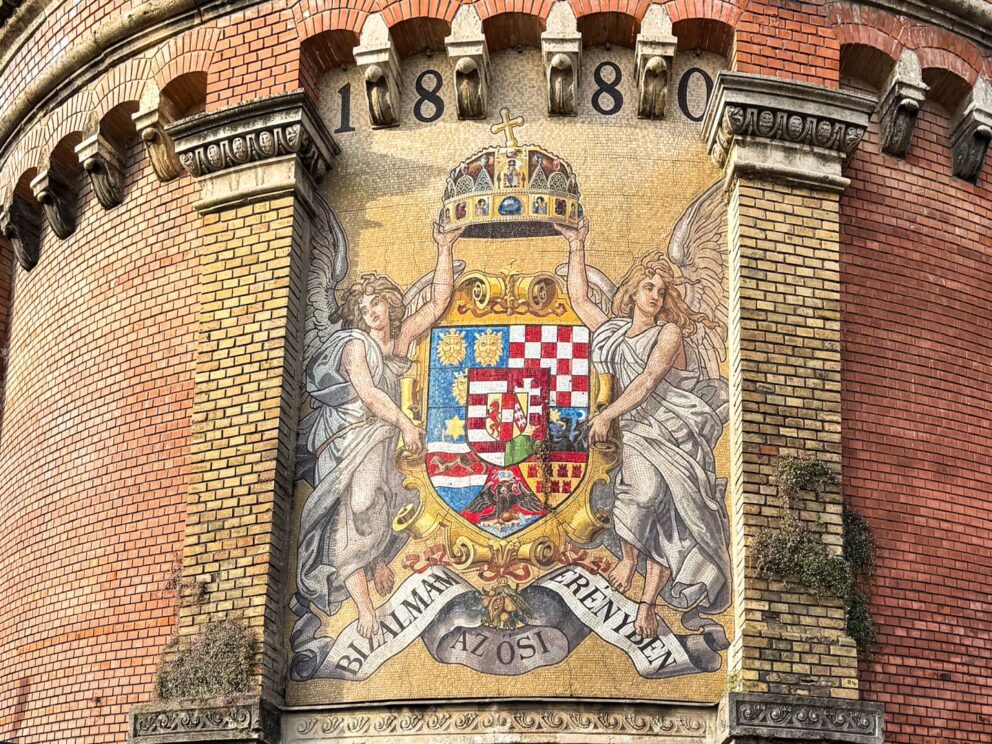
Located near the lower station of the funicular, the main ornament of the red brick wall is the angel crest, where two angels hold the Hungarian crown above the grand unified coat of arms of Hungary. This crest was the symbol of the Kingdom of Hungary during the existence of the Austro-Hungarian Monarchy from 1867 to 1918, following the Compromise of 1867.
The inscription on the crest reads “1880 and my trust in ancient virtue.” This quote was the motto of Emperor Franz Joseph I, which also appears on several contemporary coins. During the communist era (1950), the crest was walled up but has since been restored and now adorns Clark Ádám Square.
35. The 0 Km Stone
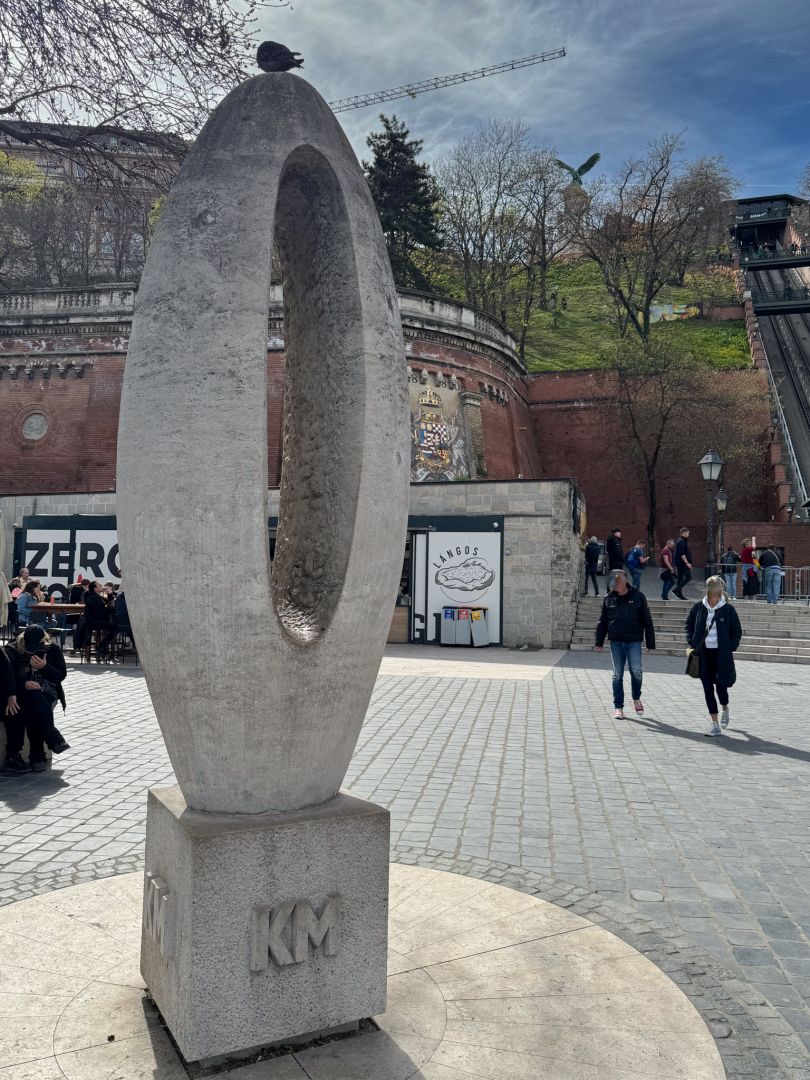
This site features an oval-shaped numeral “0,” reminding us that nearly every single-digit main road in the country starts from this point, except for the number 8 main road, which begins near Székesfehérvár. This stone serves as a central reference point from which distances to other parts of Hungary are measured.
36. Riding Hall
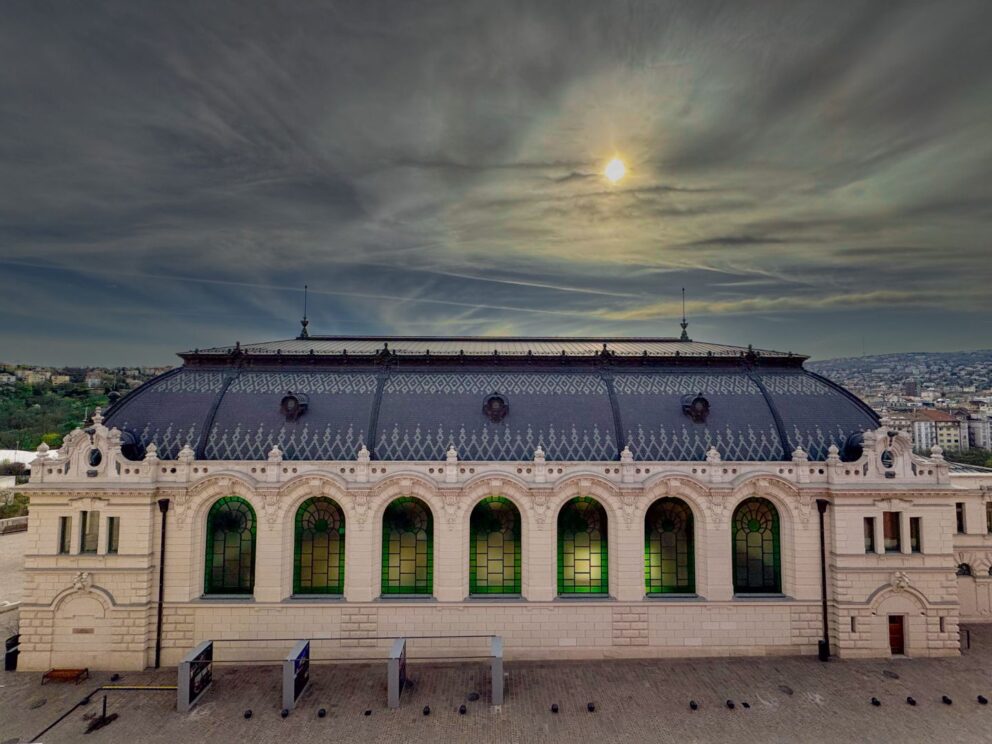
Constructed in 1901, the riding hall suffered only minor damage during World War II. Despite this, it was demolished under communist rule. It was rebuilt according to the original turn-of-the-century plans and completed in 2022.
The riding hall functions not only as a venue for equestrian activities but also as one of Budapest’s most modern and elegant event centers.
One of the most decorative features of the riding hall is its large stained glass windows, which are the work of Miksa Róth.
37. Karakas Pasha Tower
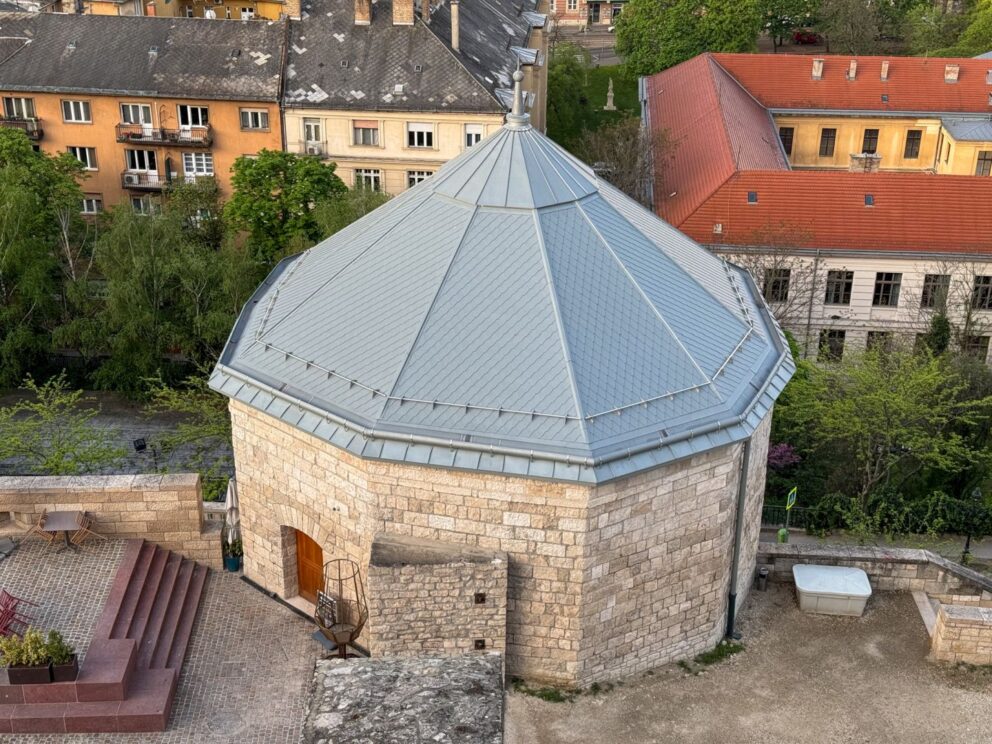
Karakas Mehmed Pasha, the governor of Buda, built this tower around 1620. It was restored after World War II during a series of renovations. Next to the tower, a small green area has been developed as a resting place. The tower itself houses facilities including restrooms, a café, and a souvenir shop.
38. Bronze Gate of the Guardhouse
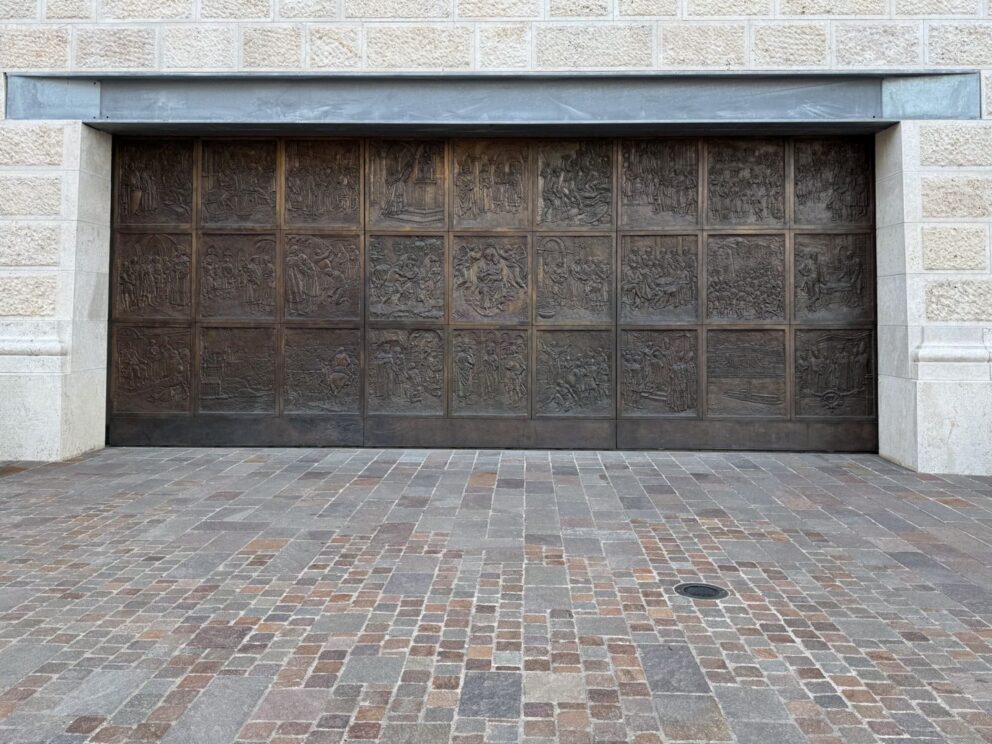
This imposing bronze gate, which measures 7 meters in width and 3.2 meters in height, adorns the Guardhouse building. The gate leads to an underground archaeological space where remnants of the medieval Sigismund Palace, destroyed in the explosion of 1686, can be viewed.
Created by sculptor Ferenc Farkas, the gate features a total of 27 reliefs arranged in three rows. These reliefs depict various events related to the history of Buda Castle, offering a visual narrative of the castle’s rich past.
39. Stöckl Steps
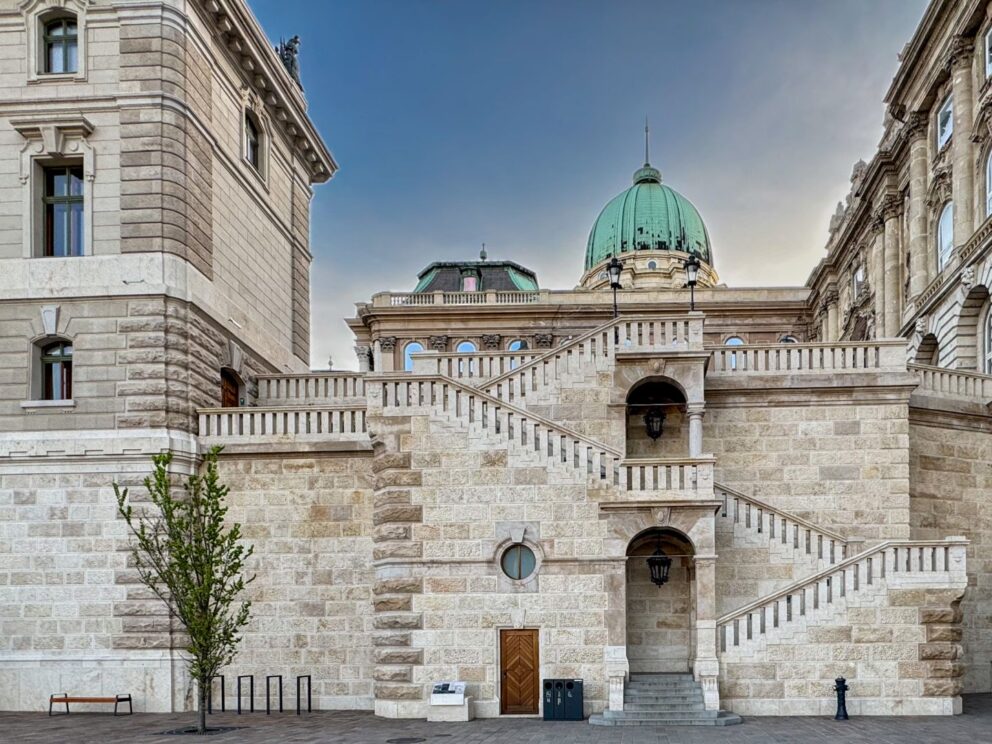
The Stöckl Steps begin at Csikós Court and lead up to the level of the castle, guiding visitors to the Lion’s Court. A unique feature of these steps is that they are integrated with the adjacent Guardhouse building, resulting in entrances to the Guardhouse both at the bottom and the top of the steps.
The steps are covered with ashlar stones and are adorned with Renaissance-style balustrades, which highlight their construction during the era of Neo-styles. In 1971, the Stöckl Steps, along with the Guardhouse, were demolished but were later reconstructed together with the Guardhouse.
40. Guardhouse Building
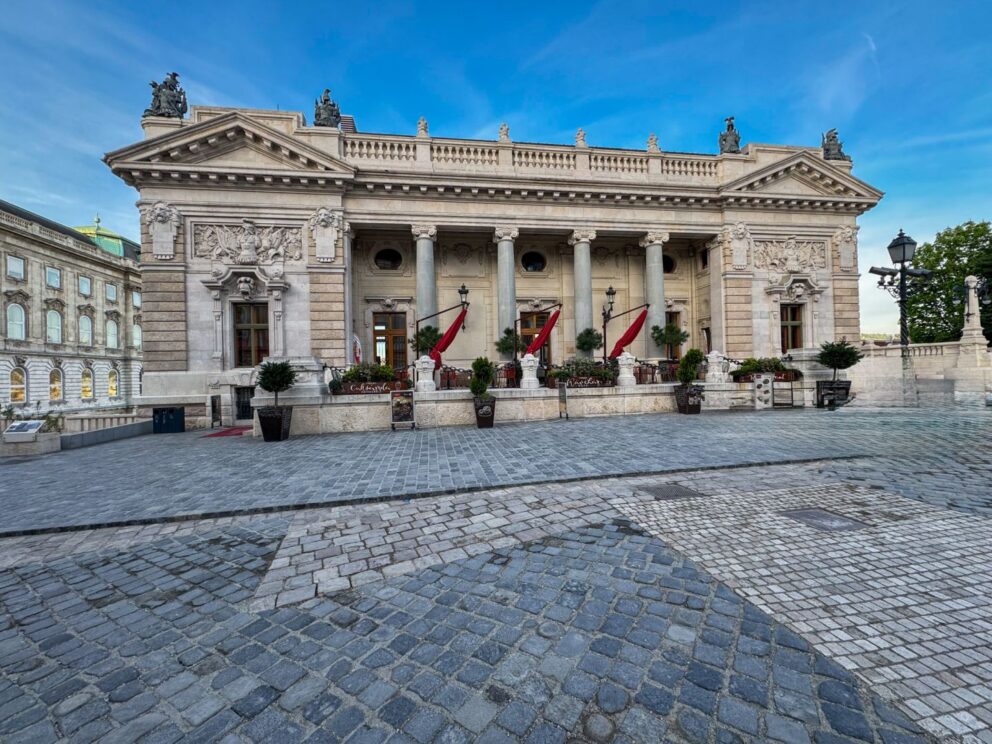
Originally, in the 1800s, the castle superintendent’s two-story house stood here. By the early 1900s, it had been repurposed to accommodate the Hungarian Royal Guard. The building was reconstructed in 2020, and a distinctive feature of the architecture is the Roman statues on the roof.
On the ground floor of the building operates the Royal Guard Café, while the second floor houses an exhibition dedicated to the Hungarian Royal and Noble Guard. The exhibition showcases the history of the guard starting from its foundation in 1760, featuring uniforms, helmets, and weapons from the collection, highlighting the rich military heritage of Hungary.
41. Roman Statues on the Roof of the Guardhouse
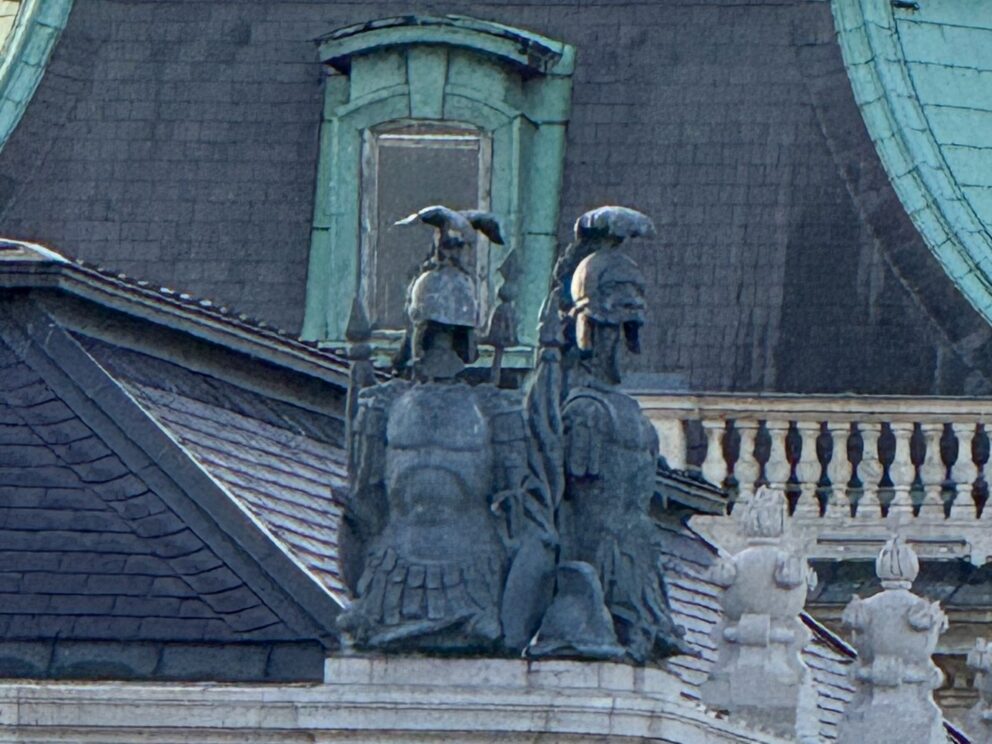
The statues located on the roof of the Guardhouse are the works of Péter Bukovszki. There are a total of 12 statues, essentially consisting of four different variations. These statues evoke a tradition from the Roman Empire, where after a conquest, trophies or victory memorials were constructed from the captured weapons and armor. The statues depict figures without bodies, symbolizing the remnants of vanquished foes.
The birds seen on the helmets represent strength and power, adding a symbolic layer to the historical reference of the statues, connecting the past victories of the Roman Empire with the architectural grandeur of the Guardhouse.
42. Statue of the Old Hussar
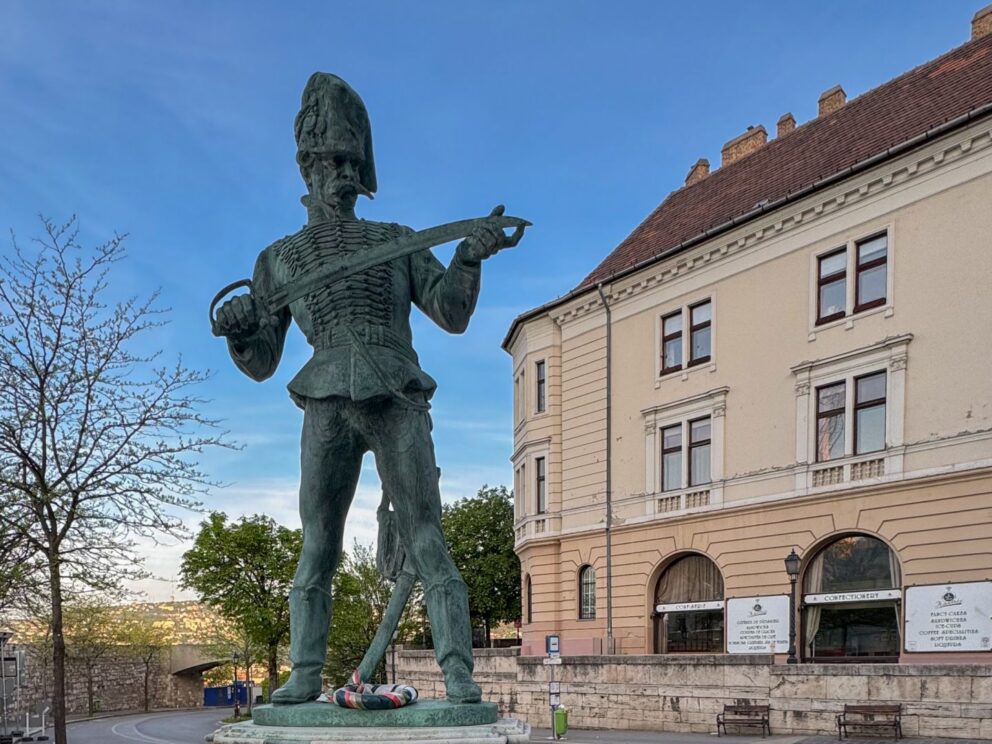
This bronze statue, standing 230 centimeters tall, portrays an elderly hussar dressed in the uniform from the era of Maria Theresa, intently examining his sword. The statue was created to commemorate the 300th anniversary of the formation of the world’s first regular hussar regiment. This piece not only celebrates the rich military heritage of the hussars but also pays tribute to their enduring legacy in military history.
43. Horse-Herdsman Statue
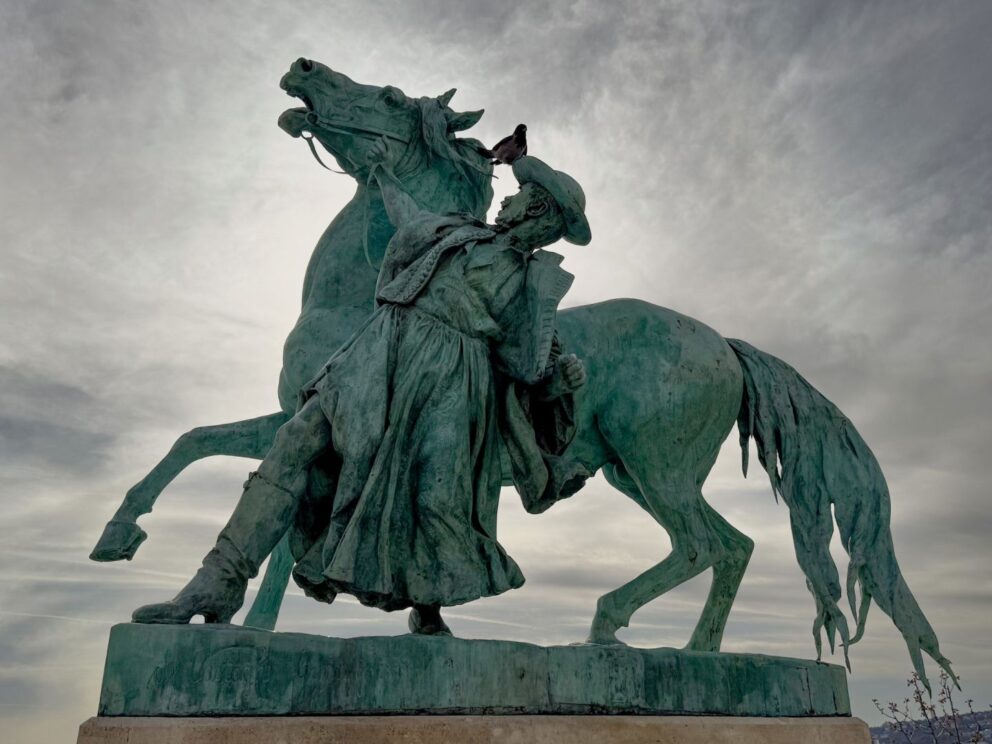
This statue is unique because unlike most public statues that are made from bronze castings, the Horse-Herdsman statue is crafted from embossed bronze elements. This technique requires significantly more work and attention from the sculptor. Initially modeled in clay, the artwork was then shaped from 0.8 mm thick sheets, embossed and hammered out, and the small pieces were riveted together.
Interestingly, the sculptor designed a maintenance hatch on the horse’s back just large enough for a small child to fit through. It is presumed that someone crawled inside the horse to work from within while another person assembled the parts from the outside. This method, while intricate, is not ideal for the statue’s longevity because water can seep into the sculpture through the seams during rain, sometimes remaining inside for days.
An intriguing detail is that in the 1970s, the statue was missing its scrotum, which was restored during a 2019 renovation.
Beyond the technical brilliance, the value of the Csikós statue is further enhanced by the dynamic harmony between the horse and its herdsman. Regardless of the viewing angle, neither the horse nor the rider obscures the other. The horse stands at a height of 380 cm.
The sculptor, György Vastagh Jr., won a gold medal for this statue at the 1900 Paris World Exhibition, highlighting its exceptional craftsmanship and artistic merit.
44. Honvéd Statue
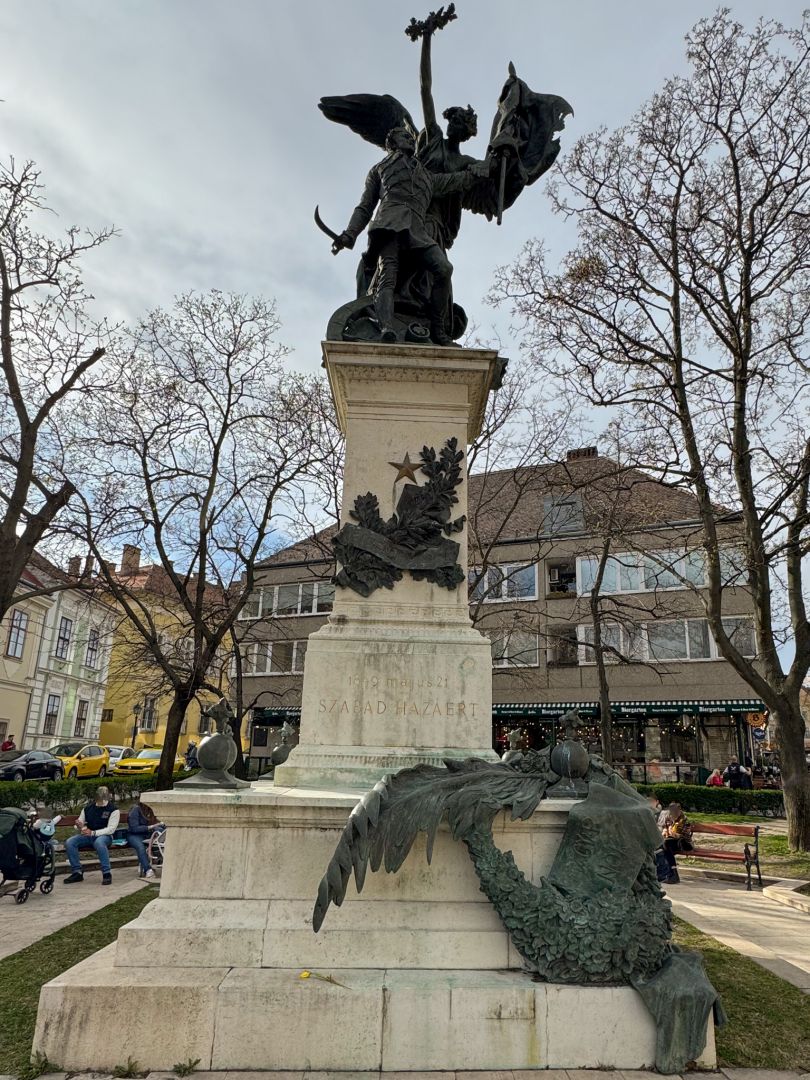
The Honvéd Statue commemorates the Hungarian National Defence Force that captured Buda during the 1848-49 War of Independence. Crafted by the sculptor György Zala in 1893, the statue depicts a honvéd holding a sword in his right hand and a national flag raised high in his left.
The flag is adorned with an image of the Virgin Mary, who is considered the patron saint of Hungary, holding the infant Jesus. The banner on the flag reads “Freedom or Death.” At each corner of the pedestal, one can see a cast iron cannonball. The date inscribed on the statue’s base is May 21, 1849, marking the day when the Hungarian forces recaptured Buda from the imperial troops during the War of Independence. May 21 is also celebrated as Defence Day, a time to remember the heroes who defended our country.
45. Statue of István Bethlen
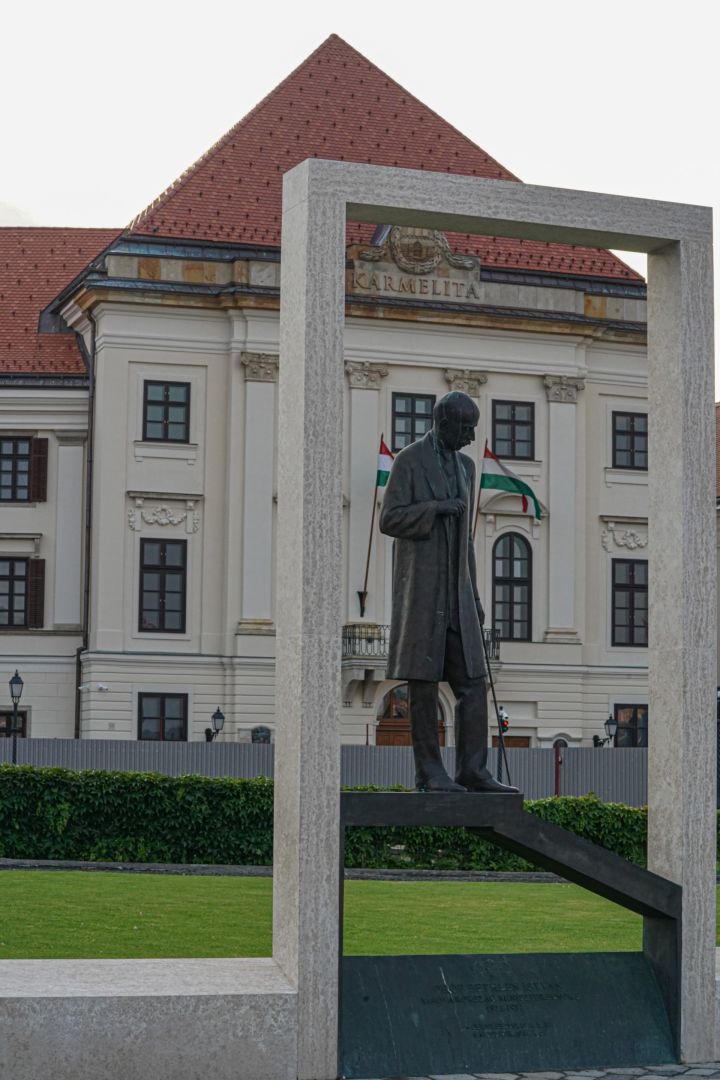
The statue of Prime Minister István Bethlen, created by Géza Stremeny in 2013, commemorates his significant contributions to Hungary. After World War I, Bethlen played a crucial role in stabilizing and revitalizing Hungary economically and culturally, helping to steer the country towards recovery during challenging times.
46. Saint George the Dragon Slayer
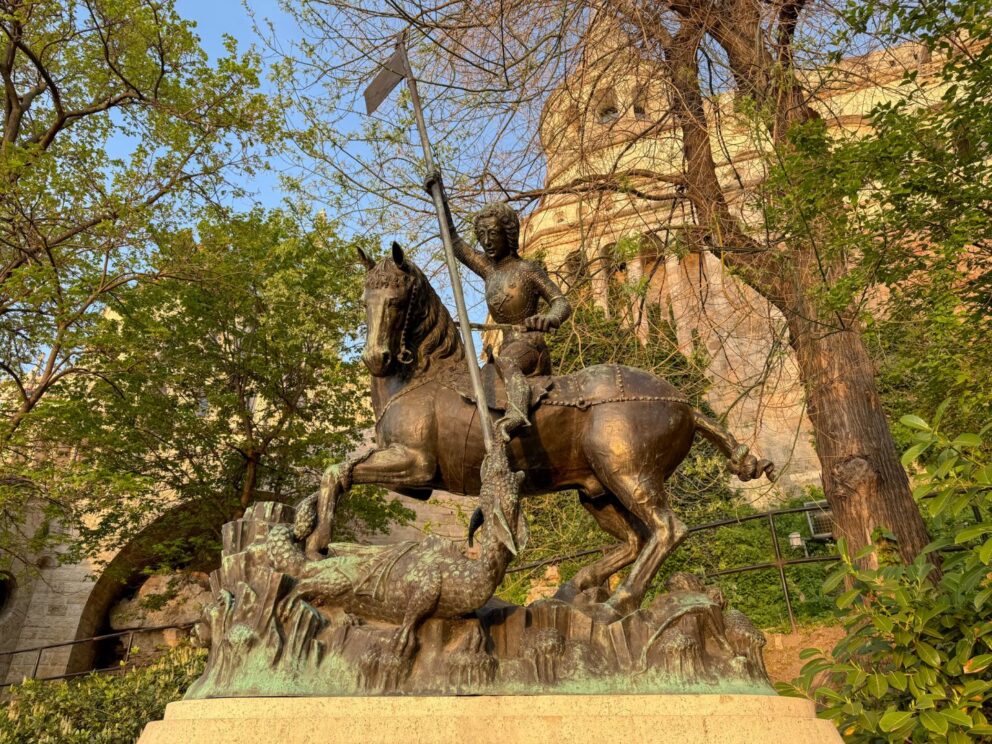
The statue depicts Saint George, a martyr who, according to legend, slayed a dragon. Typically represented as a gallant young man in armor, mounted on a horse, he is shown thrusting his spear into the monstrous beast. The legend of Saint George symbolizes the Christian belief in overcoming evil in all its forms and ending the dominion of demons.
Saint George is revered as a patron saint by several countries and cities, embodying the virtues of courage and protection against evil.
47. Statue of György Dózsa
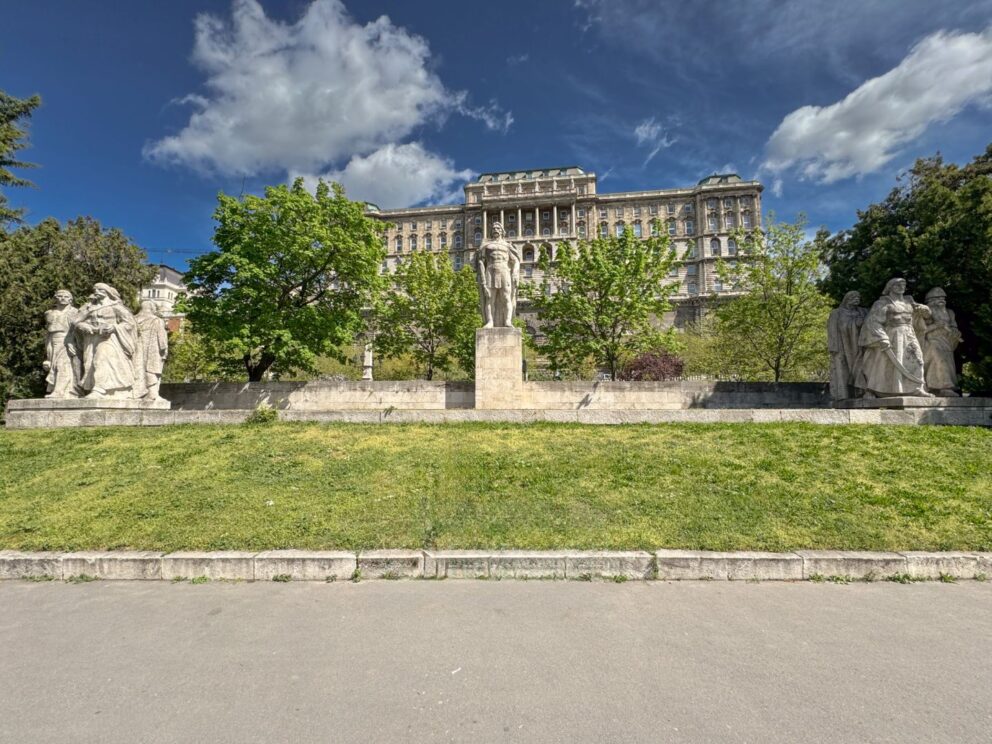
The György Dózsa sculpture group, created by István Kiss in 1961, is composed of three parts made from limestone. The central figure of the composition is the peasant leader György Dózsa. To his right and left, the sculptor depicted his loyal soldiers and fellow campaigners. The statue of Dózsa György stands nearly 5 meters tall, while the figures flanking him are each 4 meters high. This monumental sculpture honors the leader of the early 16th-century peasant rebellion in Hungary.
48. Statues of Six Women at the Royal Palace
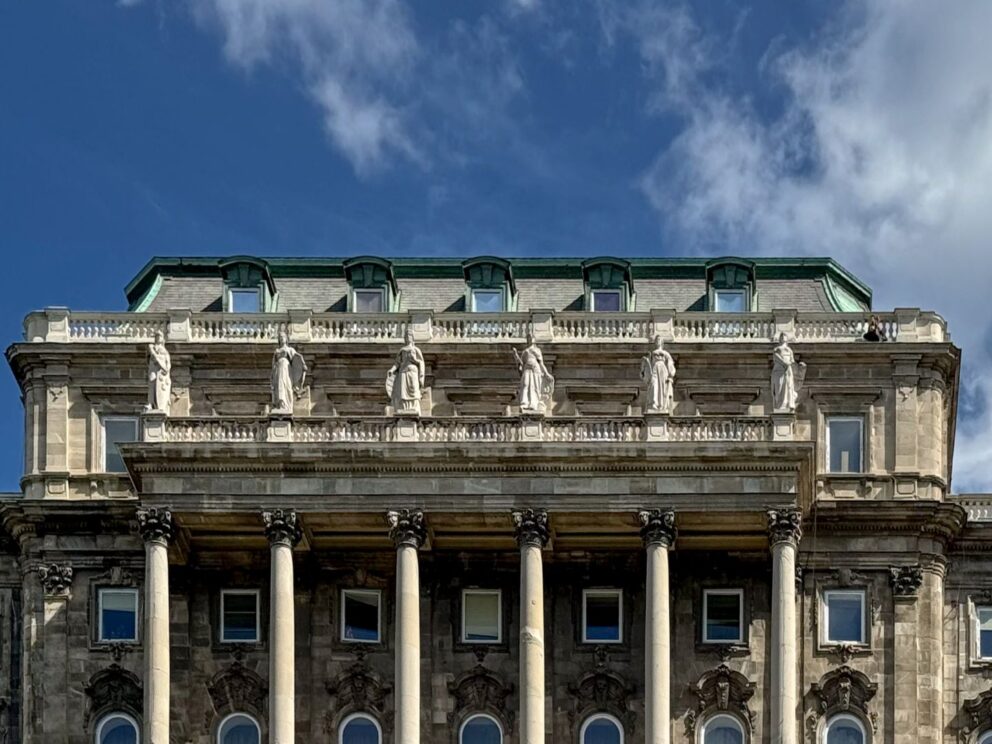
The statues represent several countries (provinces) of the monarchy: Hungary, Transylvania, Croatia, Slavonia, Dalmatia, and Fiume. Each statue holds a shield, onto which the coat of arms of each respective country is carved. These statues symbolize the unity and diversity of the territories under the monarchy, beautifully encapsulating their historical and cultural significance.
49. Statue of the Nun Flying Over the Wall
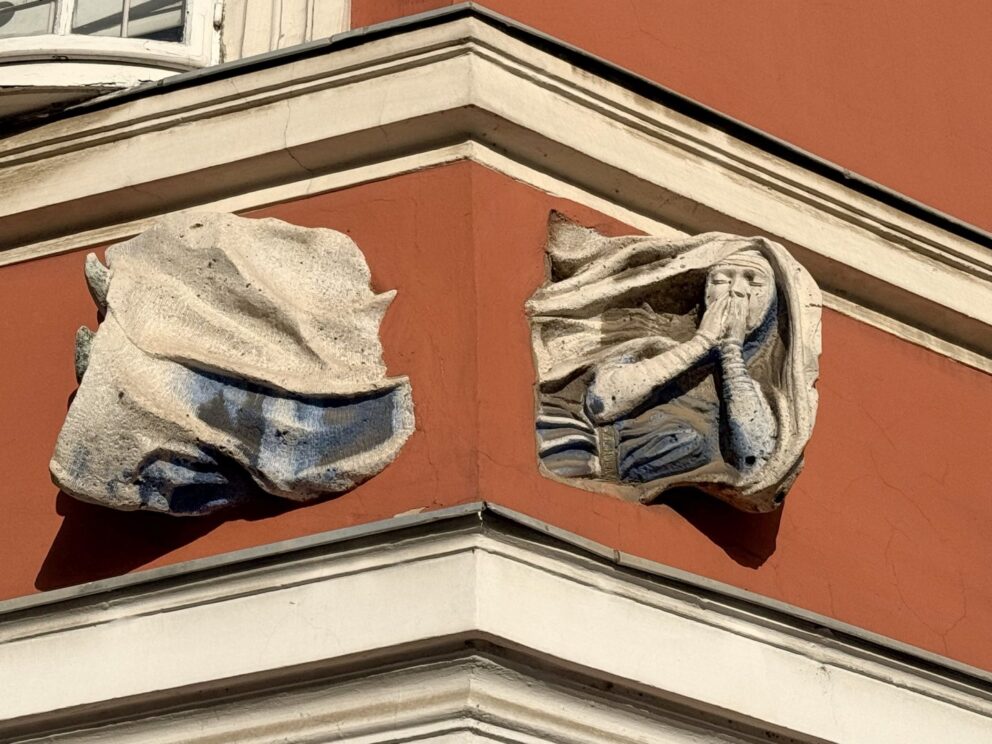
On the corner of Országház Street and Nándor Street, there is indeed a statue depicting a Clarissan nun flying over a wall. This relief is a painted stone sculpture created by Miklós Melocco in 1977. It is a fantastic and unique work of art, capturing a moment of mystical and symbolic significance with great artistic flair.
50. Mansfeld Péter “Falling Star” Statue
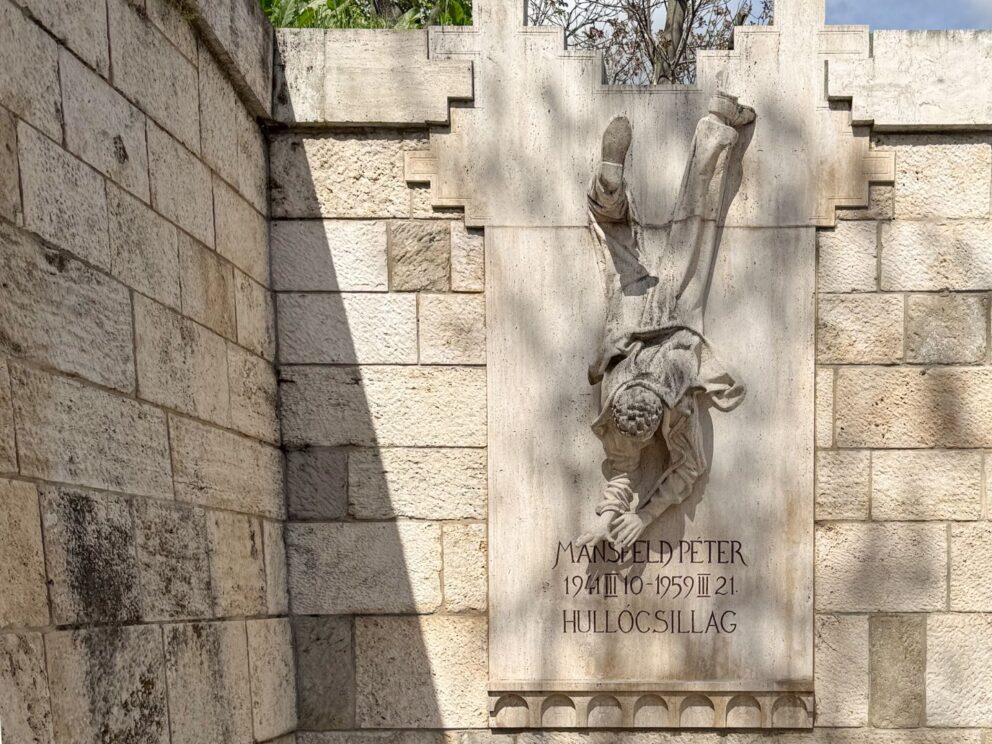
In October 1956, despite his young age, Mansfeld Péter joined the legendary resistance group at Széna Square led by “Uncle Szabó” (1897-1957), where he served as a driver for the insurgents. Mansfeld Péter (March 10, 1941 – March 21, 1959) is remembered as the youngest victim of the revolution. He was wrongfully convicted as a “common criminal” in a sham trial. Although initially sent away due to his age, he later became Uncle Szabó’s liaison driver. Peter did not commit any acts that would justify a death sentence; he did not fight with weapons during the revolution.
During his trial, it was stated, “In political terms, there are no younger or older defendants. They must be dealt with the utmost Draconian severity when sentencing.” Just days after his 18th birthday, on March 21, 1959, symbolically on the 40th anniversary of the Hungarian Soviet Republic, Mansfeld was executed. He was hanged at 9:22 AM in a building next to the Collection Prison.
It is noteworthy to mention the artist, Miklós Melocco, whose father, János Melocco (1909-1951), a journalist, was similarly executed by the merciless communist regime in a show trial by the Budapest Military Court under charges of disloyalty, akin to Mansfeld’s fate.
The statue is located on the wall of the Buda Castle Quarter, at 2 Szabó Ilonka Street.
51. Ancestral Fountain – Zsolnay Decorative Fountain
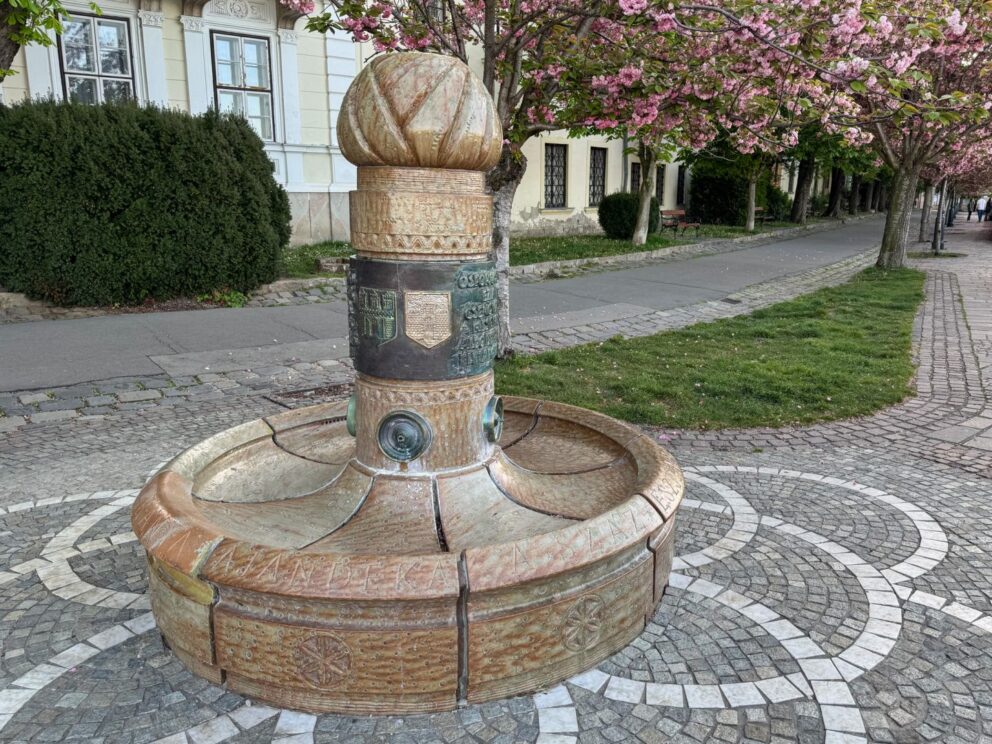
The Ancestral Fountain, a discus fountain, was created to commemorate the centennial of the unification of Buda, Pest, and Óbuda. It is crafted from Zsolnay ceramic and was a gift from the city of Pécs. Its design is said to have been inspired by the headstones of Turkish cemeteries, reflecting a unique blend of cultural history and artistic craftsmanship.
52. Turkish Cemetery, Memorial Site
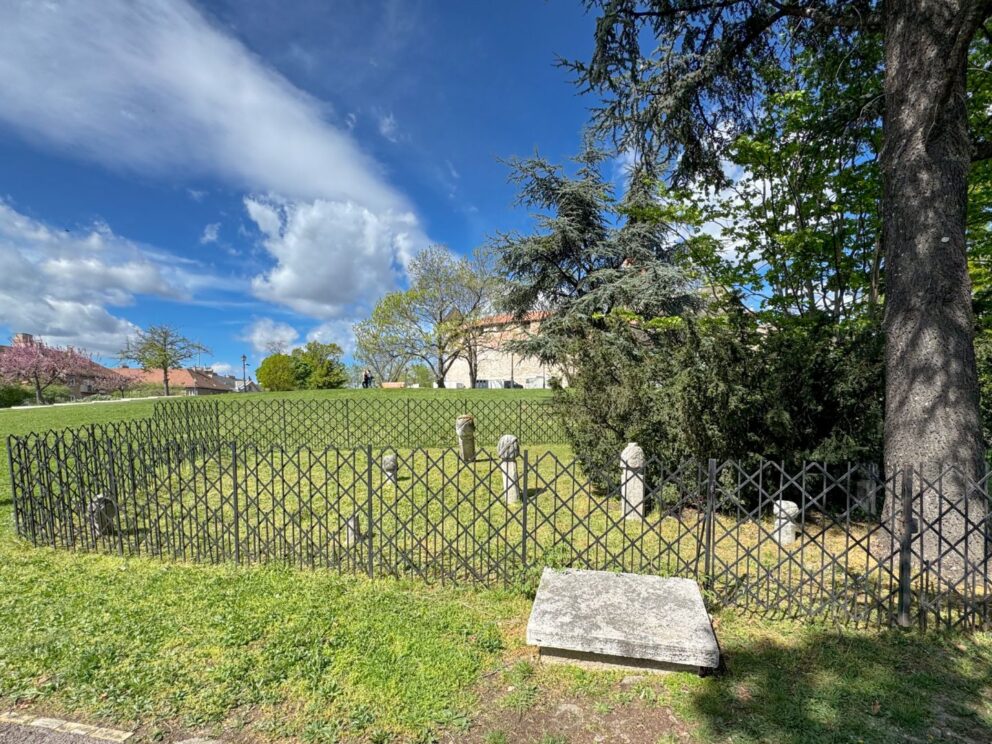
At the base of the large rondella, there are turban-topped tombstones from the Turkish era, although they have been gathered here from various locations only since the mid-1960s. Some of the tombstones placed here were discovered during excavations in the surrounding areas or were extracted from the walls of some of the old castle buildings. Uniquely Eastern plants have been planted next to the graves. Previously, there were about 20 tombstones at this site; today, those that remain are protected by a fence, preserving this piece of historical heritage within the area.
53. Statue of János Hunyadi
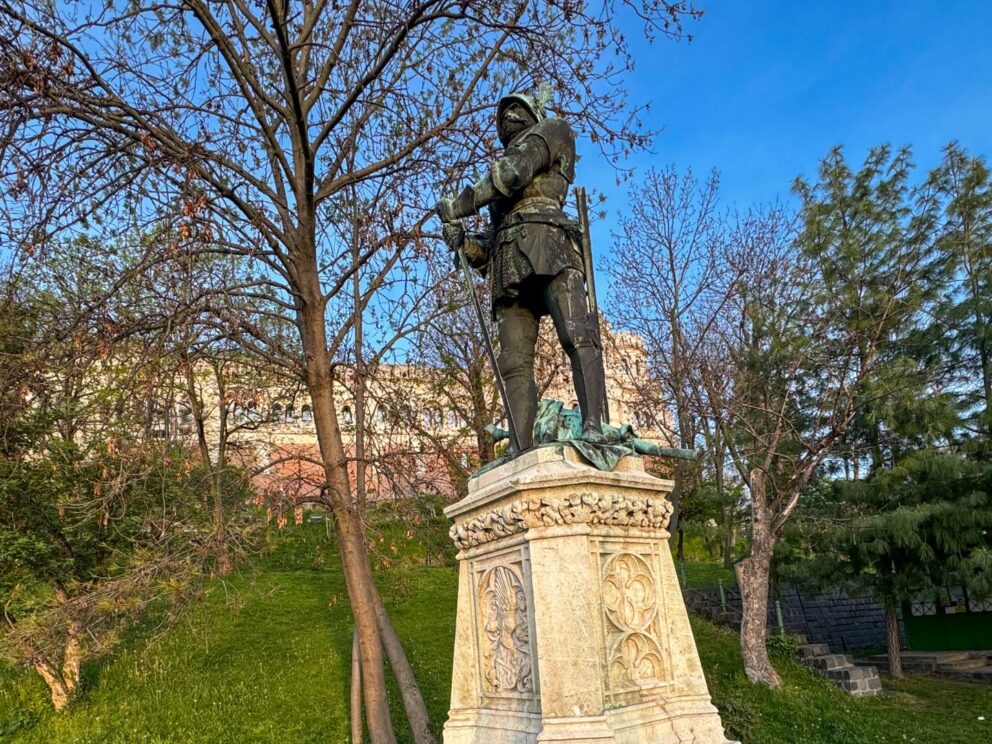
Unveiled in 1903, this sculpture by István Tóth commemorates János Hunyadi, known as the “Scourge of the Turks,” who triumphed over the Turks in the 1456 Siege of Nándorfehérvár (now Belgrade). At the base of the statue lie Turkish flags, symbolizing the defeated Turkish forces.
János Hunyadi was a former Regent of Hungary and is considered one of the greatest heroes of Christianity for his pivotal role in defending Europe from the Ottoman Empire. His legacy as a brilliant military leader and a defender of the Christian faith is captured in this monumental tribute.
54. Gazimestan
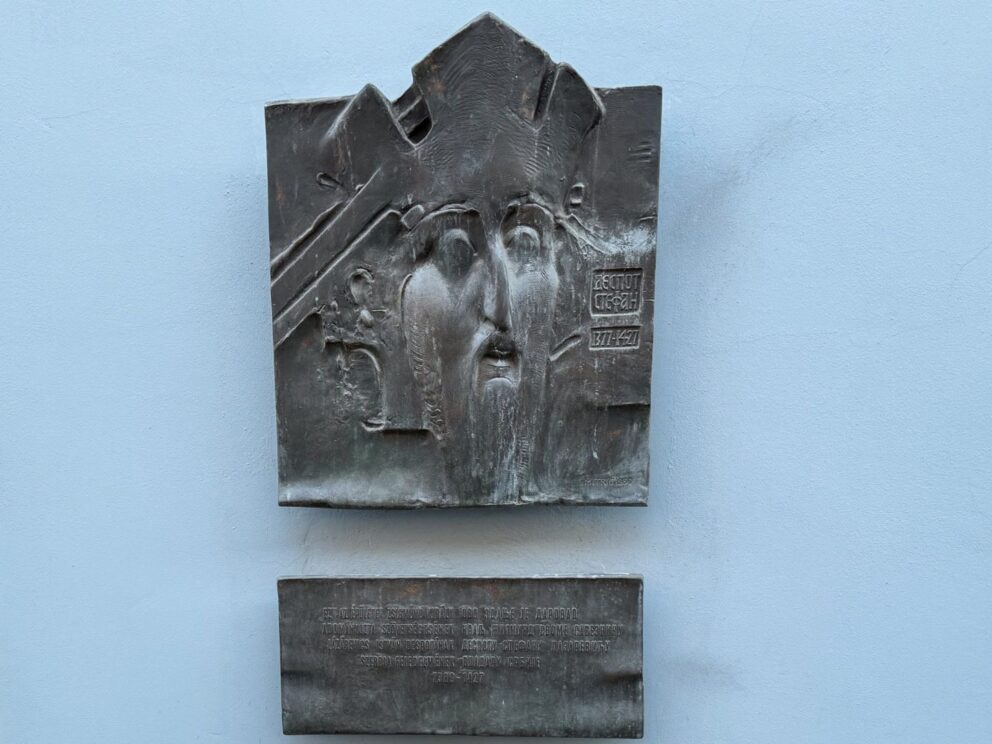
This is a memorial plaque dedicated to Prince Lazar of Serbia, known in Serbian as “Car Lazar,” commemorating the site of the Battle of Kosovo in 1389, where he famously led Serbian forces. This site, Gazimestan, is significant in Serbian history and culture, marking the struggle against the Ottoman Turks. The plaque honors the sacrifice of Prince Lazar, who died in battle, defending his country.
55. Statue of Márton Lendvay
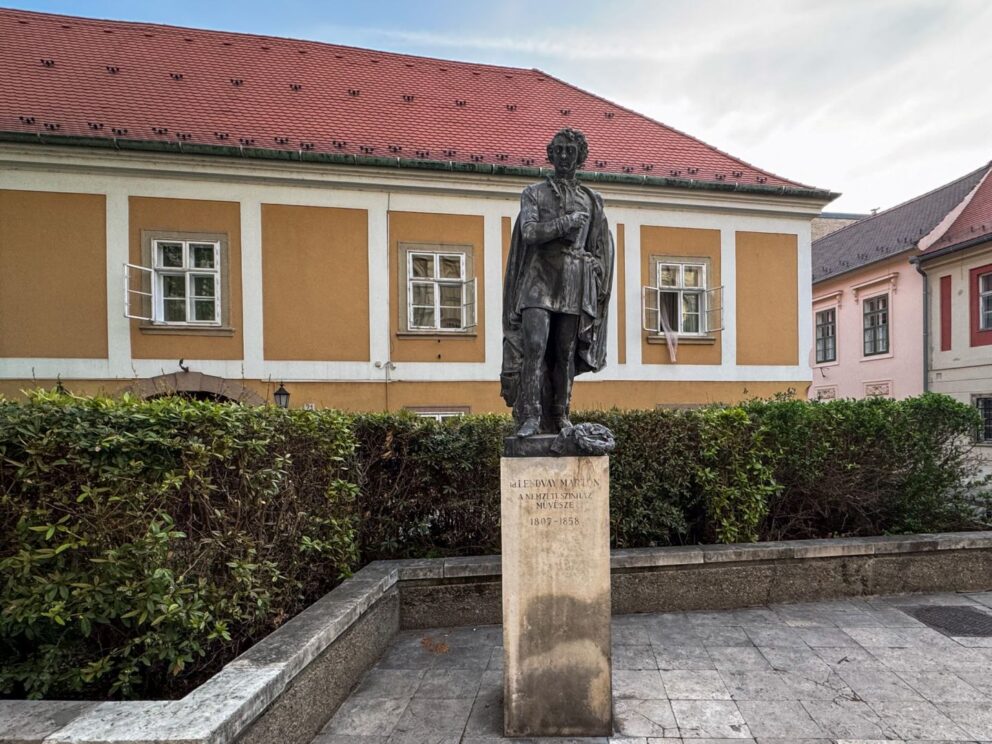
The statue of Márton Lendvay the Elder (1807–1858) is located in the Buda Castle. He was a prominent 19th-century actor at the National Theatre. This statue commemorates his significant contributions to Hungarian theatre and his legacy as one of the leading figures in the dramatic arts during his time.
56. Kazinczy Ornamental Fountain
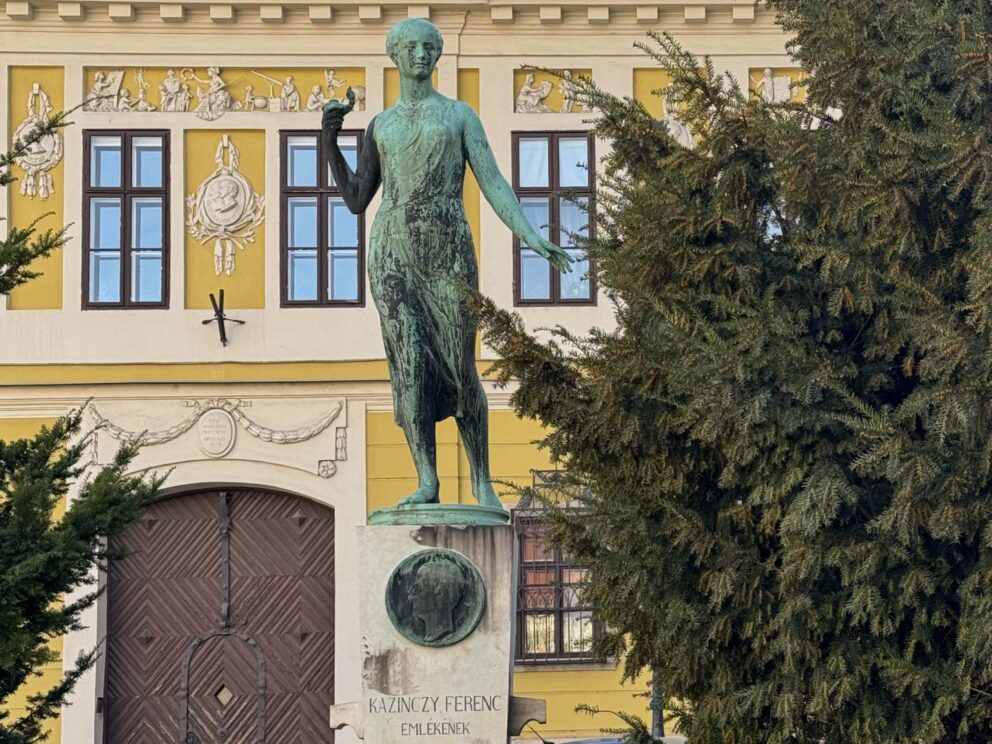
This sculpture was created to commemorate the 100th anniversary of the death of Ferenc Kazinczy. The female figure in the statue holds a torch in her right hand, symbolizing enlightenment and intellectual illumination. This tribute reflects Kazinczy’s significant influence on the Hungarian language and literature, celebrating his legacy as a key figure in the Hungarian Enlightenment.
57. The Striped House
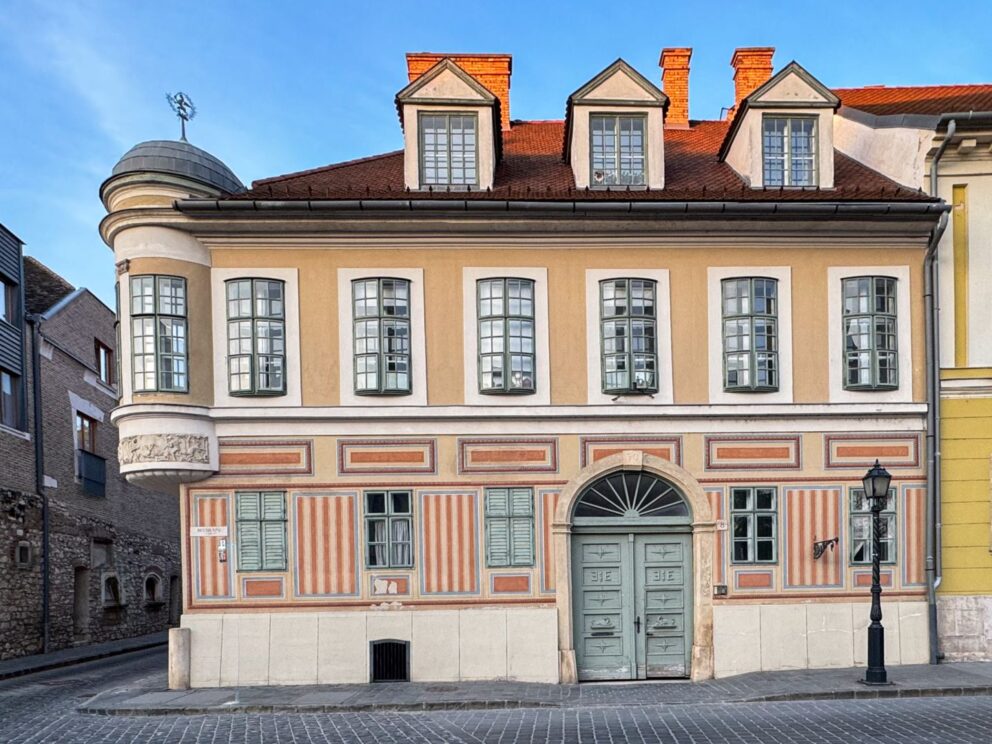
Located at 8 Bécsi Kapu Square, this “pajama-striped” house is notable for its corner balcony, which features a hunting scene. The courtyard of the house has been home to a grapevine since 1947, which has been under nature conservation protection since 1982. Additionally, the courtyard contains a secret air vent for a labyrinth of vents belonging to the National Bank’s bunker and vaults. This unique feature adds an intriguing layer of history and mystery to the already distinctive building.
58. The Tomb of Abdurrahman Pasha
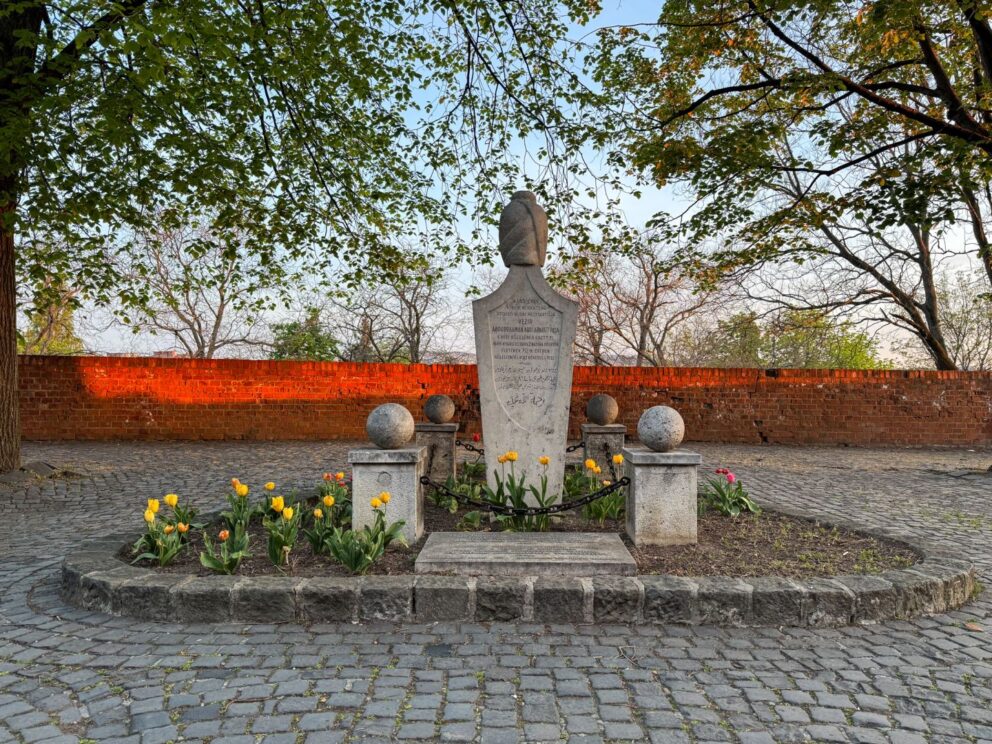
The tomb of Abdurrahman Pasha, the last Ottoman governor of Buda, is located on Anjou Promenade. Abdurrahman Pasha fell during the recapture of Buda Castle. The inscription on his tombstone is written in both Turkish and Hungarian and reads: “He was a heroic opponent, peace be with him.” This respectful epitaph acknowledges his role in history and the respect afforded to him even by those who were his adversaries.
59. Statue of Saint Michael
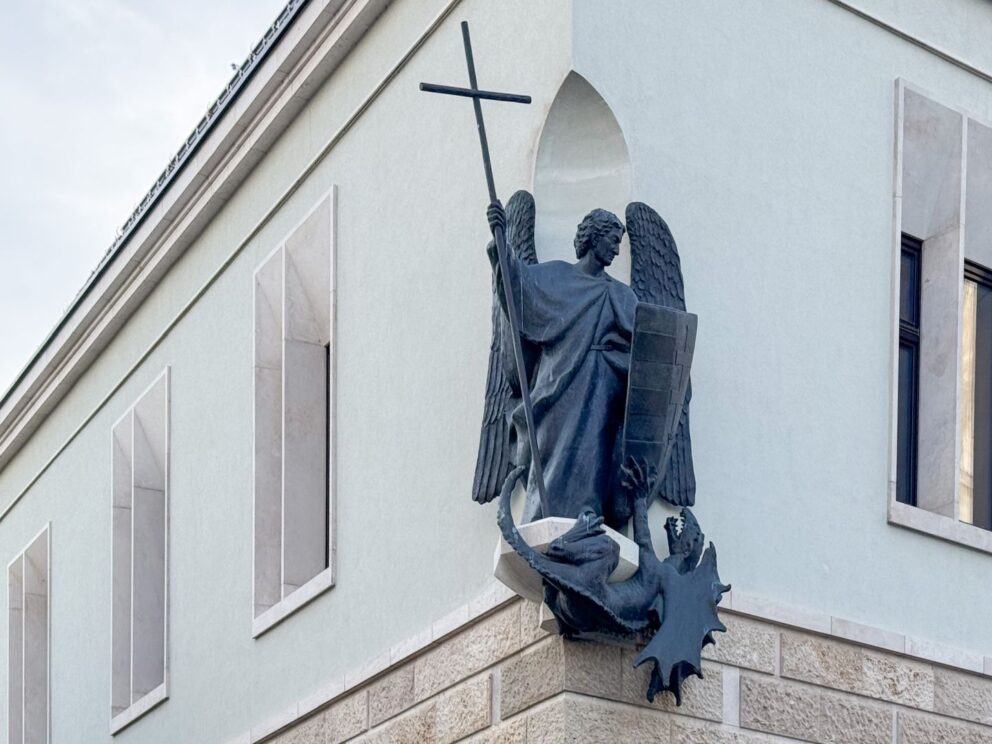
Created by Gábor Zoboki in 2018, the statue features a figure of Saint Michael slightly larger than life-size. In his right hand, he holds a cross, and in his left, a shield. At his feet, a dragon can be seen, symbolizing the evil that has been defeated or needs to be overcome.
Saint Michael has been venerated since the foundation of the Hungarian state. His enamel image is also found on the Holy Crown of Hungary, signifying his importance and protection in Hungarian history and culture.
60. Ornate Retaining Wall Below the Riding Hall
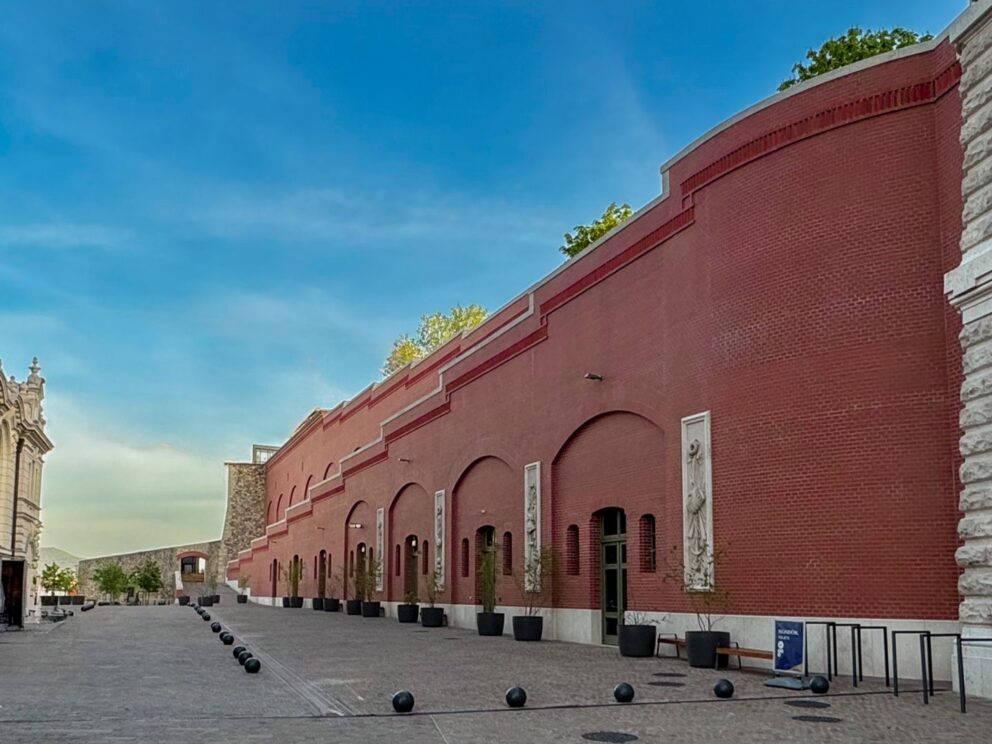
This retaining wall, covered in red brick, borders the eastern part of the castle. It is segmented by niches, each featuring a relief sculpture with military themes. The wall also functions as a ramp, providing an easy ascent to the castle for those who prefer not to use the Stöckl Steps. For those who desire even more convenience, an elevator next to the retaining wall is also available. This feature makes the wall not only a functional part of the castle’s infrastructure but also an artistic element that enhances the historical ambiance.
61. The Carmelite Monastery
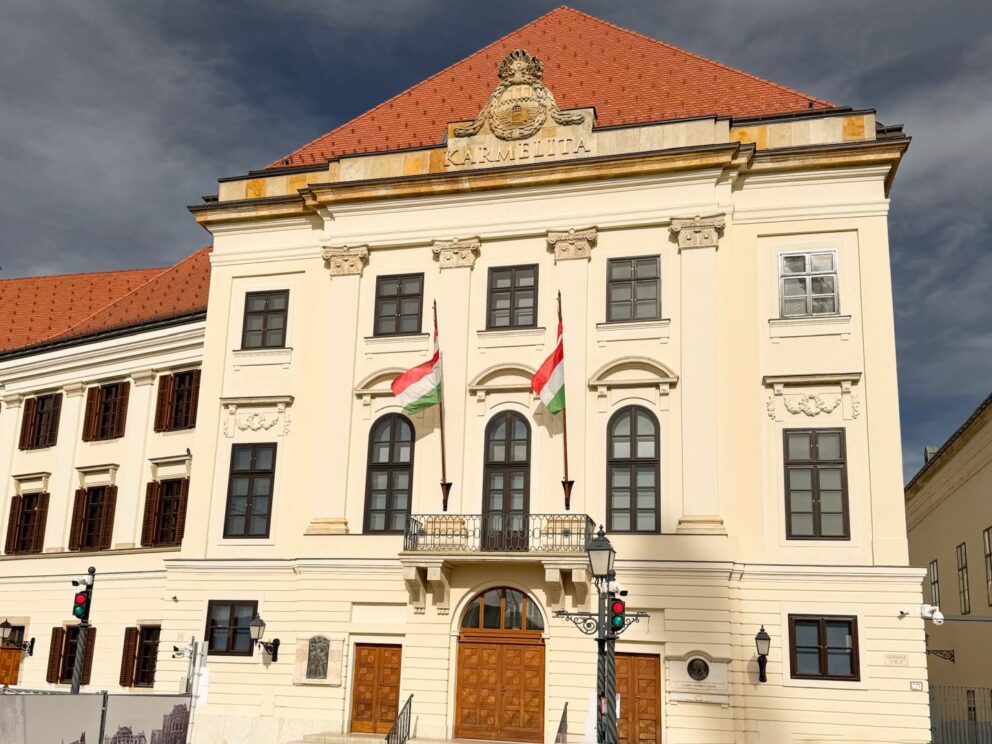
The Carmelite is currently the official residence of the President and the Prime Minister of Hungary. It is not open to tourists. This is also where red carpet receptions for delegations take place.
Historically, there was a church on this site, which the Turks converted into a mosque, and then the Carmelite monks (formally known as the Order of Our Lady of Mount Carmel) built a monastery on the plot, from which it derives its current name. Emperor Joseph II abolished the monastic order and closed the monastery.
The church was then transformed into Buda’s first theater, and the monastery into a casino. The theater opened on October 16, 1787. It primarily hosted performances in German, but the first Hungarian language troupe also debuted here in 1790 under the direction of László Kelemen. On May 7, 1800, Ludwig van Beethoven gave a concert at this venue.
After repairs from damage sustained in World War II, the former church space reopened to the public in 1978. The monastery buildings were used by various offices until 2014 when they were taken over by the Prime Minister’s Office.
Besides the commonly spoken German, Latin was the official language of Hungary until 1844.
62. Castle Museum
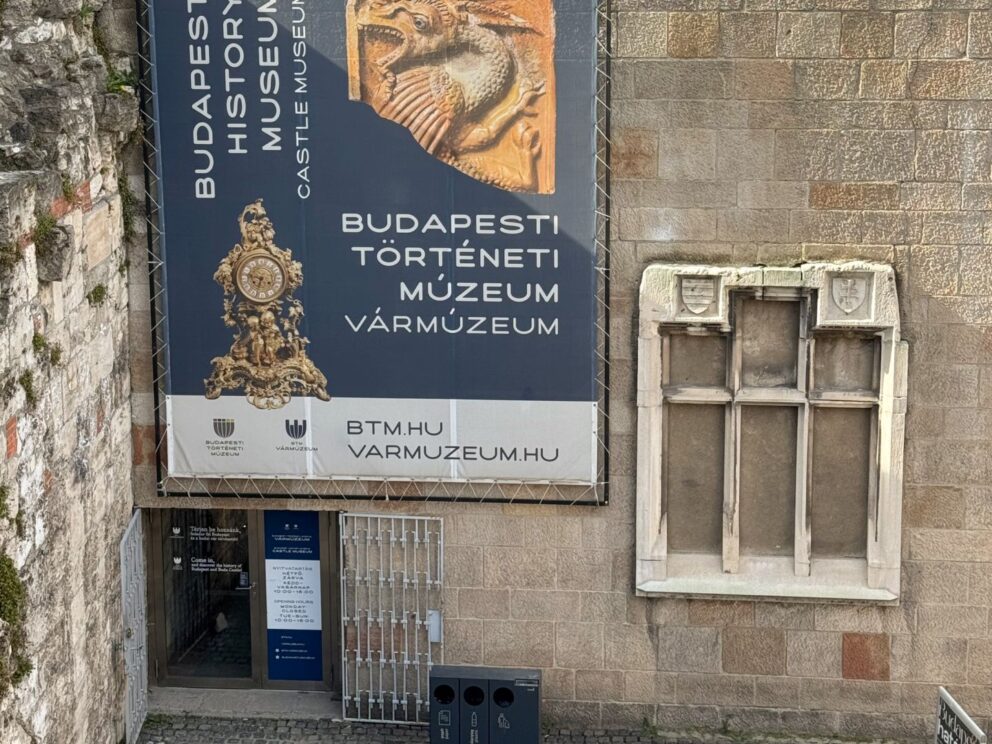
Located in the Buda Castle district, the Castle Museum has two entrances. The more hidden entrance is located behind the statue of the Virgin Mary, while the other larger and more ornate entrance can be accessed from the Lion’s Court. This is worth noting when purchasing tickets. There is a combined ticket available that allows entry to both the Saint Stephen Hall and the Castle Museum. If I recall correctly, the Saint Stephen Hall can be entered until 5:00 PM (the museum stays open until 6:00 PM) and the tickets are valid for a maximum of one hour (meaning you can stay inside for only one hour).
There are two exhibitions related to the visit to the Saint Stephen Hall. The first is about the hall itself, and the second covers the admonitions of Saint Stephen.
What can you see in the Castle Museum? The museum houses archaeological findings (fragments of walls, decorations, remnants of statues), historical relics of the city, medieval treasures, and fine art pieces.
One should not miss the fantastic castle chapel within the museum, which was an impressive part of Sigismund of Luxembourg’s Gothic palace. The chapel was reconsecrated in 1990 in honor of Saint Stephen and is suitable for holding wedding ceremonies, with seating for 18 and standing room for forty. Importantly, the chapel is available for rent!
Surprisingly, the oldest artifacts in the museum are more than 40,000 years old!
63. Lion’s Court at Buda Castle
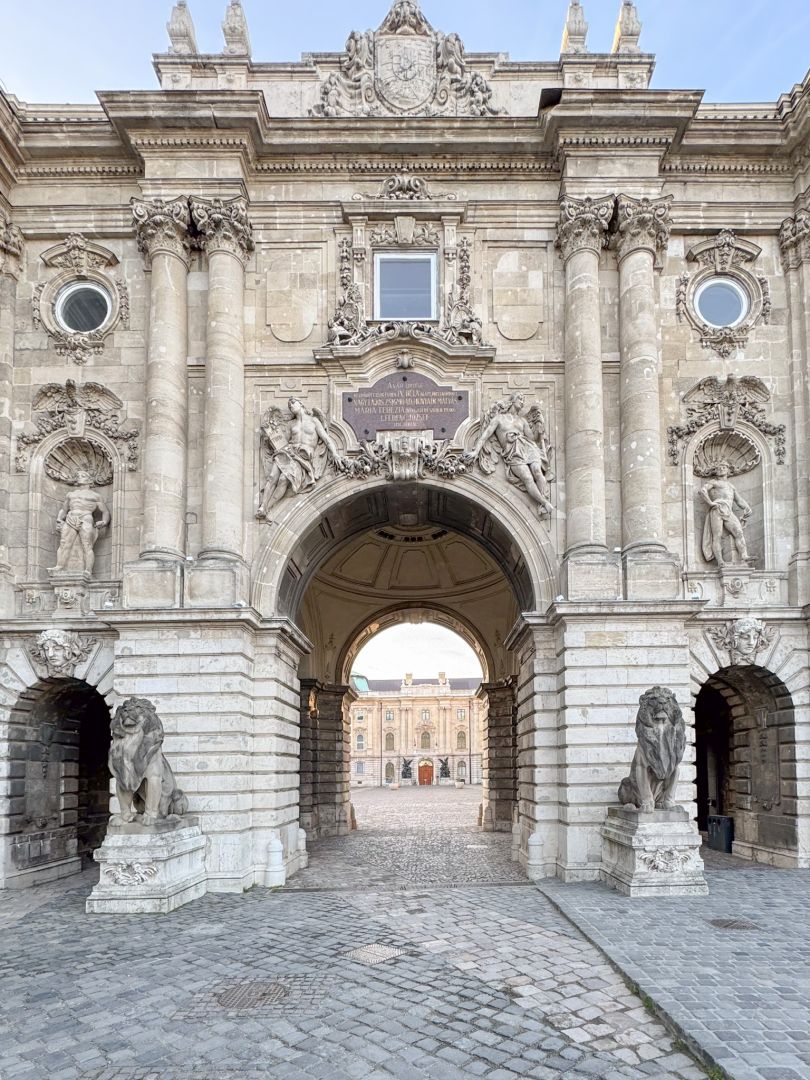
The Lion’s Court is named after the four lions that guard the entrance: two outside and two inside. The exterior lions proudly welcome visitors, while the interior gate lions resemble roaring wild animals.
The lions were sculpted by János Fadrusz in 1902 and inaugurated in 1903. The Lion’s Court is a 4,300 square meter enclosed cobblestone courtyard surrounded by the Hungarian National Gallery, the Budapest History Museum, and the National Széchényi Library.
The courtyard’s gray cobblestone pavement features lighter-colored stripes that indicate the outlines of the excavated and then reburied medieval palace walls. The Lion’s Court, especially under night lighting, presents a spectacular sight. Not surprisingly, it often serves as a venue for various events, adding to its historical and architectural significance.
64. War and Peace Sculpture Group
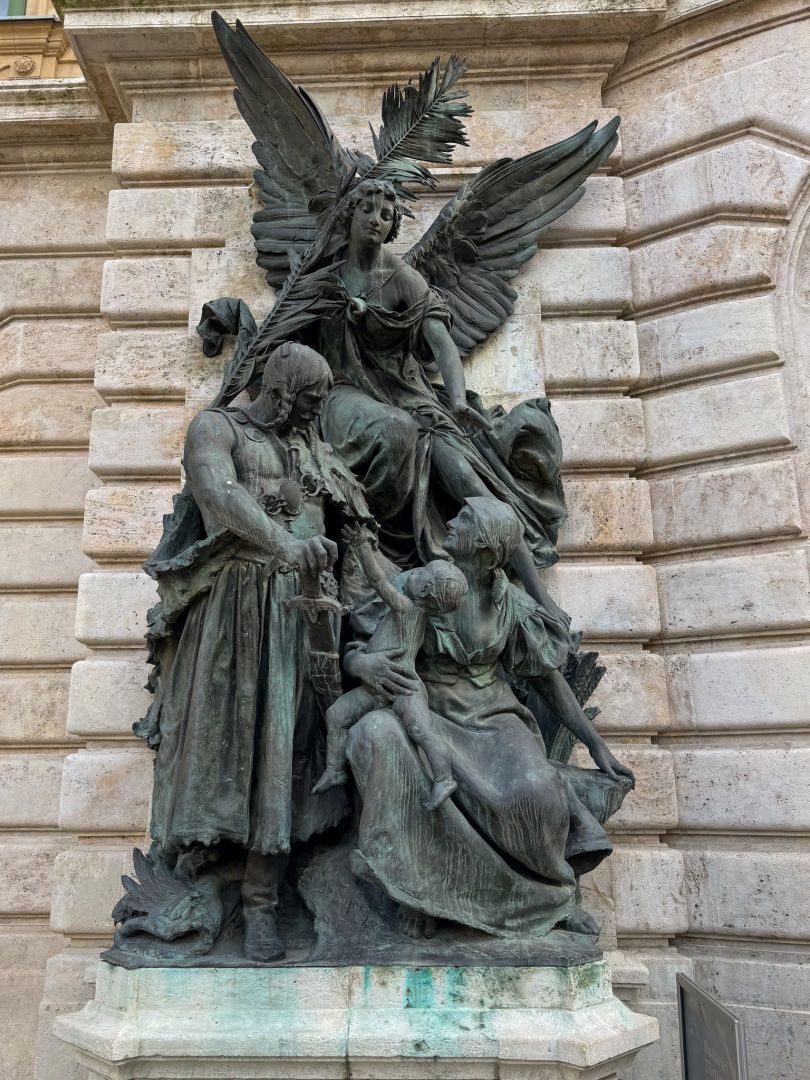
Located in the Lion’s Court near the entrance to the Castle Museum within the Buda Castle district, the “War and Peace” sculpture group was crafted by Károly Senyei.
The “War” sculpture features four figures. At the top, an angelic figure with a helmet blows a trumpet, symbolizing the call to arms. Below this figure, a victorious warrior wearing a helmet stands triumphant over a fallen soldier, whose defeat is further signified by a broken sword. Beside them, a figure representing an ancient Hungarian warrior embodies the martial virtues of the Hungarians.
The “Peace” sculpture group, in contrast to “War,” symbolizes abundance, good living, and tranquility. It consists of four figures: an angel bringing an olive branch, symbolizing peace, is positioned above a scene where a returning father is greeted warmly by his family, capturing a moment of joyful reunion. This group represents the serenity and prosperity that follow the resolution of conflict.
65. Hungarian National Gallery
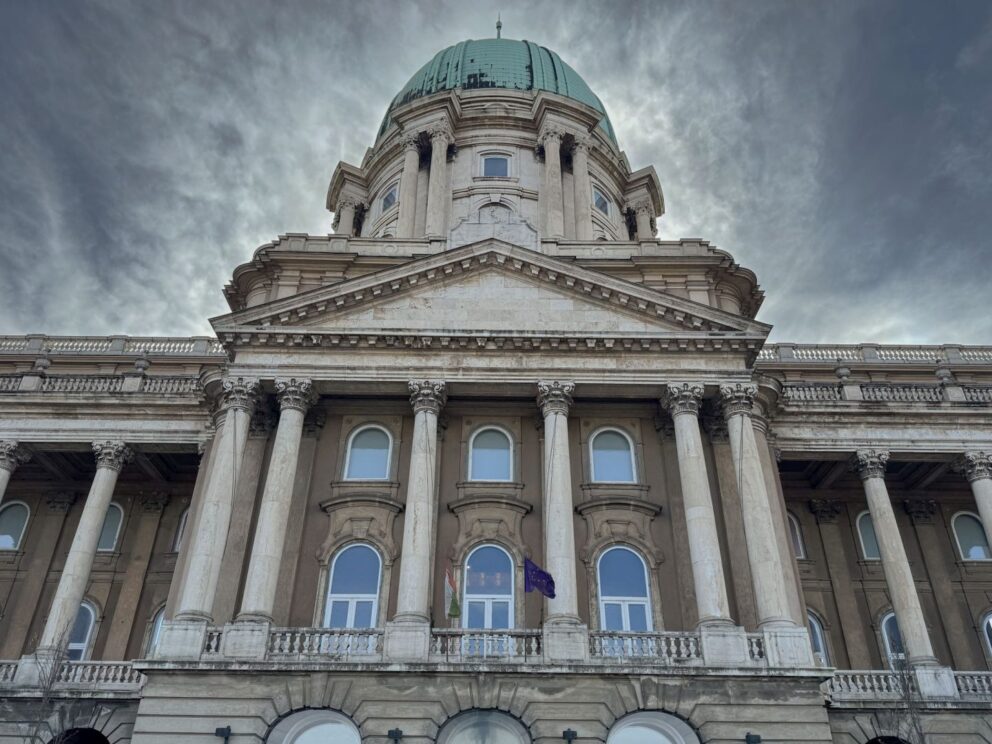
The Hungarian National Gallery presents the development of visual arts in Hungary from the foundation of the state to contemporary modern art. After the nationalization of the capital city’s art collection in 1953, there was no longer sufficient space at the Museum of Fine Arts to exhibit all the visual arts materials. The idea of establishing a completely independent Hungarian museum of fine arts materialized after the revolution of 1956, leading to the founding of the Hungarian National Gallery in 1957.
Initially, the collections of the Hungarian National Gallery were primarily drawn from the New Hungarian Gallery of the Museum of Fine Arts, including its modern sculpture, medal, and graphic collections. At the time, the collection consisted of approximately 6,000 paintings, 2,100 sculptures, 3,100 medals, 11,000 drawings, and 5,000 prints. The Gallery opened on October 5, 1957, in the former Curia building on Kossuth Square.
In 1975, the Hungarian National Gallery moved to the Buda Castle Palace, where it opened its first exhibition in October of the same year. In 2005, the gallery’s exhibition spaces were expanded with further parts of the Buda Castle, allowing for even more exhibitions.
Today, the Hungarian National Gallery’s collection includes 110,000 works of art, with its notable pieces on display in permanent exhibitions. The museum also offers temporary exhibitions for a more comprehensive presentation of individual artists’ work.
A special feature of the Hungarian National Gallery is the panoramic viewing terrace, which can be accessed only after purchasing an entrance ticket.
It’s important to note that the panoramic terrace is closed during the winter season, so visitors can only enjoy the view through the glass during that time.
66. National Széchényi Library
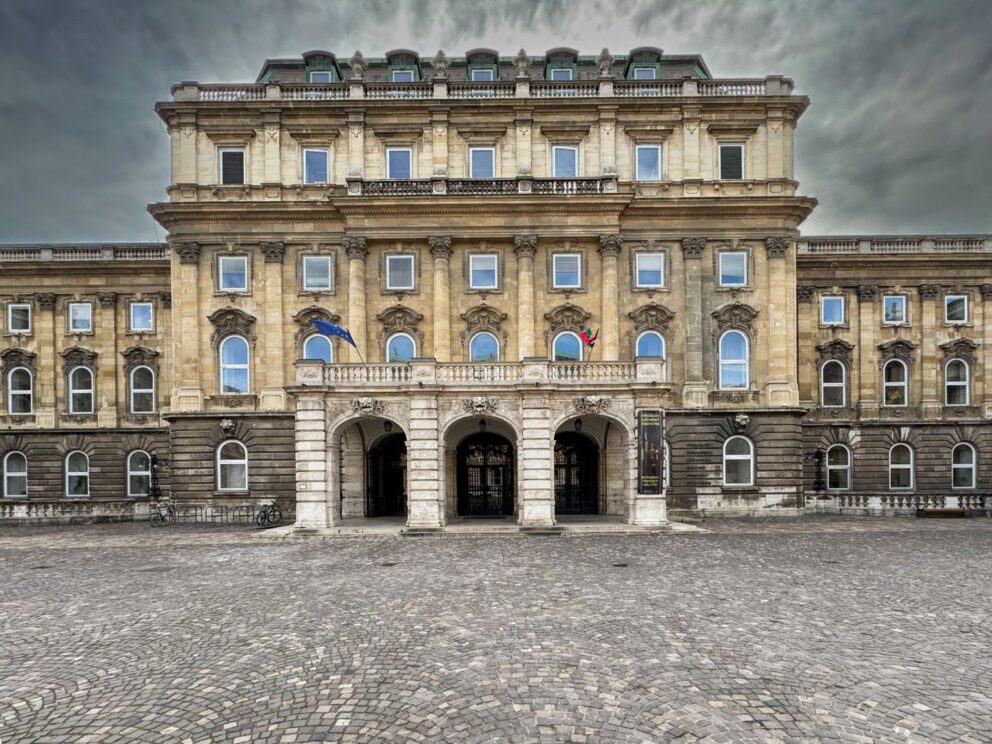
The National Széchényi Library is named after Count Ferenc Széchényi, the father of István Széchényi, often referred to as “the greatest Hungarian.” The library was founded on November 25, 1802, by Count Ferenc Széchényi and has been open to the public since 1803.
Covering a total area of 44,000 square meters, it is one of the country’s largest public buildings, with an interior volume of 260,000 cubic meters. The library shelves extend over more than 75 kilometers, and books are moved with the help of an electronic transport system that runs for over one kilometer.
A lesser-known aspect of the library is the legal deposit system, which obliges publishers to provide two free copies of their published works to the national library.
Currently, the library holds 10 million items, including more than 3 million books, 330,000 periodicals (newspapers), and over 1 million manuscripts. There are approximately 200,000 maps and 310,000 pictures and engravings. Additionally, the library houses around 3 million posters and flyers.
Among its treasures is the first work printed in Hungary, the “Chronica Hungarorum,” which was printed and published in 1473.
The size of the library is evidenced by its seating capacity; it has two large and several smaller reading rooms that can accommodate up to 700 readers at once. Most of the works available here are for reference only and cannot be checked out for external use.
67. Fountain of the Fishing Children
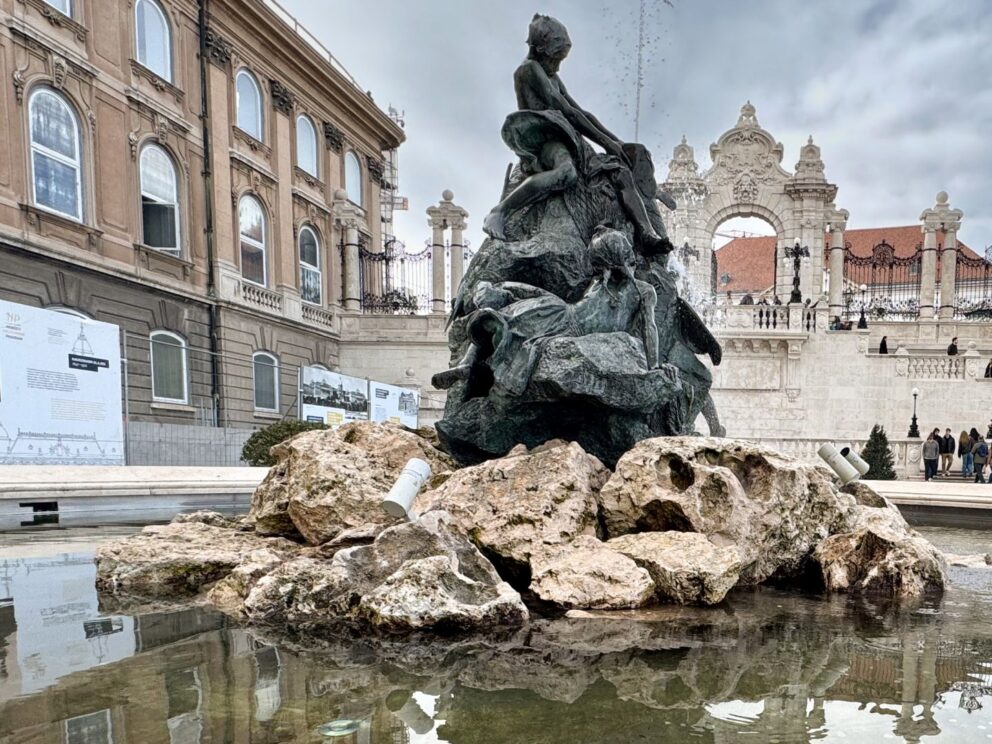
Located in front of the National Gallery, opposite the Habsburg Gate, is the “Fountain of the Fishing Children.” This sculpture was created by Károly Senyei, the artist responsible for the statues of Saint Stephen and Andrew II at Heroes’ Square. Unfortunately, Senyei did not enjoy the popularity of his work for long, as he passed away three years later at the age of 65.
The sculpture depicts children struggling with a giant catfish, surrounded by a large fountain. Tourists often throw coins into the fountain, hoping it will grant them a wish.
An interesting aspect of this sculpture is its history during and after World War II. It was damaged around the time of the war and was subsequently moved from the castle to in front of the market hall in the seventh district. The setting was quite fitting, as the boys appeared to be taking the freshly caught catfish to the market for sale. In 1976, a decision was made to restore the “Fountain of the Fishing Children,” and by 1977 it was returned to its original location at Buda Castle.
68. Habsburg Gate
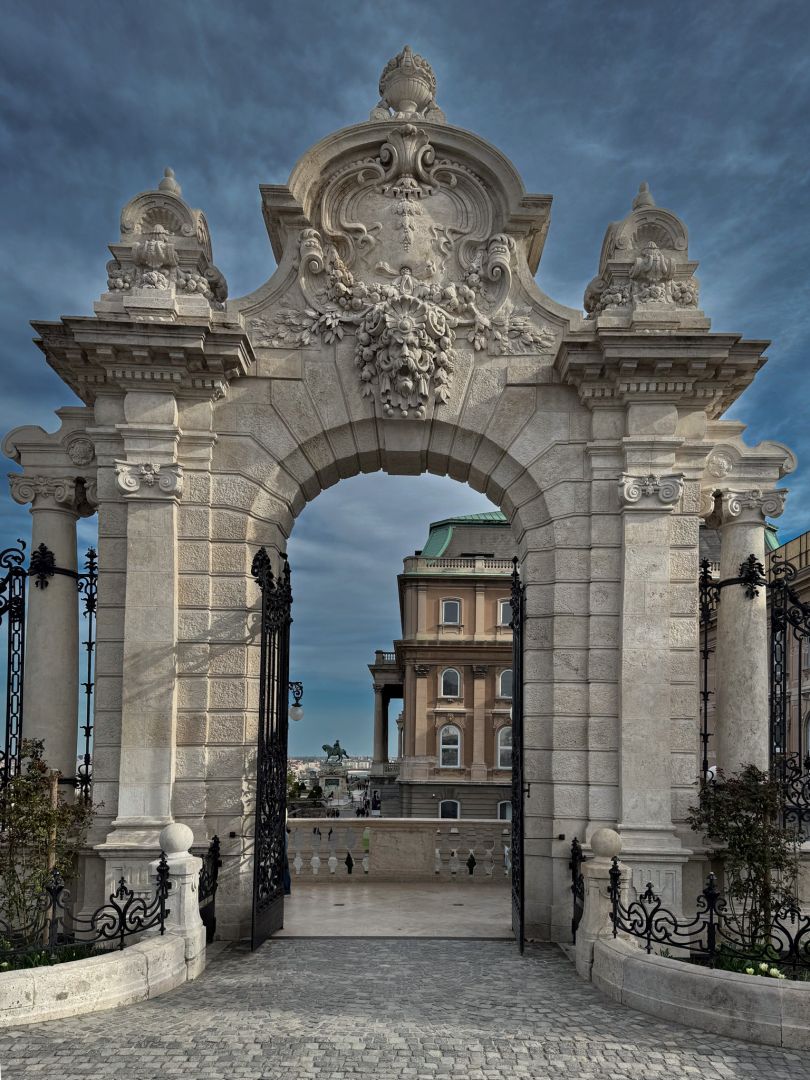
The path from Hunyadi Courtyard to the funicular passes through the stunning Habsburg Gate, also known as the Baroque Gate. This gate is associated with the architect Alajos Hauszmann and the ornamental blacksmith Gyula Jungfer. The sculptural group is perfectly complemented by Jungfer’s wrought iron fence and its motifs. Gyula Jungfer, awarded the French Legion of Honor, was born into a deeply-rooted family of blacksmiths on January 9, 1841.
Unfortunately, the gate was also damaged during World War II. The gate as seen today was restored by 1981. At the corner of the gate closest to the Danube, a statue of the Turul, a mythical bird prominent in Hungarian folklore, has been placed, enhancing the historical and cultural significance of the gate within the Buda Castle area.
69. Statue of Prince Eugene of Savoy
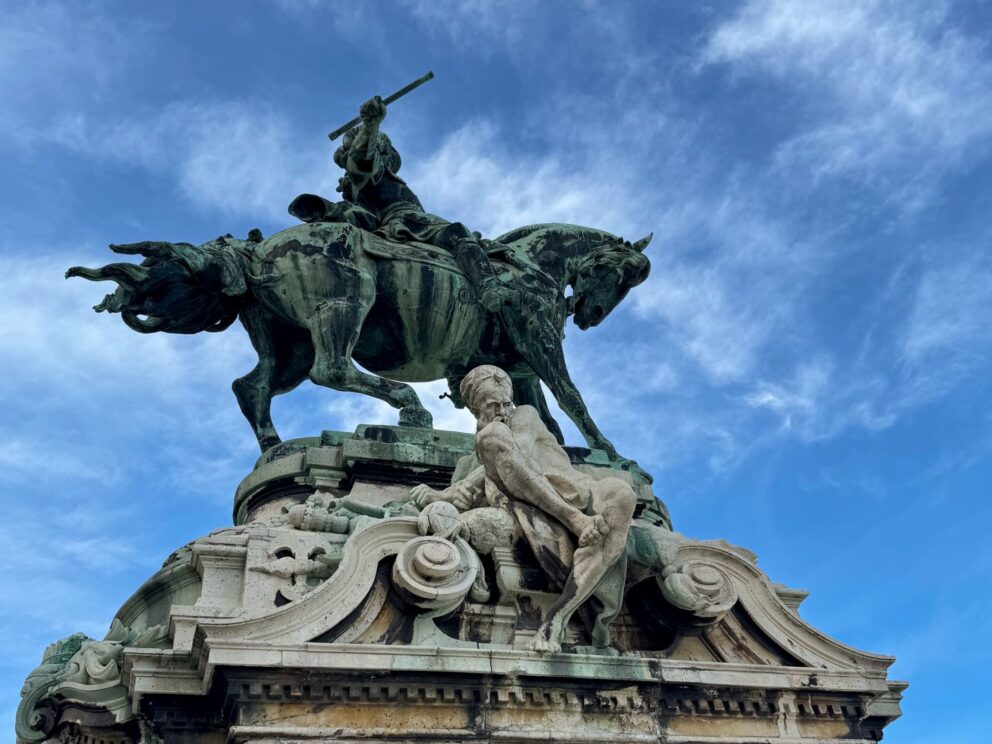
While Prince Eugene of Savoy did not personally raise the flag during the recapture of Buda Castle, his name is closely associated with the expulsion of the Turks due to his most brilliant victory at the Battle of Zenta. The statue presents the courageous commander in ornate attire and full armor, standing proudly. On either side of the statue are figures of an old and a young Turkish prisoner, symbolizing the defeated Ottoman Empire. At the front, the crowned Hungarian coat of arms is visible.
The statue was created by József Róna in 1900.
70. Casting Yard Courtyard
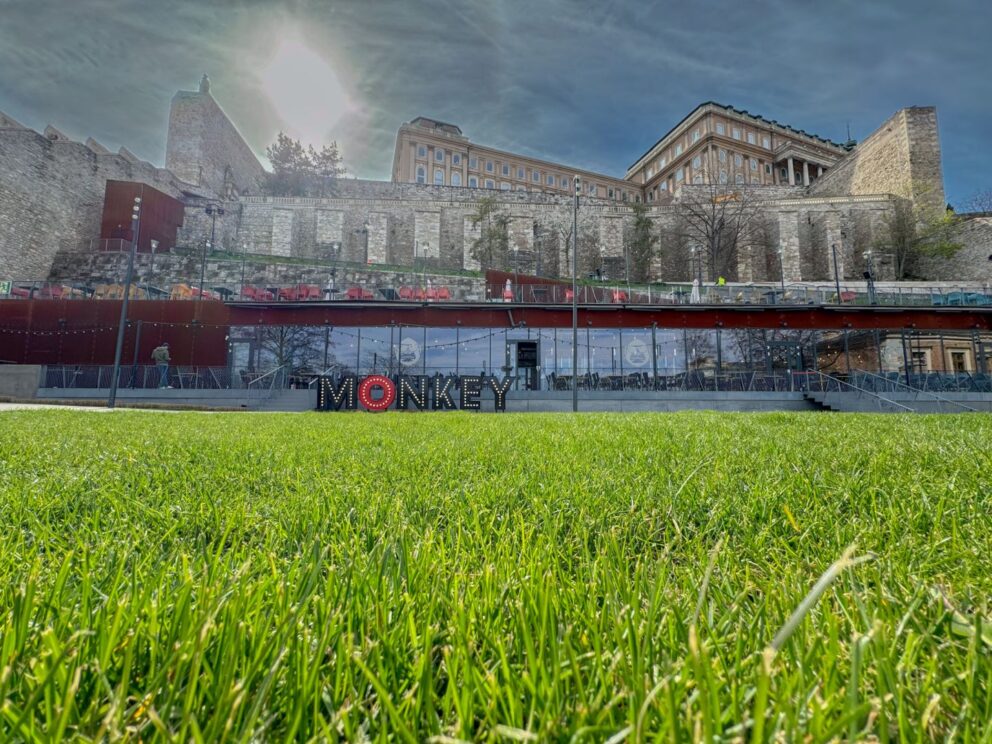
The Casting Yard Courtyard got its name during the medieval period when it was used for casting cannonballs. This courtyard has two interesting features. During their occupation, the Turks dug a massive well here in search of water. When they failed to find any, they started using the well as a garbage dump, much to the delight of modern archaeologists. Unbelievably, during World War II, the area served as a tennis court. Over the years, it has also been used as a warehouse, vegetable garden, parade ground, and later as a stone storage by the museum. Currently, a restaurant operates here and there’s a small park where visitors can relax. If you need to take an elevator within the castle, you can switch from the first elevator to a second one located in the corner of this courtyard. The edge of the Casting Yard Courtyard is also where you’ll find the Water Pouring Stairs.
71. Water Carrier Stairs
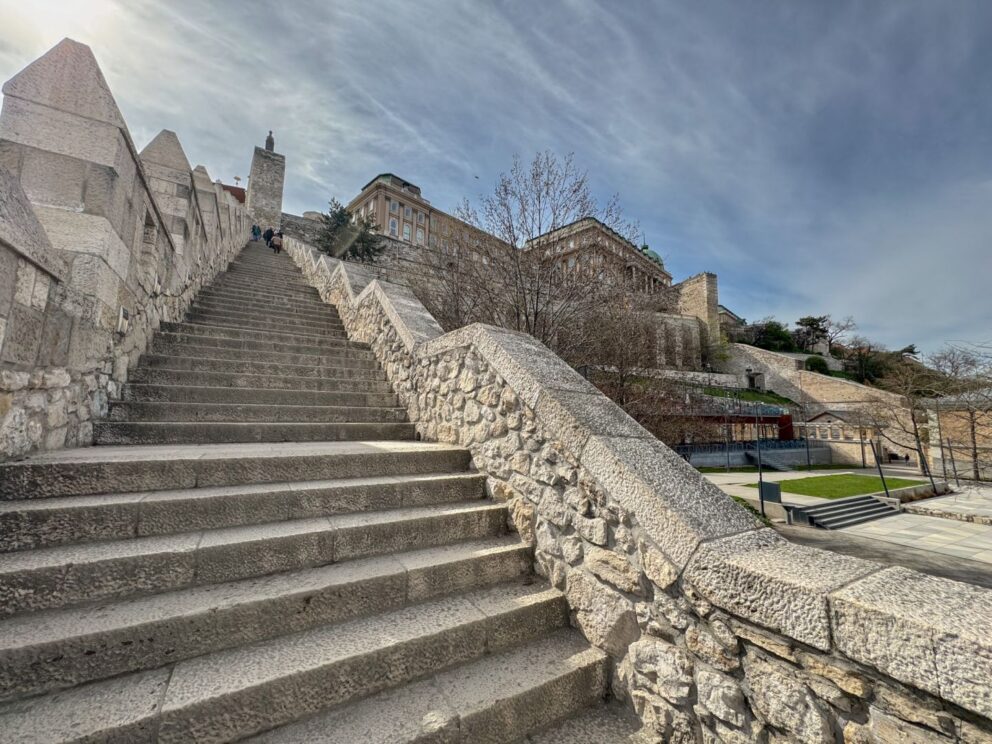
The Buda Castle is connected to the Danube by a wall known as the curtain wall. On each side of this curtain wall, there is a staircase. Unfortunately, many people are mistaken about which one is the Water Carrier Stairs. The Water Carrier Stairs are located on the side of the wall facing the Casting Yard Courtyard. On the opposite side of the wall, next to the escalator, another set of stairs leads up to the castle district. As the name suggests, the Water Carrier Stairs were named after the water carriers who, during sieges, used this protected route to transport water from the Danube to the castle residents.
72. Southern Rondella

Rondellas are strong artillery fortifications that are connected to the neighboring castle walls. They are rounded or circular, built from stone or brick, and primarily served to protect the castle, often with cannons placed on top. They were typically used in the 15th and 16th centuries. Unfortunately, rondellas also have a so-called “blind spot” which makes them vulnerable, and it was not possible to place many cannons on their tops. Therefore, by the 17th century, contemporary military technology could no longer take advantage of their benefits. In the Buda
The Southern Rondella (also known as the Great Rondella), located above the Castle Garden Bazaar.
The Fehérvár Rondella, which protected the rear part of the castle.
The Esztergom Rondella, built under the national flag.
73. Golden Eagle Pharmacy
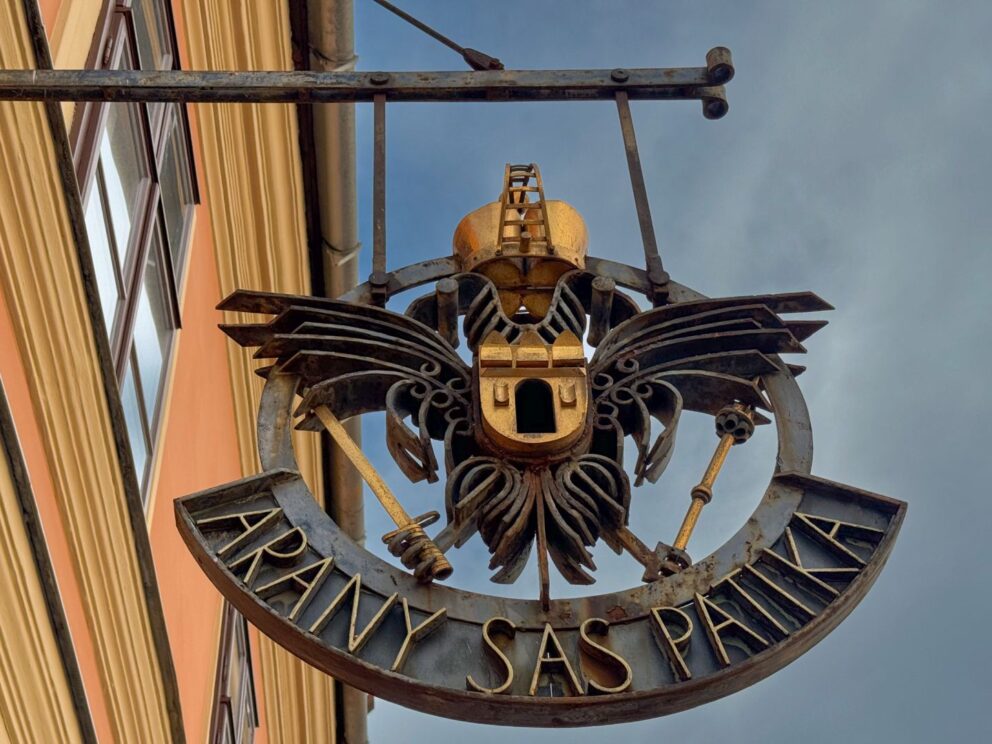
This pharmacy has been serving customers since the 18th century, located at Tárnok Street 18.
The old furniture and artifacts have been transformed into a pharmacy museum.
The Golden Eagle Pharmacy’s sign enriches the collection of beautiful signs found in the Buda Castle area.
Summary of Golden Eagle Pharmacy
74. Beggar’s Gate, or Raven Gate

In medieval times, the Beggar’s Gate likely stood on this site, earning its name from the prisoners and beggars who frequented this area, possibly begging as well. After the Ottoman occupation, the reconstructed gate on this side of the Buda Castle served as an entrance to the fortress. The gate was demolished in 1960, and its current version has been in place since 1995. The current gate features a spider web design topped with a raven. A notable feature of the gate is the miniature figures standing in place of the two doorknobs
75. The Triton Fountain – Neorenaissance Garden
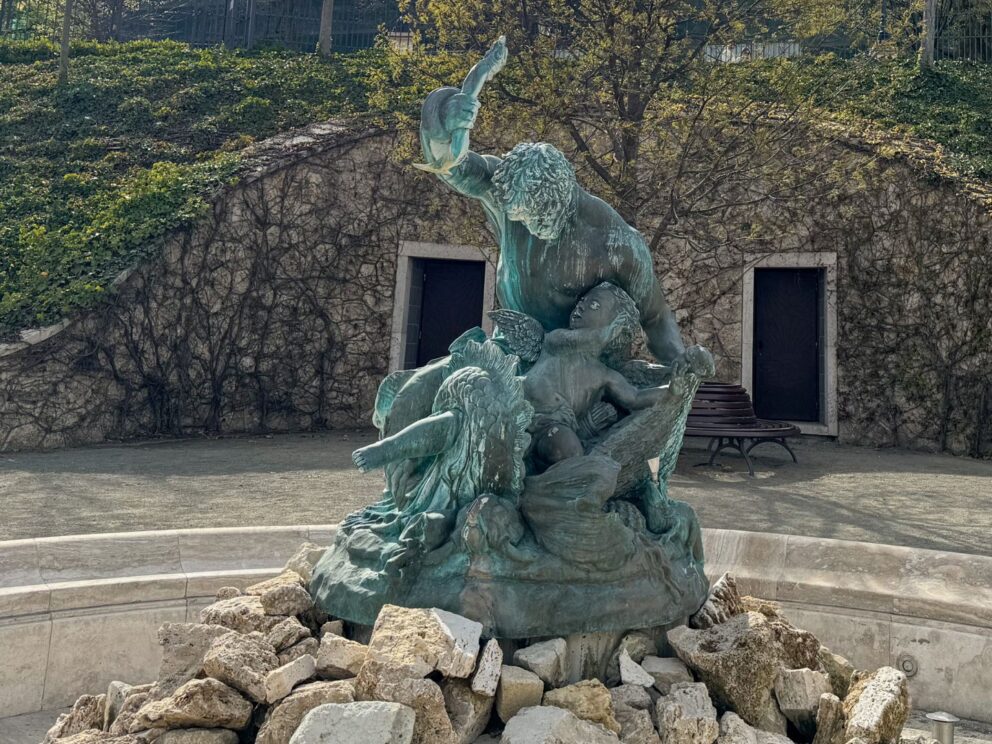
The Neorenaissance garden of the Várkert Bazár, built between 1874 and 1882, serves as the castle park of Buda Castle. This park, covering more than 5000 square meters, is adorned with a fountain that attracts visitors like a magnet during warm weather.
Since its beautiful restoration in 2014, it has provided a place for those wishing to walk and relax.
The Triton Fountain is inspired by Andersen’s fairy tale, “The Little Mermaid.”
In Greek mythology, Triton is the son of Poseidon (the sea god) and Amphitrite. He is depicted as half-man up to the waist and has a bifurcated fish tail below, with daughters who were mermaids.
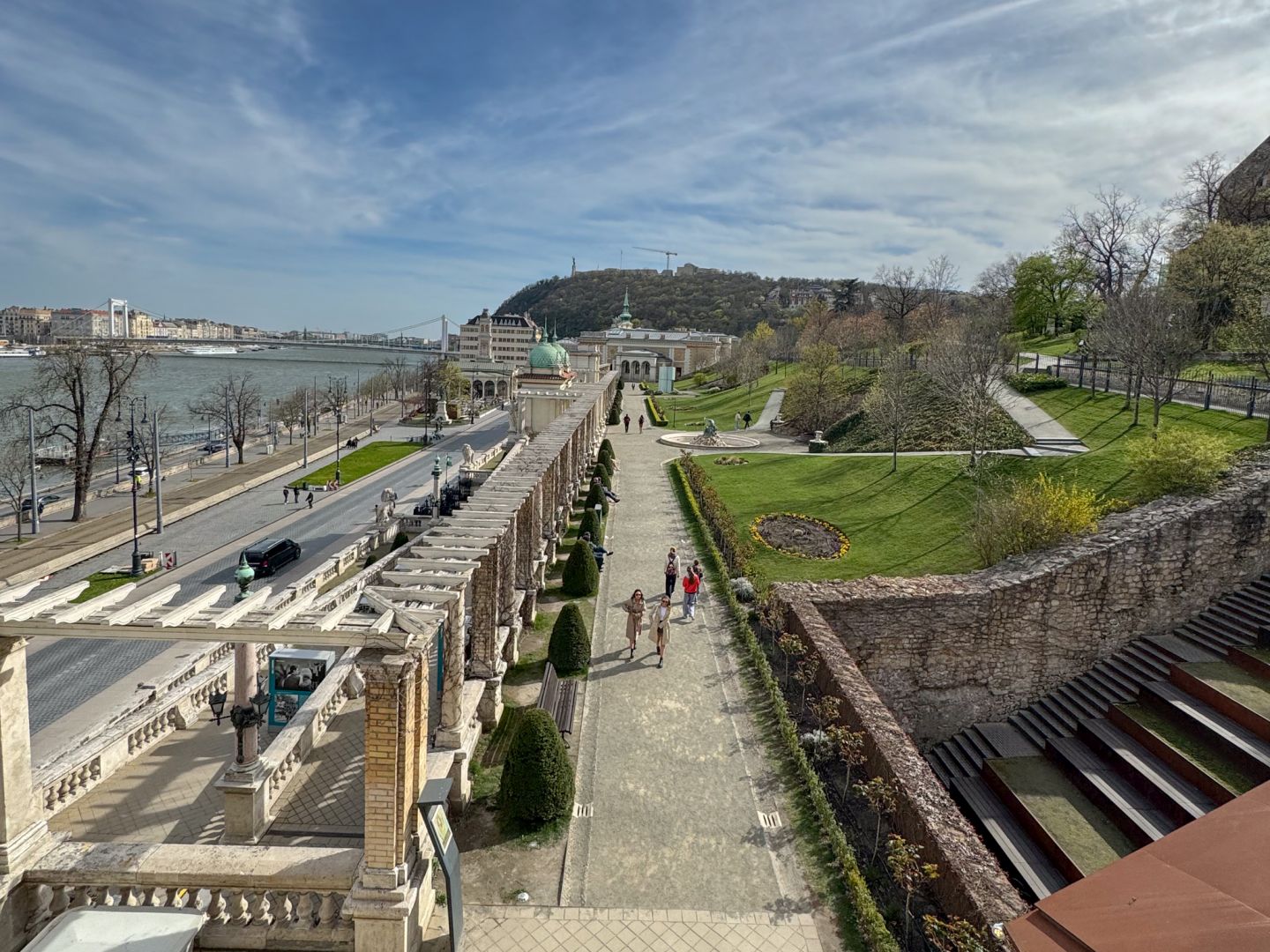
76. Neptune Fountain
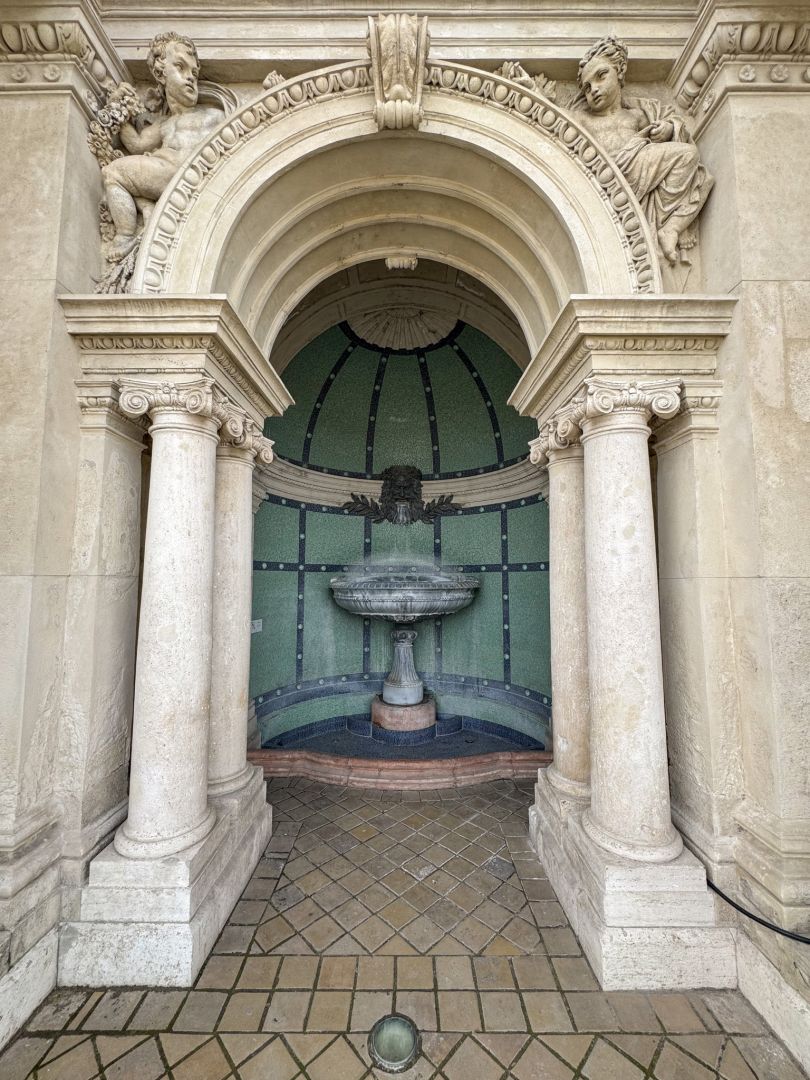
The Neptune Fountain is the ornate fountain of the Gloriette, located in the Várkert Bazaar. The Neptune Fountain is one of the most beautiful fountains in the Buda Castle District, decorated with gorgeous Zsolnay tiles. Its basin is made of zinc.
77. Gloriette
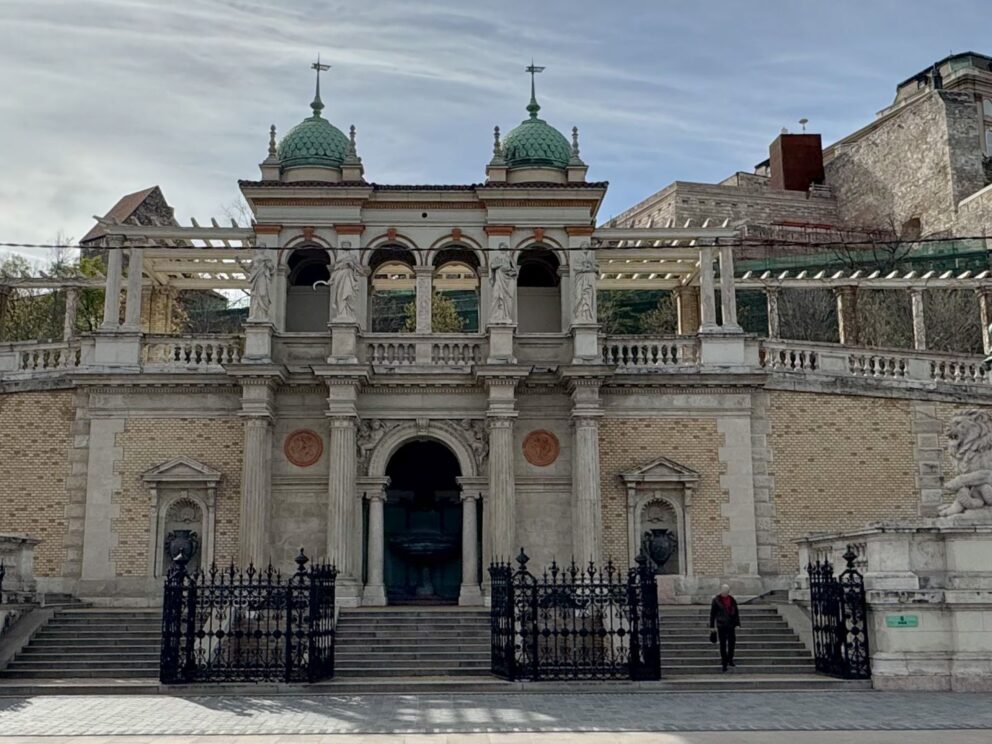
The Gloriette is the central part of the Várkert Bazaar. It is adorned by two lions, one representing peace and the other embodying war.
78. The Stair Pavilion
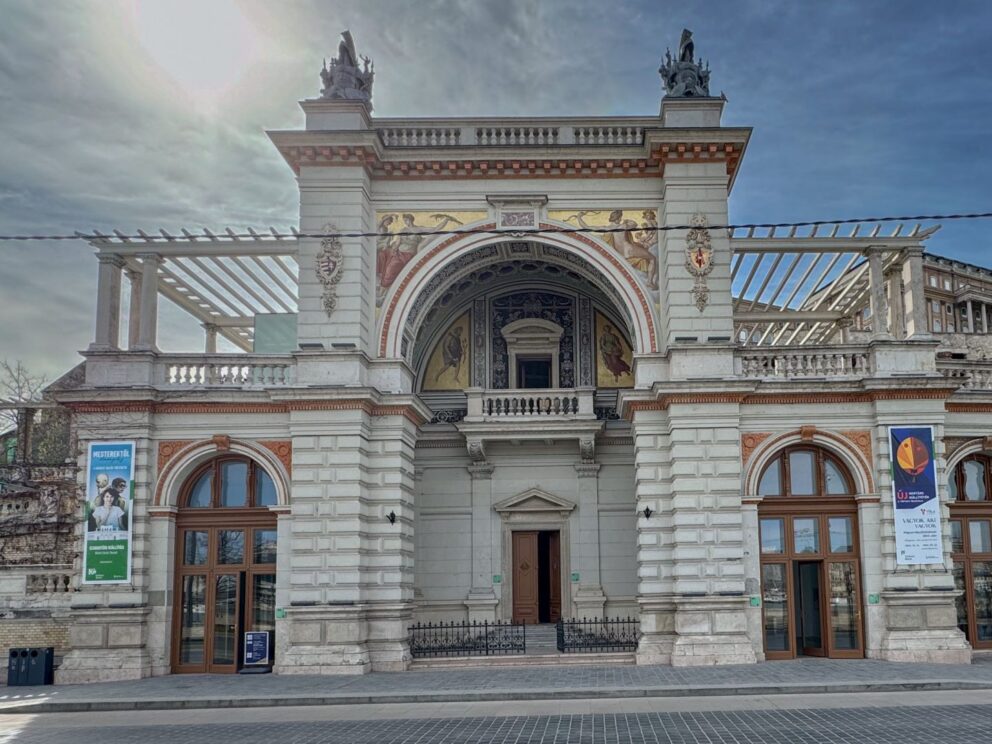
The Stair Pavilion is the central part of the Várkert Bazaar. It features a covered, splendid spiral staircase that leads up to the Renaissance garden and the lower parts of the Buda Castle.
One can observe the play of sunlight in this vast space. The pattern on the dome’s opalescent glass roof, mirroring the design on the floor, seems to capture and reflect the sunbeams, creating a mirror image.
Another stunning display of light can be seen through the east-facing, stained glass balcony doors created by Ede Kratzmann.
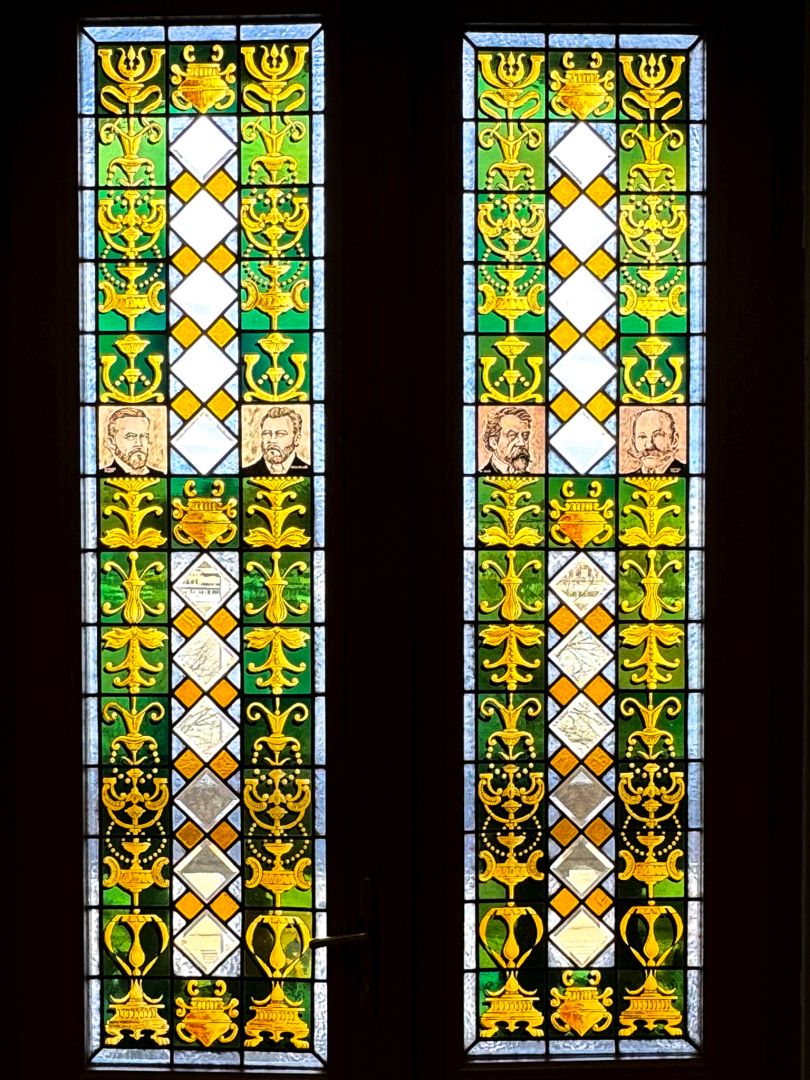

79. The escalator in the Buda Castle District
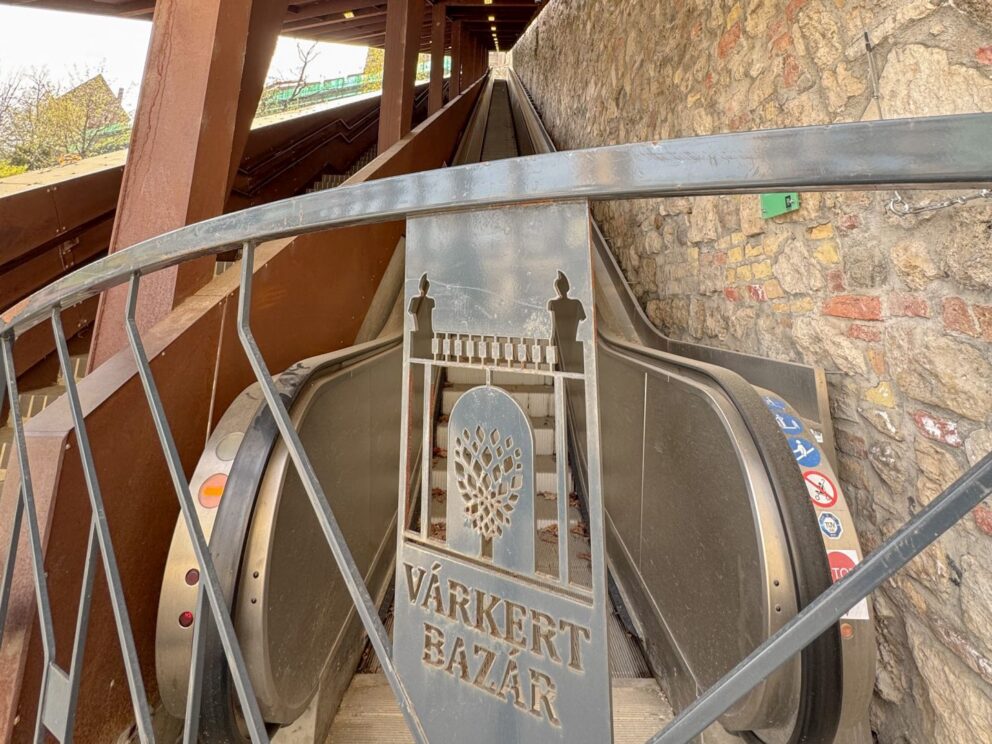
This escalator is the longest covered escalator in Europe. It starts from the Várkert Bazaar and runs alongside the Cortina Wall.
A unique feature of this escalator is that there are three staircases beside it!
Unfortunately, the escalator does not always operate, so if you are visiting just to try it out, be sure to have a backup plan!
80. Wheat Grain or Bud Fountain
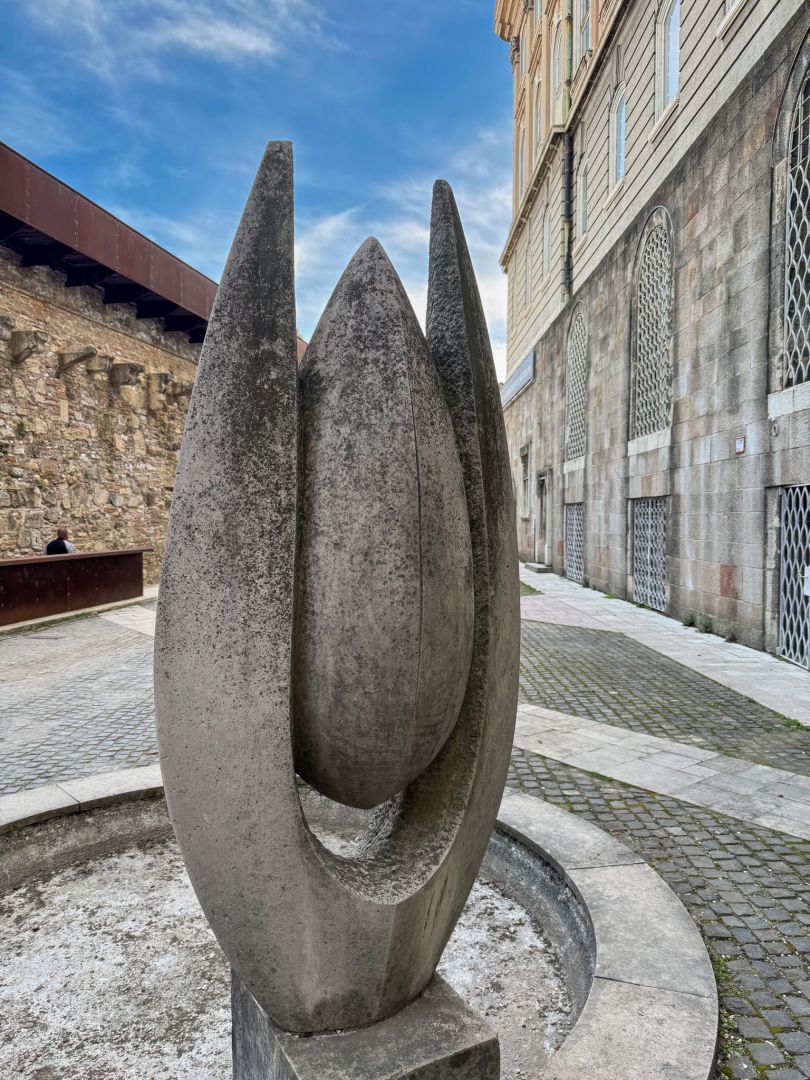
Unfortunately, I also don’t have much information about it, but it’s worth mentioning as an interesting tourist attraction.
It adorns the lower, southern courtyard of the Historical Museum.
The fountain represents a wheat grain. It is also referred to as the Wheat Grain or Bud Fountain.
81. Tünde Statue
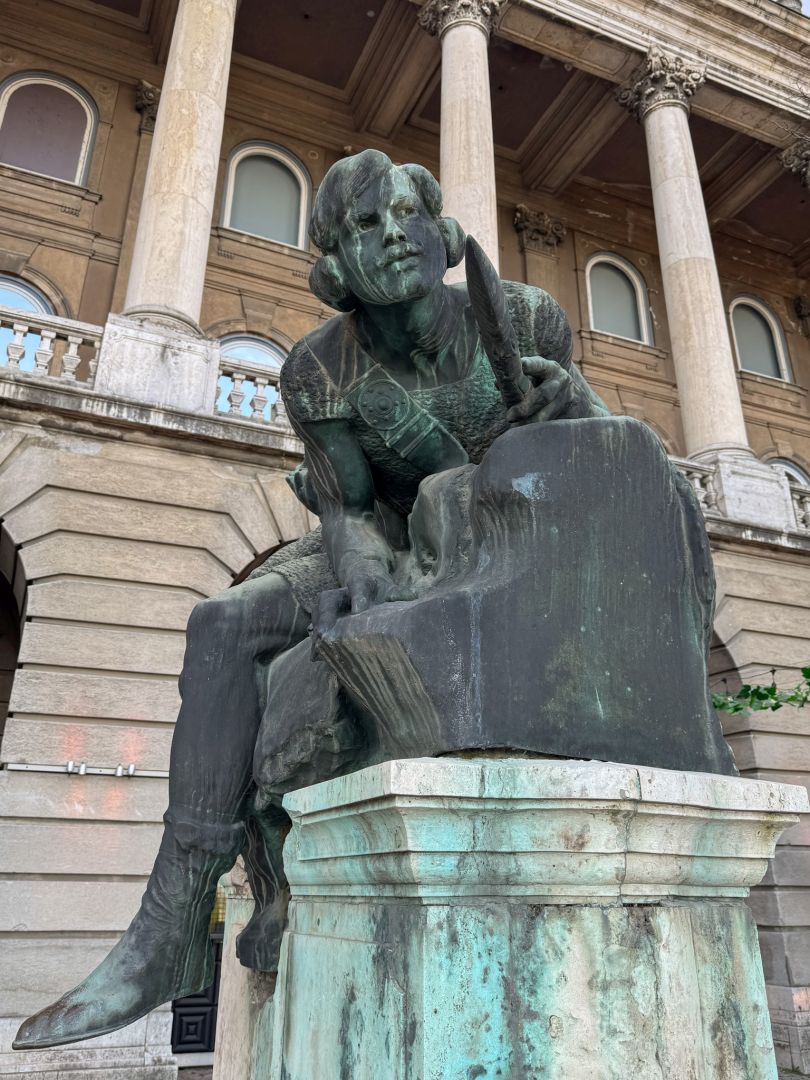
The statue represents Tünde, a heroine from Mihály Vörösmarty’s poem “Csongor and Tünde”. Originally, this small statue and its pair, Csongor, were placed near the resting spots on the half-levels of the neobaroque decorative staircase. The statues were damaged during World War II. They were demolished and only returned in 1976, but this time they were relocated behind the Savoyai statue, next to the main entrance of the National Gallery. In her right hand, Tünde offers an (bronze) apple to passersby.
82. Bonfini Statue
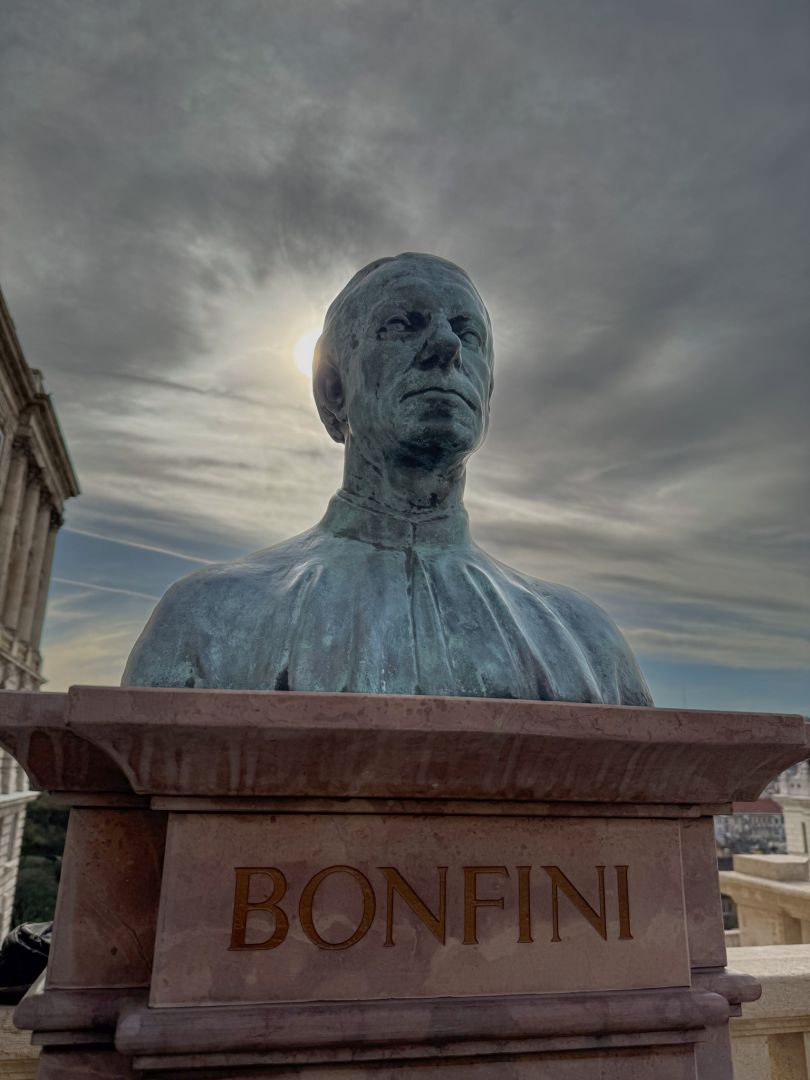
The bust is a replica of the original statue, which was destroyed during the Siege of Budapest in 1944, in World War II. The original statue was sculpted by Zoltán Farkas, who also worked as a lawyer, in 1934. Farkas created two copies of the statue; the first was unveiled near the current location of the replica in 1934, and the second was donated in 1935 to Bonfini’s hometown of Ascoli Piceno. The replica was unveiled on January 21, 2009.
83. Marsigli Statue
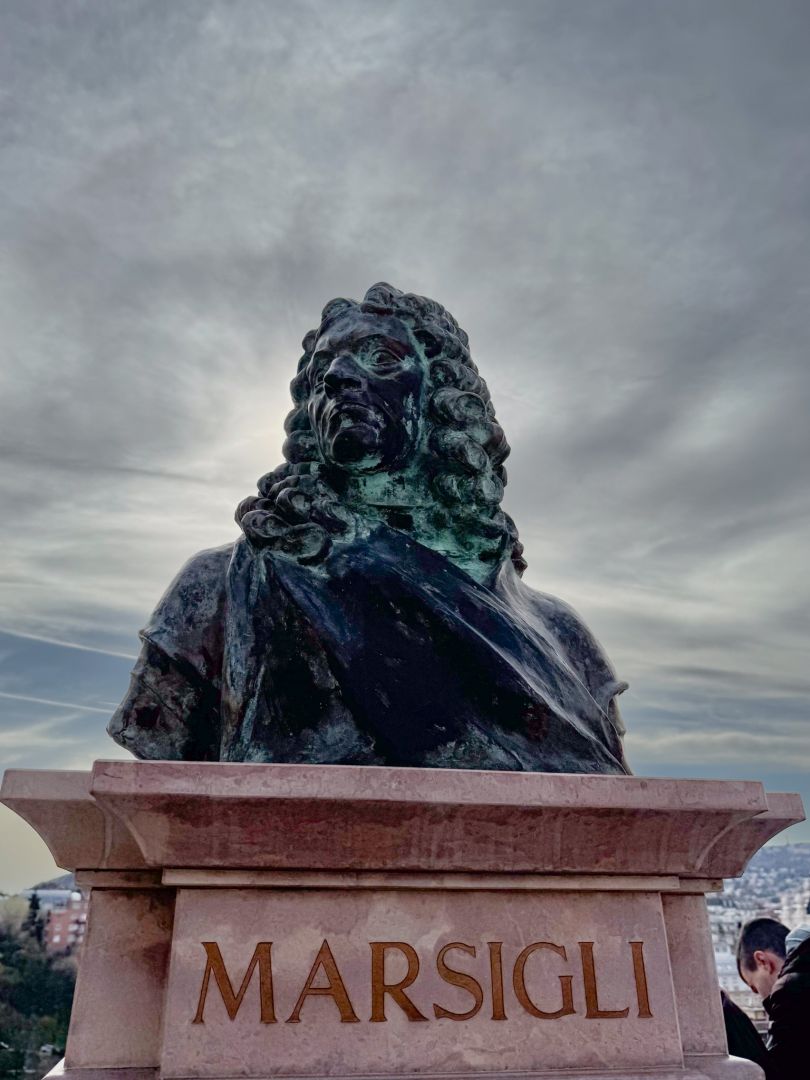
On either side of the upper Stöckl Steps, there stand two statues: one of Bonfini and the other of Marsigli.
The bust depicting Marsigli was originally erected in 1936. However, it appeared to have been destroyed during the siege in 1945. Several sources indicate that the archaeologist András Tasnádi Kubacska personally excavated it from the ruins and took it to the Hungarian National Museum.
The current statue is a replica commissioned by the Castle Administration.
84. Bee Garden
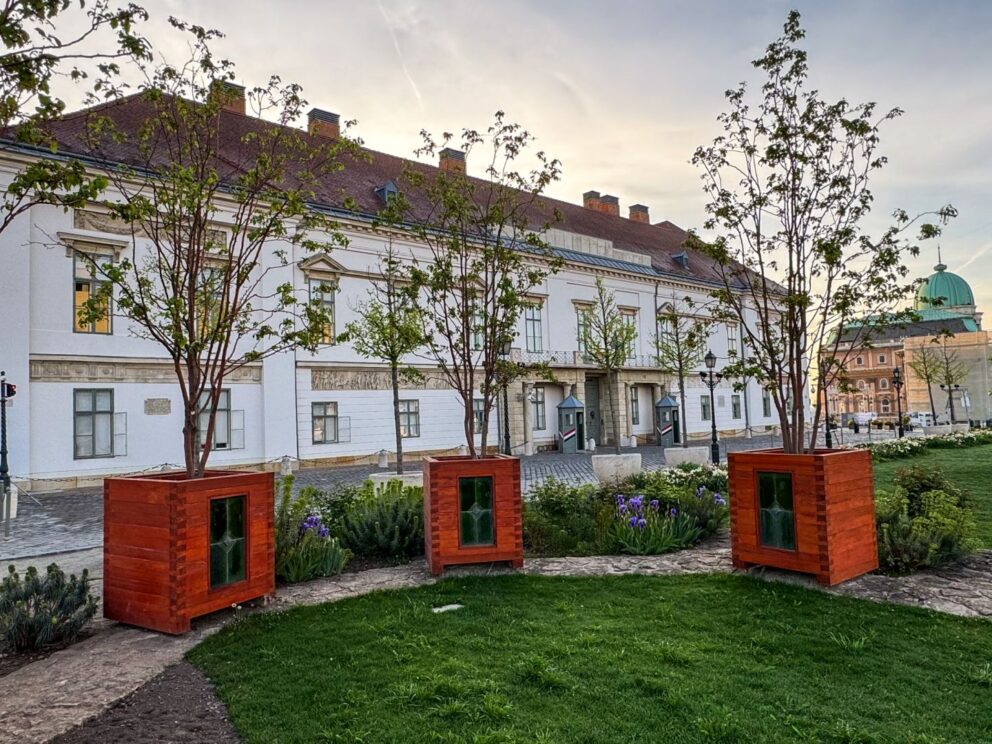
Across from the Sándor Palace, there’s a small garden adorned with huge wooden crates and trees, established in 2024. The unique feature of these crates is the dark green ceramics decorating their sides.
85. Hilton Hotel and Wooden Staircase in Buda Castle
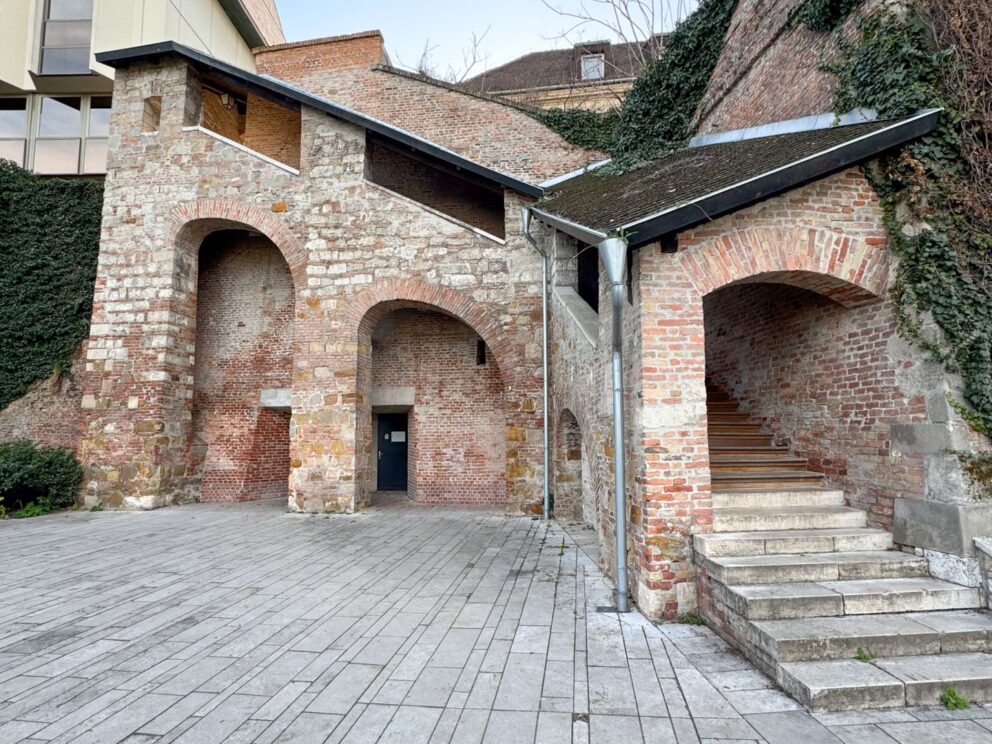
The Hilton Hotel in Buda Castle was built on the site of a Jesuit college damaged during World War II.
Many people dislike the hotel’s structure, arguing that its modern design does not fit with the historic style of the Buda Castle district.
During renovations, efforts were made to integrate the hotel better into its surroundings. A distinctive solution is the staircase running behind the hotel, which has itself become a tourist attraction. However, it raises the question of why it was necessary to build an electric lift next to the staircase. From Íscola Street, this staircase provides access to Buda Castle.
Few know that the hotel has a rear entrance, which includes a roundabout to accommodate arriving vehicles.
86. Musicology Institute
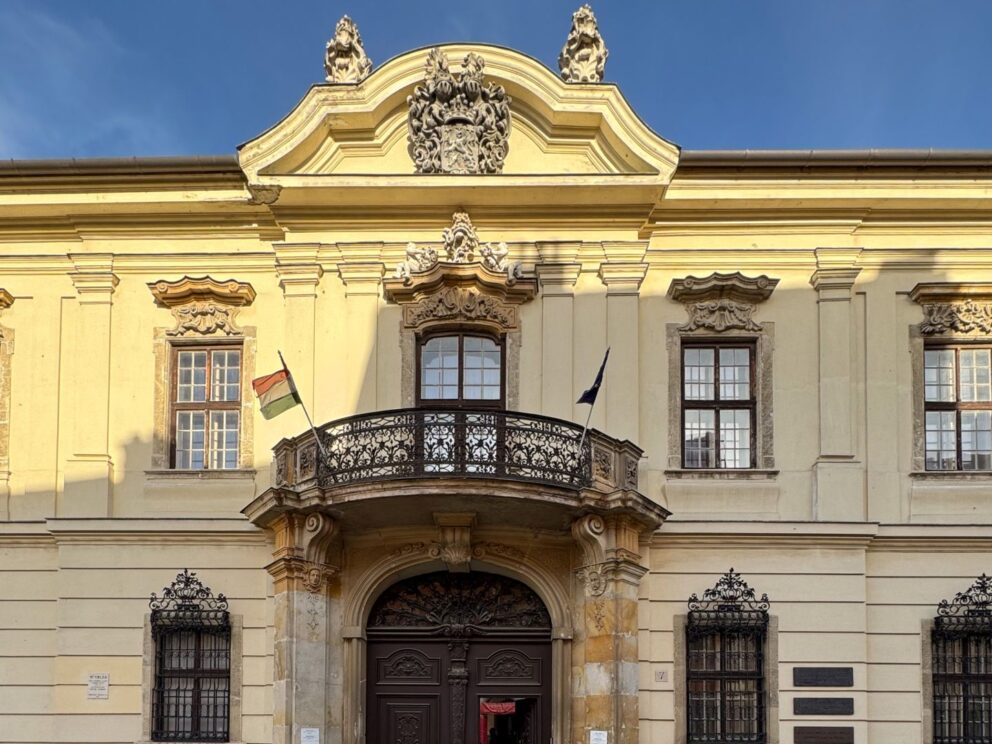
The baroque-style palace was built by Count György Erdődy, a judge and royal guard, which is why it is also known as the Erdődy Palace.
From 1800, the world-famous composer Ludwig van Beethoven frequently stayed here, maintaining a friendly relationship with the family.
In 1984, the Institute for Musicology of the Hungarian Academy of Sciences moved into the building, which now hosts numerous exhibitions and concerts.
87. Buda Castle Evangelical Church
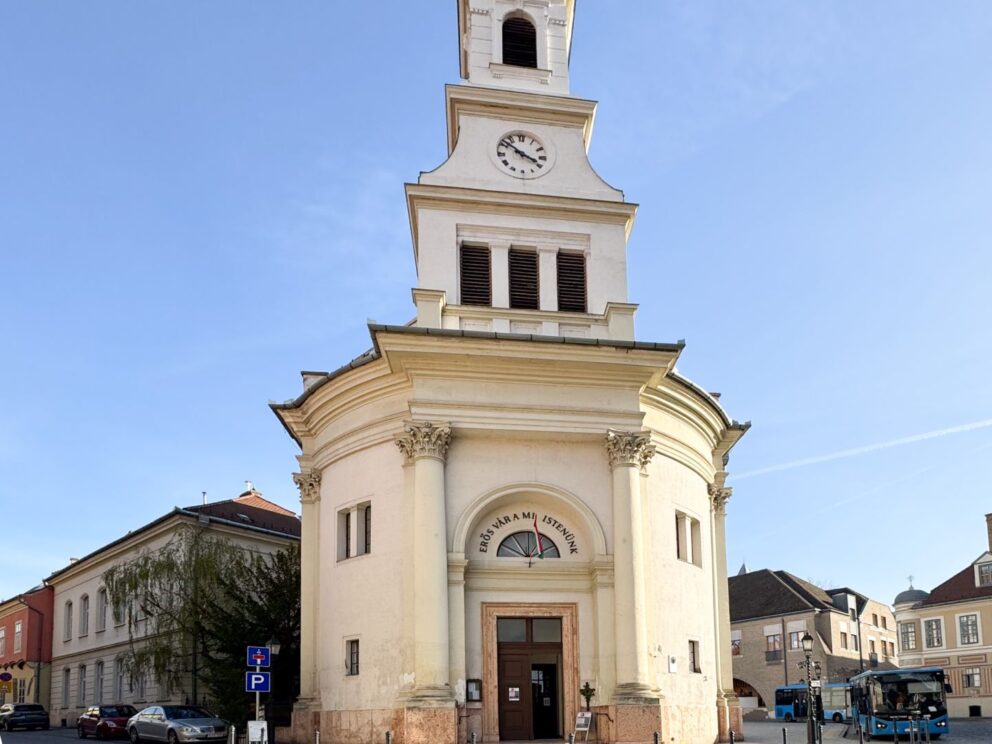
The largest Evangelical church on the Buda side, and within the Buda Castle District. It suffered serious damage during the siege of Budapest. Although the exterior was almost precisely restored to its original state, the interior was significantly simplified.
On the side of the church, there is a bronze plaque commemorating Gábor Sztehlo, an Evangelical pastor who saved 1600 persecuted children and 400 nurses during World War II.
88. Rushing Angel Statue
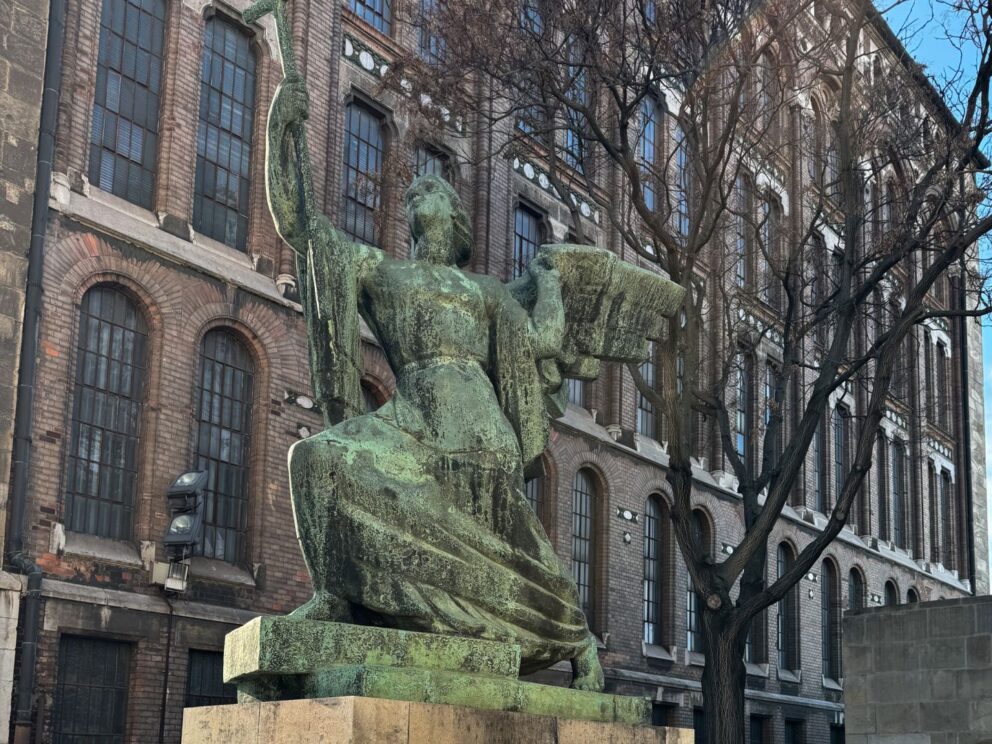
Located on the inner side of the Vienna Gate, this statue commemorates the liberation of Buda in 1686. It was created by Béla Ohmann in 1936 for the 250th anniversary of the recapture.
89. Chinese Cannons on the Walls of Buda Castle District
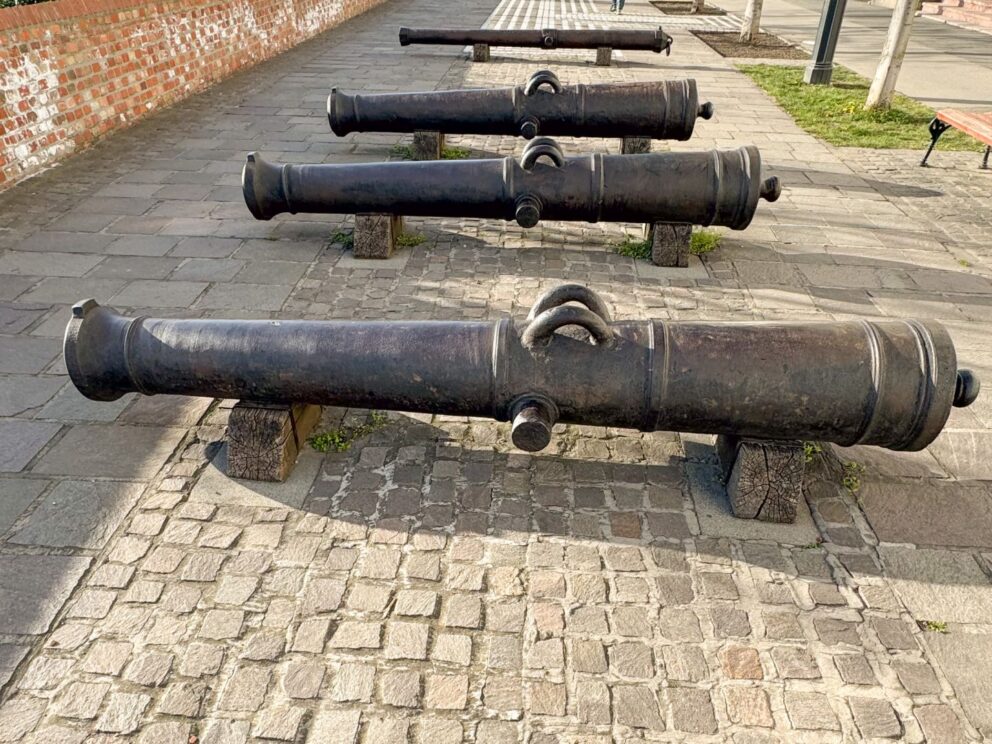
Originally, two Chinese cannons were displayed here in full splendor. The cannons were brought as war trophies by the Austro-Hungarian troops from China during the Boxer Rebellion in 1900. The Hungarian Military History Museum acquired them from Austria in 1926 under an international treaty.
90. Statue of Ferenc Koszorús
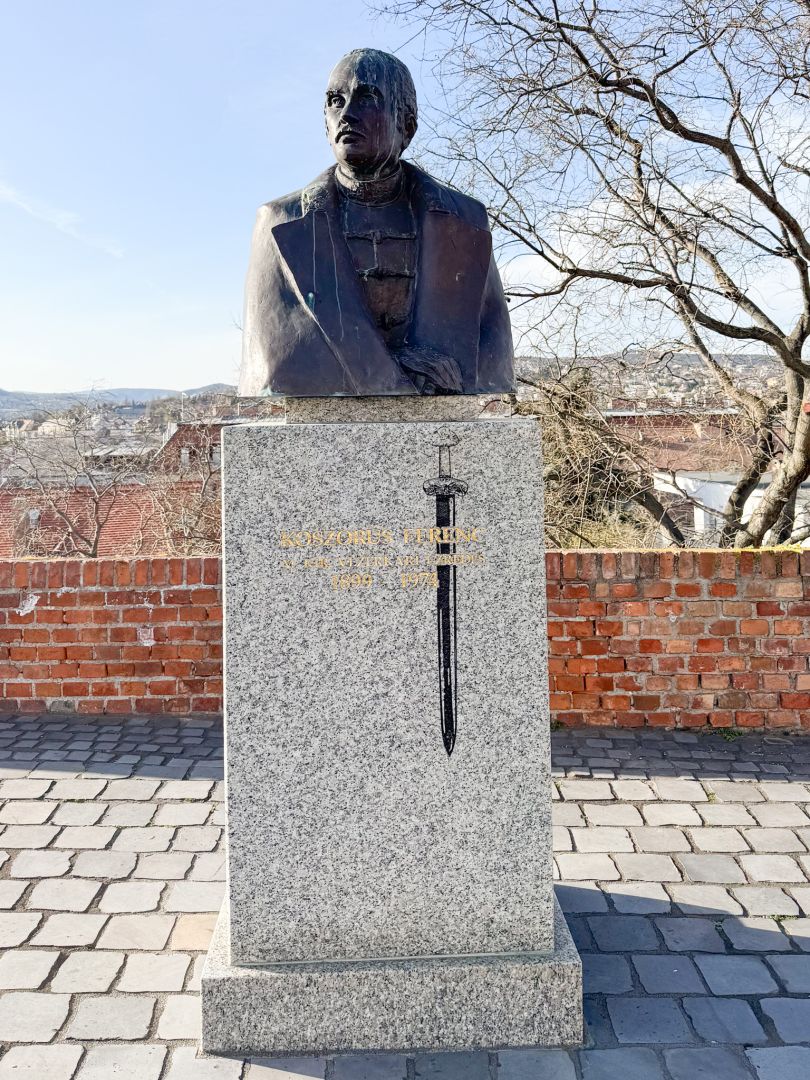
The bust of General Ferenc Koszorús stands on the Esztergom Rondella in the Buda Castle, commemorating the military officer who, as his most significant military action, thwarted the gendarmerie coup of 1944, thereby halting the deportation of the Jewish population of Budapest.
Buda Caste Quarter Maps
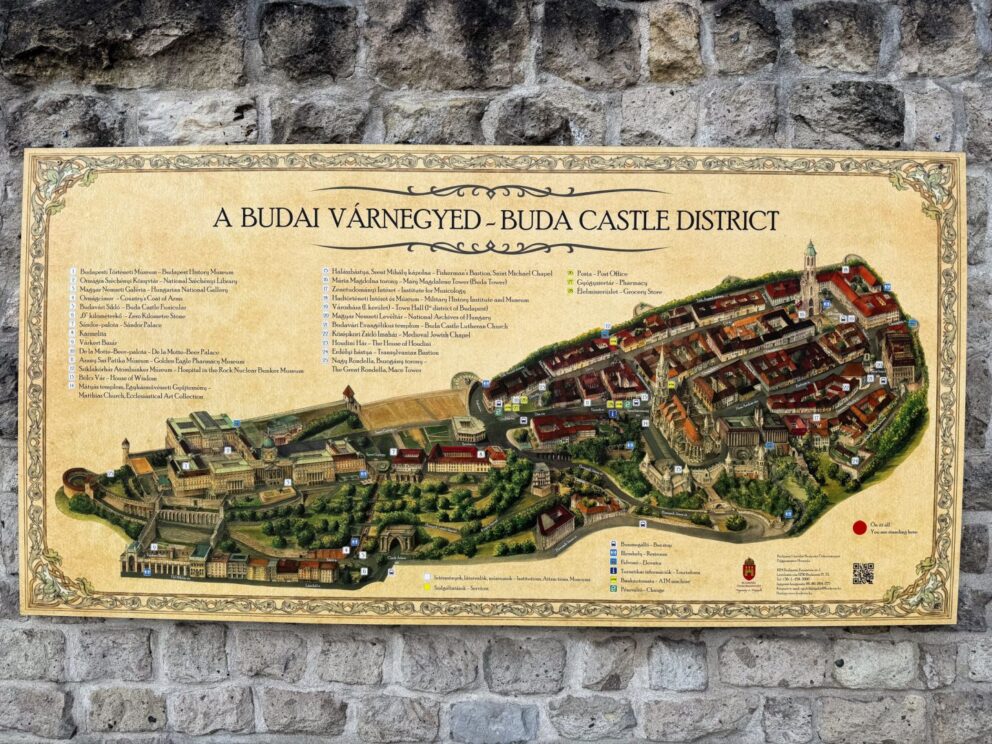
Table of content
Article meta data.
Airport transfer
Enjoy affordable luxury with our premium, airport transfer service..

Premium Car | From 35€

Premium Van | From 45€
Related Articles

Your ultimate itinerary to exploring Budapest in 1, 2 or 3 days

The 5 coolest boutique hotels in Budapest

MOL Bubi – Budapest’s very own bike sharing service

The real taste of Ireland: 3+1 Irish bar Budapest with traditional Irish atmosphere and drink in the heart of Budapest you must visit

Budapest hotels with history

Top 7 Shopping Malls in Budapest
Watch budapest live.
Where is Budapest ? What pleasures does this amazing city offer to the tourists? If you are interested, you should read our article on the topic. As everyone knows, who once visited Budapest, this is the city, which you will never forget in your life!
The Great Synagogue Budapest is definitely an unmissable attraction! Don’t miss it if you visit the Hungarian capital.
Your experience is important.
Anything you have not found, ask a question.
Please log in to write a review.
There is no review yet.

- Privacy Overview
- Strictly Necessary Cookies
- Analytics Cookies
- Advertisement Cookies
This website uses cookies so that we can provide you with the best user experience possible. Cookie information is stored in your browser and performs functions such as recognising you when you return to our website and helping our team to understand which sections of the website you find most interesting and useful.
Strictly Necessary Cookie should be enabled at all times so that we can save your preferences for cookie settings.
If you disable this cookie, we will not be able to save your preferences. This means that every time you visit this website you will need to enable or disable cookies again.
This website uses Google Analytics to collect anonymous information such as the number of visitors to the site, and the most popular pages.
Keeping this cookie enabled helps us to improve our website.
Please enable Strictly Necessary Cookies first so that we can save your preferences!
This website uses the following additional cookies:
(List the cookies that you are using on the website here.)

- Top Attractions
- Monuments and Tourist attractions
Buda Castle
The Buda Castle is without doubt one of the best known images of the capital . The castle is also known as the Royal Palace, as it was previously where the Hungarian kings lived.
Buda Castle is a remarkable castle and one of Budapest and Hungary’s most magnificent symbols , along with the Chain Bridge to which it is linked. Nowadays, Buda Castle houses the National Széchényi Library, the Budapest History Museum and the Hungarian National Gallery .
The imposing Buda Castle sits at the top of Castle Hill and offers an impressive panoramic view over Pest and the river. The views are very similar to those from Fisherman’s Bastion . And being connected to the Chain Bridge, the palace complex is breathtaking at night when the overpass and the Castle are lit up.
As well as visiting the Palace, we also recommend getting lost in the Castle Hill’s narrow streets and alleyways.
How to get to Buda Castle?
There are several ways of getting to this fascinating landmark:
- By foot: Steep stairs from the Chain Bridge , at Clark Adam Square.
- By foot: Walking up the hill on a path that starts at the Funicular.
- By Funicular: Take the Buda Hill Funicular up to the Castle . The ride up costs 4,000 Ft ( US$ 10.80) and is open from 8 am – 10 pm.
Take the Funicular up and walk back
If you don’t want to hike all the way to the top of Castle Hill, we recommend taking the Funicular up to the Royal Palace and then stroll back down , which is very enjoyable and doesn’t take long.
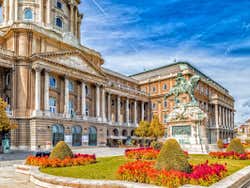
On the Castle Hill.
The museums open from 10 am – 6 pm, Tuesday-Sunday
The gardens and the surroundings of the Buda Castle are free. The museums have a separate entrance.
Buda Castle Free Tour 0
Funicular Budavári Sikló . Bus : Dísz tér , lines 16, 16A and 116.
Nearby places
Rudas Thermal Bath (370 m) Budapest History Museum (486 m) Budapest Citadella (559 m) Hungarian National Gallery in Budapest (603 m) Inner City Parish Church (645 m)
You may also be interested in
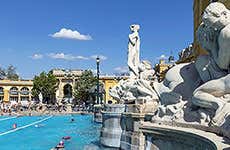
Széchenyi Thermal Bath
Széchenyi Thermal Bath is the largest natural hot spring spa in Europe, and this neo-gothic style bath was opened in 1913.
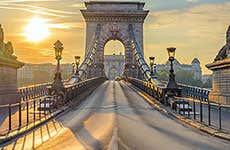
Chain Bridge
The Chain Bridge is the oldest suspension bridge in Budapest and is the Danube’s most renowned, connecting both sides of the city, Buda and Pest. The bridge’s real name is Széchenyi, in memory of the Count István Széchenyi, who helped build it, but is commonly known as the Chain Bridge.
Budapest.city
Your Essential Budapest Travel Guide
Buda Castle (Budai Vár)
Budapest Guide » Attractions » Buda Castle (Budai Vár)
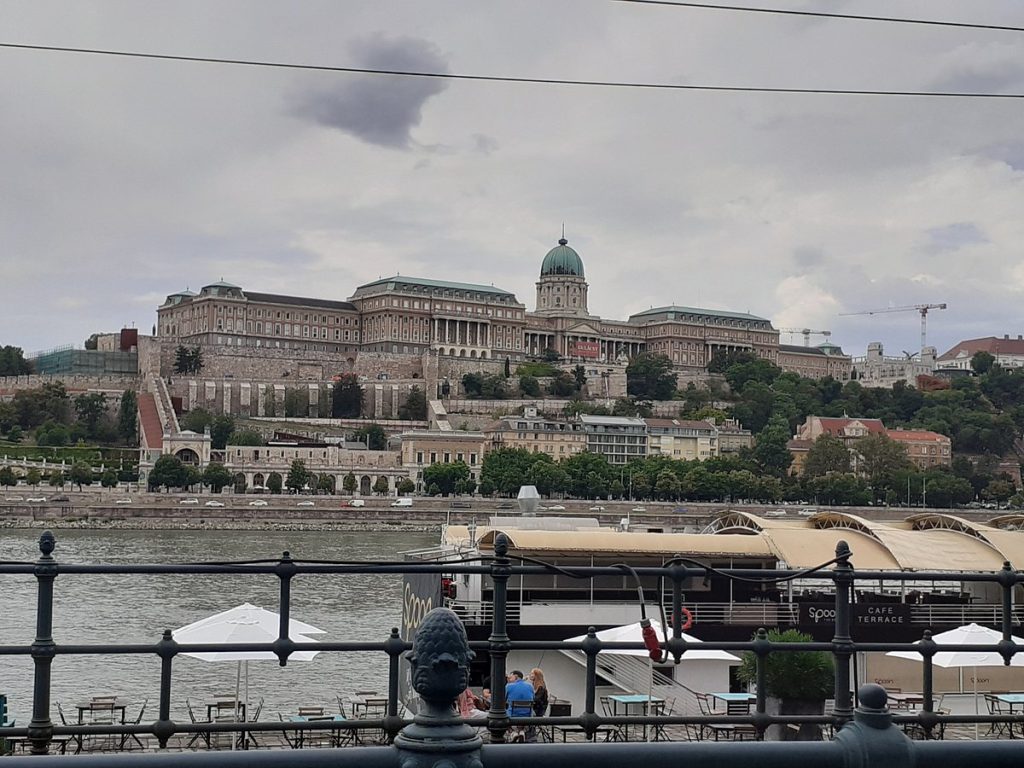
Buda Castle: A Timeless Emblem of Budapest’s History
Buda Castle, perched atop the illustrious Castle Hill in Budapest, is a monumental emblem of Hungary’s storied past. As a seasoned travel guide with a profound knowledge of Budapest’s historical landmarks, I invite you to embark on a journey through the corridors of time at Buda Castle, where every stone whispers tales of bygone eras.
A Fortress with a View
Buda Castle, dating back to the 13th century and rebuilt in the 1700s, is not just a castle; it’s a historical journey set against the picturesque backdrop of the Danube River. With its elegant Baroque architecture, the castle complex offers stunning panoramic views of Budapest, providing a visual narrative of the city’s evolution.
A Treasure Trove of Cultural Marvels
Some of the city’s most precious cultural gems lie within the walls of Buda Castle. The Hungarian National Gallery , housed within the castle, showcases a vast collection of Hungarian art. The Budapest History Museum delves into the city’s past, while the National Széchényi Library holds literary treasures. Each museum within the castle complex offers a unique perspective on Hungarian culture and history.
Exploring the Expansive Grounds
The castle’s grounds are as impressive as its interiors. Strolling through the expansive courtyards, visitors are enveloped in regal grandeur. The nearby Matthias Church and the iconic Fisherman’s Bastion , with its fairytale-like turrets, add to the enchanting experience, creating a perfect blend of history and architectural beauty.
Culinary Delights in a Regal Setting
Buda Castle is also home to several restaurants where visitors can indulge in culinary delights. Dining at the castle is not just about the food; it’s about savoring the flavors while soaking in the historical ambiance of one of Budapest’s most iconic landmarks.
Unveiling the Castle’s Secrets
Guided tours of Buda Castle offer an in-depth exploration of its history and secrets. These tours, available in various languages, provide fascinating insights into the castle’s past, including tales of sieges, royal residencies, and historical events shaping Budapest.
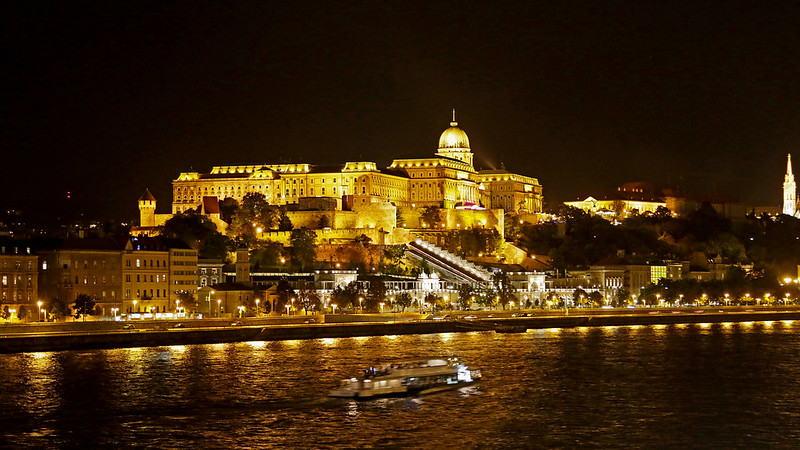
A Night Tour: Buda Castle Unveiled
For those seeking a unique experience, the night tours of Buda Castle are a must. These tours peel back the layers of the castle’s enigmatic past, offering a glimpse into its mysteries under the cloak of darkness, adding an intriguing dimension to the exploration.
Journey to the Castle
Reaching Buda Castle is an adventure in itself. Visitors can ascend Castle Hill via the historic Chain Bridge , enjoying a scenic walk. Alternatively, the Buda Castle Funicular offers a nostalgic ride to the top, though arriving early is advisable to avoid the crowds.
Buda Castle: A Living Emblem of Budapest
Buda Castle is more than a historical site; it’s a living, breathing part of Budapest’s cultural fabric. It stands as a testament to the resilience and richness of Hungarian history, inviting visitors to immerse themselves in a tapestry of stories that have shaped the nation.
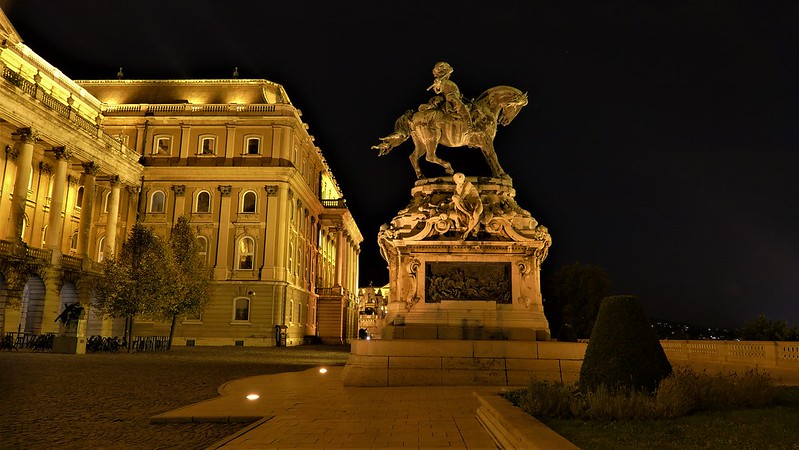
Did you know about the Buda Castle?
Buda Castle, perched on the picturesque Castle Hill overlooking the Danube River in Budapest, Hungary, is a historic landmark with a rich and complex history. Here are some significant facts about Buda Castle:
- Historical Evolution : The first version of Buda Castle, a fortress, was built in the 13th century after the Mongol invasion. Over the centuries, it has been destroyed and rebuilt several times, reflecting various architectural styles and historical periods.
- Royal Residence : The castle was the historical palace complex of the Hungarian kings in Budapest. It was significantly expanded and renovated in the 14th and 15th centuries during the reigns of King Louis I and King Sigismund. Later, during the 18th and 19th centuries, it symbolized Hungarian royalty and national identity.
- Destruction and Reconstruction : Buda Castle suffered extensive damage during World War II. Post-war reconstruction efforts aimed to restore it, although the work was not always historically accurate. The castle’s current appearance results from extensive restoration and reconstruction work that blended various historical architectural styles.
- UNESCO World Heritage Site : Along with the banks of the Danube, the castle district, including Buda Castle, is a UNESCO World Heritage Site recognized for its historical and cultural significance.
- Architectural Features : The castle is known for its eclectic mix of architectural styles, ranging from medieval and Baroque to neo-Baroque and neo-Renaissance. This diversity is a testament to its long and varied history.
- Current Uses and Attractions : Today, Buda Castle houses several cultural institutions, including the Hungarian National Gallery , the Budapest History Museum , and the National Széchényi Library. These institutions make the castle a center of Hungarian cultural life.
- The Castle District : The area around the castle, known as the Castle District , is a charming neighborhood with cobblestone streets, historic buildings, and beautiful views of the Danube. It is a favorite area for tourists and locals alike.
- Panoramic Views : Buda Castle’s terraces offer panoramic views of Budapest, including the Danube River, the Parliament building , and the Pest side of the city, making it a popular spot for sightseeing and photography.
- Cultural and Historical Significance : Beyond its architectural beauty, Buda Castle symbolizes Hungarian history, having witnessed many of the nation’s most pivotal moments. It embodies Budapest and Hungary’s cultural and political evolution over the centuries.
Buda Castle stands as a magnificent testament to Hungary’s rich history. It blends architectural grandeur with cultural depth, making it a must-visit landmark in Budapest.
In conclusion, a visit to Buda Castle is essential for anyone wishing to delve into the heart of Budapest’s history and culture. This majestic fortress, with its unparalleled views, rich museums, and captivating tours, offers a comprehensive experience of the city’s heritage. As you explore Buda Castle, you’re not just walking through a historical landmark but journeying through the chapters of Budapest’s vibrant past.

Buda Castle in Budapest
Nestled in the Castle Quarter ( Várnegyed in Hungarian), Buda Castle (formerly known as the Royal Palace or the Royal Castle) is high on the list of the most iconic monuments of Budapest!
Follow the guide!
💡 The Captain’s tip 💡
🧐 Want to know more about the history of Budapest? Captain Ulysses highly recommends this free guided tour of the city . It’s up to you to choose how much you wish to tip the tour guide!
💤 Are you looking for a hotel in Budapest? Be sure to check out the Captain’s article: Where to stay in Budapest? Advice & recommendations
🏛 Planning your trip to Budapest? Take a look the Captain’s detailed article on the best things to do: A Guide to Budapest
👶 Planning a family adventure to Budapest? Discover all of the Captain’s top tips in the article: Exploring Budapest with the Kids: Family-Friendly Activities .
Brief history of Buda Castle in Budapest
Construction of Buda Castle began in the 13 th century, during the reign of King Béla IV of Hungary. In the following century, King Sigismund of Luxembourg enlarged the palace and consolidated its fortifications.
In the 15 th century, King Matthias I st ordered the construction of a Renaissance palace adjacent to the already existing castle.
In the 16 th and 17 th centuries, Buda Castle was damaged on several occasions and almost completely destroyed during the wars with the Ottoman Empire and later the House of Habsburg.
The palace was entirely rebuilt in the Baroque style in the 18 th century, during the reign of Queen Maria Theresa of Austria, and briefly converted into a university before becoming the residence of the Palatines (the highest dignitary in the kingdom after the king).
During the Hungarian Revolution of 1848, Buda Castle was destroyed in a fire. It was subsequently rebuilt (again), this time in the neoclassical style.
But during World War II, Buda Castle was destroyed yet again. It was rebuilt in the 1960s, but the reconstruction is now highly criticized by specialists. New renovations are on the agenda to correct the mistakes made in the 1960s and restore Buda Castle to its former glory!

Visiting Buda Castle
Unfortunately, visitors are not allowed inside the castle. That being said, the castle is still worth taking a look at!
Here are the must-sees in and around Buda Castle !
👉 The Turul : this huge bronze statue represents a bird perched on the portal of Buda Castle, facing the Danube. In Hungarian mythology, the Turul is a mythical bird similar to an eagle or a falcon. According to legend, the Turul led the Magyar people (the ancestors of the Hungarians) to the Carpathian basin where they settled.

👉 The equestrian statue of Prince Eugene of Savoy : opposite the main entrance of Buda Castle, don’t miss the imposing statue of Prince Eugene of Savoy. He was one of the greatest generals of his time, famous for his remarkable feats in the war opposing the Ottoman Empire and the Austrian armies. Designed by Hungarian artist József Róna, the statue was originally commissioned by the city of Zenta, Serbia. As the town could not afford the price, the statue was bought by the city of Budapest.

👉 Matthias Fountain : located in the western courtyard of Buda Castle, this monumental neo-baroque fountain is the work of famous Hungarian sculptor Alajos Stróbl. The fountain represents a hunting party led by King Matthias I st , represented bow in hand, a dead deer at his feet.
👉 The Lion Gate : at the entrance of the Lions Court, two pairs of lions guard the immense portal. On the outer side of the gate, the lions seem calm and dignified while on the inner side, they look undoubtedly threatening.
👉 Széchenyi National Library : Buda Castle is home to the Széchenyi National Library, created in 1802 by Count Ferenc Széchényi who offered the Hungarian nation his own collection of rare and precious books. The library contains books who initially belonged to King Matthias I st in the 15 th century.
👉 Budapest History Museum : nestled in Buda Castle, the History Museum documents the history of the capital. But if you’re interested in finding out more about the country’s history, Captain Ulysses recommends visiting the Hungarian National Museum instead.
👉 The Hungarian National Gallery : unlike the Budapest History Museum, the Hungarian National Gallery (not to be confused with the Hungarian National Museum) is one of the most beautiful museums in the city. It is a must-see for art lovers! Find out more in Captain Ulysses’ detailed article: the Hungarian National Gallery .
Getting to Buda Castle
Located on the Castle Hill, a few steps from the Széchenyi Chain Bridge , Buda Castle is quite easily accessible. The closest public transports are:
- the funicular
- buses: Dísz tér stop (lines 16, 16A and 116)
Hop-on hop-off sightseeing buses also stop at Buda Castle. They’re very handy to navigate between the top sites and monuments in the capital. 👉 For more info, click here .
Buda Castle opening hours
The museums inside the palace are open every day of the week except on Mondays, from 10 a.m. to 6 p.m. (10 a.m. to 4 p.m. for the Budapest History Museum from November to February).
Guests can freely explore the exterior of the castle. If you wish, you can also join a free guided tour of the surroundings of Buda Castle to find out more about the rich history of the former royal palace.
👉 More info: Buda Castle Free Tour (choose how much you wish to tip the tour guide)
👉 Skip the lines: book your tickets and visits in advance!
👉 find the perfect place to stay in budapest, 👉 looking for tips and recommendations here are all of captain ulysses’ suggestions.
🛏️ Accommodation: Booking ($: Avenue Hostel | $$: Agape Apartments | $$$: Hotel Moments Budapest )
🎟️ Guided tours, cruises, skip-the-line tickets…: GetYourGuide , Tiqets and Civitatis
🎫 Citypass: The Budapest Card
🚐 Transfers: Airport transfer
🚌Transport in Budapest: Hop-on hop-off bus tour | a russian jeep | Trabant
✈️ Flights: Skyscanner
Credits Pixabay
How useful was this post?
Click on a star to rate it!
Average rating 4.5 / 5. Vote count: 2
No votes so far! Be the first to rate this post.
As you found this post useful...
Follow us on social media!
Related posts

Shakespeare’s Globe in London

Street Art In The 13th Arrondissement Of Paris

Where to eat in Bruges? The Captain’s top recommendations
Leave a reply cancel reply.
Your email address will not be published. Required fields are marked *
Save my name, email, and website in this browser for the next time I comment.
Privacy Overview

Guide to Buda Castle in Budapest
By: Author Swedish Nomad
Posted on Last updated: July 31, 2017
Categories Hungary
Home / Europe / Hungary / Guide to Buda Castle in Budapest

The Buda Castle is one of the city’s most famous sights, and are together with the castle hill listed on the UNESCO World Heritage Site since 1987. The castle is located on the Buda side, and there you’ll also find the Mathias Church and the Fishermen’s Bastion, where you can enjoy the best views of Budapest and the Parliament.
King Bela IV started to build the Buda Castle (Hungarian: Budavári Palóta) already in the 13th century and thus it has quite a long history to show. A cultural gem where you can learn more about Hungary, go to the National Library and National Gallery, watch the Guardians or just stroll around and soak up the historical atmosphere.
You can get here in several ways, either by bus, shuttle bus (if you have Budapest Card) or the well-known cable car.
Below, I’ve collected everything you might need or want to know before visiting the Buda Castle Hill.
How to get to the Buda Castle
Depending on where you start in Budapest, you may need to change the bus. But from Deak Ferenc ter, bus number 16 departs directly. The bus journey takes about 13 minutes and tickets should be bought in advance.
The road up to the castle is actually quite pleasant on foot. Old neighborhoods and terraces and not an all too steep hill. Perfect if you want some extra exercise at the same time.
Take the funicular up to the castle hill
If you go to the castle hill with children or if you just want to do something different, you can take the 101-meter long cable car that takes you up to Buda Castle. It departs in front of the Szechenyi bridge (chain bridge) and can not be missed. Be prepared to queue, as this is quite a popular way to reach the Castle Hill in Budapest.

Map of the Castle Hill
Below you can see a map of the Buda Castle, as well as nearby streets and sites.
Archery at the castle grounds
A fun activity in the courtyards of the castle. Here you can try shooting with a classic composite bow, which was used by the first Hungarians when they came from Central Asia to Europe. There is also a regular bow available, which might be easier to use for first-timers

History behind the Buda castle
The castle saw its first day already back in the 13th century when King Bela IV initiated the construction. But over the years it has been destroyed and rebuilt three times. In the 1400s, the castle was fortified and developed further on behalf of King Sigismund. He needed a majestic palace to show himself strong as ruler, and when finished he chose to have the Buda Castle as his residence.
After King Sigismund’s reign, Mattias Corvinus continued to build, but now in more Renaissance style. Today, however, there is hardly anything left from the Renaissance. In the 16th century during the Ottoman era, statues were seized and the sultan brought them to Constantinople. However, the palace remained unchanged until 1529, when the Ottomans destroyed the Buda castle greatly. During the Ottoman era, the castle started more or less decay since they used it as a storage facility.
The medieval castle was largely destroyed completely during the great siege in 1686. The oldest remaining parts date back to the 1300s, but the great Baroque palace, which today mostly characterizes the site, was built in the mid-18th century, from 1749 to 1769.
During the Middle Ages, it was said that Buda Castle was the largest gothic palace. At the castle heights, there are also a number of historical statues such as the Mattias fountain, the Turul statue (big bird from Hungarian mythology) and Prince’s Eugene on his horse. Inside the castle, some medieval rooms have been reconstructed, but these are not original since the interior was largely destroyed during World War II.
Buda Castle FAQ
- What’s the entrance fee to visit Castle Hill? Answer: It’s free to visit the courtyards and castle area.
- How much is the entrance fee to go inside the castle? Answer: 2000 forint for adults, 1000 for students/seniors. Free entrance with Budapest Card.
- How much does it cost with a guided tour? Answer : A group of 3-20 people costs 11000 forint.
- Is it suitable for children? Answer: Sure, I don’t see why not, it’s history and cool buildings.
Opening hours
- National Gallery : Tue-Sun 10 – 6pm (Closed on mondays, but open on most national holidays)
- Budapest History Museum : 1 Mars – 31 Oktober Tue – Sun 10 – 6, November 1 – Feb 29 Tue – Sun 10 – 4 (Closed on mondays, but open on most national holidays)
Have you also been to the Buda Castle? Or do you want to know more? Leave a comment below, and I will do my best to reply.

Sightseeing Tours

River Cruise Tours

Special Events

Spa & Relax

Cultural programs

Current weather

Exchange rates

Customer service

Ticket purchase FAQ

Useful Information about Budapest

To Do / Buda Castle
Blog search
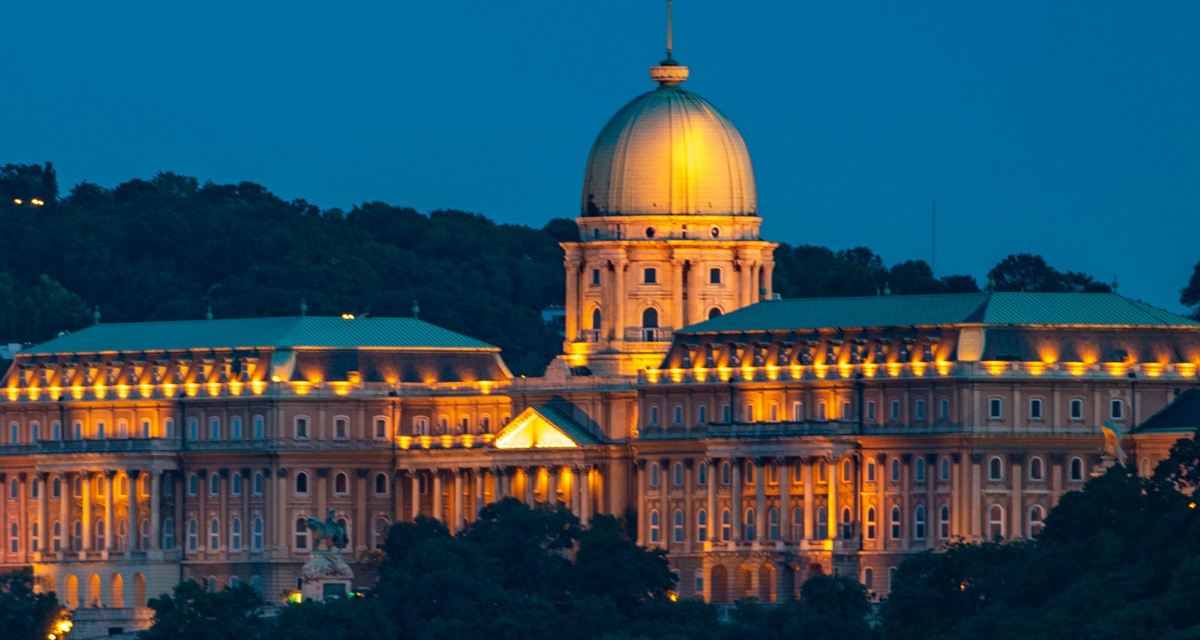
Buda Castle
Buda Castle – Unveiling Centuries of History and Splendor
Perched majestically atop the hills of Buda, overlooking the serpentine Danube River, Buda Castle stands as an indomitable sentinel to Budapest’s storied past and architectural grandeur. This iconic fortress, known interchangeably as Buda Castle or the Royal Palace, beckons travelers to embark on a captivating journey through time, promising a rich tapestry of history, culture, and awe-inspiring vistas.
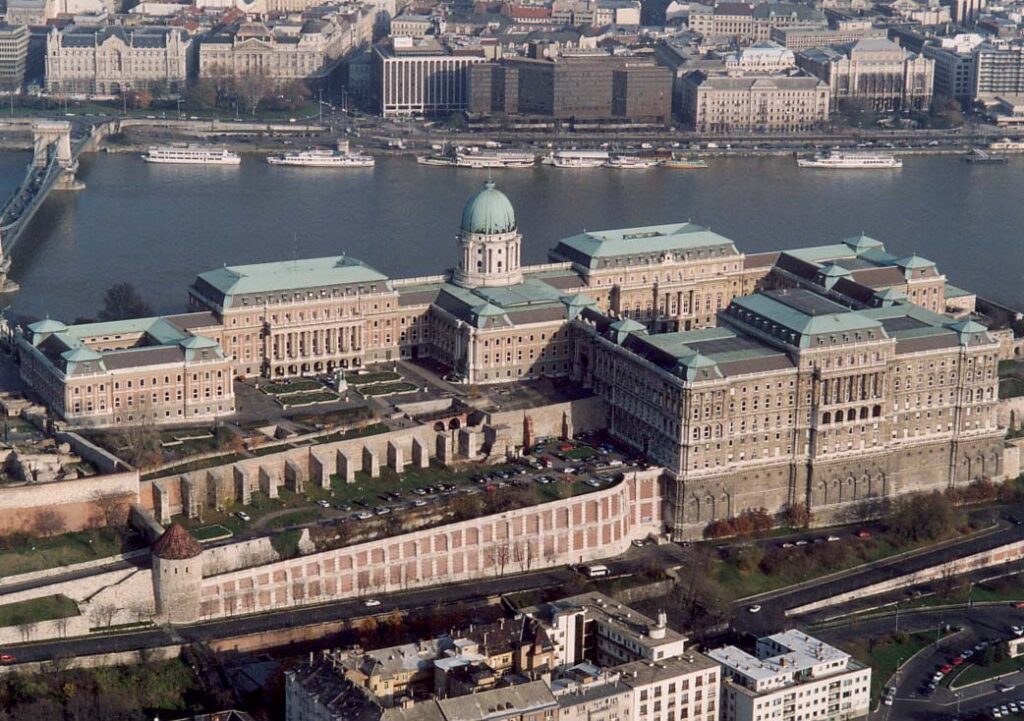
source– Offbeat Budapest
Buda Castle’s foundations trace back to the 13th century when it was erected as a formidable defensive stronghold. Over the centuries, the castle underwent a metamorphic evolution, bearing witness to the rise and fall of empires, and reflecting the ebb and flow of Budapest’s historical fortunes. From its medieval origins as a strategic fortress to its transformation into a Renaissance palace adorned with opulent details, Buda Castle encapsulates the architectural richness and resilience of the Hungarian capital.
To savor the full splendor of Buda Castle, consider planning your visit during the enchanting spring or autumn months. These seasons offer a mild climate and a kaleidoscope of colors that enhance the charm of the surroundings. The castle is easily accessible through various means, with buses and the historic Castle Hill Funicular providing both convenience and scenic views on the ascent. Alternatively, an unhurried stroll across the iconic Chain Bridge followed by a gradual climb up Castle Hill offers a leisurely and picturesque approach to this historical marvel.
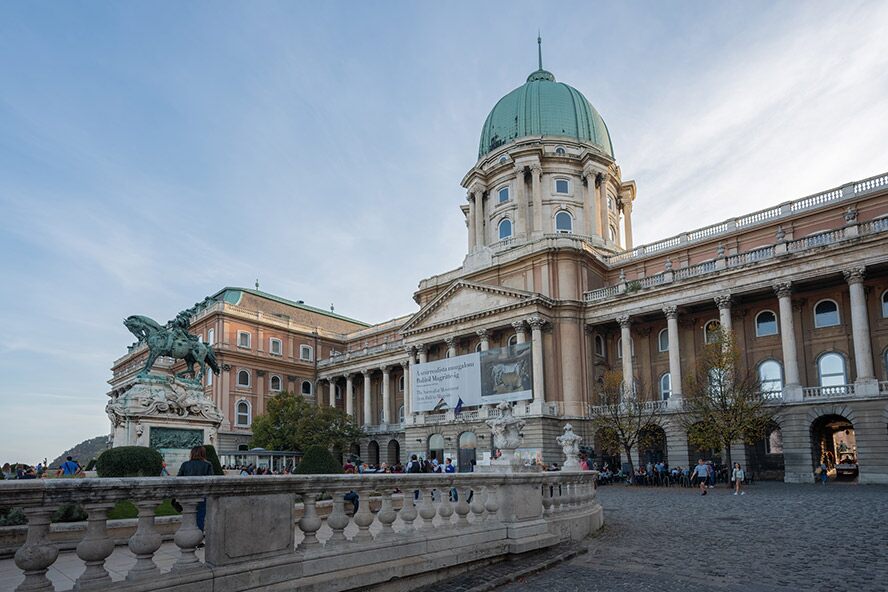
source- Barcelo
As you step through the gates of Buda Castle, a world of cultural treasures unfolds before you. The Budapest History Museum, housed within the castle walls, serves as a custodian of the city’s rich past, with exhibits spanning from medieval times to contemporary history. Meanwhile, art aficionados will find solace in the Hungarian National Gallery, a repository of Hungarian art that spans centuries and artistic movements. Beyond the walls of the museum, the castle itself reveals its opulence through grand courtyards and chambers, each echoing with the whispers of history. complex.
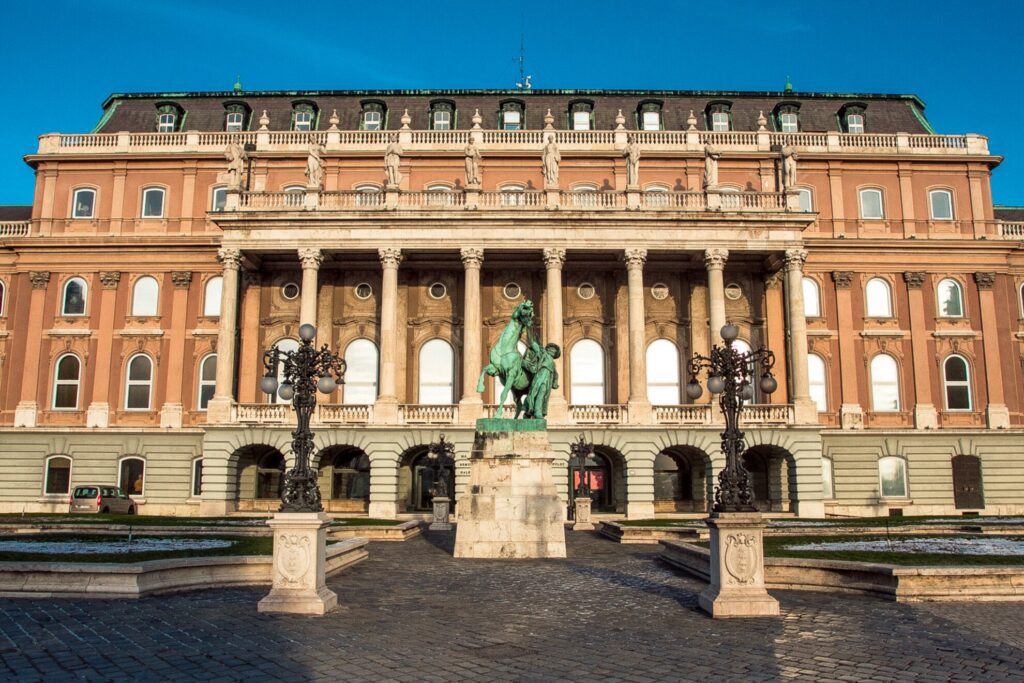
source- WeLoveBudapest
Among the myriad enchantments that Buda Castle offers, none rival the breathtaking panoramic view of Budapest and the meandering Danube River. The expansive terrace at the castle’s entrance provides a perfect vantage point, allowing visitors to immerse themselves in the arresting scenery. Whether visited during the day to appreciate the architectural details or at night to witness the city lights twinkling below, the view from Buda Castle is a sensory feast, etching unforgettable memories of Budapest’s charm.
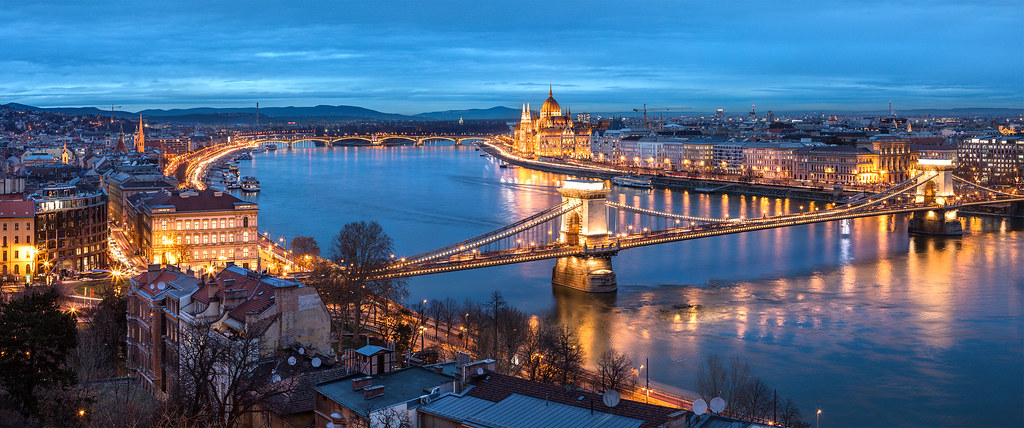
source- Flickr
Buda Castle transcends its role as a historical monument, standing as a living testament to Budapest’s endurance, cultural richness, and architectural prowess. From its medieval foundations to its present-day grandeur, the castle invites visitors to become part of its enduring narrative. As you plan your journey through the heart of Hungary, make Buda Castle a focal point of your itinerary, and discover an immersive experience that seamlessly blends the old-world charm with the vibrant pulse of modern Budapest. It’s not just a castle; it’s a journey through centuries, a testament to resilience, and a celebration of Hungary’s timeless heritage.
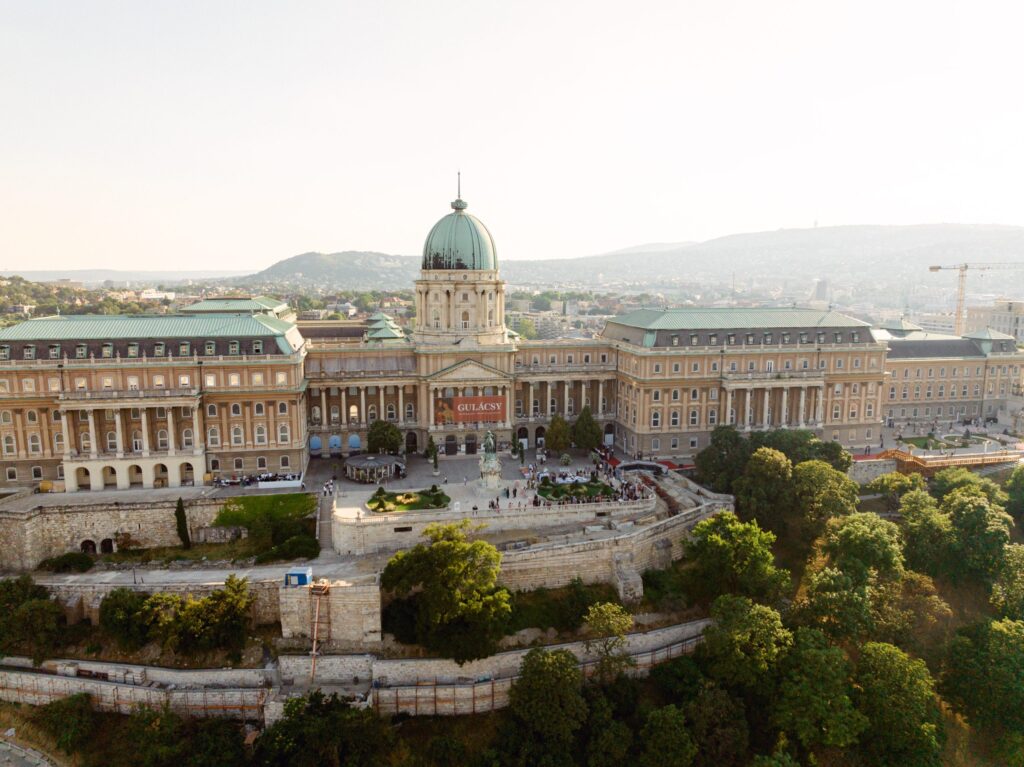
source- LHongToRtai
If you want to put programs to your todo list (favourites) please log in or register.
Forgotten password? Click here
No account? Create one here
Registration
I agree with the privacy policy
Privacy Overview

Buda Castle: Exploring the History and Beauty of Budapest’s Royal Palace
Buda Castle , also known as the Royal Palace, is a must-visit destination for anyone interested in history, architecture, and culture. Located on the Castle Hill in the Buda side of Budapest , the palace has played an important role in the city’s history and is now a UNESCO World Heritage Site.
Table of Contents
History of Buda Castle
Buda Castle was built in the 13th century as a fortress by the Hungarian King Bela IV. Over the centuries, it served as a residence for Hungarian kings and queens, and was expanded and renovated many times. In the 16th century, the castle was occupied by the Ottoman Empire, and was heavily damaged during the Siege of Buda. It was later rebuilt by the Habsburgs, who ruled Hungary until the end of World War I.
During the Communist era, Buda Castle was used as a government building, and many of its historic rooms and halls were converted into offices and meeting rooms. However, after the fall of communism, the palace was restored to its former glory, and is now open to the public as a museum and cultural center.
Exploring Buda Castle
Visitors to Buda Castle can explore its many rooms, halls, and galleries, which showcase the history and culture of Hungary. Highlights include the Hungarian National Gallery, which features a collection of Hungarian art from the 11th century to the present day, and the Budapest History Museum , which explores the history of the city from Roman times to the present.
One of the most impressive features of Buda Castle is the Royal Palace itself, which boasts stunning architecture and breathtaking views of the city. Visitors can explore the palace’s many rooms and halls, including the Royal Chapel, the Gothic Hall, and the Renaissance Hall.
Tips for Visiting Buda Castle
To make the most of your visit to Buda Castle, here are some helpful tips:
- Wear comfortable shoes , as there are many stairs and hills to climb.
- Consider taking a guided tour, which can provide insight into the history and culture of the palace.
- Visit early in the morning or late in the day to avoid the crowds.
- Bring a camera to capture the stunning views and architecture of the palace and the surrounding city.
- Plan to spend at least half a day at Buda Castle to fully explore its many rooms and galleries.
Share This Post Share on pinterest Share on facebook Share on twitter Share on linkedin Share on email Share on reddit Share on pocket
Disclosure: This website uses affiliate links. That means we may earn a small commission when you use the links on this site to book a hotel , book a tour , buy your travel insurance , shop for travel essentials, etc. You don’t pay anything extra. We’ve made an effort to ensure all information on this website is correct at the time of writing, but expect readers to double check before booking.
Read More About Buda Castle District

Introducing Buda Castle in Budapest
Buda Castle has played an important role in Hungarian life for close to 1000 years.
The fortress atop Budapest’s Castle Hill , and the corresponding Buda settlement along the banks of the Danube, date back to the mid-1200s. The Castle was originally completed in 1265. It underwent drastic changes in the 14th and 15th centuries, right up to Ottoman occupation of Hungary in 1541. During the siege to liberate Buda from the Turks in 1686, the castle and area were heavily damaged.
The palace wasn’t rebuilt immediately. Reconstruction started in the mid-1700s and continued under the reign of Maria Theresa. During the 1800s, it again sustained heavy damage during the Revolution of 1848 and Siege of 1849.
The 20th century was also unkind to the Castle.
Buda Castle in WWII
Buda Castle was heavily damaged during the last months of WWII, taking heavy bombing from January 1945 onward during a 48-day siege. The entire Castle District took heavy damage, but the Castle itself was worst hit. The building was burnt, the dome and roof collapsed, and the walls of the southern wing collapsed.
Most of what you can see today is a reconstruction by the Communist government. The palace was rebuilt starting in 1948. The reconstruction is a simplified version of what it used to be, as the communists weren’t too enthusiastic to rebuild a symbol of imperial power.
One fascinating piece of history from this time relates to the castle’s roll in protecting Hungarians from Allied bombs. A bomb shelter was made out of the natural cave system under the castle, and up to 10,000 people would crowd into the shelter each night!
Book Your Trip to Budapest
Save money in budapest.
The Budapest Card includes free, unlimited public transportation for the duration of the card, and is available as a 1, 2, 3, 4, or 5-day card. In addition to free public transport, the card includes free entry to many museums, a complimentary tour, discounts throughout the city, and more. Click for prices and details.
Book Your Flight to Budapest
CheapOair is our current favorite when it comes to searching for flight deals . It’s a meta aggregator, and will find the best deals and routes for you by searching airline websites and other aggregators.
Book Your Budapest Hotel in Advance
We use Booking.com when making hotel reservations in Europe. In our experience, it has the best inventory/selection of hotels and holiday apartments, and we’ve had good experiences with their customer service team when things go wrong (which has been a rarity for us, thank goodness!). TripAdvisor is also trying to get into the hotel booking game, and may be worth checking out.
Skip the Line in Budapest
Budapest is getting busier by the year, meaning you should expect to wait in line at the most popular attractions, especially in high season. If you only have a short vacation, consider getting a Skip-the-Line ticket for the most popular attractions: The Great Synagogue , Széchenyi Thermal Baths , and the Parliament. If you want to visit the interior of the Parliament, you have to pre-book. You can either use an international tour aggregator like Get Your Guide or use the Hungarian website Jegymester.hu .
Book Your Budapest Tour
We tend to book tours via an aggregator like Get Your Guide (a company out of Berlin with great selection of tours in Europe, in particular) or Viator (a TripAdvisor company).
Why use an aggregator instead of going direct? Personally, we like to compare the different tours available for each attraction, as well as read reviews. Both Get Your Guide and Viator let us see multiple, similar tours, and compare prices and past reviews before making a booking.
Getting from Budapest Airport to the City Center
Budapest’s public transportation system is generally excellent, and this extends to the airport. For a detailed post about getting from Budapest Airport to the City Center via public transit, shared shuttle, or airport taxi, read our guide here .
If you’re arriving late at night, coming in on a long-haul and expect to be exhausted, or would rather have the peace of mind of a private transfer, you can book one here.
Buy Travel Insurance (Just in Case)
We can’t actually recommend a travel insurance provider. Apparently it’s against the law.
However, we can say this: we know several people who racked up hundreds of thousands of dollars in medical expenses during separate, life-or-death situations while traveling. They were both insured by Allianz , they both received life-saving care, and they both made a successful claim.
No one wants to need travel insurance, but you’ll certainly be glad you have it if something goes wrong. And if something does go wrong in Budapest, we personally go to FirstMed for our healthcare. Staff and doctors speak English.
Make Restaurant Reservations in Advance
If you visit Budapest in winter, you’ll probably be okay if you don’t make restaurant reservations, although we’d still recommend you reserve in advance Thursday to Saturday evenings where possible.
In summer, things fill up pretty quickly, although capacity at many restaurants increases when the city’s terraces open, usually sometime in May. It’s worth noting Budapest’s restaurants are all non-smoking inside, but get quite smoky on the terraces.
Attractions Within Buda Castle
The palace complex is vast, with different complexes and attractions within. There is a historic fort, once the headquarters of Hungarian kings. The National Gallery, Budapest History Museum, and Military Museum are also here. Not to mention the lovely Castle grounds and Castle gardens and Bazar, worth a visit in their own right.
History buffs and those looking to gain an intellectual footing in Hungarian history and culture will appreciate Buda Castle’s galleries and museums.
Casual tourists will be just as delighted, as it’s a beautiful part of the city, and lovely for a wander. If you’re wondering where to stay in Budapest , the Castle District is a great option for a tranquil holiday away from the hustle of Pest.
The National Gallery
Hungary’s National Gallery specializes in Hungarian art. There are some international pieces in the collection, but it’s mostly interesting for seeing Hungarian work.
The collection covers Hungary’s history from the Magyar’s late-9th and early-10th-century settlement of the Carpathian basin to contemporary Hungary. Works cover diverse topics, from daily life, religion in Hungary, and landscapes.
Spread across several wings of Buda Castle, the Gallery also has a dome terrace. If you’re looking for a spectacular view of beautiful Budapest and the Danube, this is a great spot to get it!
The National Gallery is open Tuesday to Sunday from 10:00 to 18:00, unless otherwise specified. In 2019, the National Gallery will be closed April 23, June 11, December 24, and December 25.
Adult tickets to the permanent exhibition cost 1,800 HUF. EEA citizens under 26 or over 62 get a 50% discount, or 900 HUF.
On national holidays, admission to the National Gallery is free. These include 15 March, 20 August, and 23 October.
Budapest History Museum
Whereas the National Gallery mostly tells the story of Hungary at large, Budapest History Museum tells the story of its capital.
Budapest History Museum shares a rough history of Budapest, a story that unfolds over 2000 years. Photos, clothing, tools, furniture, seals, coats of arms, and other artifacts show how life in Budapest has evolved over the years, both for regular people and aristocrats.
The History Museum is open Tuesday to Sunday from 10:00 to 18:00 during high season. From November 1 to February 29, it has shortened hours, from 10:00 to 16:00.
Adult tickets are 2400 HUF during peak season, and 2000 HUF in off season. Youth tickets (aged 6 to 26) and senior tickets (aged 65 to 70) are discounted. Visitors over 70 are free.
Admission is free with the Budapest Card.
Museum of Military History (Hadtorteneti Muzeum)
The collection at the Military Museum covers medieval to modern Hungarian military history. It’s packed with history and artifacts, and is a fantastic stop for those who love history, and military history in particular.
The building itself was originally an army barracks in the 1800s. In 1920, it was established as the museum. During WWII, both the building and museum’s contents sustained heavy damage, and much was lost.
For the majority of visitors, the popular exhibits include:
- Hungary’s Failed War of Independence from 1848 to 1849
- Miklos Horthy and the Hungarian Royal Army from 1918 to 1943
- The 1956 Hungarian Revolution
Generally, speaking, the museum gives a snapshot of modern Hungarian history, in particular. Visitors will get an idea of what most important events were, and their impact.
The Museum is open Tuesday to Sunday from 09:00 to 17:00. Tickets are 1,500 HUF per adult. Family tickets are 3,000 HUF, but this probably isn’t a great museum for anyone younger than a teenager.
National Széchenyi Library
The National Széchenyi Library is also on Buda Castle Grounds. It’s not a lending library, but you can visit on a day pass for 1200 HUF. This entitles you to visit the general collection only.
Generally speaking, this isn’t a tourist attraction that’s going to appeal to most people. That said, it is possible to visit if you have a specific interest in Hungarian books.
How to Get to Buda Castle
By bus from deák ferenc tér or széll kálmán tér.
From Deák Ferenc tér, you can take Bus 16, with the bus running every 5 minutes or so during peak hours.
You can either get off the bus at Clark Ádám tér, and then take the funicular (which costs extra), or continue by bus up to Dísz tér in the Castle District.
If you’re starting at Széll Kálmán tér, you can also take Bus 16 to Dísz tér.
Getting around Budapest is generally quite easy by public transit. For more info about ticket prices, consult our guide. You can also check out bkk.hu , which is the transit authority’s website. They have an English option, and you can use the trip planner function to get an idea about timing and route options.
From Clark Ádám Tér via the Buda Castle Hill Funicular
From Clark Ádám tér, at the foot of the Chain Bridge , you can take the funicular to Buda Castle.
The funicular ride costs 1,200 HUF for a one-way ride, and 1,800 HUF for a return trip. The ride is free for children three years old and below.
For more details, read our Buda Castle Hill Funicular guide.
Festivals and Special Events at Buda Castle
Beyond day-to-day visiting, Buda Castle has a few great events throughout the year. If you find yourself in Budapest at the right time, be sure to check them out!
Budapest Wine Festival at Buda Castle
This is my personal favorite as it’s a great way to get to know Hungary’s somewhat befuddling array of wines. Hungary has 22 distinct wine regions, making it a true challenge to get to know the different flavours. Add to that, Hungarian wine generally isn’t available abroad, as production is tied to domestic demand.
The Budapest Wine Festival takes place each September. Each year, there’s a guest wine region, but there’s always a massive focus on Hungarian varietals. There are also events at the festival, such as mini concerts, and food as well.
A one-day ticket costs 2,500 HUF, while the four-day ticket is 4,500 HUF. Tickets come with a wine glass and a canvas “wine necklace” (my term), which lets you hold your wine glass in a pouch around your neck. You also need to pay for the wines you taste, but they’re always quite affordable.
In 2019, the festival takes place September 5 to 8.
Buda Castle Beer Festival
The Beer Castle takes place at the end of August, a few weeks before the wine festival. As with the wine festival, there’s a focus on locally-made. Hungary’s craft beer scene isn’t nearly as developed as some other countries’, but it is changing at a lightning speed. Breweries are popping up at an astounding rate here, and Budapests’ selection of craft beer bars gets bigger each month, it seems. If you want to try craft beer in Budapest, check out the 7th District and the 9th District . Budapest’s 7th District is the Budapest nightlife district , but the 9th was the leader in the city’s craft beer scene!
In 2018, the festival took place August 23 to 26. 2019 dates have yet to be announced. As with the Wine Fest, there are shows and concerts to add to the fun.
Tickets range from 1490 HUF (early bird) to 2499 HUF (day-of).
Buda Castle Craft and Folk Art Festival
Another summer event at Buda Castle, the Festival of Crafts takes place from August 17 to 20 in 2019.
The craft festival is all about shopping and eating – you can get locally made products, many of which are traditional folk crafts.
The last day of the festival takes place on St. Stephen’s Day, which is an important national holiday. There are fireworks in the evening, and they’re often quite spectacular. The past 2 years, they’ve been over the Hungarian parliament building!
The craft fest costs 2,500 HUF, with discounts available for families, senior citizens, and students.
Share this post
Share on pinterest Share on facebook Share on twitter Share on linkedin Share on email Share on reddit Share on pocket
Read Our Recent Posts

Visiting Budapest in February
April 7, 2019 No Comments
A comprehensive guide to visiting Budapest in February. Includes Budapest in February weather, things to do in Budapest in February, and what to pack for Budapest in February.

Best Travel Deals for Budapest
April 6, 2019 No Comments
A curated list of current travel deals available to our readers! Updated weekly.

Visiting Budapest in January
A complete survival guide to visiting Budapest in January. Includes Budapest in January weather, things to do in Budapest in January, and what to pack for Budapest in January.

A Local’s Guide to Winter in Budapest: What to Do, Eat, See & Pack for the Perfect Trip
April 4, 2019 No Comments
Thinking About Visiting Budapest in Winter? You’re Not Crazy…! This Guide Shares our Best Tips (as Locals Living in Budapest) for Maximizing Your Winter Vacation in Budapest.
Read More → Must Read
Travel Insurance for Europe
March 31, 2019 No Comments
Disclosure: This website uses affiliate links. That means we may earn a small commission when you use the links on this site to book a hotel, book a …

Vörösmarty Square Budapest
A beautiful square in the heart of downtown Budapest, Vörösmarty Square is a popular meeting spot in Budapest city centre and a convenient area of Budapest to stay.
Read More →
Privacy Overview
Buda Castle Buda Castle, Budapest
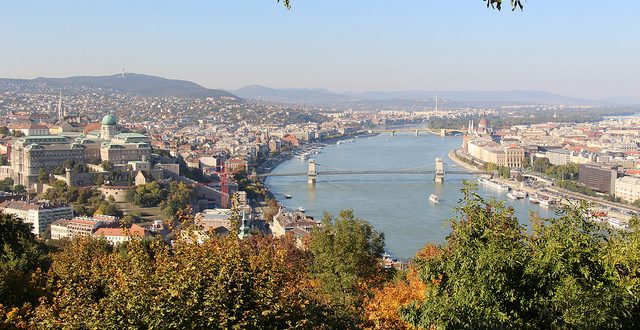
Getting There
The Buda Castle is located on top of the Castle Hill on the Buda side of the river Danube. Despite the elevated location, it is very easily accessible on foot, or by public transport.
How can I get to Buda Castle Budapest?
Walking up to buda castle.
There are several ways to reach the Buda Castle on foot. Below, we show you two different routes to choose from:
Gentle Hill Walk
Steep hill walk.
If you prefer to discover the Castle District on foot, why not try one of the Buda Castle Walking Tours ?
For even easier access, there are some elevators around the Buda Castle Hill.
Click here to see the locations of the elevators with GPS coordinates
Bus route up to buda castle.
You can also access the Buda Castle by public transportation. Please find the bus services below:
From Pest Side (City Center)
From Buda Side
Fun ways of getting up to the Castle Hill
Funicular / Cable Car You can reach the top of the Hill and get directly to the Royal Palace, using the Funicular . It starts from next to the Tunnel at Clark Adam Square. Please note that usually there are queues built up for the Funicular, with possible waiting time of 30 minutes.


Related Articles
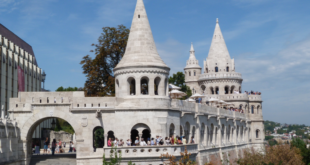
Senior Discounts in Buda Castle Attractions
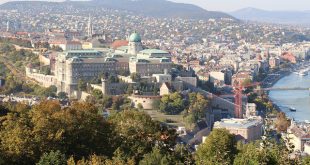
Budapest Card Office in Buda Castle
Tourist bus parking in the buda castle, 137 comments.
Hello, We are two journalists from Poland. From Monday 25 July to Friday 29 July we will be in Budapest. We would like to describe the most interesting places of Budapest, and at least part of them because there are so many. Whether they would be possible to free entrance for two people these days to your interiors? Please reply to email feedback. Regards, Artur Rakowski
Dear Artur, thank you for your inquiry. Unfortunately we cannot offer free entries for media representatives. In case you wish to visit more places and attractions in Budapest, please let me recommend you to buy a Budapest Card, which entitles you to have several discounts, and also it provides free entry to the National Gallery and to the History Museum. Buying Budapest Card: http://budapestcards.com/
Hi, I am planning to visit Budapest. I want to do Castle Tour & Funicular & Cruise but the only problem is that I can not pay in euros as my bank account is in sterling pounds. Is there any other way of booking this guided tour with you?
Hello Sibgha, this is not a problem at all, as payments are made via Paypal, and Paypal will convert the amount.
Hi, I would like to ask if there will be a craft festival on the castle in between August 17-20, 2019.
Hi team, I am trying for they Buda Castle & Matthias Church Tour on 11-sep. We are 2 aduly and i child. There is no option to book in that combination. Could you suggest how can i book for 2 adult and i child
Hi Krishna, thank you for your comment, you were absolutely right. I have now added the option to book adults and children together. You can make your booking now on the following page: https://budacastlebudapest.com/buda-castle-matthias-church-tour/
Hi, Will it be possible to reach Buda Castle by bus and come DOWN using Funicular (one way)
Hello Saroj, Funicular tickets are sold for 2 ways (up and down). If you wish to use it for a single way only you can use the other way for a year from the purchase date.
Hello , how much it costs to enter the buda castle. i will be in budapest october 9 till october 15. and please tell me if i can buy ticket on the spot.thank you
Hello Elie, Currently the Royal Palace (aka the Buda Castle) is the home of the National Gallery and the Budapest History Museum, therefore, the entry fee of the buildings of the Buda Castle is identical with the entry fees of the Gallery and the Museum. Yes, you can buy the tickets on the spot. National Gallery: Full price: HUF 1,800 per Adult Discount price: HUF 900 per Student / Senior Citizen Or FREE entry with Budapest Card ( http://budapestcards.com/ )
History Museum: ow / High Season prices Adults: 1800 / 2000 HUF Visitors aged 6-26: 900/ 1000 HUF Visitors aged 62-70: 900/ 1000 HUF Or FREE entry with Budapest Card ( http://budapestcards.com/ )
Hello there. I would like to know does Budapest Castle and its museums accept the ICOM card please?
Dear Kenneth, I would like to confirm that the entry is free for ICOM card holders in the National Gallery and the History Museum as well.
Hi I was trying to book adult and child tickets for Castle tour, Funicular and Cruise for 10th september and it was not allowing me too. Is there anywhere else I can buy tickets from
Dear Pankaj, Unfortunately advance booking is required to be able to participate in the tour. The tour can be booked min. 3 days in advance. Thank you for your understanding.
Hi, i will go in budapest in christmas time. I would like know if castle is open from 25-26 december. Thank you
Dear Tatiana, The courts, courtyards of the Buda Castle are open day and night, 24/7. The Christmas Opening hours of the 2 institutes inside the Royal Palace are the following: National Gallery: Dec 25: closed Dec 26: 10am – 6pm
Budapest History Museum: Dec 25: 10am – 6pm Dec 26: closed
Interested in the short white wine tasting on December 5, 2016. Can we do any later than 2:00pm? Would preferably want something around 4 or 6:00pm. Would like confirmation before booking. Thanks very much.
Dear Alexandria, unfortunately online booked wine tastings have a fix starting time at 2 pm. Thank you for your understanding.
Dear Buda castle tours,
I wanted to know if the budget buda castle tour includes a visit in the gallery and museum inside the castle.
Thank you beforehand,
Hello Natali, the budget tour does not include a visit inside the Gallery or the Museum, however, the cheapest way to get inside the Buda Castle is to buy a ticket on the spot after the tour. Alternatively, you can save on the entrance fees, if you buy a 24h Budapest Card, which includes the Budget Tour, and both entries for €17 (this price is until 2017 spring). Hope this helps to save on the tour / entry fees.
We (2 pax) will be in Budapest for a day tomorrow (19/12/2016) and departing early on 20/12/2016.
We would like to check if we can make it in time for the Buda Castle Wine Tasting at such short notice on 19/12/2016 afternoon.
Sincerely hope to make it for the tour and appreciate your fast response.
Hello Jeremy, we are terribly sorry that we could not respond you in a timely manner. Please note though that the Faust Wine Cellar is fully booked on most days (currently there are only some available tables left for Dec 27 and 28 only). Table reservation is required min. 3 days in advance. Thank you for your kind understanding.
We are a group of 15 persons arriving on April 23d 2017. We would like to know if the danube cruise is included on the price or just the guide and we would have to pay apart for the entry?
Hello Rubenska, yes, the price of the sightseeing cruise is already included in the price of the Castle Tour & Funicular & Cruise program: https://budacastlebudapest.com/buda-castle-tour-funicular-ride-river-cruise/ Prices from April will be confirmed soon. Thank you for your patience.
Hello Can you please tell us what is the opening hours of the buda-castle? We couldn’t find any information about that – we are not looking for a tour, just enter the castle and walk-around.
Hello, There are 2 places that can be visited inside the Castle Building: the National Gallery and the History Museum. Please find their opening hours below: Budapest History Museum Tue – Sun: 10 am – 6 pm (From 1 March -31 Oct) Tue – Sun 10 am – 4 pm (From 1 Nov – 29 Feb)
National Gallery: Tue – Sun: 10 am – 6 pm (entry until 5 pm only) Mondays: Closed
Do you Buda Castle and Museum open on May 1, 2017? I notice that it falls on both Monday and National holiday. We are tourist planning for our visit.
Hello, Unfortunately both museums inside the Buda Castle are closed on Mondays. Thank you for your understanding.
I’m Non EU citizen and have a plan to visit National Gallery and History Museum on 15 March 2017, the National Day.
Do I have to pay for entrance fee on that day?
Hello Seth, on Mar 15, the admission to the National Gallery and the History Museum is free for everyone, regardless their nationality.
Hi, I have seen that you have prices for high and low seasons. Can you please tell me what are the dates of the seasons’ start and finish? Thank you so much!
Seeking to book 3 adults on Thursday, 4 May at 11.30, however, the online booking does not allow bookings beyond 31 March.
Pease advise.
Hello Brittany, dates from Apr 1 have now been opened for booking in the booking form. Please note that from Apr 1, the morning tour starts at 10.30 pm. You can make your reservation on the following page: https://budacastlebudapest.com/buda-castle-tour-funicular-ride-river-cruise/
Dates for the 2017 festival? Want to plan my summer ;)
Dear Adam, at the moment not much festivals are confirmed yet unfortunately, but what we can surely confirm is the Festival of Folk Arts between Aug 17-20. https://budacastlebudapest.com/festival-crafts-buda-castle/ There probably will further festivals during the upcoming summer, but the date or the exact venue will be confirmed later. Thank you for your understanding.
We would like to check the entrance fee for “Buda Castle , Fisherman’s Bastion and Matthias Church”
How much for entrance fee? It’s should to be use the local guide or not?
Thank you very much
Best Regards, Nok
thank you for your comment.
Book our Buda Castle District 2.5 h walking tour in all weather conditions and get a Guided Tour on Buda Castle courts, visit inside Matthias Church, visit at Fisherman’s Bastion and visit of Historical Squares with Coffee & Dessert at end, therefore you could avoid the long queues waiting to get tickets.
Tickets for this tour are starting from EUR34.
Booking is on: https://budacastlebudapest.com/matthias-church/
Looking forward to yoyr reservation.
I booked a tour for two on the 30th. I paid through paypal and it redirected me to a site that doesn’t exist. So, I haven’t had any booking confirmation and the money has come out of my account. I wanted to get some sort of ticket or booking details if that’s okay?
Dear Lewis, thank you, we have received your booking, and the confirmation email has been sent to your given email address. If you can’t find it, please check your spam/junk mail folder as well. Should you need any further assistance, please do not hesitate to contact us at info [at] budacastlebudapest [dot] com
Sir/madam I will arrive in Budapest tomorrow and proberly I may visit Buda Castle on Sunday. The plan is about going to liberty statue first and next to Buda Castle, how can I get there? Which bus should I take or is it possible to go from there? Thank you
Best regards, Kelsey
Dear Kelsey, the Liberty Statue stands on top of the Gellert Hill, which is next to the Castle Hill, but still it is not very easy to reach on foot. The easiest way is to travel by streetcar no. 19 or 41 from Gellert Square until Clark Adam Square, and from there you can reach the top of the Buda Castle by bus no. 16. Please find a map with the recommended route: https://goo.gl/maps/SzvW24TAoPU2
Hi I am interested in the 3 in one tour (the castle tour with Funnicular ride and rive cruise, and it states a price of 34 euros however when i go into the booking site it states over 100 euros per person, please tell me the correct price of the tour and can i book on the day
Hello Vanessa,
thank you for your inquiry.
The price of the morning Tour Morning Tour (10.30 am – 3 pm) between Apr 1 and Oct 31: €120 per person for 1 guest €70 per person for 2 guests €60 per person for 3 guests €45 per person for 4 guests €40 per person for groups of 5 or more
Afternoon Tour (4-7.30pm) Apr 1 – Oct 31 €130 per person for 1 guest €80 per person for 2 guests €67 per person for 3 guests €50 per person for 4 guests €45 per person for groups of 5 or more
Booking is on: https://budacastlebudapest.com/buda-castle-tour-funicular-ride-river-cruise/
I hope I could be of assistance.
I was wondering about your bus tour in Buda Hills. The entry tickets are not covered but can we go inside on our own during the tour just to take a look or would we not have time to go inside the attractions listed below.
•Entry to the National Gallery inside the Buda Castle
•Entry to Matthias Church
Sincerely, Tabasum Amir
Hello Tabasum,
I have already sent you an email to your email address.
Thank you for your patience.
Could we have a private tour on Saturday, 29.07.2017, in the morning with guide , who says Russian?
Hello Irina,
we are happy to send you a private offer.
Could you please let us know about the number of the group and the exact time of the program on 29 July?
Waiting for your reply.
I am reaching Budapest on 10th August. I wish to do a tour of the Buda Castle-seeing the Mathias Church, Fisherman’s Bastion and the buildings of Buda Castle. However, not able to pick up the right tour. Can you please help? I would need you to consider the following :-
a. We will prefer a tram/ bus to climb up atleast. My mom will not be able to walk upto the castle (Understand that it is an upward climb; being hills) b. We will want the visit to start around 3:30 PM.
Can you suggest the best tour with :- a. What will be the starting point where we meet the guide? b. Once we meet the guide, what is the sequence at which he takes us through various places? c. Is there any separate Entry fee that is needed apart from the tour fee? If yes, can you list them out with the fee? d. Where does the tour end? e. Does the tour allow climbing up & Down bothways using tram (Furnicular) or bus; without missing places of attractions? f. How can I book it? g. Can I carry a print of the ticket?
Hi Buda Castle, Have not seen a response to my question.
Can you please help here?
Dear Arpita,
I would suggest the Castle District Guided Tour.
It includes: * 2.5h walk in Castle District, starting at 2.30pm * Guided Tour on Buda Castle courts * Visit inside Matthias Church * Visit at Fisherman’s Bastion * Visit of Historical Squares * Coffee & Dessert at end
Meeting point for this tour is at Statue on Holy Trinity Square (Szentharomsag Ter) by Matthias Church in the Buda Castle District, zip code H-1014. The Tour finishes at Matthias Church, Buda Castle
More info and booking is on: https://budacastlebudapest.com/buda-castle-matthias-church-tour/
I hope I could be of help.
You can use the buses number 16 or 105 to get to Buda Castle, and in this case your mother does not need to climb at all.
Dear Concern,
Please suggest the cost for Buda Castle visit + (Return) Funicular Ride for my group. as per below mentioned details.
Date :- 22nd Aug 2017 Time :- 14:30H Pax :- 61 Adults + 5 Children (4,8,9,10,11) + 2 TL
Regards, Ankur Patel TEL: +44 1708 300 210
Dear Ankur, thank you for your group inquiry. We will soon send you our offer via email. Thank you for your patience.
Dear Buda Castle,
My wife & I plan to visit Budapest in October and hope to attend the Palinka & Kolbasz festival. I have seen different information on other sites about the dates for this festival and would be very grateful if you could confirm when and where the festival is due to take place this year.
Many thanks,
Dear Davey, thank you for your inquiry. This year’s Palinka festival will be held in September (from Sep 21 to 24). The venue has also been changed, it unfortunately won’t take place in the Buda Castle in 2017. The new venue is the Millenaris Park. Thank you for your kind understanding.
Who can i contact concerning group prices for the Buda Castle Night Tour??
thank you for your comment. We have already received your inquiry which was sent to our email address too. We will soon send you the detailed quote with prices and inclusions. Thank you for your patience.
We visited the gallery yesterday and were v impressed.
We are still discussing the paintings. My wife liked the painting of the surgeon, the man with the sore foot and the owl. I did not see it. Who was the artist and what is the name of the painter.
The explanations in English were helpful describing the works in general but I would have liked an explanation of every painting. I know that no art gallery ever does this.
I was surprised that you had so many works of art after the terrible difficulties of the last hundred years
thank you for your email.
I am afraid, we only selling Buda Castle tours as a third party.
Please contact the National Gallery directly on: [email protected]
I am sorry I could not eb of more help this time.
PLASE, I’M MARIANNA FROM TRAVEL AGENCY IN ITALY. I’VE TO KNOW HOW MUCH DOES IT COST THE ENTRANCE AND THE GUIDED TOUR OF THE BUDA CASTLE FOR A GROUP OF STUDENTS OF ABOUT 17/19 YEARS!
pLEASE LET ME KNOW!
Hello Marianna,
We have sent you an email to your email address.
Waiting for your kind reply.
We are a couple, planning to visit Buda Castle, Castle Hill, Matthias church & Fisherman’s Bastion on May 19th/ 20th.
Tried looking if these places will be open for public. We are not interested in a guided tour, but would like to visit these places on our own.
Pls do let me know whether there is any closing time for these places.
Regards, Ankur
Dear Ankur, yes, these attractions will be open during your visit in Budapest.
I’m Lucas, from Brazil.
I would like to know if it will be possible to visit de castle in the days 24, 25 and 26 of December 2018.
I’m looking forward to know the castle!
Best regards, Lucas
Dear Lucas, thank you for your inquiry. The Castle District and the courts of the Buda Castle Palace are open 24/7 for visit. Please note though, that the museums inside the Castle building (National Gallery and Budapest History Museum) and further attractions might be closed during these day. Although the opening hours for the upcoming Christmas season have not been confirmed yet, they most probably will be similar to last year’s opening hours, which can be checked on the following page: https://budacastlebudapest.com/christmas-buda-castle-budapest/
Good morning, I am a teacher of an Italian high school. On March 14th at 9.30, according to our tour program, we should visit Buda Castle and eventually the national gallery. We already have the guide. I wanted to know if it’s better to book for 35 people or not. Thanks for the reply Raffaella Cappelli
Hello, we are 3 Adults and I am Planning to Book the Buda Castle Tour with Funicular Ride and River Cruise. For the 2 h walking Buda castle Tour , is it a private tour or group tour? As we prefer a group tour
Dear Appy, the 2h walking tour part is private, while the river cruise is a public program.
Hello We will come there in april and do you have free enterence day or hour?Thanks for answerin:)
Dear Nil, The courts and open areas of the Castle District are open 24/7 and can be visited free of charge.
Kedves adminisztráció a Budapest Castle !
Mi egy népszerű webes kiadvány today.kiev.ua Kijevből, Ukrajnából, és szeretnénk elmondani a következőket. Újságíróink 2018 április 06. és április 09. között tervezik meglátogatni Budapestet a magyarországi idegenforgalmi anyagok későbbi megjelenéséért. Ezért arra kérjük Önt, hogy tájékoztasson minket az összes sajtónyilvántartásról, a szabad belépésről vagy más különleges ajánlatokról az újságíróknak, akik szeretnének meglátogatni az intézményét.
Szeretnénk megkérni, hogy szervezzen kirándulást az Budapest Castle körül.
Köszönjük a figyelmét, és kérjük, hogy e-mailben: [email protected]
A legjobb vágyakkal,
Pyotr Smirnitsky,
főszerkesztő
today.kiev.ua
Dear Pyotr, with Media Inquiries please contact the Buda Castle Municipality, District I. Customer Service directly: ugyfelszolgalat[at]budavar.hu
Good morning. Museums and buildings will be open the 1st of May? What about tours as well?
Dear Giovanni, yes, the museums and the tours are also available on May 1.
Hi I want to know if we can take the Funicular just for Buda Castle and not take the cruise with it. Can you tell me the price for the same?
Hello Sonal,
Yes, of course.
A single ticket is HUF 1,200, while a return ticket is HUF 1,800. The Funicular is free for children under the age of 3.
I need more clarification about Buda Castle tour + Funicular Ride and River Cruise. we are 2 adults and 1 child. The Tour includes morning and afternoon or have we to choose the period? On the website , when I try to book the tour, it allows me to choose the day neither the time. Could you give me more details? Thank you
Hello Carmine,
The Buda Castle Tour with Funicular Ride and River Cruise tour runs twice a day, morning & afternoon.
Morning: 10.30 am – 2 pm
Afternoon: 4 pm – 7.30 pm
It includes:
2 hour Private Guided Walking Tour in Castle District Professional Guide 5 Languages: English, German, Spanish, French, Italian Funicular ride (Ticket included) 1 hour Public Guided Cruise on River Danube (not private) Audio Guide in 30 Languages (on boat) 1 Welcome Soft Drink on board AC/Heated Boat Free WiFi aboard Cruise UNESCO World Heritage Sights
Booking needs to be 3 days prior, maybe that was the reason why you could not make the reservation.
Currently, bookings can be made for 30 April.
Booking: https://budacastlebudapest.com/buda-castle-tour-funicular-ride-river-cruise/
I am interested in the tour below for my wife and me on Saturday evening June 9th.
If we the pay the 170 Euro price for two people is the walking portion of the tour private for just the two of us?
Do we speaking English speaking guide when we book?
Thank you for your email.
The Buda Castle Tour with Funicular Ride and River Cruise tour runs twice a day, morning & afternoon.
Hello Gary,
The walking part is a 2h Private Walking Tour in Castle District. It is a private walking tour where you are able to choose the language of the live guide during booking (on the booking form).
Thank you. That is exactly the information I needed.
One more question. Where does the tour end? I am trying to figure out how far we will be from the Chain Bridge where our hotel is located.
Dear Gary, the cruise ends 5 min walk from the city center, at Dock 7 on Vigado Square, Budapest, District V: http://goo.gl/eO8ipp
I am the Meetings Manager for the International Neural Network Society, the premiere organization for individuals interested in a theoretical and computational understanding of the brain.
We will hold our 2019 Annual Meeting in Budapest and are looking for a venue to have our Gala Dinner. The dinner is scheduled for Wednesday, 17 July 2019 for approximately 600 people with table service from a pre fixed menu. We also require a stage, microphone and podium as awards will be presented.
I am wondering if you have space to accommodate this request. If so please respond with the approximate costs so that I may present to the committee.
Thank you and kind regards,
Dear Regina, thank you, we will soon be in touch with you via email.
Hi, can I enter the castle with my backpack/luggage? If not, is there a bag locker at the castle?
I am contacting you from Georgia, we would like to participate in wine festival (September 6-9). Can you tell me is it free or we should pay as exhibitors. Please send me all information on e-mail.
Thank you for attention.
Dear Anzor, thank you for your inquiry. We will soon contact you via email.
Dear Sir/Madame,
I’m using this opportunity to inform you that I have an image which was once bought by my grandfathe, who lived in Budapest.
please for details to contact me by e-mail .
I look forward to hearing your feedback
With kind regards,
MIlica Dragojlović
Belgrade, Serbia
Dear Milica, we have contacted you via email, as requested.
I would like to know from what time to what time is The Budapest Budget tour operating.
On the website it says that the tour operates from 2pm onwards for a duration of 2 hours.
I will be in Budapest on 30th of June at 1:30 so is there an option for this tour at 3 or 4 pm.
Also is online ticket purchase the only option or can I pick up a ticked upon arrival?
Thanks and Best Regards, Avi
Hello, I have been looking for Person in charge for digitalisation for Museum of Military History. Would you direct me to the right person. Thank you.
Sincerely, Krzysztof
I will be visiting Budapest in the next days. I would like to know if the Buda Castle, the National Gallery and the Budapest History Museum will be opened to foreing tourists on August 20th – it’s on Monday.
Regards, Julia
Dear Julia, the Budapest History Museum will be open and free to visit on this date. The Hungarian National Gallery will be closed, except the temporary Frida Kahlo exhibition.
Hi, I will be visiting Budapest next weekend and i would like to know if i need a previous reservation for a walking tour? Thank you
Hello, I will be visiting Budapest in the weekend and I would like to know if I need a previous reservation for a walking tour . Thank you
Dear Michelle,
Yes, you do, as no drop ins are accepted, in advance online booking is suggested.
Please see the available walking tours on:
https://budacastlebudapest.com/budget-buda-castle-tour/ https://budacastlebudapest.com/buda-castle-matthias-church-tour/ https://budacastlebudapest.com/buda-castle-tour-funicular-ride-river-cruise/ https://budacastlebudapest.com/mystery-history-in-buda-castle-night-tour/
Hello, If we have Budapest Cards (free entry to Buda Castle), we need reservation?
Dear Cata, the Budapest Card provides free entry to the Budapest History Museum and the National Gallery (both museums are located in the Buda Castle palace). Advance booking is not necessary.
Hello. I will be in Budapest on 24, 25 December and I’ve noticed that the funicular is closed. Is there any possibility to arrive there by car ? Is there a parking lot ? Thank you for the answer!
Dear Tataru, yes, it is possible to enter the Castle area by car, however parking is expensive. We would recommend you to get there by bus.
Is there a first-aid station at Buda Castle, and if so, where is it located?
Dear Michael, I’m afraid there is no official first-aid station in the Buda Castle district. Thank you for your understanding.
Hello, is there any wheelchair accessible tour? If not, are all areas wheelchair accessible? We are planning to come the morning of September 13th, this Thursday.
Dear Jessica, I’m afraid the public tours are not suitable for wheelchair users, as there are some parts in the Castle District that are not accessible. However, most of the attractions are wheelchair accessible.
Hi, i booked Budget Buda Castle Tour for 3 on last Tuesday 9th of oct through PayPal, but im not sure if i got the voucher via email. because i couldn’t find it in may email. could u please let me know how can i get it!
Hello Rania,
thank you for your email. We have received you booking and the confirmation email was sent to you 2 days ago.
I will resend it again.
Please get back to us if you have not received it yet.
I would like to know that do you hold concerts inside of the castle. we are going to come to Budapest on 22nd of April. Waiting for your response
Dear Lidya, thank you for your inquiry. I’m afraid there are no concerts inside the Castle, as the Castle buildings are the home of museums (Hungarian National Gallery and the Budapest History Museum). That said, there are rare, occasional concerts on an irregular basis. The Castle District is also the home of the Budapest Music History Museum where many concerts can be heard – classical music events March 5th Tuesday (18/19) – chamber evening with a cello artist, Zoltan Onczay March 11th Monday (17.00?) – Central High School’s Chamber Orchestra, Missouri March 30th Saturday 15.00 – Bartók Conservatorium concert March 31st Sunday 16.00 – Danubia Talents gala concert April – Music School of Józsefvárosi – no set date yet
More concerts in April 2019 Budapest http://budapestconcert.com/april-concerts-in-budapest Have a nice time in Hungary!
I paid for the funicular ride tour, but I did not receive ticket.
Dear Varun, thank you for contacting us. I would like to confirm that we have received your booking, and the confirmation email has been sent to your given email address. Could you kindly check your spam folder for the email you received from us (the email equals the ticket, there is no extra attachment).
Hello. I would like to offer myself to work as a volunteer guide or doing any other type of work that you have that can put me in contact with the museum art collection. I am 36 years old and can be available on Saturdays and Sundays. I am enthusiast of and student of History of Art. I don`t know much about Hungarian art in particular but I am learning. I had history of art classes before, I have deep knowledge on style, techniques and art periods. with some training and readings I can work as a volunteer guide or support internal works. My goal is to learn more so by working as volunteer I will be in contact with the museum collection. Please let me know if that is possible or if the museum offers any course or workshop. Thank you so much.
Hello Francisco,
thank you for your message.
Please contact the Hungarian National Gallery directly on:
Hi. I lost my GO PRO Camera at castle last day 30/12. So, I would like to know, if somebody found it. I really appreciate you attention. Tks
Hello Andre, we are sorry to hear that you cannot find your camera. Buda Castle is a huge complex with many institutions, including cafe, museums, etc. Please try to give more information: did you leave your camera somewhere inside a building? A museum, a tower, a gate, a balustrade, etc. which are all part of the castle in Budapest. If yes, which one please? Was it in one of the wings in the Castle in a museum perhaps? (was it the National Gallery or the Budapest History Museum, etc) Or are you thinking of the Castle area: was it on the Fisherman’s Bastion perhaps or at Matthias Church? Or did you leave your camera outside on a courtyard? If the latter, I’m afraid there is not much chance to find it, but we will do our best to give it a try. Can you please be as specific as you can about the description of the place within the Castle District area where you think you left it? Do you remember any statues, buildings, any outstanding features? As we are talking about a mini town area it is crucial that we get some more details about the location you have in mind. Thank you.
I would like to take the Funiculat from the Castle to Clark Adam Square (one way only).
May I know if there is a cashier at Castle side? Or I can only buy the ticker at Clark Adam Square first, then take the funiculat down from the Castle later?
Hello Nat, of course, you can buy your ticket in the Castle too (one way only).
Good morning,
I know that there are 2 areas where coaches can drop off visitors in Buda Castle District. One of them is a paying parking but there is another one where the coach can drop them off without paying any fee. Could you please advise which ones are those 2 drop off zones and where are they located?
Thank you, Clara
Dear Clara, Tourist buses can enter the Castle District area and drop off the guests in Disz Square. ( https://goo.gl/maps/oXCptU1mYsK2 ) If the bus leaves the Castle District within 10 minutes, there is no fee to be paid. Exceeding the 10 minutes means a charge to be paid (HUF 390 per every 15 minutes). The bus can park in a dedicated bus parking lot nearby at Dozsa Gyorgy Square ( https://goo.gl/maps/UHiAm4ztx7q ) for HUF 1560 per hour.
Hello Magda,
thank you for contacting us.
Yes, the Festival of Crafts in Buda Castle Budapest will take place between 17 and 20 August.
The Festival of Crafts (known as Mestersegek Unnepe in Hungarian) is a pleasantly authentic cultural event for any visitors of the Buda Castle.
https://budacastlebudapest.com/festival-crafts-buda-castle/
I am planning visit Budapest from 27-March-2020 to 29-March-2020. I understood buying the 72 hours Budapest card allow me free entrance at Buda Castle but I have limitations to walk – How do I get individual tickets only for Furnicular?
Dear Rosana, Thank you for contacting us regarding purchasing your Funicular ticket in Budapest. You can buy your ticket on the spot (advance purchase is only possible if you also book a guided tour). We recommend the following tour for you: https://budacastlebudapest.com/buda-castle-tour-funicular-ride-river-cruise/
Hope I could help.
We wish you a great Castle Tour in the Hungarian capital!
Hello, and thank you for contacting us. Many attractions will be closed during this winter in accordance with the government regulations to keep the Covid 19 pandemic at bay. Thank you for your understanding and kind cooperation.
Hello, With our group of elderly visitors, we would like to go up to the National Gallery, in the Castle district. what would be some easy ways to get up there (without walking distances) please? (we could go by car, but they are not allowed into that part of the area, right?) thank you very much in advance!
Hello Esther, we recommend you use the Castle Bus / 16 A (operated by the city of Budapest). The nearest stop is 2-5 min walk from the National Gallery. Please let me know if I can be of further help.
Can you describe the architectural features of Buda Castle?
I`m planning on visiting the castle with 2 toddlers, where can I park the car in the castle or near the castle? How hard is it to navigate the castle with strollers?
Dear Jess, Thank you for contacting us. We have sent you an email! Have a nice time in Budapest!
Hello, I am planning a visit to Buda Castle and would like to know if parking on the Dísz tér is allowed or if any special permission is required. If possible, what is the best access route by car? Thank you in advance.
Dear Alexis, Thank you for contacting us. We have sent you an email with more details. Enjoy your time at the Buda Castle!
Hi, i would like to visit Buda Castle. May i know where can i buy tickets for the funicular and the tickets for the castle? thank you
Dear Magdalena, The castle area can be visited free of charge (You can find restaurants and shops etc). You can buy entry tickets upon arrival at the funicular stop and at the museums as well. Please let me know if I can be of further help.
Pingback: Budapeşte Gezisi - 2. Gün | CanAtasever.com
Pingback: Budapest – Magics Spots
Leave a Reply Cancel reply
Your email address will not be published. Required fields are marked *
TheBetterVacation.com
Everything about tourist attractions
Buda Castle – tickets, prices, discounts, timings, what to expect, FAQs
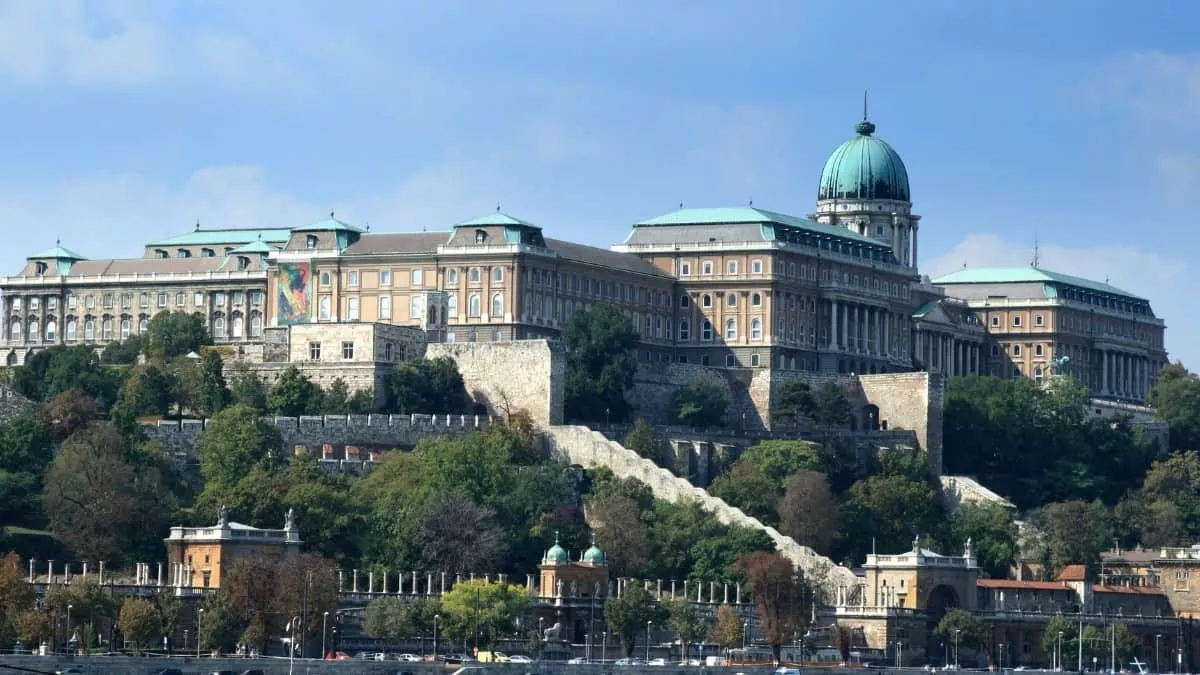
Buda Castle, also known as the Royal Palace, is the centerpiece of Budapest Castle District, a UNESCO World Heritage site.
The castle district complex is an old hilly area of the ancient town, where some of Budapest’s most significant and breathtaking historical monuments can be found.
The Buda Castle is deeply intertwined with the city’s rich and tumultuous past and has withstood wars, earthquakes, sieges, and fires over its 800-year-old history.
Its beauty remains unparalleled, and today, it is one of Hungary’s most magnificent symbols.
The Buda Castle District also houses the Matthias Church, the Budapest History Museum, the Hungarian National Gallery, Fisherman’s Bastion, and the National Széchényi Library.
This article covers everything you must know before booking tickets to the Buda Castle.
Top Buda Castle Tickets
# Walking Tour of Buda Castle with a historian # Walking Tour of Buda and Pest # Evening tour of Buda Castle: History & Myths
Table of contents
Where to book tickets, how do online tickets work, walking tour of buda castle with a historian, walking tour of buda and pest, evening tour of buda castle: history & myths, budapest city tour including buda castle, buda castle private walking tour, buda castle timing, how to reach buda castle, buda castle timings, buda castle, change of guard, hungarian national gallery, budapest history museum, széchenyi national library, fisherman’s bastion, matthias church: the church of our lady, old rock chapel, holy trinity square, andrew hess square, labyrinth of buda castle, hospital in the rock, the house of houdini, museum of music history, golden eagle pharmacy museum, museum of telephones, museum of military history, what to expect at buda castle.
Take a guided tour and dive into a sprawling 800-year-old history of Hungarian legacy.
Learning about the castle’s bloody counts, the Ottoman invasion, the Habsburg power struggle, the conflict of faith, and the golden age.
Admire the architectural artistry that has brought the Baroque-style Royal Palace to life and the persistence involved in restoring this symbol of Hungarian pride every time it was damaged.
Step into the recently restored St. Stephen’s Hall, decimated during World War 2, and stand in awe at the opulence on display.
Stand on the terraces or the ramparts and view sweeping views of the city from atop the hill.
Your guide will also take you on a walking tour of the fascinating Castle Hill area on the Buda side of Budapest.
You will see Fisherman’s Bastion, Matthias Church, Holy Trinity Square, Savoy Terrace, and other popular Budapest attractions.
Tickets for Buda Castle are available online and at the attraction.
Online ticket prices tend to be cheaper than tickets at the attraction.
When you buy online, you can avoid the long queues at the ticket counters.
Because some attractions sell a limited number of tickets, booking early helps avoid last-minute disappointments.
Visit the booking page for Buda Castle, select your travel date and the number of tickets, and make the booking.
Once you complete the booking process, the tickets will be mailed to you.
You do not need to carry printouts.
Show the e-ticket on your smartphone at the entrance and walk in. Carry a valid ID.
Buda Castle Ticket Price
For the Budapest: 3-Hour Live Guided Sightseeing Tour , the general ticket for ages 13 and above costs HUF 11,049 (€29).
Children between three and 12 are charged HUF 5,714 (€15) for access.
Infants up to two years are not charged anything.
For the Budapest: Buda Castle Guided Tour with St. Stephen’s Hall , the ticket price for all ages is set at HUF 6,096 (€16).
For the Budapest: Buda Castle District Walking Tour with a Historian , the ticket price for all ages is set at HUF 17,147 (€45).
For the Budapest: Buda Castle Vampires & Myths Evening Walking Tour , the adult ticket for all ages above 18 costs HUF 8000 (€21).
Youths aged between 11 and 18 are charged HUF 6,858 (€18).
Kids under 11 are not allowed to participate in this tour.
For the Budapest: Buda Castle Private Walking Tour , the ticket for all ages costs HUF 41,147 (€108).
Buda Castle vs. Castle District vs. Buda Castle Hill Many visitors get confused with these three terms because they are used interchangeably. Buda Castle refers to the Royal Palace of the Hungarian Kings at the southern end of Castle Hill. Around Buda Castle are many other historical sights, all within a walled area known as the Castle district. As for Buda Castle Hill, that’s just another name for ‘Castle Hill.’
Back to Top
Buda Castle tours
There are many tour options with different itineraries to explore the Buda Castle:
Some tourists spend the whole day at Castle Hill exploring the various attractions, while others visit for an hour as part of their Budapest City tour.
Some prefer a walking tour, while others go around in the official Buda Castle Electric Hop-on Hop-off bus .
We list below the most popular Buda Castle tours –
With a trained historian accompanying you, this is a perfect Buda Castle tour for a history buff and those who love stories.
You will explore the whole Buda Castle District, including the Royal Palace, Savoy Terrace, Matthias Fountain, Palace Gardens, Alexander Palace, the Hungarian Presidential Palace, Matthias Church, etc.
Entry to Mathias Church is part of this tour.
The tour starts at 10 am and lasts for three hours.
An expert guide will lead your tour.
A coffee break with a complimentary cup of coffee will be part of the tour.
Meeting Point: Holy Trinity Square, Szentháromság tér, Castle District ( Google Map )
Cancellation: Free cancellation up to 24 hours before the activity starts
Ticket price (All Ages): HUF 17,147 (€45)
If you want to explore both the Buda region and the Pest region of the city of Budapest, look no further than this tour.
As part of this tour, you will see the main sights of Buda and Pest, such as the Royal Palace, Buda Castle, Chain Bridge, Danube Promenade, Saint Stephen’s Basilica, Szechenyi Square, etc.
Tour starting time: 10 am Duration: 3 hours Guide: Yes Meeting Point: Budapest, Sütő Utca 2 – in front of Budapest Central Tourist Information Office ( Google Map )
Ticket Price
Small group tour :
Adult Ticket (16+ years): HUF 40,000 (€105)
Child Ticket (up to 15 years): Free
Private tour (Minimum Two Participants) :
General Ticket (All Ages): HUF 22,677 (€60)
*If you are a group of around six visitors, try out this Castle tour .
This tour of Buda Castle is available throughout the week except for Monday and Wednesday.
You get a Gothic-adorned narrator who takes you around Buda Castle and tells you stories of war, medieval Budapest, vampires, and folk stories from Hungary.
You also learn about the cruelty of Elizabeth Bathory, the bloody countess, and the Romanian prince, Vlad Dracula, who ended up in the prison of Buda Castle.
The tour lasts two hours and will be led by an expert guide.
Tour starting time: 7.45 pm, 8 pm Meeting Point: At the Zero Kilometer Stone located by the funicular below Buda Castle ( Google Map )
This tour is not suitable for children under 11.
Ticket price
Adult ticket (18+ years): HUF 8000 (€21) Youth ticket (11 to 17 years): HUF 6,858 (€18)
During this coach tour, you visit the three highlights of Budapest – Buda’s Castle District for a leisurely walk, Gellért Hill to take in spectacular views of the city, and Heroes’ Square in central Pest to see the statues of Hungarian kings and dukes.
When in the Castle District, you will take a short walk to explore the attractions such as Matthias Church and the Fishermen’s Bastion.
Meeting Point: Cityrama & Gray Line Travel Agency, Báthory Utca 19, Budapest 1054 (5th district, close to the Parliament). ( Google Map )
Ticket prices
General ticket (13+ years): HUF 11,049 (€29) Child ticket (3-12 years): HUF 5,714 (€15)
Infants under three are not charged anything for this tour.
*The Grand City Tour and Castle Walk tour is very similar to the one described above, except that it also includes pick up and drop off from your hotel.
Best for a group of up to ten tourists
If money isn’t a concern, but you want a high-quality touring experience with VIP treatment, you must opt for this Buda Castle tour.
A private guide accompanies you from your hotel to the UNESCO World Heritage site and spends three hours narrating stories of Buda Castle and the Castle District.
Visits to Matthias Church and the Fishermen’s Bastion are also part of this tour.
A shuttle will pick you up from your hotel in Budapest.
The tour lasts for three hours and will be led by an expert guide.
Tour starting time: 9 am, 10 am, 11 am, 12 noon, 1 pm, 2 pm Cancellation: Free cancellation up to 24 hours before the activity starts
Ticket prices: HUF 41,143 (€108) for a collective group of up to ten tourists.
Buda Castle Guided Tour with St. Stephen’s Hall
This is one of the only tours that allow you to visit the inside of the Royal Palace at the Buda Castle.
Enter St. Stephen’s Hall, the only area of the Palace interior that has been completely and accurately restored to its original splendor following World War II looting and destruction.
You will also wander through the Castle’s outdoor courts, see statues and fountains, and bask in sweeping views of the city below.
The tour begins at 4 pm.
An expert tour guide will lead you, and the tour lasts for 90 minutes.
Meeting Point: Palota Info Palace information point in Hunyadi Court, near the Matthias Fountain. Get Directions.
Ticket Prices: HUF 6,095 (€16)
The Buda Castle houses the National Gallery and the Budapest History Museum, both of which are open from 10 am to 6 pm every day from Tuesday to Sunday.
On Mondays, all attractions in the Castle remain closed.
Budapest History Museum alters its timings slightly during the lean months of November to February when it closes early at 4 pm.
Opening hours of Buda Castle District
Buda Castle district, which includes the streets, courts, and even some points of interest such as the Fisherman’s Bastion, remains open all through the day.
This is why some visitors reach the Buda Castle hilltop for romantic late-night or early-morning walks.
Note: Some of the restaurants and bars in Castle Hilltop stay open till midnight.
Buda Castle is situated on the Buda side of the city, on Castle Hill, overlooking the Danube River.
Address: Budapest, Szent György tér 2, 1014 Hungary. Get Directions
The Castle is easily accessible by public transportation.
Szentháromság Tér bus stop is a two-minute walk away from the church.
Donáti Utca bus stop is a five-minute walk away.
Mikó Utca bus stop is an eight-minute walk away.
You can board bus lines 16, 16A,116, and 916 for the Matthias Church.
Halász Utca and Mikó Utca Tram stations are both a ten-minute walk away.
Put your starting point here to navigate to the Buda Castle.
Several parking spots are available nearby.
Buda Castle district, which includes the streets, courts, and even some points of interest such as the Fisherman’s Bastion, remains open throughout the day.
How long does the tour take
If you wish to visit the Royal Palace and the surrounding attractions only, the tour will take you around 70-90 minutes.
For a comprehensive Buda Castle district tour, you must budget three to five hours.
Best time to visit
The best time to visit the Buda Castle is as soon as the castle opens in the morning.
This will allow you to beat the crowds since Buda Castle is a popular destination, and you might have to rush through the attraction in later hours.
Things to see in Buda Castle
The Buda Castle houses three attractions – the Hungarian National Gallery, the Budapest History Museum, and the Széchenyi National Library.
Most visitors to Buda Castle skip the Library because….it is a library.
These three institutions occupy all areas of the Castle – no space in the Castle building is ‘Castle only.’
In short, inside the Buda Castle, one can only visit the Museum, Gallery, or Library.
However, there are many other points of interest in the Buda Castle District (the walled area around the Castle).
Known by many names, such as the Royal Castle, Castle Palace, Budavári Palota , etc., this massive building is an 18th-century Neo-Baroque structure.
The 200-plus rooms form a symmetrical layout around the 62-meter-high central dome facing the River Danube.
The changing of the Guards is one of the Buda Castle attractions most visitors want to witness.
The ceremony happens in front of Sandor Palota (also known as Alexander Palace), which is by the Funicular in the Buda Castle District.
Sandor Palota is also the official residence of the Hungarian President.
The Buda Castle Changing of the Guards ceremony is a few minutes long and involves a lot of marching, spinning of the rifles, saluting, drums, etc.
Ceremony timings: 9 am to 5 pm, every hour by the hour (e.g., 10 am, 11 am, … 2 pm, 3 pm, 4 pm). If you plan to catch the 9 am ceremony, it is better to arrive 15-20 minutes early for a vantage position.
The Hungarian National Gallery also referred to as Magyar Nemzeti Galéria, is in the main wing of Buda Castle, facing the Danube.
The Gallery showcases Hungarian sculpture and painting from the time of the Magyar invasion in the 9th century to the much more artistically productive 20th century.
Besides Hungarian art, collections of international masterpieces are also on display.
Don’t miss out on the sculptures and panel paintings from the medieval and Renaissance periods and the Baroque works.
From May to October, visitors can also go up on the Dome Terrace for stunning views of the Pest side of the city and the river Danube.
Opening hours: From Monday to Friday, the Hungarian National Gallery opens at 10 am and closes at 6 pm. On Monday, it remains closed. The last entry is at 5 pm.
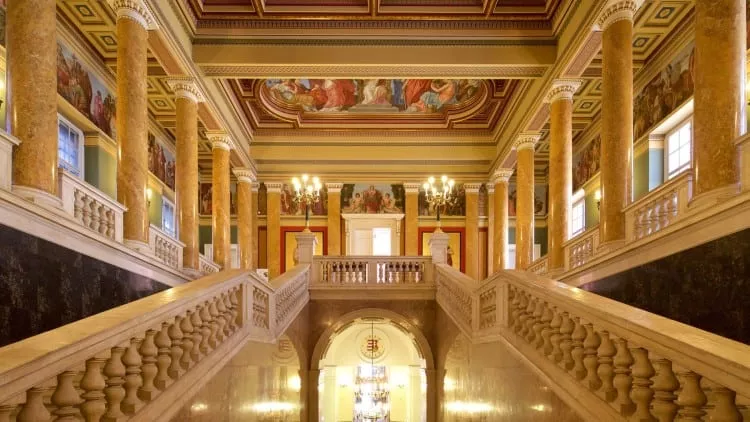
The History Museum is spread over four floors in the south wing of Buda Castle.
Locally known as Budapesti Történeti Múzeum , this Budapest attraction displays artifacts and exhibits about Hungary’s long and rich history.
Don’t miss out on the rare documents, ceramics, metalwork, textile samples, utensils, etc., which depict life in the towns of Buda, Pest, and Obuda till their unification in 1872.
The other highlights of the Budapest History Museum are the Renaissance Room, Gothic Room, The Royal Chapel, etc.
Opening hours: From Monday to Friday, the Budapest History Museum opens at 10 am and closes at 6 pm. On Monday, it remains closed. The last entry is at 5 pm.
The massive Széchenyi National Library has occupied the southwest wing of Buda Castle since 1985.
This National library contains more than six million documents, emphasizing Hungarian manuscripts and maps.
Most tourists skip this attraction because it is….a library.
Attractions in Buda Castle District
The walled area around the Buda Castle, also known as the Castle District, is a tourist’s paradise with lots to do and see.
We list out some of the best –
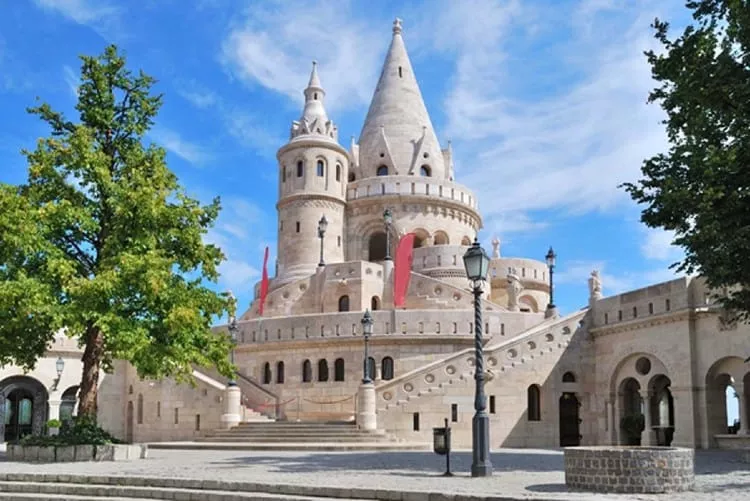
Fisherman’s Bastion is locally referred to as Halászbástya and is right behind the Matthias Church.
These are highly decorated towers built in the 19th century to serve as a lookout over the city and River Danube.
Its seven towers, colonnades, and embrasures were designed in Neo-Romanesque style by Frigyes Schulek.
Opening hours: The Fisherman’s Bastion remains open all through the day, and you can visit any time you want, including holidays such as Christmas or New Year.
The Matthias Church ( Mátyás-templom ) is also known as The Church of Our Lady and was built in 1269.
This Church is popular with tourists because despite being a Gothic Catholic church, the atmosphere is more oriental and mystically exotic – a significant change from the other Churches in Europe.
This Roman Catholic Church even served as a mosque during the Turkish reign.
Opening hours: Buda Castle Hill’s Matthias Church is open from 9 am to 5 pm from Monday to Friday . On Saturday, it closes early at 1 pm, and on Sunday, it opens later – at 1 pm.
Note: If you want to enter only for the prayers, you don’t need to buy tickets.
Old Rock Chapel is just behind Matthias Church.
Besides exploring the 700-year-old structure, you also get to see 3D Past , a unique 3D Hungary History cinema experience.
Opening hours: Old Rock Chapel is open from 10 am to 6 pm from Monday to Friday . On the weekends, it opens at 1 pm and closes early at 5 pm.
Entry tickets: All visitors taking a seat for the movie must buy a ticket worth HUF 1,500.
Holy Trinity Square (Szentháromság Tér in Hungarian) is the central square on Castle Hill.
It is an ideal meeting place for locals and visitors, offering 360-degree views of the Buda Castle Hill, Buda Royal Palace, Fisherman’s Bastion, Matthias Church, and the Old City Hall.
Do not miss out on the Holy Trinity Statue, built by the locals to keep the Black Plague away.
This famous Square is named after the first printer of books in Buda-Andrew Jess.
The points of interest at this Square are – St. Nicholas Tower, Pope Innocent XI monument, and ‘Vörös sün’ (the Red Hedgehog).
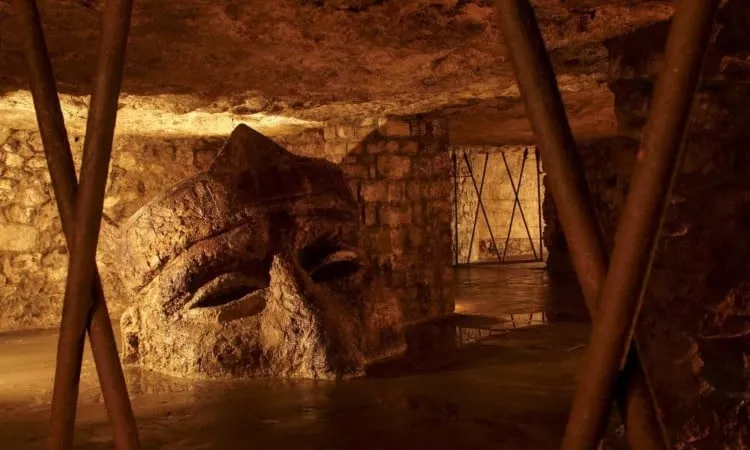
Underneath Castle Hill is a complex system of natural caves and passages that the inhabitants of the area have used since the Middle Ages for many purposes.
This Labyrinth is 1000 meters long and is walkable in approximately 30 minutes.
Opening hours: Buda Castle Labyrinth opens at 10 am and closes at 7 pm daily. The oil lamp tour starts after 6 pm. The last entry is at 6.30 pm.
Buda Castle cave guided tour : The adult ticket costs 3000 Ft (€11)
Kids below 18 and seniors above 64 pay €8 for entry.
Infants below three are not permitted.
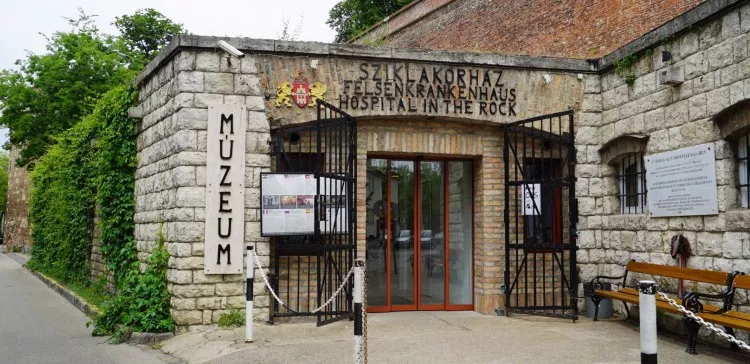
The hospital in the Rock underneath the Buda Castle district is a unique attraction, and you can’t miss it.
During World War II, Castle Hill’s caves doubled up as an air-raid shelter and emergency hospital.
When the Cold War started, the hospital was fortified further to protect it from chemical and nuclear contamination.
With time, the hospital and the nuclear bunker got the name ‘Hospital in the Rock’ ( Sziklakorhaz in Hungarian).
Today, it is a fascinating museum exhibiting the biggest collection of Hungarian waxwork with more than 40 figures and lots of medical equipment.
Opening hours: Hospital in the Rock opens at 10 am and closes at 8 pm every day. The last tour starts at 6 pm every day of the week.
Hospital In the Rock Guided Tour : The adult ticket for all ages above 16 cost HUF 38,090 (€100)
Kids between seven and 15 years of age pay HUF 14,477 (€38).
Kids younger than seven years are not permitted entry.
This small museum celebrates the fact that Houdini, the world-famous magician and escapologist, was born in Budapest.
Inaugurated in 2016, the House of Houdini on Dísz Square exhibits Houdini’s magic-related items and personal artifacts.
Do not miss out on the highlight – a magic show by the resident magician.
Opening hours: Hospital in the Rock opens at 10 am and closes at 8 pm, every day. The last tour starts at 6 pm every day of the week.
Entry tickets: The House of Houdini’s general ticket for ages 12 and above costs HUF 3,425 (€9), and kids below 11 years pay HUF 2,285 (€6).
Kids younger than six years enter for free.
The Museum of Music History in Buda Castle District is also referred to as the Institute for Musicology and narrates the story of music in Hungary from the 18th century to the present day.
Music concerts are conducted in the Museum at regular intervals, and access is free of charge with the museum entry.
Open hours: The Museum of Music History opens at 10 am and closes at 4 pm from Tuesday to Sunday. It remains closed on Mondays.
Entry Tickets: The Budapest Music Museum’s adult ticket (over 18 years of age) costs HUF 2,000 (€5.25).
Tickets for minors and senior citizens are set at HUF 1000 (€2.62).
The Pharmacy Museum in Buda Castle District brings to life the practice of medieval Alchemy in the form of a Lab and therapeutic tools and items.
The locals refer to this tiny Museum as Aranysas Patika Muzeum.
Some of the interesting items on display here (some would use the word ‘creepy!’) are dried bats and tiny crocodiles in jars, herbs used for curing, etc.
Open hours: The Pharmacy Museum opens at 10.30 am and closes at 6 pm from Tuesday to Sunday. It remains closed on Mondays.
Entry Tickets: The Pharmacy Museum’s adult ticket (26+ years) costs HUF 800 (€2.1).
Children (up to 26 years) and senior citizens (64+ years) gain access to HUF 400 (€1.05).
This telecommunications Museum is a hidden gem of the Buda Castle District and is right next to the Buda Castle.
Inaugurated in 1991, this museum allows visitors to go back to the past and touch and feel the old telephonic devices.
While exploring, don’t miss the hand-cranked magneto phones and the first-ever ‘telephone’ constructed and patented by Alexander Graham Bell in 1876.
Open hours: The Museum of Telephones opens at 10 am and closes at 4 pm from Tuesday to Sunday. It remains closed on Mondays.
Entry Tickets: The Telephone Museum’s adult ticket costs HUF 500 (€1.31).
This Military Museum was established in the early 1920s to exhibit the artifacts of both global and Hungarian military history.
However, the Museum’s primary focus is the 1848–49 War of Independence and the Hungarian Royal Army.
The Museum of Military History opens at 9 am and closes at 5 pm from Tuesday to Sunday. It remains closed on Mondays.
Open hours: The Museum of Military History opens at 9 am and closes at 5 pm from Tuesday to Sunday. It remains closed on Mondays.
Entry Tickets: The Telephone Museum’s adult ticket costs HUF 1,500 (€4)
Download this map to understand the Buda Castle District and its attractions, including the Buda Castle. Courtesy: Nathan Hamilton
Walking to Buda Castle
Once you decide to walk to the castle, you must choose between one of the two available routes –
Gentle Hill Walk
First, you must reach Szell Kalman Square (locally known as Széll Kálmán Tér) and then start your walk toward the Castle.
You can cover the distance of 2.3 Km (1.4 Miles) in approximately 30 minutes.

On the way, you will pass by the Vienna Gate (Becsi Kapu), the National Archives, Matthias Church, Fisherman’s Bastion, and the Presidential Palace.
Steep Hill Walk
Since on this route, you gain an elevation of 45 meters (147 feet) quickly, we recommend this only if you are healthy.
This walk starts from the Chain Bridge at Clark Adam Square , via the stairs leading up next to the Funicular.
Most visitors can walk a distance of 550 meters (one-third of a mile) in approximately ten minutes.
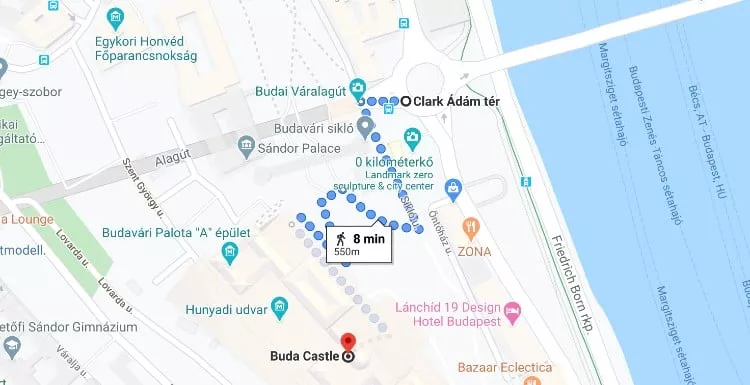
Most tourists who prefer walking opt for a Buda Castle walking tour .
Buda Castle Funicular
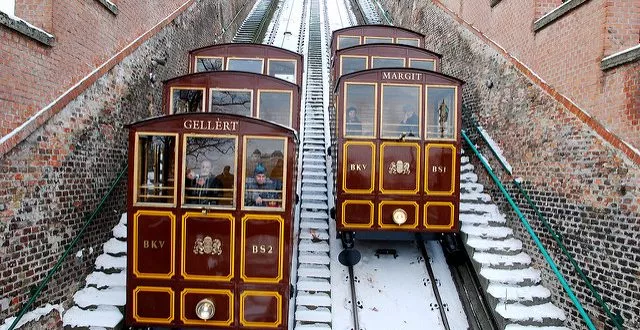
The Buda Castle Hill Funicular is an exciting way to get to the Castle, especially if you are traveling with kids or seniors.
The Funicular runs on a 95-meter (311 feet) route of 50 meters elevation and has two tram cars.
It only has two stations – the lower station at the Buda end of the Chain Bridge (at Clark Adam Square ) and the upper station on Castle Hill, right next to the Buda Castle.
The Buda Funicular service starts at 7.30 and ends at 10 pm every day of the week.
However, every alternate Monday, they close for maintenance ( schedule ).
The duration of the ride is only a few minutes, and the frequency is every 10 minutes up and down Castle Hill.
Expect long lines during peak tourist seasons, resulting in waiting times of up to 30 minutes.
The Funicular ride up to Buda Castle costs 1,200 Ft (€3.4) with a small discount if you buy a return ticket.
Bus to Buda Castle
If you arrive from the Pest side (City Center), opt for Bus No. 16 from Deak Ferenc Square .
After six stops and 11 minutes, you will be dropped near Buda Castle.
If you try to get to the Budapest castle from Buda’s side, opt for Bus No. 16, 16A, or 116 from Szell Kalman Square .
After six minutes and five stops, you must get down at Dísz Tér .
A quick ten-minute walk will get you to Buda Castle.
Sources # Budacastlebudapest.com # Budapest.org # Wikipedia.org # Tripadvisor.com The travel specialists at TheBetterVacation.com use only high-quality sources while researching & writing their articles. We make every attempt to keep our content current, reliable and trustworthy .
Popular attractions in Budapest
How useful was this post?
Click on a star to rate it!
Check out all the things to do in Budapest
This article was researched & written by
Deeksha Anand
Deeksha loves to explore diverse cultures and cuisines. She is always looking forward to learn what different countries have to offer. She is not too worried about the holiday destination as long as it is different from her last one. She loves roaming around the streets with no timelines to adhere. Favorite Cities: New York, Barcelona, London, Paris, Rome
Edited by Rekha Rajan & fact checked by Jamshed V Rajan
Leave a Comment Cancel reply
Save my name, email, and website in this browser for the next time I comment.
FireStorm Internet runs this website to provide the most accurate and up-to-day information about tourist attractions.
Our Address
FireStorm Internet, 203, 30C, Bollineni Hillside, Perumbakkam Main Road, Nookampalayam, Chennai, India. Pin Code: 600126
About Us The Team Contact Us Affiliate Disclaimer Content Policy HTML Sitemap Privacy Policy Terms of Service
Helicopter Tours Food Tours Ghost Tours Stadium Tours Hop On Hop Off Tours Zoo Tickets Madame Tussauds Linq High Roller Summit One Vanderbilt
© 2024 FireStorm Internet
- Grand Canyon
- Gold Country
- California Coast
- Los Angeles
- Mammoth Lakes
- death valley
- Lassen Volcanic
- Sequoia & Kings Canyon Park
- Yosemite Park
- napa valley
- step Robles
- Santa Cruz Mountains
- Santa Ynez Valley
- Sonoma Valley
- San Francisco
- Silicon Valley
- Shasta & surroundings
- Valley of Fire Park
- Philadelphia
- Monument Valley
- Washington DC
- London outskirts
- Bournemouth
- Deal & surroundings
- Hastings & surroundings
- Salisbury & Stonehenge
- Sandringham
- Sheffield & surroundings
- Southampton
- Stratford-Upon-Avon
- Niagara Falls
- Ottawa & Gatineau
- Québec City
- Trois-Rivières
- Easter Island
- Krabi & Phi Phi Islands
- Oberammergau
- Romantic Route
- Knokke-Heist
- Zaanse Schans
- Northern Ireland countryside
- Cinque Terre
- San Gimignano
- NEW ZEALAND
- HOTEL RESERVATION
- TICKETS AND EXCURSIONS
- TICKETS AND TOURS
- SPORTS EVENTS TICKETS
- AIRPORT TRANSFER
- INTERNATIONAL SIM CARD
- BAGGAGE SHIPPING
- TRAVEL INSURANCE
- TOURIST VISAS
- PURCHASE FOREIGN CURRENCY
- INTERNATIONAL PREPAID CARD
- TERMS OF USE

Budapest: How to visit the historic Buda Castle

Last updated: 10/01/2020
Discover the Buda Castle, one of the main attractions of Budapest, the beautiful capital of Hungary. The place is incredible, full of history and provides incredible views of the city due to its privileged location.
THE BUDDHA CASTLE
Buda Castle is a historic palace and home to the Hungarian kings. The first castle was completed in 1265, but what we see today is not the original version. The medieval palace was destroyed in the great siege of 1686, when Buda was captured by allied Christian forces. Currently, what you can see is a palace built between 1749 and 1769 in shack style. After the 1918 revolution and the fall of the Habsburg Dynasty, the Royal Palace became the seat of the new regent of the Kingdom of Hungary, Miklós Horthy, who lived with his family there between 1920 and 1944.

ECONOMY TIP: BUDAPEST CARD O Budapest Card It's the best way to get to know the main attractions of the city, saving a lot! The Budapest tourism department offered us two units of the card to test and we loved it! In addition to including free entry to several attractions and discounts of up to 50% in many other , the Budapest Card includes free and unlimited transport around town. There are 5 card versions: 24h, 48h, 72h, 96h and 120h. It is possible to buy online (and pick up at any point of sale, or ask for it to be delivered to your hotel) or buy at any of the agreed points. Online prices are cheaper, so it's worth planning to buy in advance. To make a purchase, go to this link . Read more: Hungary: What to do in Budapest – 3 days itinerary

During this period, the palace was the center of Hungary's political and social life. With the end of the Second World War, a series of efforts began to rebuild the palace, which had been severely destroyed, but many of the facades were simplified and some areas were not rebuilt. A series of rooms in the old medieval castle were rebuilt between 1958 and 1962. Since 1987, Buda Castle has been part of the UNESCO World Heritage List. Currently, it houses some museums: the Budapest History Museum , which explores the history of Budapest from its origins to the end of the communist era, and the Hungarian National Gallery .

WHAT TO KNOW AT THE BUDA CASTLE
1. buda castle gardens.
The castle and its gardens have been decorated with works of art since its foundation in the 14th century. Many of the statues survived destruction during the siege of Budapest between 1944 and 1945 and were later restored. On the other hand, important works of art were destroyed during the controversial reconstruction of the castle during the 1950s and 1960s. The main monuments that can still be seen today are:
Matthias Fountain
This fountain is depicted depicts a real hunting scene with a hidden love story. According to legend, King Matthias, the most handsome in Hungary, went hunting in disguise to find out exactly what was happening in the country. While hunting, he met a beautiful peasant girl named Helena (Szép Ilonka, in Hungarian). They fell in love, but when she found out he was the king of Hungary, she realized that being love would never be complete and ended up dying of a broken heart.

The fountain depicts a neo-Baroque-style statue of King Matthias (at the top) and a dead deer that was shot by him. Also, there are the 3 king dogs who are drinking water from a spring. On the left is the seated figure of Galeotto Marzio, the historian of the Italian court of King Matthias, who holds a hawk on his wrist. On the other side of the fountain is Szép Ilonka herself, who appears to be feeding a young deer. The fountain was designed in 1904 and built against the wall of the central wing of Buda Castle. Fortunately, she suffered minor damage during WWII.
Monument to Prince Eugene of Savoy
It is a neo-Baroque equestrian statue of Prince Eugene of Savoy, located on the Danube terrace. It was purchased in 1900 as a temporary solution until the planned statue of King Franz Joseph was completed. As this never happened, the statue was not replaced. It is decorated with bronze reliefs and depicts the Battle of Zenta in 1697.
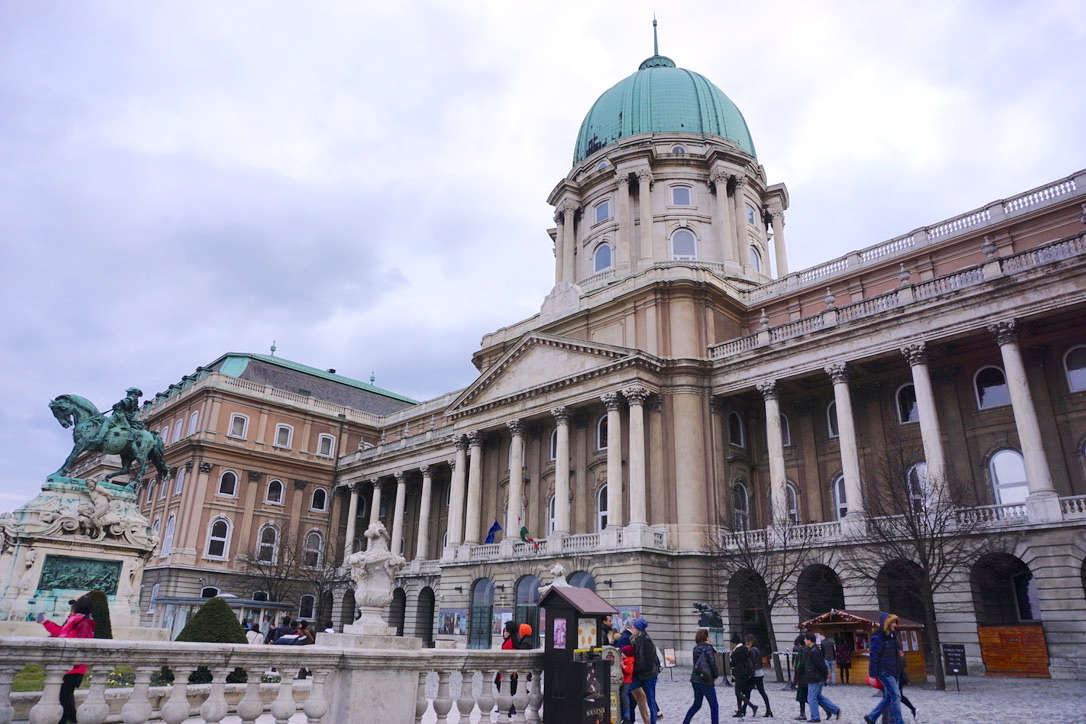
Horse tamer
This is a statue, erected in 1901, in which a wild horse is tamed. Originally, it was opposite the Riding School. However, the statue was damaged during World War II and removed during the 1960s for restoration. It currently stands on the west side of the Buda Palace, next to the Matthias Fountain.
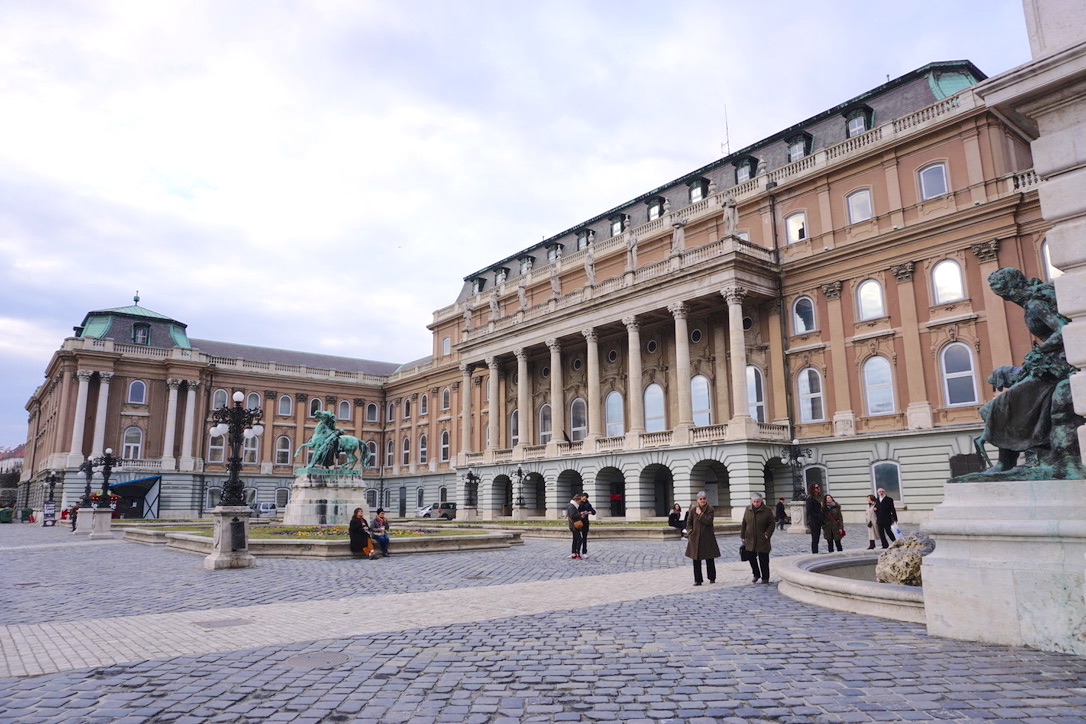
The statue of the mythological bird Turul was built in 1905. The bird is a Hungarian tradition and one of its national symbols. It is ornate in a neo-baroque style and was heavily damaged during the Second World War, during the siege of Budapest. The statue was restored in the early 1980s.

children fishing
This is a fountain built in 1912 that depicts two children wrestling with a fish. The fountain was removed in 1955 and re-erected on Rákóczi Square in Pest, but brought back to its original location in 1976. It was extensively restored in 2001.

Csongor and Tünde
These are two statues, from 1903, that represent literary figures from Mihály Vörösmarty's drama. Originally, they decorated the steps in front of the Hasburg Palace. However, the steps were demolished after the war, but the statues were saved and replaced in 1976.
Decorate the gardens of the Palace of Buda, four lion statues, from 1901, which are guarding the monumental gate that leads to the Praça dos Leãos. The animals outside the gate are calm and dignified, while the ones inside are menacing. A lion was broken in two during the war, but it was redone in the 1950s.

War and peace
The beautiful allegorical bronze statues of War and Peace stand next to the entrance to the Budapest History Museum. War and Peace are represented by angels, one with a trumpet and the other with an olive branch. Under the angel of peace is a returning soldier, while under the angel of war is a dead Ottoman soldier and former Hungarian warriors.

BOOK NOW your hotel and save up to 50% . Travelers readers are with a SUPER DISCOUNT ! And the best, with FREE CANCELLATION *!
*check the hotels with free cancellation on the website
2. BUDAPEST HISTORY MUSEUM
The Budapest History Museum is located in the south wing of Buda Castle, in Building E, on four floors. It presents the history of Budapest from its beginnings to the modern era. The restored part of the medieval castle, including the Royal Chapel and the Gothic Hall with rib, belongs to the exhibition. Highlights of the display include Gothic statues of Buda Castle and a 14th-century silk tapestry decorated with Angevin coats of arms. Small gardens were recreated in the medieval zwingers (open areas within two defensive walls) around the oldest parts of the building.

3. HUNGARIAN NATIONAL GALLERY
Founded in 1957, the Hungarian National Gallery is located in buildings A, B, C and D of Buda Castle. Its collections cover all genres of Hungarian artists from the 11th century to the present, with a special exhibition focusing on Gothic altarpieces (housed in the former Baroque ballroom). The Palatine Crypt, the only interior of the ancient castle that still survives to this day, also belongs to the museum.

Among the artists who have works in the gallery are: Károly Alexy, Maurice Ascalon, Miklós Borsos, Gyula Donat, John Fadrusz, Béni Ferenczy, István Ferenczy and Miklós Izsó. Brassai and Ervin Marton, Mihály Munkácsy, László Paál, Károly Markó, Joseph Borsos, Barabás Miklós, Bertalan Székely, Charles Lotz, Paul Szinyei Merse, István Kiss, Béla Iványi Grünwald, Tivadar Kosztka Csontváry, József Rippl-Rónai and Károly Ferenczy.
4. SZÉCHÉNYI NATIONAL LIBRARY
The “F Building” of Buda Castle is occupied by the Széchényi National Library, the national library of Hungary. Founded in 1802, the national library is named after the Hungarian aristocrat Count Ferenc Széchényi, its founder. Its collection of rare and ancient books, codices and manuscripts contains 35 Corvina pieces from the famous library of King Matias Corvino.

WHERE TO EAT IN BUDA CASTLE
For the hour of hunger, a good request is the Budapest Terrace , a restaurant opened in 2012. The restaurant is located inside the Buda Castle and has incredible views of the Danube River and the city of Budapest. The place is open daily from spring to autumn from 10 am to 10 pm and serves drinks, delicious snacks, salads, pasta and a variety of hot dishes. Check the full menu in this link .

HOW TO REACH BUDA CASTLE
To get to the Castle, you can walk the stairs that are close to the famous Ponte das Correntes or the slope that is to the left of the funicular (this one is for the forts)! As the castle is on top of a hill, the most convenient option to reach it is to take a funicular . We recommend that you take the funicular up and walk down to admire the view of the Danube River and the attractions on the Pest side. See all information about the funicular in this link .
- Address: Sikló u., 1013 Budapest, Hungary
- Schedules: daily from 7:30 am to 10:00 pm
- Prices: HUF 1,200/ round trip: HUF 1,800

IMPORTANT INFORMATION
Buda castle.
- Address: Szent György tér 2, 1014, Budapest, Hungary
- Budapest History Museum: Tuesday to Sunday from November to February from 10 am to 4 pm / from March to October from 10 am to 6 pm
- Hungarian National Gallery: Tuesday to Sunday from 10 am to 6 pm
- National Széchényi Library: Tuesday to Saturday from 9 am to 8 pm (see details here )
- Free tour of the gardens, Patio dos Leãos and surroundings
- Budapest History Museum: HUF 1,800
- Hungarian National Gallery: HUF 2,200
- Even for those who have Budapest Card
We thank the Budapest Festival and Tourism Center for tickets to attractions including Buda Castle and Budapest city transport.
Save this tip on Pinterest!

Read more about Budapest:
- Hungary: What to do in Budapest – 3 days itinerary
- budapest hungarian parliament guided tour
- Hungary: Budapest accommodation tip
- Hungary: How to get from Budapest airport to the center
- Hungary: 3 restaurant tips in Budapest
- Hungary: The Exciting House of Terror Museum in Budapest
ARE YOU GOING TO TRAVEL? SCHEDULE YOUR TRIP HERE!
hotel reservation : use the booking.com to book your accommodation, car rental : get a quote at rentcars and check the price at the main rental companies in the world, tickets & tours : buy tickets to the world's top attractions online with get your guide , tickets & tours : buy tickets for tours and guided tours online at civitatis , sports events tickets : buy tickets to major us sporting events online with hellotickets , travel insurance : quote with the promo insurance for different plans and destinations. use code "viajonarios5" to guarantee 5% off, train in europe : buy your train tickets at the best prices at trainline , international cell phone chip with the easysim4u and leave with the chip working before travelling, purchase of foreign currency with the best exchange rates with exchange now , related articles more from the author.

Germany: How to get from Berlin airport to the center

England: Accommodation at Blakemore Hyde Park in London
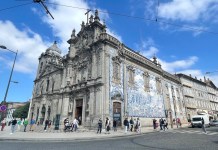
Portugal: 10 free tours in Porto
Excellent tips! I haven't found anything so well explained on another site about visiting the Castle!
Hello Aline! Thanks so much for the comment! We had a hard time finding information about the castle before we made the visit. Nothing fairer than sharing with readers everything we've learned! Hope you keep reading our posts: – Hungary: What to do in Budapest – 3 days itinerary – budapest hungarian parliament guided tour – Hungary: Budapest accommodation tip – Hungary: How to get from Budapest airport to the center
Hugs and a great trip to you! 🙂
LEAVE YOUR COMMENT cancel comment
Save my name, email and website in this browser for the next time I comment.
Notify me of follow-up comments by email.
Notify me of new posts by email.
Take advantage of the search to browse through the World Heritage Centre information.
Share on social media
Unesco social media, budapest, including the banks of the danube, the buda castle quarter and andrássy avenue.
- Description
This site has the remains of monuments such as the Roman city of Aquincum and the Gothic castle of Buda, which have had a considerable influence on the architecture of various periods. It is one of the world's outstanding urban landscapes and illustrates the great periods in the history of the Hungarian capital.
Description is available under license CC-BY-SA IGO 3.0
Budapest, avec les rives du Danube, le quartier du château de Buda et l’avenue Andrássy
Conservant des vestiges de monuments ayant exercé une grande influence architecturale à diverses époques, comme ceux de la cité romaine d'Aquincum et le château gothique de Buda, ce site, qui est l'un des plus beaux paysages urbains du monde, illustre les périodes brillantes de l'histoire de la capitale hongroise.
بودابست بضفاف نهار الدانوب، وحي قصر بودا وجادة أندراسي
إنّ هذا الموقع الذي حافظ على آثار قديمة مارست تأثيراً هندسياً كبيراً على حقبات عدّة كآثار مدينة أكوينكوم الرومانية وقصر بودا القوطي، وهو من أجمل المناظر الحضرية في العالم، يدلّ على الفترات اللامعة العائدة لتاريخ العاصمة المجرية.
source: UNESCO/CPE Description is available under license CC-BY-SA IGO 3.0
布达佩斯(多瑙河两岸、布达城堡区和安德拉什大街)
该地区保留有诸如阿昆库姆罗马城和哥特式布达城堡等遗迹,这些遗迹受到好几个时期建筑风格的影响,是世界上城市景观中的杰出典范之一,而且显示了匈牙利都城在历史上各伟大时期的风貌。
Budapest con las orillas del Danubio, el barrio del Castillo de Buda y la Avenida Andrássy
Este sitio conserva vestigios de monumentos que han ejercido una gran influencia en la arquitectura de diversas épocas, por ejemplo los de la ciudad romana de Aquincul y el castillo gótico de Buda. El paisaje urbano de Budapest es uno de los más bellos del mundo y es sumamente ilustrativo de los periodos de esplendor de la historia de la capital húngara.
ドナウ河岸、ブダ城地区及びアンドラーシ通りを含むブダペスト
source: NFUAJ
Boedapest - de Donau oevers, Boeda burchtwijk en Andrássy Avenue
Dit gedeelte van Boedapest omvat de overblijfselen van monumenten die een aanzienlijke invloed hadden op de stadsarchitectuur, zoals de Romeinse stad Aquincum en de gotische burcht van Boeda. Oorspronkelijk vormde de Donau een scheiding tussen twee steden: Boeda op de uitloper van de rechteroever en Pest op de vlakte van de linkeroever. Tijdens de middeleeuwen kregen de twee steden hun huidige naam. Daarvoor heette de stad Aquincum, de hoofdstad van een van de Romeinse grensprovincies in de 2e eeuw na Christus. Het gebied geldt als een van ’s werelds meest vooraanstaande stedelijke landschappen en illustreert de grote periodes in de geschiedenis van de Hongaarse hoofdstad.
Source: unesco.nl

Outstanding Universal Value
Brief synthesis
This stretch of the Danube has been the location of human settlement since the Palaeolithic. It was the site of the Roman city of Aquincum, situated to the north of the inscribed property which comprises parts of two originally quite separate cities: Buda on the spur on the right bank and Pest on the plain on the left bank. Pest was the first medieval urban centre, devastated in 1241-2. A few years later the castle of Buda was built on a rocky spur on the right bank by King Bela IV. Thereafter, the city reflected the history of the Hungarian monarchy. After the end of the Turkish occupation, recovery did not really begin until the 18th century. In the 19th century, the city’s role as a capital was enhanced by the foundation of the Hungarian Academy, housed from 1862 in a neo-renaissance palace, and by the construction of the imposing neo-gothic Parliament building (1884–1904). W.T. Clark’s suspension bridge, finalised in 1849, symbolised the reunification of Buda and Pest, which did not actually come about until 1873. The symbol of the development of the city as a modern metropolis was the radial Andrássy Avenue, which was included in the property in 2002. From 1872, the Avenue radically transformed the urban structure of Pest, together with the construction of the European continent’s first underground railway beneath it in 1893-6.
As a centre for receiving and disseminating cultural influences, Budapest is an outstanding example of urban development in Central Europe, characterised by periods of devastation and revitalisation. Budapest has retained the separate structural characteristics of the former cities of Pest, Buda and Óbuda. One example thereof is the Buda Castle Quarter with its medieval and characteristically Baroque style, which are distinct from the extended and uniquely homogeneous architecture of Pest (with its historicising and art nouveau styles) which is characterised by outstanding public buildings and fitted into the ringed-radial city structure. All this is organized into a unity arising from the varied morphological characteristics of the landscape and the Danube, the two banks of which are linked by a number of bridges. The urban architectural ensemble of the Andrássy Avenue (‘The Avenue’) and its surroundings (Heroes' Square, the City Park, historic inner city districts and public buildings) are high-quality architectural and artistic realisations of principles of urbanism reflecting tendencies, which became widespread in the second part of the 19th century. The scenic view of the banks of the Danube as part of the historic urban landscape is a unique example of the harmonious interaction between human society and a natural environment characterised by varied morphological conditions (Gellért Hill with the Citadel and the Buda Hills partly covered with forests, the broad Danube river with its islands and Pest's flat terrain rising with a slight gradient).
Criterion (ii): Aquincum played an essential role in the diffusion of Roman architectural forms in Pannonia, then in Dacia. Buda Castle played an essential role in the diffusion of Gothic art in the Magyar region from the 14th century. In the reign of Matthias Corvinus, Buda was an artistic centre comparable, due to its influence, to that of Cracow. As a result of the unification of Pest, Buda and Óbuda in 1872-73, Budapest became once more a significant centre in the second part of the 19th and at the beginning of the 20th century due to the amount and quality of heritage built during those periods. It was a centre which absorbed, integrated and disseminated outstanding and progressive European influences of urbanism and of architecture as well as modern technological developments such as the Millennium Underground Railway, built under Andrássy Avenue, the first in Continental Europe, all of which was in line with its role as a metropolis.
Criterion (iv): Buda Castle is an architectural ensemble which, together with the nearby old district (the Buda Castle Quarter) illustrates two significant periods of history which were separated by an interval corresponding to the Turkish invasion. The Parliament is also an outstanding example of a great official building on a par with those of London, Munich, Vienna and Athens, exemplifying the eclectic architecture of the 19th century, whilst at the same time symbolising the political function of the second capital of the Austro-Hungarian Empire. Andrássy Avenue (1872–1885) and the Millennium Underground Railway (1893 – 1896) are representative examples of the implementation of planning solutions associated with the latest technical facilities of the day to meet the requirements of an emerging modern society. Architecturally, the Avenue has great integrity in its eclectic, neo-renaissance buildings.
The delimitation of the extended property meets the requirements of integrity, since it includes the attributes of Outstanding Universal Value and their historical and structural role is preserved in the urban fabric. Despite the ruinous or missing buildings in certain parts and especially in the Buda Castle Quarter, and despite the reconstructions within the panorama of the Danube banks following World War II, the overall integrity of the property is sustained. In order to reinforce integrity, it is justified to review the delimitation on the Buda side as well as the inclusion of Margaret Island and the extension of the protected area up to the Grand Boulevard (Nagykörút). The original form of Andrássy Avenue with its buildings has been preserved reasonably well in terms of its conception and its relation to the surrounding urban environment, as well as the building fabric. Attention is also given to the preservation and appropriate design of small elements that form part of the street furniture. There are some problems, for example, in the physical condition of the buildings: wooden roof structures have suffered from humidity and metal structures have corroded, requiring maintenance and repair. There have also been some changes in the occupation, offices tending to replace the earlier residential use, which is a common problem in central urban areas. There have been problems with regard to development in the setting of the World Heritage property, both in terms of demolition and inappropriate new structures. Other challenges are the insurance of heritage-friendly traffic management and the mitigation of climate change impact on the natural and built environment (for example extreme water-levels of the Danube, air-pollution and deterioration of limestone structures).
Authenticity
In its attributes and the sum of its constituent parts, the property preserves the defining characters of the architectural heritage created by consecutive layers of historical periods. The restoration and partial reconstruction of the Buda Castle Quarter after World War II, carried out mainly between 1960 and 1980, as well as the degree of authenticity of the surviving historicising buildings are in line with the requirements of the Operational Guidelines. The majority of the replaced buildings in the panorama of the Danube banks conform to their original scales. The big public buildings, such as the Parliament, the Opera House, the Hungarian Academy of Sciences and the Market Hall, have also retained their original functions. Three of the four bridges across the Danube situated in the property have been authentically renovated. The 20th century design of the new Elisabeth Bridge fits in well into the line of bridges preserving its authentic image. Andrássy Avenue, with its trees alongside and its environment, preserve its historicity in its conception and constituent parts. The majority of public buildings have preserved their original function, however, the transformation of residential buildings into offices is an unfavourable trend. The renovated Underground Railway plays a functional role in the city infrastructure. The stations under the Avenue have retained their original features, while those in the City Park have been changed from their original position above-ground and are now built under the surface which represents a certain degree of compromise with regard to the authenticity of the railway. One of the guarantees of the property's authenticity lies in the authentic conservation of the historic urban structure and the buildings in the buffer zone.
Protection and management requirements
The World Heritage property with its buffer zone has been legally protected as a historic monuments area since 1965; this protected area was enlarged in 2005 - after the extension of the property in 2002 – under the Act on the Protection of Cultural Heritage. A great number of historic buildings as well as the bridges and the embankments are also individually protected. The proposed revision of the boundaries of the property is prompted not only by decisions of the World Heritage Committee, but also by recent evolution in the appreciation of the heritage values of the property and its surroundings, as well as by the appearance of new threats. The property and its buffer zone lie within nine administrative districts of Budapest, another municipality being that of the Capital of Budapest itself. These ten municipalities concerned have not yet established an overall management body.
Architectural Planning Juries, both at the level of the districts and at the level of the Capital of Budapest, facilitate high quality architectural developments in accordance with the values of the property. The Gyula Forster National Centre for Cultural Heritage Management is the World Heritage Management Body. Based on the national World Heritage Act of 2011, the state of conservation of the property, as well as threats and preservation measures will be regularly monitored and reported to the National Assembly, while the management plan will be reviewed at least every seven years. Once finalised and approved, the management plan and the management body provide transparent governance arrangements with clear responsibilities, where different interests can manifest themselves and where the institutional framework and methods for the cooperation of the different stakeholders are available.
A management requirement is the establishment of an urban conservation and development plan for the buffer zone, fully respecting the principal architectural and urban values of each quarter with a strict enforcement. In a complementary manner, additional funding (for example tax incentives and grants) has to be sought, and in a dynamic manner, private building investment has to be directed to rehabilitation operations and restoration rather than demolition and reconstruction. Due to the complexity of the property and its context, special attention has to be paid to developing appropriate monitoring tools and mechanisms as well as to their proper application.
- Világörökség
- Organisation of the World Heritage Cities (OWHC) website
- Nemzeti Örökségvédelmi Fejlesztési Nonprofit Kft.
- Budapest World Heritage Attributes System

State of Conservation (SOC)

IMAGES
VIDEO
COMMENTS
After visiting the Buda Castle it is possible to visit also some of the city's most famous monuments located nearby, including: The Fisherman's Bastion: the ideal place to admire the entire city of Budapest. The building was built to replace an ancient fort, while its seven towers symbolize the seven tribes that settled in the region.
Buda Castle, Budapest. Take a tour in the historical castle district of Budapest, visit the Buda Castle and many of the attractions and hidden gems of the Buda Castle Hill. 2 hours leisurely paced walking tour, including visit inside the Matthias Church.…
What is Buda Castle and why should I visit? Buda Castle, known in Hungarian as Budavári Palota, is a historical castle and palace complex that once housed the Hungarian kings in Budapest. This UNESCO World Heritage site, perched high on Castle Hill, offers a fascinating glimpse into Hungary's rich history, breathtaking panoramic views of the ...
Homemade dishes, fried meats and main courses, beer garden classics like sausages and malaccsülök, burgers and pizzas, as well as craft beer and a wide selection of schnapps are waiting for you at Buda Castle, 8 Dísz tér! Discover the Buda Castle area, Budapest's historic city center. The best Hungarian restaurants, award winner boutique ...
Buda Castle. Sitting atop Castle Hill and overlooking the river Danube is Buda Castle, a sprawling castle and palatial complex that dates back to the 1700s. Here, you'll find art and history museums, massive courtyards, churches and chapels, restaurants, and iconic attractions like the Fisherman's Bastion, famous for its fairytale-like exteriors.
Buda Castle (Hungarian: Budavári Palota, German: Burgpalast) is the historical castle and palace complex of the Hungarian Kings in Budapest. It was first completed in 1265, although the massive Baroque palace today occupying most of the site was built between 1749 and 1769.
The Turul statue is one of the most popular attractions in the Buda Castle District. Created by Gyula Donáth in 1905, it was restored in 2021. The statue stands 5 meters tall, spans 7 meters wide, and weighs 9 tons (9000 kg). A massive 60-ton crane was used to lift the statue into place from the Hunyadi Courtyard side.
Buda Castle is a remarkable castle and one of Budapest and Hungary's most magnificent symbols, along with the Chain Bridge to which it is linked. Nowadays, Buda Castle houses the National Széchényi Library, the Budapest History Museum and the Hungarian National Gallery.. The imposing Buda Castle sits at the top of Castle Hill and offers an impressive panoramic view over Pest and the river.
Buda Castle: A Timeless Emblem of Budapest's History. Buda Castle, perched atop the illustrious Castle Hill in Budapest, is a monumental emblem of Hungary's storied past. As a seasoned travel guide with a profound knowledge of Budapest's historical landmarks, I invite you to embark on a journey through the corridors of time at Buda Castle, where every stone whispers tales of bygone eras.
Getting to Buda Castle. Located on the Castle Hill, a few steps from the Széchenyi Chain Bridge, Buda Castle is quite easily accessible. The closest public transports are: the funicular. buses: Dísz tér stop (lines 16, 16A and 116) Hop-on hop-off sightseeing buses also stop at Buda Castle.
Buda Castle / Michael D Martin. Daily Opening Times: Monday: the museums inside the Buda Castle Royal Palace are closed.The Castle District is open though and so are sights like the Buda Castle Cave, the Hospital in the Rock Nuclear Bunker, the Matthias Church, Funicular, etc.) Tuesday: from 10 am to 6 pm (most Castle Hill attractions) Wednesday: from 10 am to 6 pm (most Castle Hill attractions)
The medieval castle was largely destroyed completely during the great siege in 1686. The oldest remaining parts date back to the 1300s, but the great Baroque palace, which today mostly characterizes the site, was built in the mid-18th century, from 1749 to 1769. During the Middle Ages, it was said that Buda Castle was the largest gothic palace.
Buda Castle. Sitting atop Castle Hill and overlooking the river Danube is Buda Castle, a sprawling castle and palatial complex that dates back to the 1700s. Here, you'll find art and history museums, massive courtyards, churches and chapels, restaurants, and iconic attractions like the Fisherman's Bastion, famous for its fairytale-like exteriors.
To savor the full splendor of Buda Castle, consider planning your visit during the enchanting spring or autumn months. These seasons offer a mild climate and a kaleidoscope of colors that enhance the charm of the surroundings. The castle is easily accessible through various means, with buses and the historic Castle Hill Funicular providing both ...
Buda Castle. Sitting atop Castle Hill and overlooking the river Danube is Buda Castle, a sprawling castle and palatial complex that dates back to the 1700s. Here, you'll find art and history museums, massive courtyards, churches and chapels, restaurants, and iconic attractions like the Fisherman's Bastion, famous for its fairytale-like exteriors.
Tips for Visiting Buda Castle. To make the most of your visit to Buda Castle, here are some helpful tips: Wear comfortable shoes, as there are many stairs and hills to climb. Consider taking a guided tour, which can provide insight into the history and culture of the palace. Visit early in the morning or late in the day to avoid the crowds.
Buda Castle has played an important role in Hungarian life for close to 1000 years. The fortress atop Budapest's Castle Hill, and the corresponding Buda settlement along the banks of the Danube, date back to the mid-1200s. The Castle was originally completed in 1265.
Book our Buda Castle District 2.5 h walking tour in all weather conditions and get a Guided Tour on Buda Castle courts, visit inside Matthias Church, visit at Fisherman's Bastion and visit of Historical Squares with Coffee & Dessert at end, therefore you could avoid the long queues waiting to get tickets.
The duration of the ride is only a few minutes, and the frequency is every 10 minutes up and down Castle Hill. Expect long lines during peak tourist seasons, resulting in waiting times of up to 30 minutes. The Funicular ride up to Buda Castle costs 1,200 Ft (€3.4) with a small discount if you buy a return ticket.
Buda Castle. Address: Szent György tér 2, 1014, Budapest, Hungary. Schedules: Budapest History Museum: Tuesday to Sunday from November to February from 10 am to 4 pm / from March to October from 10 am to 6 pm. Hungarian National Gallery: Tuesday to Sunday from 10 am to 6 pm.
The prestigious Castle District that presides over the top of Budapest has been a defining presence of the capital for ages, and now serves as an important hub of culture and history. Part of the UNESCO world heritage, the area is host to iconic Budapest landmarks, like Matthias Church (Mátyás-templom) and the Fisherman's Bastion (Halászbástya) .
The Buda Castle is a complex of palaces and castles belonging to the Austro-Hungarian kings of the days gone by and was built first in 1265. It is located on the southern tip of Castle Hill and has the Castle District to its north. The first of these royal buildings was constructed by order from Hungary's King Bela IV between 1247 and 1265.
Buda Castle played an essential role in the diffusion of Gothic art in the Magyar region from the 14th century. In the reign of Matthias Corvinus, Buda was an artistic centre comparable, due to its influence, to that of Cracow. As a result of the unification of Pest, Buda and Óbuda in 1872-73, Budapest became once more a significant centre in ...